
Searching Guide 2
Table of Contents
1 Searching overview 8
1.1 Filters 8
1.2 Keyword searches 8
1.3 Saved searches 8
1.4 dtSearches 8
1.5 Analytics 8
1.6 Regular expressions 9
1.7 Additional features 9
2 Filters 10
2.1 Showing and hiding filters in the item list 10
2.2 Setting a filter 11
2.3 Filter types 12
2.3.1 Using Boolean filters 13
2.3.2 Using numeric filters for numbers 14
2.3.3 Using List filters 15
2.3.4 Using date filters 17
2.3.5 Using multi-list filters 19
2.3.6 Using text box filters 21
2.3.7 Text box filter search examples 22
2.3.8 Using advanced text box filtering 24
2.4 Changing item sets per page 25
2.5 Saving filters as a search 26
3 Keyword search 27
3.1 Fields 27
3.2 Example keyword search strings 28
3.3 Using the NOT operator in keyword searches 29
3.4 Understanding noise words 29
3.4.1 Keyword search noise words - without double quotes 29
3.4.2 Keyword search noise words - with double quotes 30
3.4.3 Single digits as noise words 30

Searching Guide 3
3.4.4 Punctuation as noise words 30
3.4.5 At sign (@) and dashes 31
3.4.6 Hyphens and dashes 31
3.4.7 Default noise word list 31
3.5 Running a keyword search 32
3.5.1 Running a keyword search in the search panel 32
3.5.2 Running a keyword search in the Search browser 32
4 Search panel 33
4.1 Showing, hiding, and moving the search panel 33
4.2 Condition card icons 33
4.3 Using the auto-run search setting 34
4.4 Creating a search in the search panel 34
4.5 Applying logic groups to search conditions 35
4.6 Navigating the search panel 37
5 Searching workflows 40
5.1 Workflow details 40
5.2 Best practices for advanced operators 40
5.2.1 Proximity search 40
5.2.2 Auto-Recognition 42
5.2.3 Searching for times 43
5.2.4 Filters 43
5.2.5 Troubleshooting workflow 44
6 Search conditions 45
6.1 Setting up search conditions 45
6.1.1 Setting up search conditions in the Search panel 45
6.1.2 Setting up search conditions in the Search browser 45
6.1.3 Using the multiple object condition builder 46
6.2 Canceling queries 46
6.3 Frequently asked searching questions 47
6.3.1 Multiple terms in dtSearch queries 47
6.3.2 Proximity searches in dtSearch queries 47
6.3.3 Using reserved characters in dtSearch queries 48

Searching Guide 4
6.3.4 Multiple conditions 48
6.3.5 Nesting searches 48
7 Multiple object searching 49
7.1 These Conditions 49
7.2 These Conditions and These Conditions 50
7.3 NOTThese Conditions 51
7.4 These NOT 51
7.5 None of these and Not all of these operators 52
8 Searching with the Entity object and name normalization 54
8.1 Considerations 54
8.2 Emails within a specific organization 54
8.3 Communications between two specific individuals and no one else 55
8.4 Communications between any two individuals and no one else 59
8.5 Emails across entity metadata 59
8.6 Emails sent from two different internal domains 61
8.7 Emails someone sent to themselves 62
8.8 Entities that communicated on privileged documents 64
8.9 Emails where a specific person drops off of a communication 64
9 dtSearch 66
9.1 Creating a dtSearch index 67
9.1.1 Accent-insensitive indexes 68
9.2 Fields 68
9.3 dtSearch console 69
9.4 dtSearch index page 71
9.4.1 Index Status 71
9.4.2 dtSearch Index Information 71
9.4.3 Advanced Settings 71
9.4.4 Temporary Index Details 72
9.4.5 Current Index Details 72
9.4.6 View Audit 73
9.5 Temporary storage 73
9.6 Running a dtSearch 73

Searching Guide 5
9.6.1 Running a dtSearch in the search panel 73
9.6.2 Running a dtSearch in the Search Browser 75
9.6.3 Searching for words longer than 32 characters 77
9.7 Running a dictionary search 78
9.7.1 Running a dictionary search in the search panel 78
9.7.2 Running a dictionary search in the search browser 79
9.8 dtSearch default alphabet file text 81
9.8.1 dtSearch Alphabet File 82
9.9 Making the dtSearch noise word and alphabet list searchable 83
9.9.1 Default noise word list 84
9.9.2 dtSearches and noise words 84
9.9.3 Noise words in languages other than English 85
9.9.4 dtSearch alphabet file 85
9.10 Using dtSearch syntax options 86
9.10.1 Auto-recognition 87
9.10.2 Boolean operators 88
9.10.3 Built-in search words 89
9.10.4 Connector words 90
9.10.5 Exact phrase - double quotes 91
9.10.6 Exact phrase - no double quotes 95
9.10.7 Fuzzy searching 96
9.10.8 Noise words and the alphabet file 97
9.10.9 Numerical patterns 100
9.10.10 Phonic searching 100
9.10.11 Stemming 100
9.10.12 Wildcards 101
9.10.13 W/N operator 102
9.10.14 Words and phrases 105
9.10.15 Other considerations 105
10 Searching with regular expressions (regex) 107
10.1 Use cases for regular expressions 107
10.2 Regular expression metacharacters 108

Searching Guide 6
10.2.1 Regular expression quantifiers 110
10.2.2 Escaping regular expression metacharacters 111
10.3 Using regular expressions with dtSearch 111
10.3.1 Regular expression search strings 112
10.3.2 Regular expression metacharacters 113
10.3.3 Regular expression groups 114
10.3.4 Escaping regular expression metacharacters 114
10.3.5 Common dtSearch regular expression examples 115
11 Saved search 117
11.1 Required security permissions 117
11.2 Navigating the saved searches browser 118
11.2.1 Filtering the list of saved searches 120
11.2.2 Performing mass operations on saved searches 121
11.3 Controlling the visibility of saved searches 123
11.4 Organizing saved searches in folders 123
11.4.1 Adding sub-folders to the root 123
11.4.2 Managing subfolders 123
11.4.3 Adding existing searches to folders 124
11.5 Creating or editing a saved search 124
11.5.1 Search fields 125
11.5.2 Using pop-up pickers 128
11.5.3 Using the Search Bar 129
11.5.4 Linking a Relativity application to a saved search 130
11.5.5 Linking a dashboard to a saved search 131
11.5.6 Rerunning out-of-date saved searches 131
11.5.7 Required security permissions 131
11.6 Defining criteria for saved searches 132
11.6.1 Operators 132
11.6.2 Batch fields as search conditions 137
11.6.3 Using saved searches as conditions (combined searches) 138
11.6.4 Lists as search conditions 138
11.7 Saving searches on the Documents tab 139

Searching Guide 7
11.8 Common Saved Searches application 140
11.8.1 Installing the application 140
11.8.2 Using the application 141
11.9 Saved search history 142
12 Field categories 144
12.1 Creating a field category 144
12.2 Viewing fields associated with a field category 144
12.3 Link a field or fields to a field category 145
12.4 Unlink a field or fields from a field category 146
13 Optimized indexing 147

Searching Guide 8
1 Searching overview
Relativity includes flexible search features designed to facilitate the document review process. These
features support a range of searching needs from filtering on fields and simple keyword searches to the
development of complex queries. The following list summarizes the searching features available in
Relativity.
1.1 Filters
You can use filters to limit the documents or items that appear in item lists on Relativity tabs and pop-ups.
When you enable the filters for an item list, you can set criteria on single or multiple fields so that only
matching documents or items appear in the view.
Filters query across the searchable set of documents in the active view to return your results. Relativity
supports multiple filter types so that you can choose the best format for different field types. See the
Searching Guide for more information.
1.2 Keyword searches
You can run keyword searches from the Documents tab and from Dynamic Object tabs. With these
searches, you can leverage the basic functionality for querying the SQL full-text index populated with data
from extracted text fields. The keyword search engine supports the use of Boolean operators and wildcards.
See the Searching Guide for more information.
1.3 Saved searches
Saved searches give you the functionality to define and store queries for repeated use. With flexible
settings, you can create a saved search based on any Relativity search engine, assign security permissions
to it, and define specific columns to display your search results. Saved searches support the development of
complex queries that you build using a form with search condition options. These queries run dynamically to
ensure that updated results appear when you access a saved search. See the Searching Guide for more
information.
1.4 dtSearches
Available on the Documents tab, you can use the advanced searching functionality to run queries with
proximity, stemming, and fuzziness operators, along with basic features such as Boolean operators and
wildcards.
System administrators can create a dtSearch index for a specific subset of documents in a workspace, and
then assign security to it. They must manually update indexes when you modify the document search sets
used to create them. See the Searching Guide for more information.
1.5 Analytics
Supporting conceptual searching, Analytics includes documents in a result set when they contain similar
ideas or conceptual relationships, rather than matching specific search terms or conditions.
You can create searches with Analytics that categorize your documents based on the concepts contained in
a sample document set. Instead of categorizing documents, you can also perform clustering, which uses
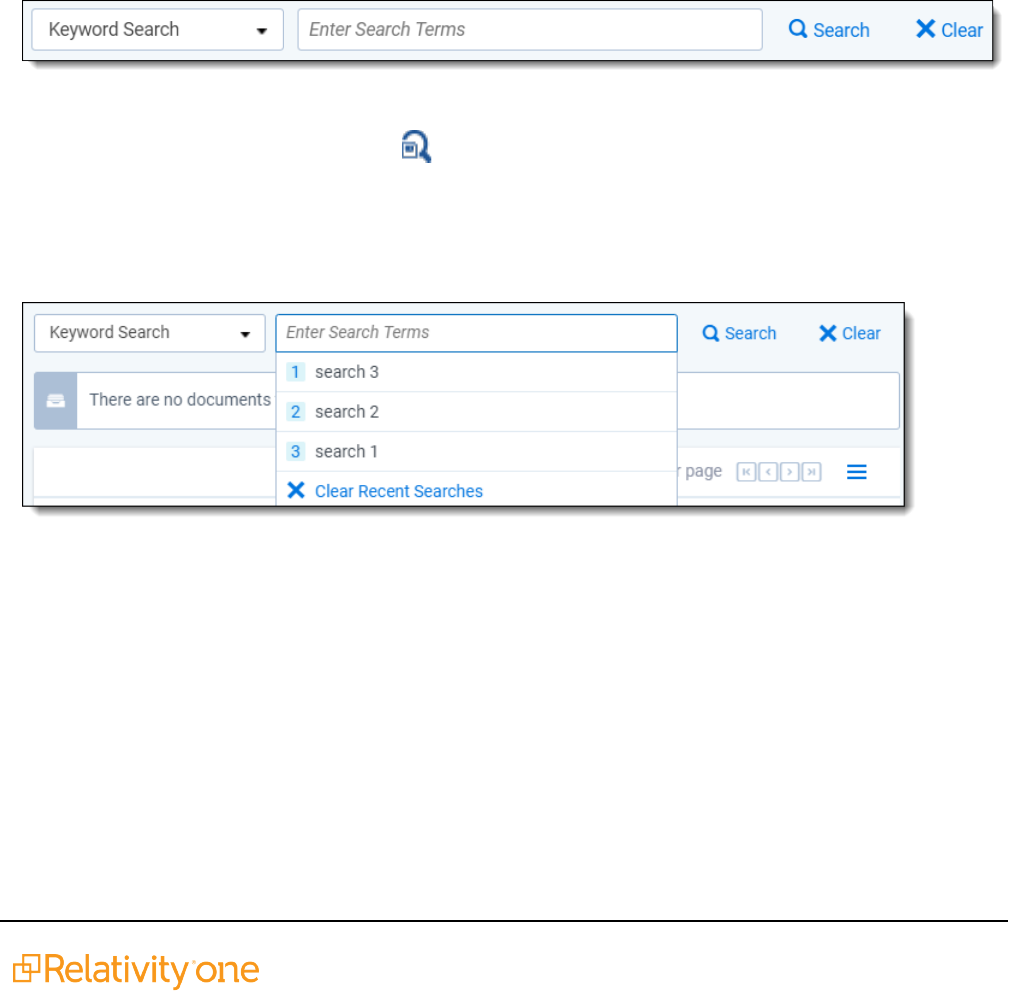
Searching Guide 9
specific algorithms, system-defined rules, to identify conceptually related documents. See the Searching
Guide for more information.
1.6 Regular expressions
Regular Expressions (RegEx) is a form of advanced searching that looks for specific patterns, as opposed
to certain terms and phrases. With RegEx you can use pattern matching to search for particular strings of
characters rather than constructing multiple, literal search queries. You can use RegEx with a dtSearch
index using dtSearch syntax options to construct complex queries. See the Searching Guide for more
information.
1.7 Additional features
Relativity provides additional features that makes searching easy to use from the Documents tab. Use the
search bar to run a keyword search query, or click the drop-down list to select another search index you
created.
With the search condition option, you can build queries using the same condition options available for saved
searches. You can click Save as Search on the Documents tab to create saved searches based on the
criteria defined for keyword searches, dtSearches, Analytics, or the search conditions option. See the
Searching Guide for more information.
You can also use the search bar to view recent searches. Click in the search bar to see up to 10 of the most
recent searches from any index in descending order, with the most recently run search first.
Select any search from the list to run that search. To clear the list, click Clear Recent Searches.
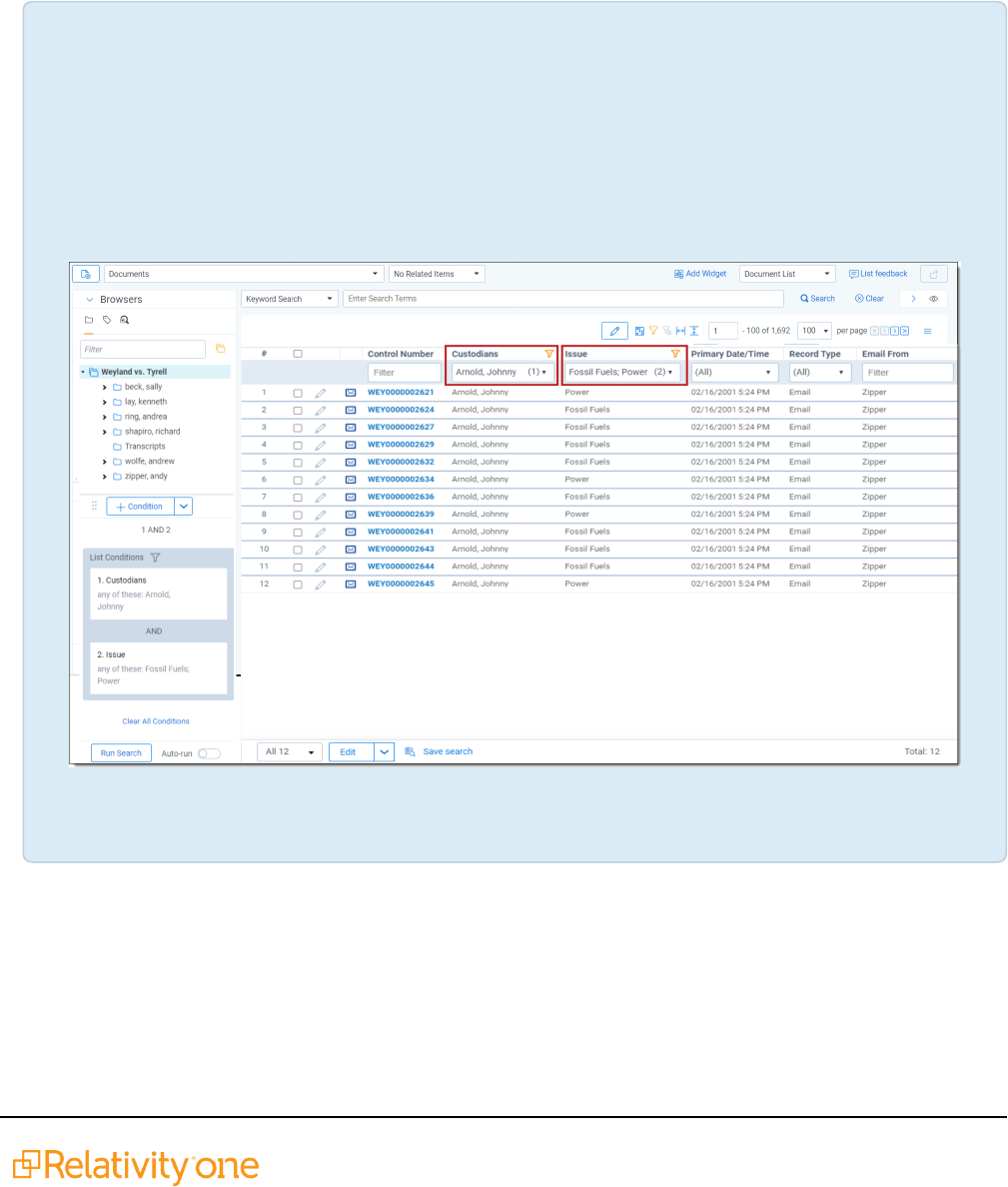
Searching Guide 10
2 Filters
Filtering provides a fast and easy way to search for items in a list in Relativity. You can use filters to search
for values in the fields on the active view, and across all records available in the searchable set. Filters are
also available for item lists on tabs and pop-up windows.
The field type associated with each column determines the available filter types, such as text boxes, pop-up
pickers, and drop-down lists. You do not need any specific security permissions to use filtering.
Using filters
You’re a Relativity admin facilitating a review project on a huge set of documents that includes
thousands of emails between traders and investors in your client’s products. You need to quickly
find all documents owned by trader Johnny Arnold that are related to gas and power, because the
evidence they might contain may not be admissible in court. To do this, you turn to filters.
You find the view you set up for documents already coded for key issues and you click the filter
icon. In the Custodian field you enter the last name of the employee in question, "Arnold." In the
Key Issue field you select the Gas and Power choices.
This simple filtering job returns a small set of documents on which you do a quick review and find
that they contain references that make them inadmissible.
2.1 Showing and hiding filters in the item list
You can use filters to quickly narrow your searchable set, allowing you to browse through the key
documents in the viewer efficiently.
The following filter buttons display above item lists in Relativity:
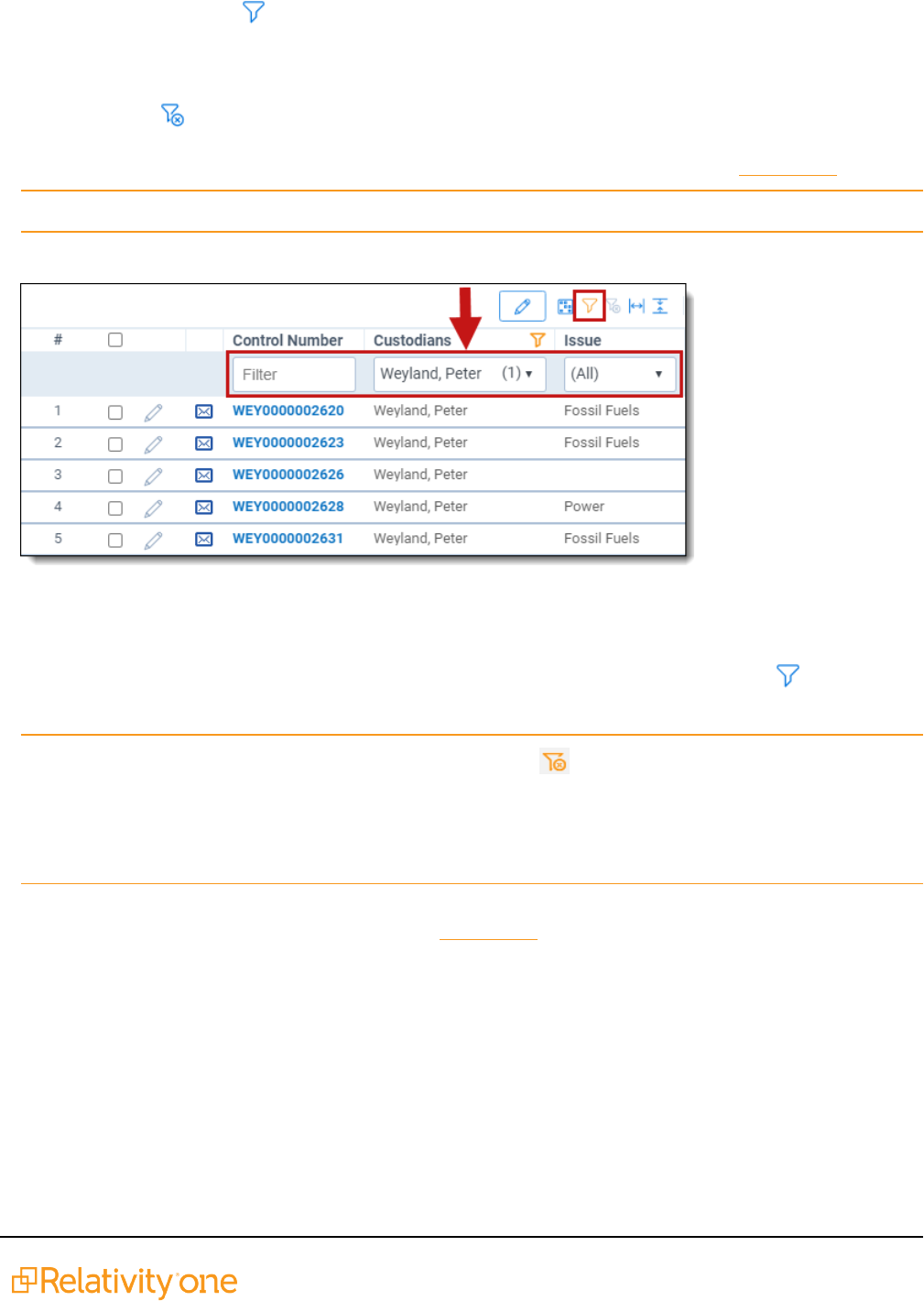
Searching Guide 11
n
Show/Hide filters ( )—displays the field column filters for an item list at the top of each column.
This icon turns orange when you activate a filter. Click the icon again to hide the filter. Your filter set-
tings remain unchanged.
n
Clear all ( )—removes the current filter settings. This option is only available after you set a filter.
The filter type determines the steps required to set the search criteria that it uses. See Filter types.
Note: When you create or edit a field, you can select its Filter Type. See Fields in the Admin guide.
In the following example, the active filters display on the Documents tab.
2.2 Setting a filter
To activate the filter options at the top of each column in the item list, click the Show filter ( ) icon. The
icon turns orange when you activate a filter. Click the icon again to hide the filter.
Note: Before defining a new search filter, click the Clear All ( ) icon or the Clear All Conditions link in
the search panel to remove any previous settings. For example, say you create a filter on the Privileged
field, but now want to search only by the Custodian field. If you don't clear the filter, Relativity filters your
documents by both the Privileged and Custodian fields, and your result set may include fewer documents
than you expect.
Select a field or fields that you want to filter (such as Record Type.) The filter type determines the steps
required to set the search criteria that it uses. See Filter types.
Make your selections from the filter drop-down menu or enter text in the filter text box (if the field is a text
field), and then click Enter.
The field column header displays the filter icon to let you know filtering is on for that field. This persists
whether or not you have the filters shown or hidden.
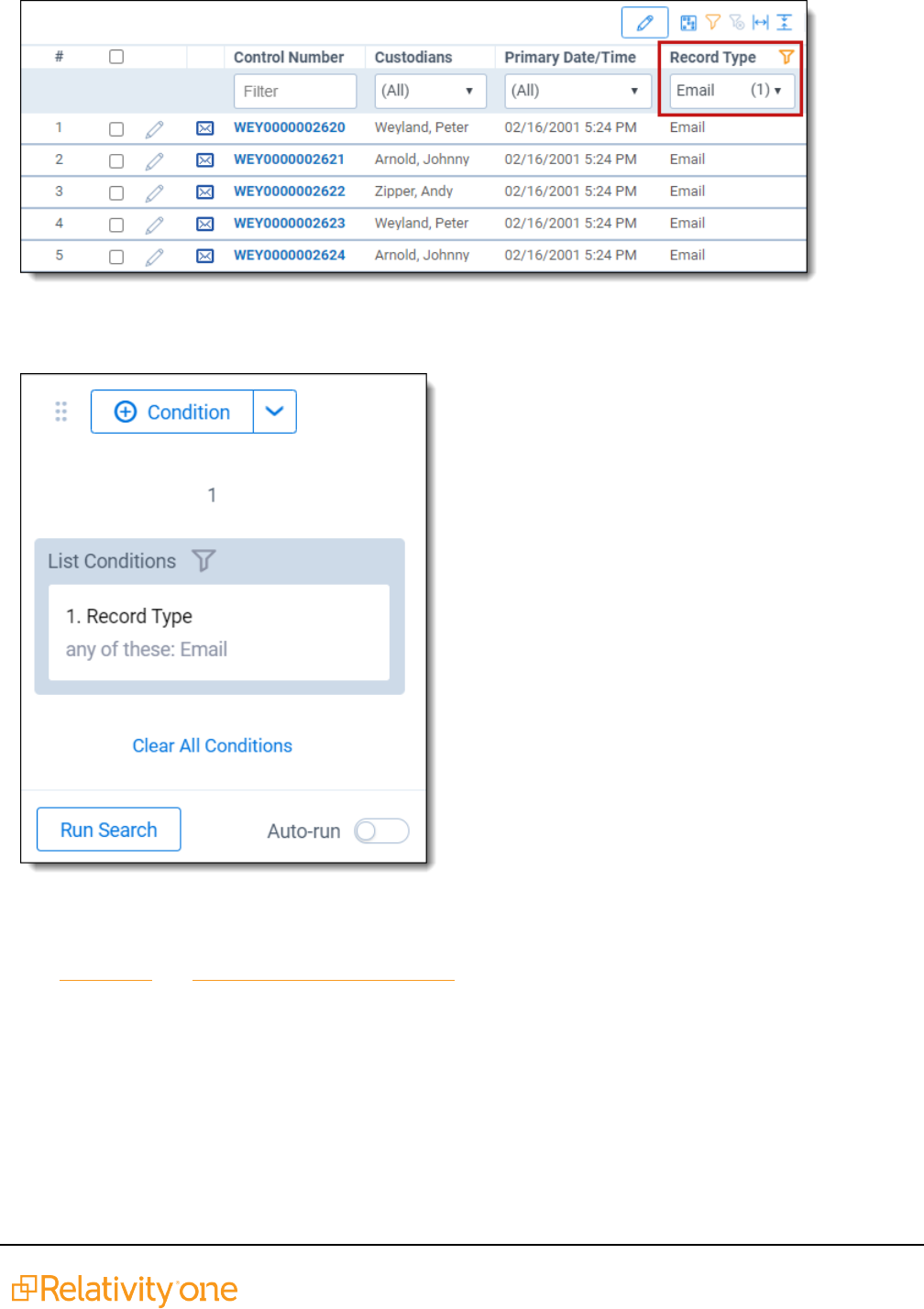
Searching Guide 12
The search panel is also updated with the applied filter conditions and displayed as a filter card in a List
Conditions box.
You cannot edit the filter card by clicking on it. However, you can clear the list condition the same way you
can clear any search conditions on the search panel. The item list updates accordingly.
See Filter types and Text box filter search examples for more information on using specific filters.
2.3 Filter types
Relativity includes the following filter types:
n
Boolean filters
n
Numeric filters
n
List filters
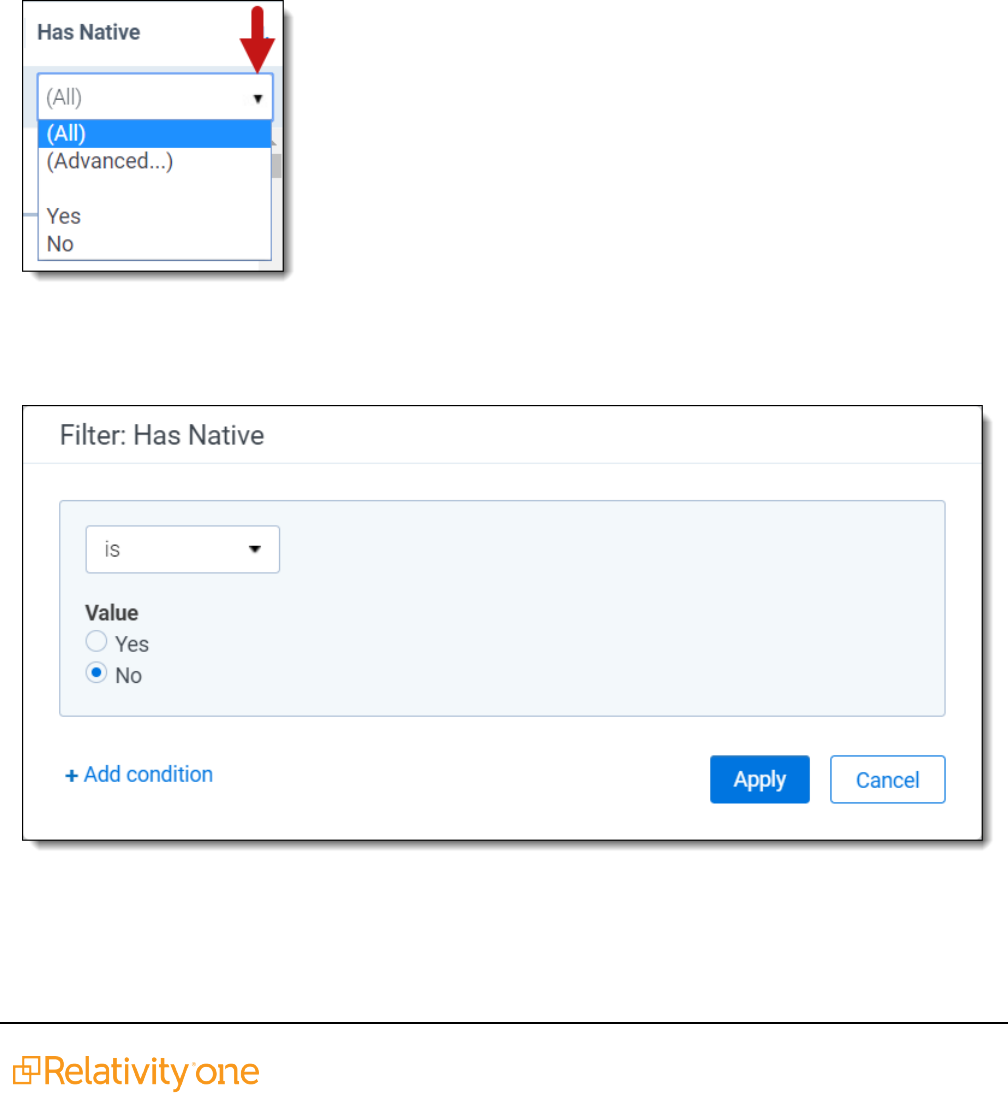
Searching Guide 13
n
Date filters
n
Multi-list filters
n
Text box filters
2.3.1 Using Boolean filters
Boolean filters are available only on Yes/No field types. To use a Boolean filter, click the drop-down menu
arrow and select True, False, or <blank> from the list to apply the filter.
In the following example, selecting True displays only documents that have native files (where the field has
a Yes value). If selected, <blank> displays only items that do not have the a True (Yes) or False (No) value
assigned to the Boolean field (is not set).
If you click on Advanced, the pop-up for the Boolean filter appears where you can specify multiple filter
conditions that are connected with explicit OR operators. Click Apply to apply the specified filter conditions
to the field.
Click Add Condition to add an additional condition to the filter.
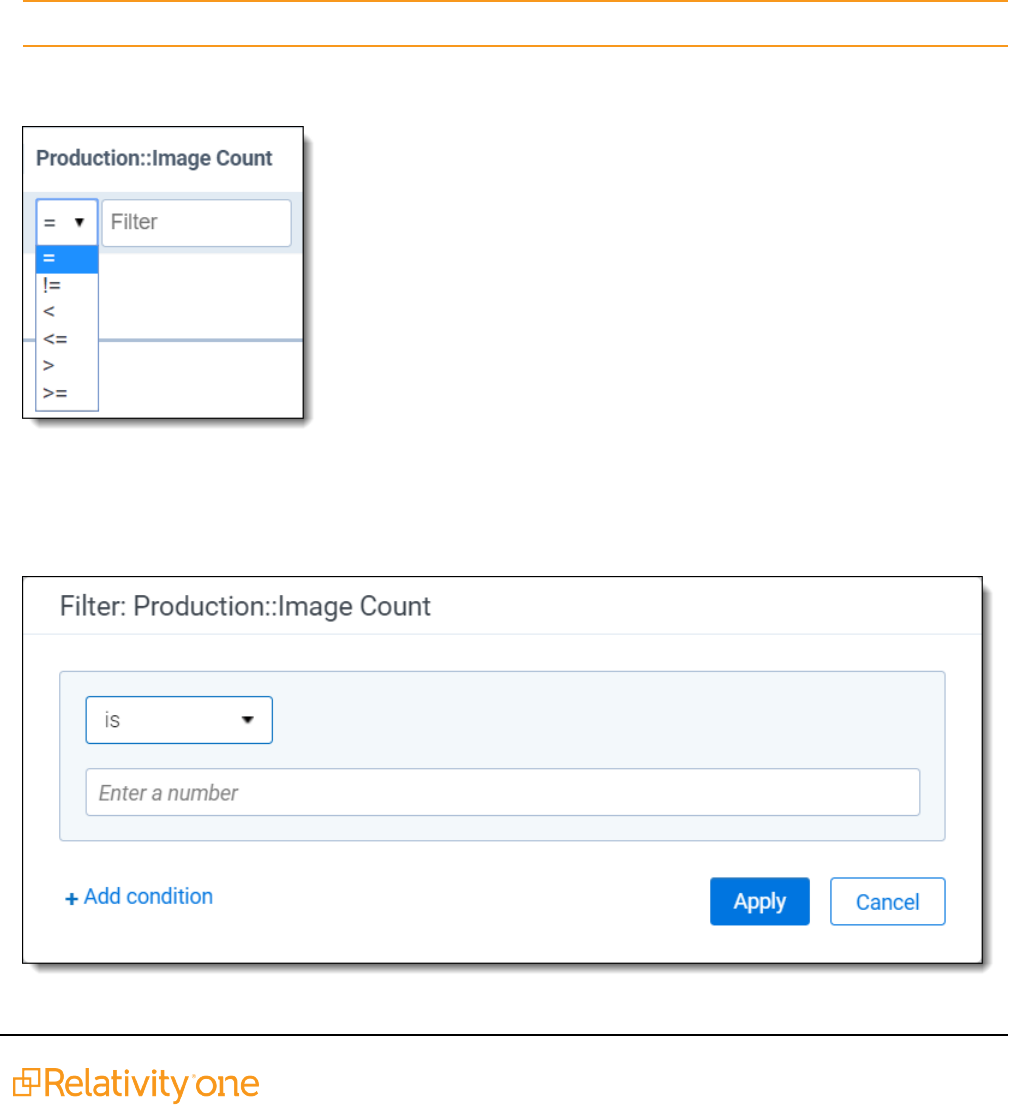
Searching Guide 14
2.3.2 Using numeric filters for numbers
The numeric filter type is available for the following field types only:
n
Decimal
n
Whole Number
n
Currency
To use a numeric filter, click the drop-down menu arrow and select an operator (such as equal to (=), not
equal to (!=), greater than (>), less than (<), less than or equal to (<=), or greater than or equal to (>=)), and
then enter a numerical value in the Filter text box.
Note: Relativity will also correctly read the thousands separator (such as 100,000.00) in numeric filters.
After you enter the value in the tex tbox, click Enter to apply the conditional expression for filtering the list
(such as filter the list for File Size greater than a certain number).
If you click into the Filter text box, a drop-down menu appears. You can select the Advanced option that
appears in the drop-down menu to display the pop-up for the numeric filter. This is where you can specify
multiple filter conditions that are connected with explicit OR operators. Click Apply to apply the specified
filter conditions to the field.

Searching Guide 15
Click Add Condition to add an additional condition to the filter.
2.3.3 Using List filters
The List filter type is available for the following field types only:
n
Single Choice
n
Single Object
n
User
n
Fixed Length Text
n
Fields that contain a large number of items may also cause the List filter to take longer to populate.
For fields that may contain a large number of choices, you can designate a pop-up filter instead.
n
Fixed Length Text fields—if the field contains more than 255 items, the List filter type you specify
for the field reverts to the Text box filter type and an error is written to the Error Log when you visit a
Document list view containing the field.
n
Single Choice/Single Object fields—if the field contains more than 255 items, the List filter type
you specify for the field reverts to None (disabled) and an error is written to the Error Log when you
visit a Document list view containing the field.
List filters are frequently associated with fields used for coding documents. The conditions displayed in the
drop-down menu for this filter vary by the type and purpose of the associated field. For example, a field
called Responsiveness might have the filter conditions of Responsive, Not Responsive, or Needs Further
Review. You can select the checkboxes of the options that you want to filter for, and then click Apply to
apply the filter to the item list. Alternatively, you can click Select all to select all filters in the list, you can click
Clear to remove all selections in the menu or you can select (Not Set) to only show items where the field
has not been set (null).
If there is a single choice that you would like to immediately apply as a filter to the document list, hover your
cursor over that choice's row and then click Only on the right side of the row.
In this example, if you only select the Non-Responsive checkbox, then only documents coded with this
value display in the item list.
Note: You can find a specific option in a long list by entering all or part of the name of the option you are
looking for in the Filter box under the Apply button. The list filters automatically as you type.

Searching Guide 16
Click the Advanced filters ( ) icon in the upper-right corner of the drop-down menu to launch a pop-up
where you can select items in the list and use additional operators such as filtering for items that do NOT
contain certain field values. Click Apply to apply the specified filter conditions to the field.
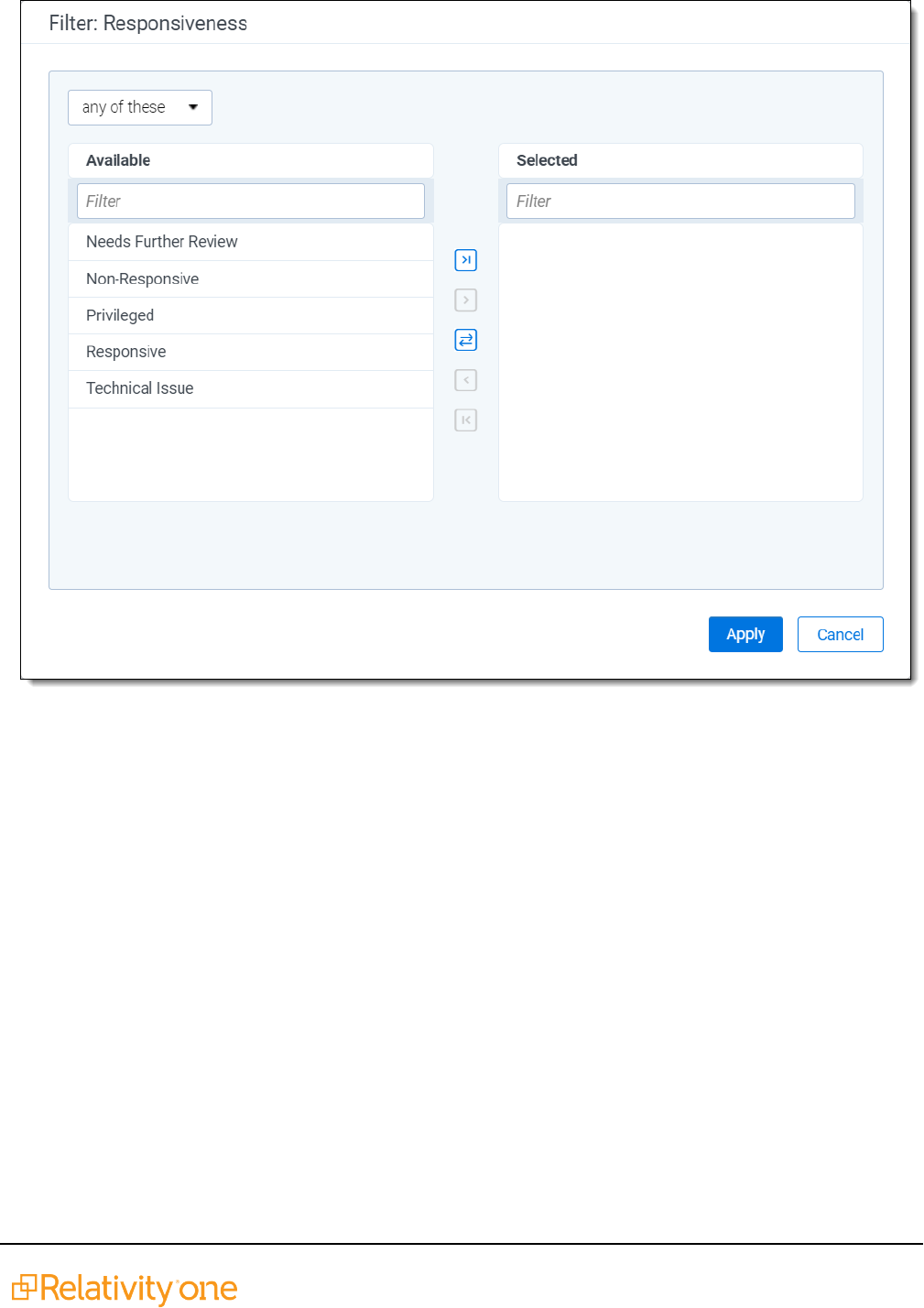
Searching Guide 17
2.3.4 Using date filters
The date filter type is only available for Date field types. Using the date filter, you can quickly and efficiently
filter for items meeting the specific date criteria that you want.
The following operators are available:
n
All
n
Not Set
n
Is
n
Is before
n
Is before or on
n
Is after
n
Is after or on
n
Between
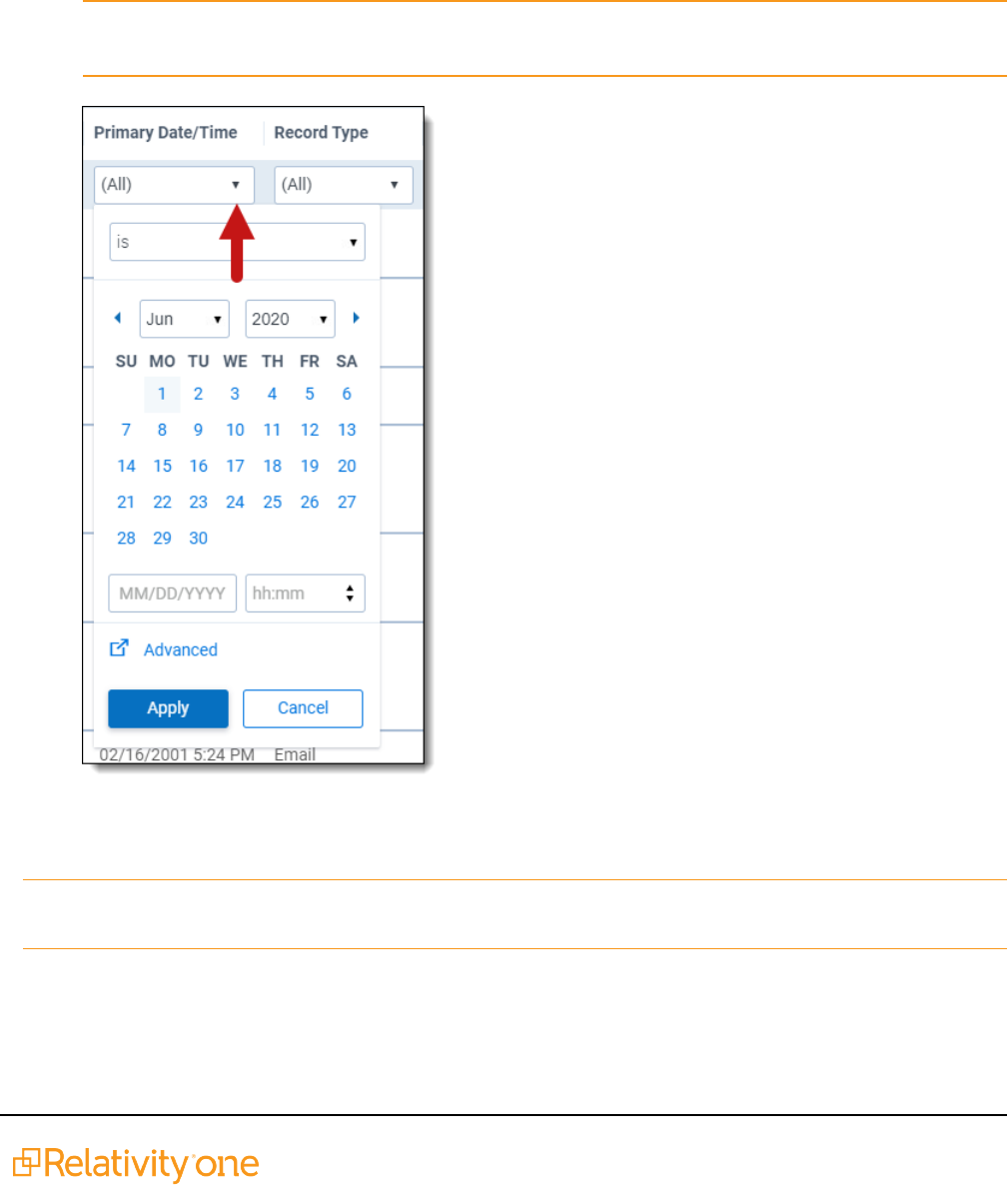
Searching Guide 18
For example, you only want to view items that were sent before or on 7 AM on January 21, 2015. To set and
apply a date filter for this scenario:
1. Select your operator from the drop-down list underneath the Apply button (such as is before or on).
2. Use the calendar interface to select the date criteria (such as January 21, 2015). There are drop-
down menus for selecting a specific month and year or you can use the forward and backward arrows
to navigate by month.
3. Enter the time below the calendar (such as 7:00 AM).
Note: Filtering on fields using the date/time format does not support using “@Today”. If you do not
enter a specific time, a time of 12:00 AM is entered explicitly for the filter.
4. Click Apply to apply the date filter. Only items that were sent before 7 AM on January 21, 2015 dis-
play in your item list.
Note: When you select the Between operator, two calendars display in the drop-down date filter, allowing
you to pick the start and end date/time for the time range.
You can click the Advanced option in the drop-down date filter to launch a pop-up to take advantage of
additional operators such as "is in" that let you filter for items where the date is in this week, last week, last
month, or this month and create more complex date filter criteria using multiple conditions. Click Apply to
apply the specified filter conditions to the field.
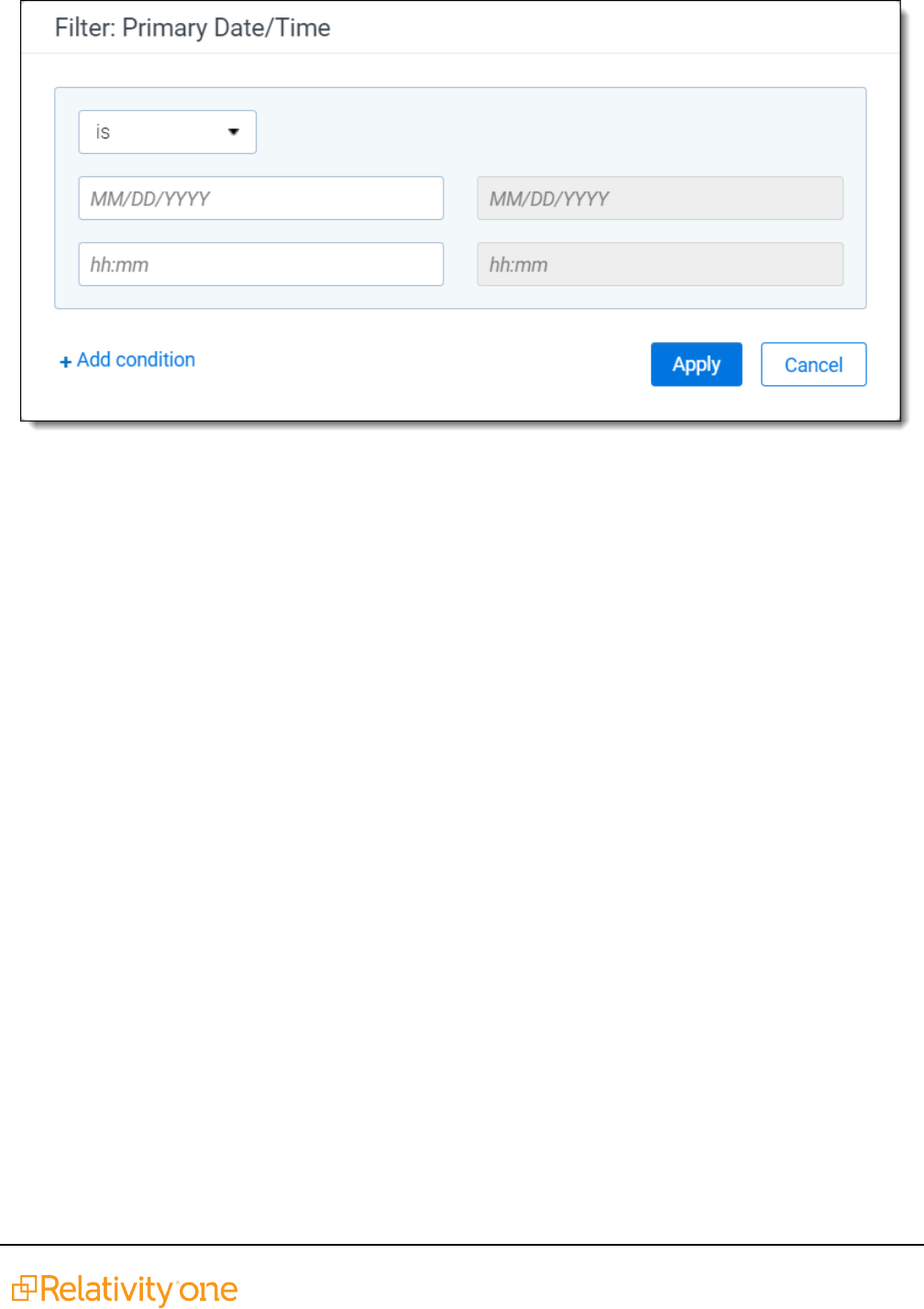
Searching Guide 19
2.3.5 Using multi-list filters
The multi-list filter type is available for the following field types only:
n
Multiple Choice
n
Multiple Object
n
Single Choice
Using multi-list filters, you can select multiple conditions from a drop-down menu. These filters are
frequently associated with fields used for coding documents.
To apply a multi-list filter, click the drop-down arrow to display the conditions list. Select the conditions that
you want to filter on. You can click Select all to select all filters in the list, you can click Clear to remove all
selections in the menu or you can select (Not Set) to only show items where the field is been set (null). Click
Apply to apply the selected filter conditions.
If there is a single choice that you would like to immediately apply as a filter to the document list, hover your
cursor over that choice's row and then click Only on the right side of the row.

Searching Guide 20
Note: You can find an specific option in a long list by entering all or part of the name of the option you are
looking for in the Filter text box under the Apply button. The list filters automatically as you type.
Click the Advanced filters ( ) icon in the upper-right corner of the drop-down menu to launch a pop-up
where you can select items in the list and use additional operators such as filtering for items that do NOT
contain certain field values. Click Apply to apply the specified filter conditions to the field.
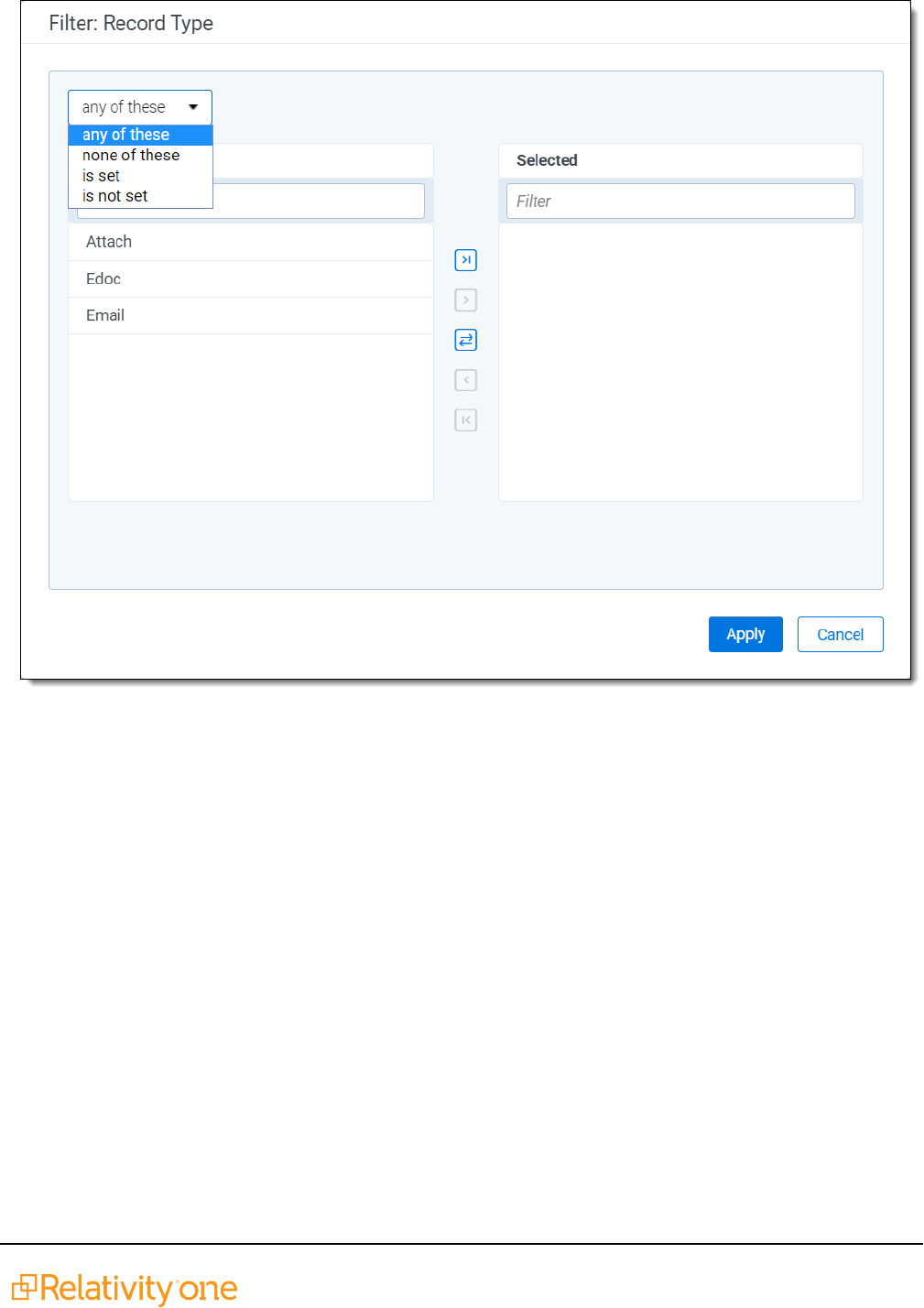
Searching Guide 21
2.3.6 Using text box filters
The text box filter type is available for the following field types only:
n
Fixed-length Text
n
Long Text
n
Date
n
Whole Number
n
Decimal
n
Currency
n
Object
You can use text box filters to search on specific terms, numbers, and dates. You can directly enter one or
more terms in the filter text box and connect multiple terms with any of the following operators:
n
AND
n
OR
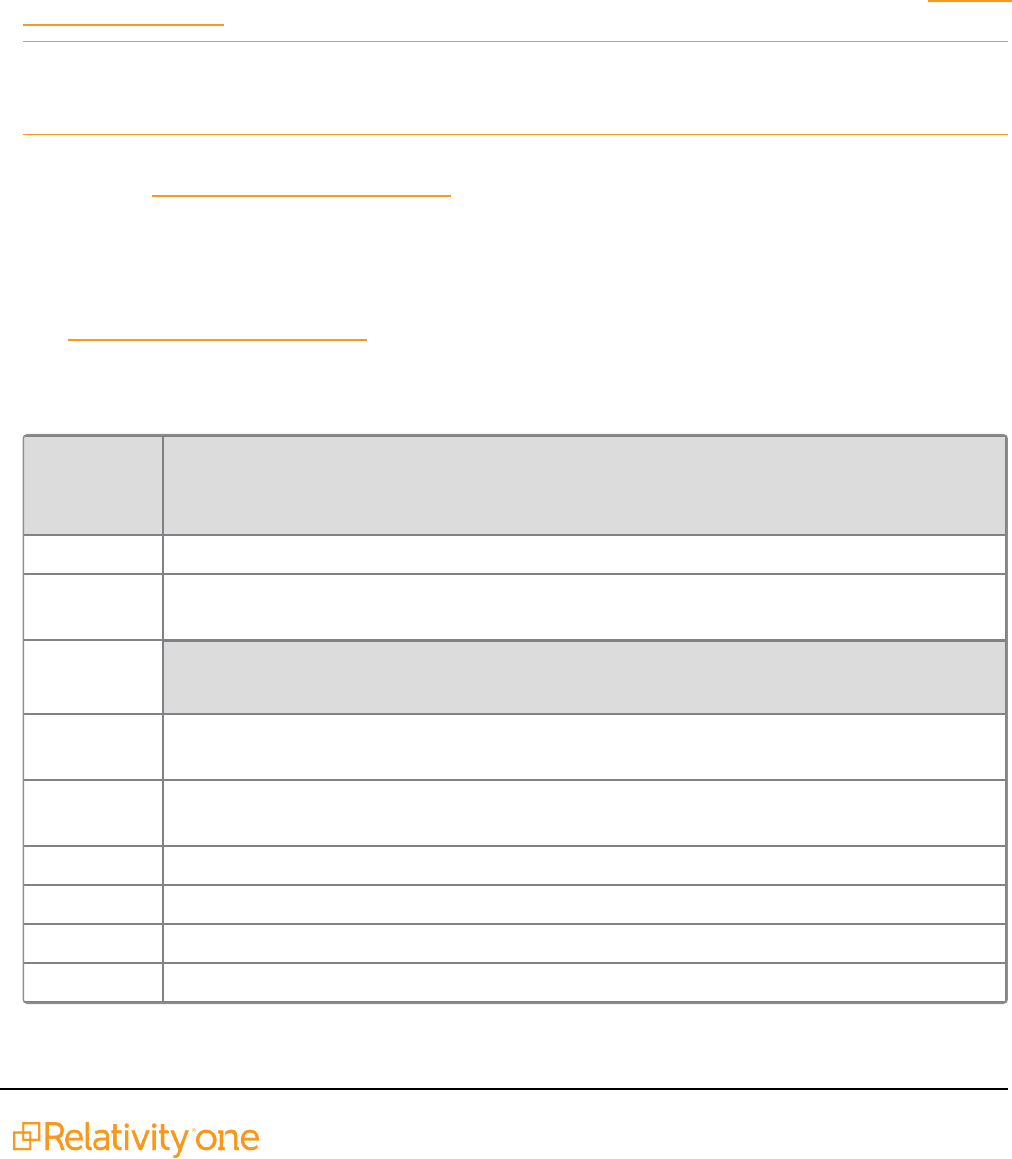
Searching Guide 22
n
ISSET
n
ISNOTSET
n
BETWEEN
n
= (equal)
n
>= (greater than or equal to)
n
<= (less than or equal to)
When entering terms and operators directly in a text box filter, you must use the proper syntax. See Text box
filter search examples for more information.
Note: The text box filter treats each search term as if it were preceded and followed by a wildcard (*) and
returns all versions of the term. Do not add an asterisk (*) to the beginning or ending of a search term. The
filter will not return any results if you use this operator.
You can also use the advanced text box filter feature to build more advanced filter queries on the selected
text field. See Using advanced text box filtering.
2.3.7 Text box filter search examples
You can perform text searches using Boolean operators by directly entering search strings in the filter text
box as follows or you can use the Advanced feature to build more advanced filter queries on the text field
(see Using advanced text box filtering).
2.3.7.1 Boolean and other search operators
The following table lists examples of valid search strings using Boolean and other operators.
Valid
search
strings
Returns items where…
cubs OR sox ([FIELD VALUE] like '*cubs*') OR ([FIELD VALUE] like '*sox*')
cubs AND
sox
([FIELD VALUE] like '*cubs*') AND ([FIELD VALUE] like '*sox*')
cubs OR sox
AND kcura
([FIELD VALUE] like '*cubs*') OR (([FIELD VALUE] like '*sox*') AND ([FIELD
VALUE] like '*kcura*'))
percent sign (
% )
Use this operator to check whether the field is set to a value. It behaves like the "Is like"
operator in a query.
underscore (
_ )
Wildcard for a missing character. Do not use the underscore to check if a field is set to a
value; it is slower and more resource-intensive than using the percent sign (%).
= with term Returns an exact phrase.
cubs sox Returns the exact phrase (that is, the word "cubs" followed by a space and the word "sox").
ISSET Returns only items where the field has a value.
ISNOTSET Returns only items where the field does not have a value (null).
The following table shows examples of invalid search strings.

Searching Guide 23
Invalid search strings Description
cubs AND The AND operator requires a right search term.
cubs OR The OR operator requires a right search term.
AND cubs The AND operator requires a left search term.
OR cubs The OR operator requires a left search term.
2.3.7.2 Alphabetical filtering
The following table lists examples of valid search strings you can use to filter text alphabetically.
Alphabetical filtering Returns items where…
>= cubs [FIELD VALUE] >= 'cubs'
<= cubs [FIELD VALUE] <= 'cubs'
= cubs [FIELD VALUE] = 'cubs'
= cubs AND sox [FIELD VALUE] = 'cubs AND sox'
cubs BETWEEN sox * ([FIELD VALUE] >= 'cubs') AND ([FIELD VALUE] <= 'sox')
kcura and cubs BETWEEN sox ([FIELD VALUE] >= 'kcura and cubs') AND ([FIELD VALUE] <= 'sox')
* If you attempt to use more than one BETWEEN operator in a single filter string (for example, 12/13/2000
BETWEEN 1/0/2008 BETWEEN 5/4/2009), you will receive an Incorrect Syntax error in the filter box. If you
need to search for documents based on multiple BETWEEN operators, you can create a saved search with
multiple conditions, each of which uses a date field with a between operator and a date range value. For
more information, see the Saved search documentation on our website.
2.3.7.3 Dates and numbers
The following table lists examples of valid date and number searches, and the expected result set.
Valid search strings Returns items where…
>= 7/24/2008 [FIELD VALUE] >= '7/24/2008'
<= 7/24/2008 [FIELD VALUE] <= '7/25/2008'
= 7/24/2008 ([FIELD VALUE] >= '7/24/2008') AND ([FIELD VALUE] <
'7/25/2008')
>= 07/27/2008 1:23 PM [FIELD VALUE] >= '07/27/2008 1:23 PM'
<= 07/27/2008 1:23 PM [FIELD VALUE] <= '07/27/2008 1:23 PM'
= 07/27/2008 1:23 PM [FIELD VALUE] = '07/27/2008 1:23 PM'
7/24/2008 BETWEEN 8/24/2008 ([FIELD VALUE] >= '7/24/2008') AND ([FIELD VALUE] <
'8/25/2008')
7/24/2008 1:23 PM BETWEEN
8/24/2008 3:45 PM
([FIELD VALUE] >= '7/24/2008 1:23 PM') AND ([FIELD VALUE]
<= '8/24/2008 3:45 PM')
7/24/2008 BETWEEN 8/24/2008 ([FIELD VALUE] >= '7/24/2008') AND ([FIELD VALUE]
<'8/25/2008')
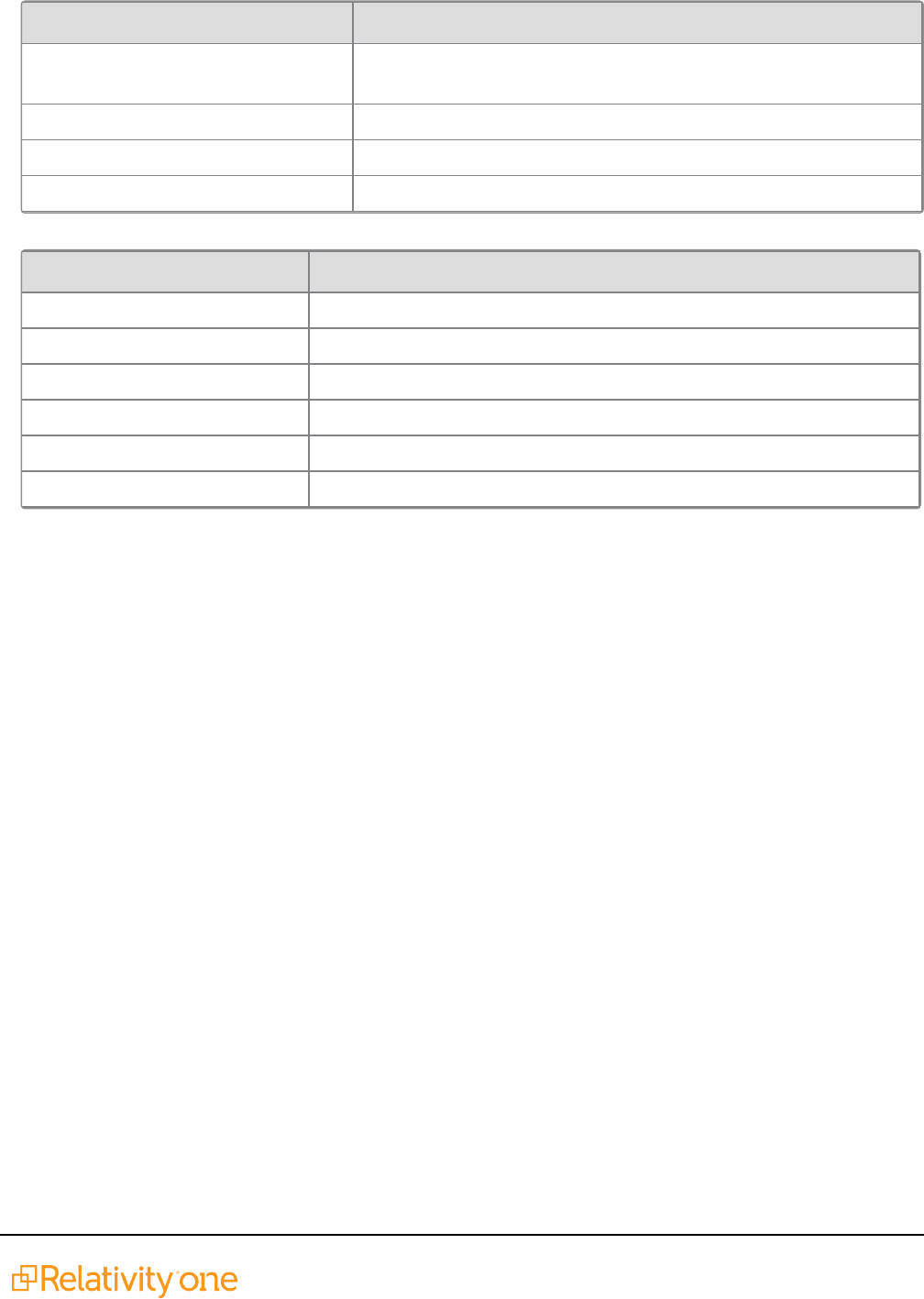
Searching Guide 24
Valid search strings Returns items where…
07/27/2008 ([FIELD VALUE] >= '07/27/2008') AND ([FIELD VALUE] <
'7/28/2008')
>= 100 [FIELD VALUE] >= '100'
<= 100 [FIELD VALUE] <= '100'
= 100 [FIELD VALUE] = '100'
The following table includes examples of invalid data and number search strings.
Invalid search strings Description
> 7/24/2008 You must use the equal sign with the greater than operator (as in >=).
< 7/24/2008 You must use the equal sign with the less than operator (as in <=).
>= 0/24/2008 The search string includes the value 0 for the month.
= 0/24/2008 The search string includes the value 0 for the month.
0/24/2008 BETWEEN 8/24/2008 The search string includes the value 0 for the month in the starting date.
7/24/2008 BETWEEN 0/24/2008 The search string includes the value 0 for the month in the ending date.
2.3.8 Using advanced text box filtering
You can use the following operators with advanced filtering:
n
Is
n
Is not
n
Is set
n
Is not set
n
Is less than
n
Is greater than
n
Is like
n
Is not like
n
Contains
n
Does not contain
To use advanced text box filtering:
1. Click inside the Filter text box for the text field in the column header.
A drop-down filter displays the Advanced option.
2. Click the Advanced option to launch the Filter pop-up screen.
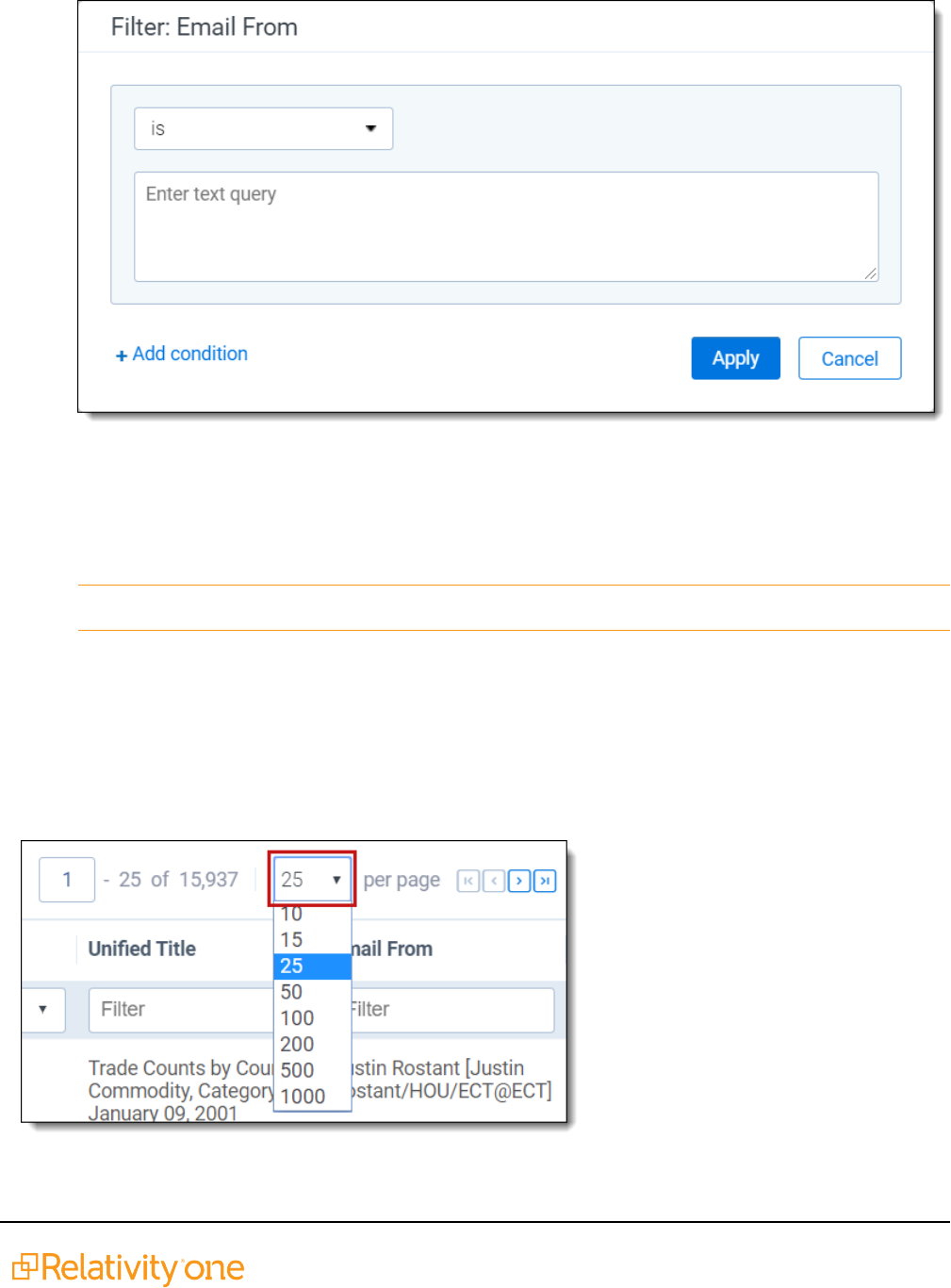
Searching Guide 25
3. Choose an operator (such as is greater than). See Fixed-length, long, or extracted text operators in
the Searching guide for a list of definitions of the available operators.
4. Enter the desired value (such as 100.) The filter only returns items where the value of the field is
greater than 100.
5. (Optional) Click Add condition to add a new filter condition (for example, you may want to also return
items where the text field contains the word privilege).
Note: Multiple conditions are automatically connected with an ORoperator.
6. Click Apply to apply the filter condition.
2.4 Changing item sets per page
You can use the set selector menu to change the number of items that appear per page. The set selector
menu appears at the top of the screen. The option you select remains the default setting during your session
until you select another option.

Searching Guide 26
2.5 Saving filters as a search
To save your filtered item set as a saved search:
1.
Click the Save search ( ) icon next to the mass operations drop-down menu at the bot-
tom of the item list to open the Saved Search window.
2. Select or enter the following required information:
n
Name—enter a title for the search. The title appears in the saved searches browser.
n
Owner—select Public to make the search available to all users or choose a specific user from
the list. Click Me to select your name from the list, making the search private. (You must have
the appropriate privileges to view searches.) See Controlling the visibility of saved searches in
the Searching guide.
n
Search Folder—click the Select button to launch a pop-up window where you can save the
new search to a specific folder on the saved searches browser. Highlight the folder where you
want to save the search, and click OK to select it.
3. Add to or modify the search criteria as needed. See Creating or editing a saved search in the new UI
framework in the Searching guide.
4. Click Save.
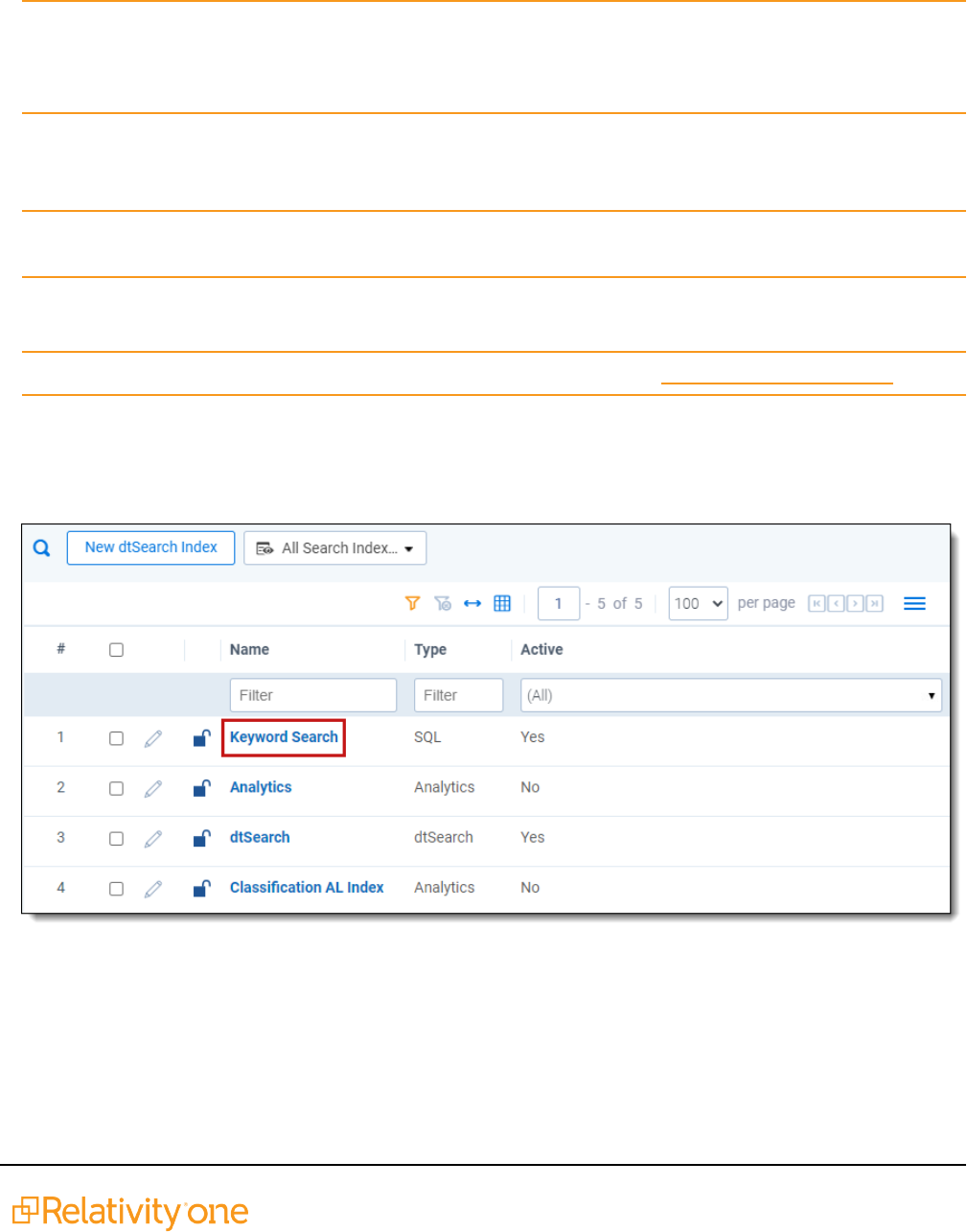
Searching Guide 27
3 Keyword search
You can use a keyword search to query a full text index. The long text and fixed-length text fields included in
this index vary by workspace.
Note: New workspaces created in RelativityOne have extracted text automatically stored in Data Grid.
Workspaces restored into RelativityOne using the ARM application will automatically have the extracted
text migrated to Data Grid. In order to search extracted text in workspaces, you must use dtSearch or
Analytics searching; you cannot use keyword search.
You can use the AND, OR, NOTBoolean operators in keyword searches, as well as quotation marks for
exact matches, asterisks (*) for wildcards, and other features. However, if you perform a keyword search
with multiple terms, documents where those terms exist in separate fields won't return.
Note: If you want to draft queries outside of Relativity, use a plain text editor such as Microsoft Notepad to
prevent adding characters or formatting that might return unexpected search results.
While the keyword search offers fewer options than other Relativity searches, it uses an index that's
automatically populated, reducing maintenance and ensuring all required document fields are indexed.
Note: For information on configuring and managing word breakers, see Microsoft's documentation.
3.1 Fields
A keyword search index is available in the Search Indexes tab by default. Click the Keyword Search link.
The keyword search index details page contains the following fields:
n
Name—the name of the keyword search index. The name is the display name for the index.
n
Order—a number that represents the position of the index in the list. The lowest-numbered index will
be at the top. The highest-numbered index is at the bottom. Items that share the same value are sor-
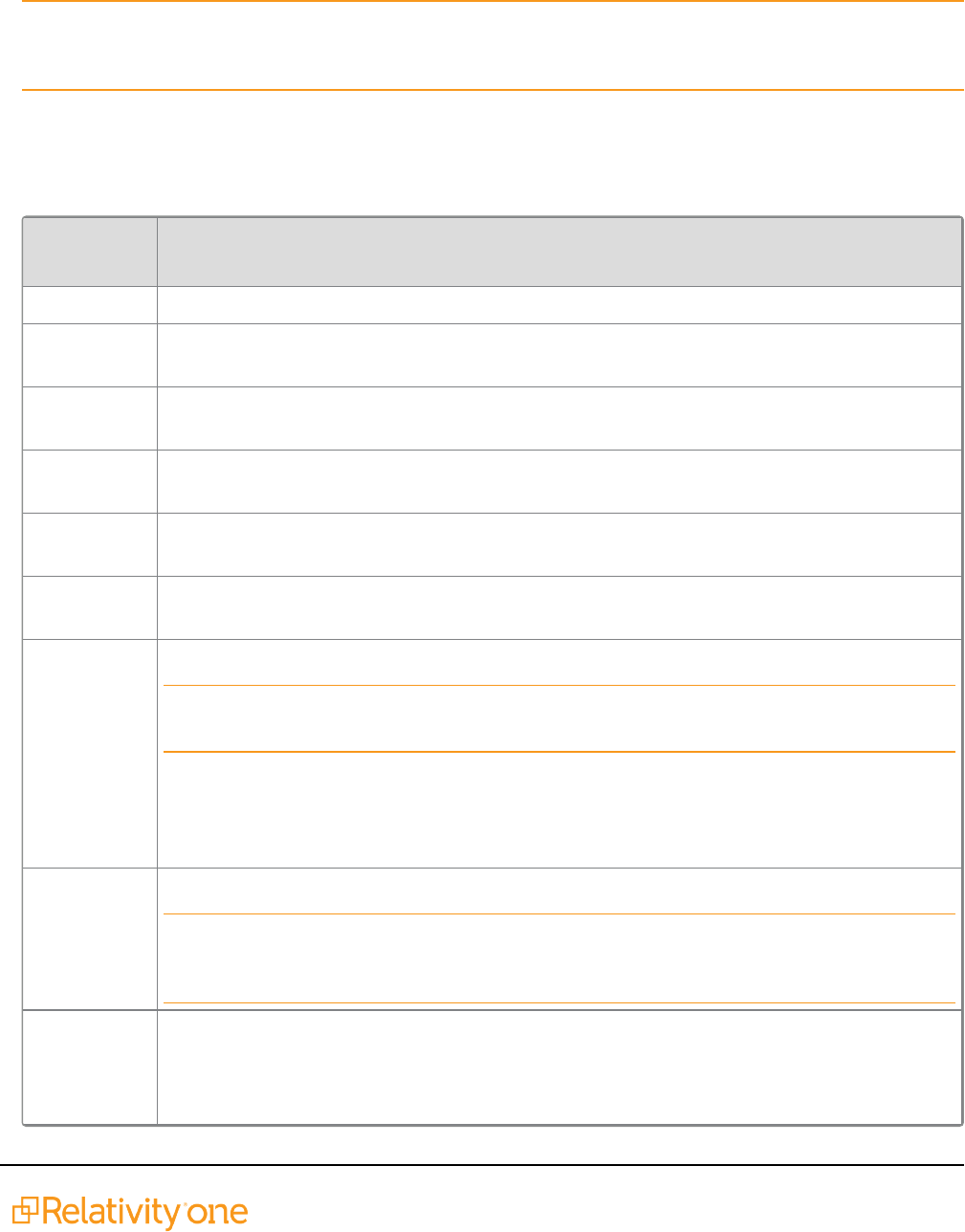
Searching Guide 28
ted in alphanumeric order. Index order can be any integer, positive or negative. No decimals are
allowed.
n
Active—determines whether the index should be activated or deactivated. Yes means that the index
will be activated; No means that the index will be deactivated.
Note: If you apply item-level security to a search index, users cannot run any public saved searches built
on that index and will get an error. We recommend leaving the index unsecured and instead applying
security to the Search indexes tab or to individual saved searches.
3.2 Example keyword search strings
The following table lists search string examples with their expected results.
Search
string
Returns documents with...
wired the word wired
wired
magazine
the words wired and magazine
wired AND
magazine
the words wired and magazine
wired OR
magazine
the word wired or the word magazine
wired,
magazine
the word wired or the word magazine
"wired
magazine"
the exact phrase wired magazine
wired NOT
magazine
the word wired and not the word magazine
Note: Do not start key word searches with the NOT operator, or use it with the OR
operator. For example, these searches are invalid:
n
not wired
n
wired or not magazine
See NOT Operator Evaluation in Keyword searches.
wire* any words beginning with wire, such as wired, wires, wireless
Note: Key word searches do not support the use of wildcards at the beginning of a word.
Keyword searches are SQL index searches run on the Microsoft SQL Server, which
does not support leading wildcards in full text searches.
computer
AND (wired
OR
magazine)
the word computer and the word wired OR the word computer and the word magazine
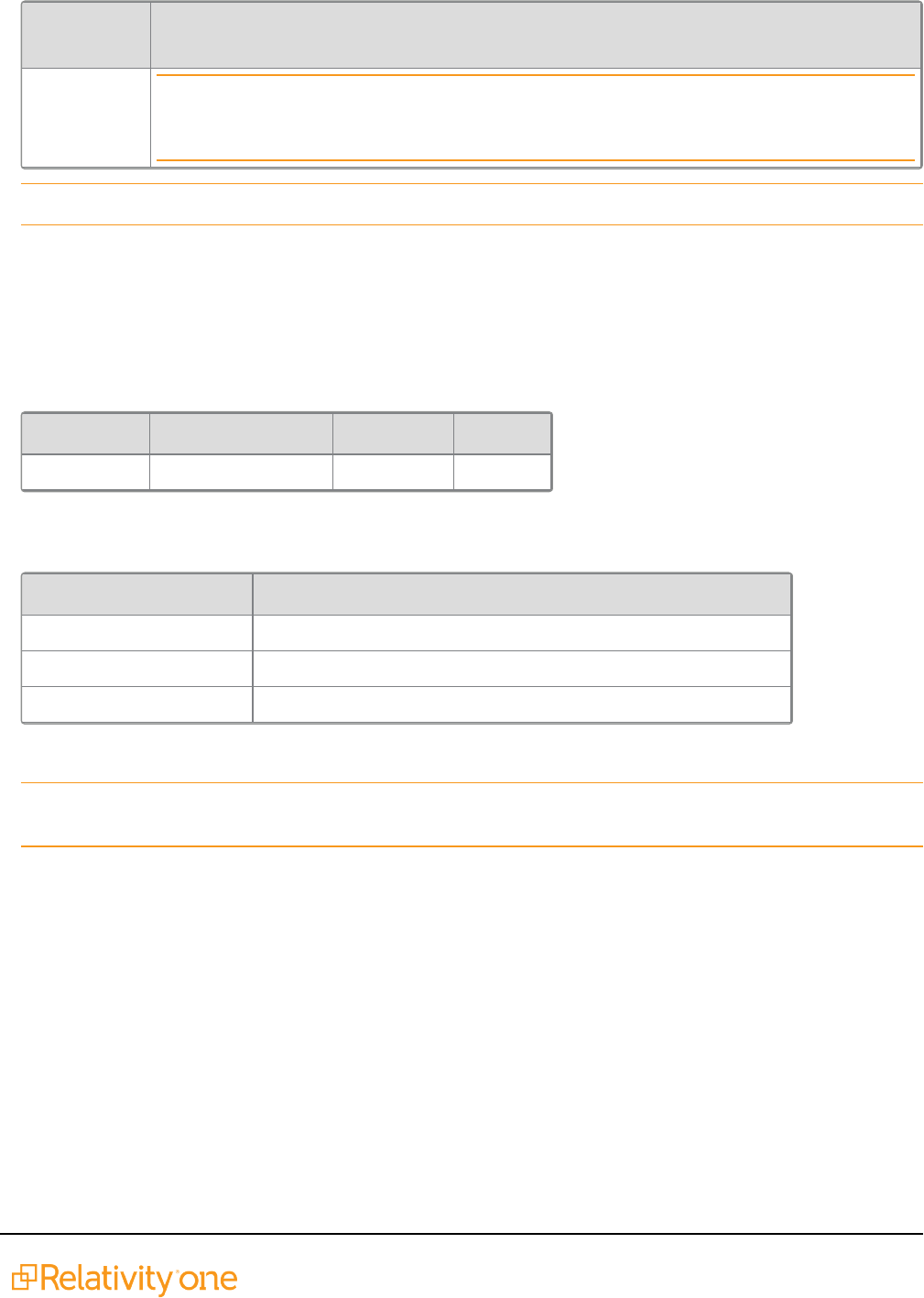
Searching Guide 29
Search
string
Returns documents with...
Note: When a search string does not include parentheses, the order of precedence for a
keyword search evaluates AND then OR expressions. For example, the search string A
AND B OR C is evaluated as (A AND B) OR C.
Note: Search terms with accented letters are recognized and return keyword search results.
3.3 Using the NOT operator in keyword searches
When running a keyword search that is an SQL full text search, carefully format queries that use the NOT
operator. For example, you may want to query for email messages that have Ryan as the author, but do not
have Will as the recipient. The fields in the following record are included in the index used to demonstrate
how this query is run:
Document OCR Recipient Author
AS00001 From: Ryan To: Will Will Ryan
A keyword search using the string Ryan NOT Will returns the document AS00001 even though you would
not expect it in the result set. The following table illustrates the SQL logic used to evaluate the query Ryan
NOT Will.
SQL queries this field... Returns these results...
OCR Field Finds both Ryan and Will, so no document is returned.
Recipient Field Does not find Ryan, so no document is returned.
Author Field Finds Ryan but not Will, so the document AS00001 is returned.
When these fields are searched using the SQL logic, the Author field matches the query Ryan NOT Will, and
unexpectedly returns the document.
Note: You can use the AND NOT operator in a dtSearch as an alternative approach to this type of
keyword search.
3.4 Understanding noise words
Noise words in a keyword search include punctuation marks, single letters, single digits, and words such as
"at", "a", "on" and "the".
3.4.1 Keyword search noise words - without double quotes
Noise words used in keyword searches are ignored if the search string is not surrounded by double
quotes. In a search for the phrase sun on my head, both on and my are ignored. The result is that the words
sun AND head are queried without respect to proximity. Thus, any documents that contain both the words
sun and head will be returned.
The following table illustrates how keyword search queries for phrases that contain noise words that are not
surrounded by double quotes.
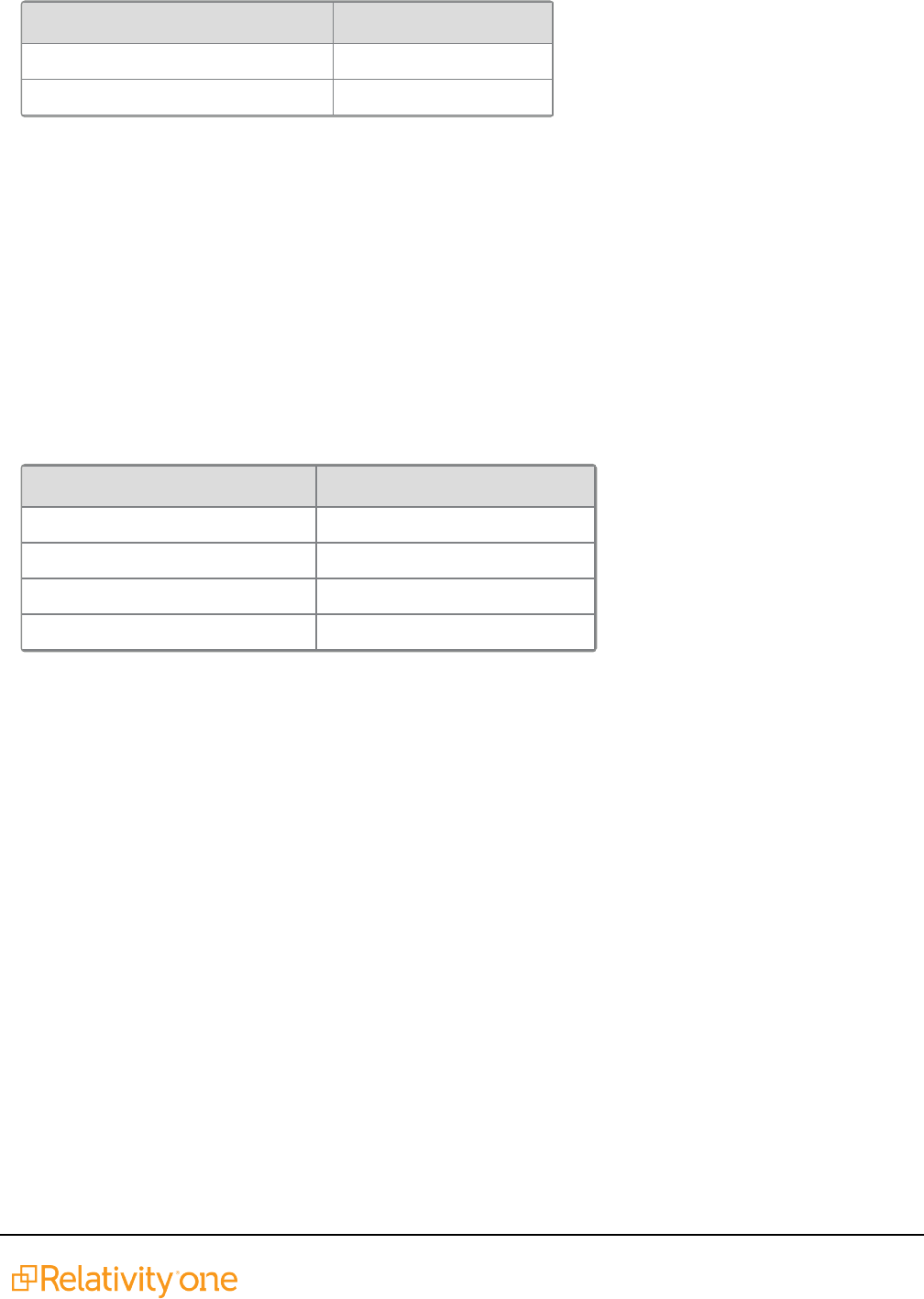
Searching Guide 30
Searching string without quotes Queries for this string
sun on my head sun AND head
sun on head sun AND head
3.4.2 Keyword search noise words - with double quotes
If a keyword search string containing noise words is surrounded by double quotes, then the noise words'
positions in the string are taken into account when the query is executed. However, only the positions of any
intervening noise words are taken into account, not the noise words themselves. Noise words at the
beginning or tail end of a keyword search string are ignored.
For example, the search strings "sun on my head" and "sun my on head" (where on and my are switched)
return the same records. This is because keyword search evaluates both search strings as a query for the
phrase sun ABC XYZ head, where ABC and XYZ represent any two words, not just noise words.
Similarly, a query for the search string "sun on head" returns documents that contain the phrase sun ABC
head, where ABC represents any word.
The following table illustrates how keyword search queries for phrases that contain noise words, and that
are surrounded by double quotes.
Searching string (with quotes) Queries for this string
"sun on my head" sun [AnyWord] [AnyWord] head
"sun on head" sun [AnyWord] head
"sun on my head and" sun [AnyWord] [AnyWord] head
"and sun on head" sun [AnyWord] head
3.4.3 Single digits as noise words
Single digits 0-9 are default noise words, so you cannot query on them with a keyword search. Relativity
does not return the expected results if you attempt to query on a single digit. Use the dtSearch feature to
query on a specific number or letter.
However, you can use a keyword search to query on whole numbers greater than 9. You can search on
more than one digit, such as 09. While these digits may be used to represent a specific numeric value, such
as 9, they are not considered single digits, and can be used in a keyword search.
3.4.4 Punctuation as noise words
Certain punctuation marks are treated as noise words by default, so you cannot query on them with a
keyword search. They include:
n
Period (.)
n
Colon (:)
n
Semicolon (;)
n
Slash (\,/)
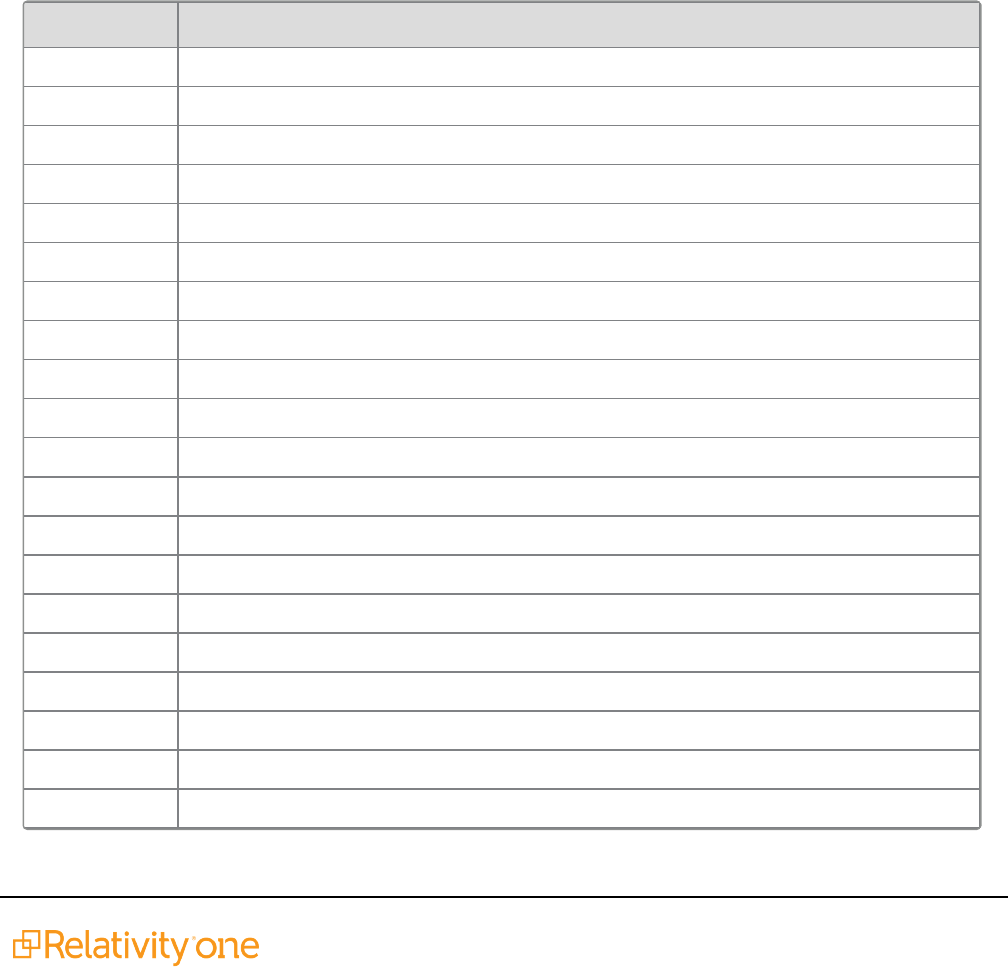
Searching Guide 31
3.4.5 At sign (@) and dashes
The at sign (@) and dashes (-) are ignored from being indexed in a keyword search, when either is used at
the beginning of a query. For example, if you search a domain name, the same number of documents return
whether you include or exclude @.
3.4.6 Hyphens and dashes
When a search phrase includes a hyphen or dash, the query returns results that include terms containing
other punctuation marks. For example, the following results return for a search on the term Pop-up:
n
Pop.up
n
Pop--up
3.4.7 Default noise word list
Relativity comes with the following default noise words:
Begins with... Noise words
A about, after, all, also, another, any, are, as, at
B be, because, been, before, being, between, but, both, by
C came, can, come, could
D did, do, does
E each, else
F for, from
G get, got
H has, had, he, have, her, here, him, himself, his, how
I if, in, into, is, it, its
J just
L like
M make, many, me, might, more, most, much, must, my
N never, no, now
O of, on, only, other, our, out
S said, same, see, should, since, so, some, still, such
T take, than, that, the, their, them, then, there, these, they, this, those, through, to, too
U under, up, use
V very
W want, was, way, we, well, were, what, when, where, which, while, who, will, with, would
Y you, your

Searching Guide 32
3.5 Running a keyword search
3.5.1 Running a keyword search in the search panel
Use the following steps to run a keyword search in the search panel.
1. Navigate to the Search panel in the Documents Tab.
2. Click Add Condition.
3. Select (Index Search) in the Add Condition drop-down menu. The (Index Search) window opens.
4. Select Keyword Search from the drop-down Index.
5. Enter terms for the search in the Search Terms box.
6. Optionally, select the Sort By Rankoption to return results in order by relevance. The most relevant
documents are listed at the top of the result set.
7. Click Apply.
8. (Optional) Add any additional conditions through the Add Condition drop-down menu.
9. Click Run Search. To stop a long running search, click Cancel.
3.5.2 Running a keyword search in the Search browser
Use the following steps to run a keyword search in the Search browser.
1.
Click to access the search browser from the document list.
2. Click New Search.
3. Set required fields.
4. Click Add Condition.
5. Select (Index Search)in the Add Condition drop-down menu. The (Index Search) window opens.
6. Select Keyword Search from the Index drop-down menu.
7. Enter terms for the search in the Search Terms box.
8. Optionally, select the Sort By Rankoption to return results in order by relevance. The most relevant
documents are listed at the top of the result set.
9. Click Apply.
10. (Optional)Add any additional conditions through the Add Condition drop-down menu.
11. Click Save or Save As.
12. Click the name of the keyword search in the search browser.
13. Click Run Search. To stop a long running search, click Cancel.
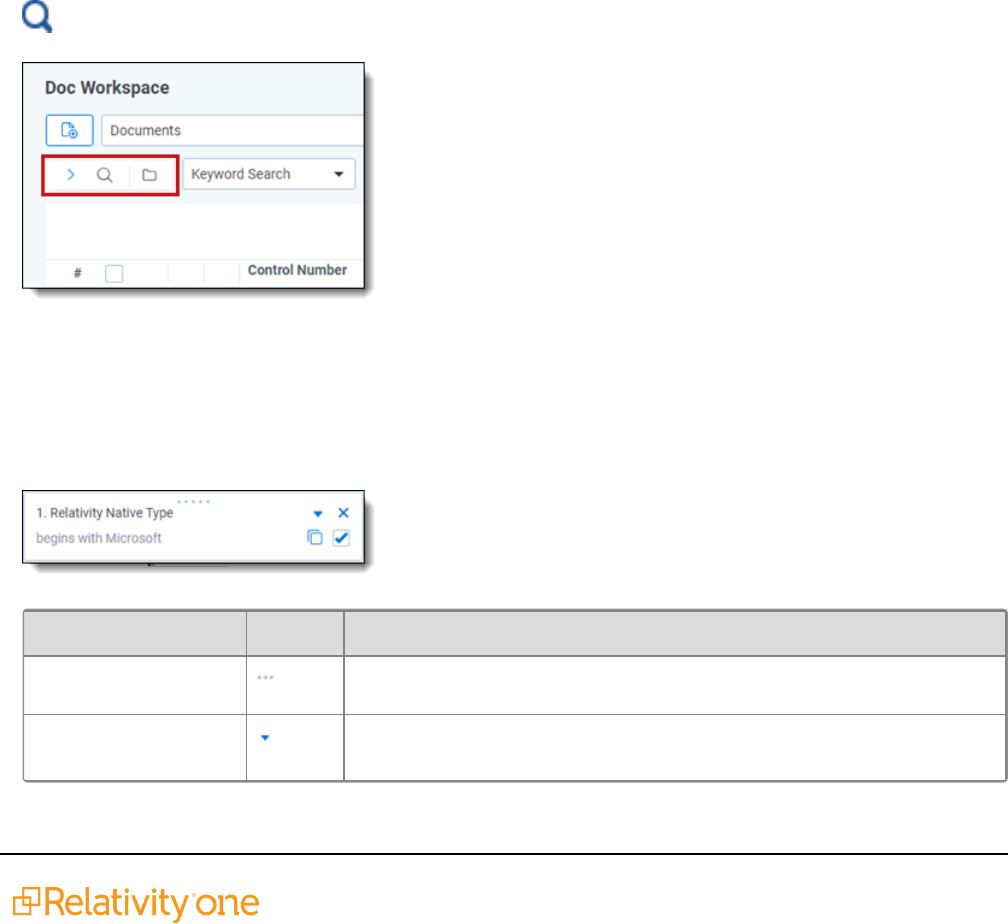
Searching Guide 33
4 Search panel
The search panel is available for the Document list and for many other tabs in Relativity.
Using the search panel, you can build complex searches using drag-and-drop to rearrange and visualize
nested conditions. You can easily set conditions and drag and drop them into logic groups. The logic display
at the top of the panel updates automatically to reflect your drag-and-drop changes. You can access your
dtSearch and keyword search indexes and fields in the workspace when creating your search.
Search panel functionality is controlled by security permissions. To access search indexes (Keyword
search, dtSearch, Analytics), from the Add Conditions drop-down menu, you must have View Search Index
permissions. To view and select fields from the Add Conditions drop-down menu, you must have Edit
Search permissions. If neither permission is present, the search panel buttons will not appear. See
Workspace security for more information on setting security permissions.
4.1 Showing, hiding, and moving the search panel
You can show and hide the search panel from the item list by clicking the Search icon, magnifying glass,
above the browser panel.
To move the search panel to either side of the document list, click and drag on the top of the panel.
4.2 Condition card icons
The condition card features the following icons and menu options:
Name Icon Description
Grabber Click this icon to drag the condition card to a new location.
Expand/Collapse Click this icon to expose all of the filters and conditions for the card. Col-
lapse the card to return to the summary display.

Searching Guide 34
Name Icon Description
Clear Click this icon to clear all of the card's filters and conditions.
Copy Click this icon to copy the card's filters and conditions. You can paste
the card within the pane, then make your adjustments.
Enable/Disable Click this box to enable the card's filters and conditions. Uncheck this
box to disable the card's filters and conditions without actually deleting
the card itself.
4.3 Using the auto-run search setting
Enable the auto-run setting at the bottom of the searching panel to automatically update your data when you
select new conditions.
With Auto-run search set to On, each condition that you select from the searching panel will cause the page
to auto-refresh and display updated data based on the new condition. You can leave Auto-run Search set to
Off if you prefer to manually apply any new conditions as you add them to your search.
4.4 Creating a search in the search panel
To create a search using the search panel:

Searching Guide 35
1.
Expand the search panel from the item list by clicking the icon in the upper left corner of your
screen.
2. Click Add Condition in the search panel.
Note: If a related items condition has been set for the saved search, the related items condition
also applies to any conditions that are added to the saved search via the search panel.
3. Do one of the following:
n
Enter or select the field to which you want to apply the condition from the drop-down menu.
n
If you have previously linked fields to a field category, you can alternatively select the desired
field category from the drop-down menu and then enter or select the field to which you want to
apply the condition from the list. To learn more, visit Field Categories.
4. Depending on the field, you will be prompted to specify the conditions to add.
Note: For single object and multiple object fields, the name of the objects acts as hyperlinks in the
filter condition card. You can quickly navigate to the named object instance by clicking on it. For
example, if you have a search condition that names the "First pass review" batch set, you can
navigate directly to that batch set. from the filter condition card.
5. (Optional) Add additional conditions.
6. (Optional) Apply logic groups to your conditions. See Applying logic groups.
7. Click Run Search if auto-run search is toggled off). To cancel a long running search, click Cancel.
The search will be automatically saved and you can reference it later as a saved search.
Note: To remove all conditions from the search panel click Clear All Conditions.
If you want to edit a condition, click on the search card.
Note: When you search on a user-created date field using a relative date, Last 7 Days for example, you
may see different results between a saved search and a search from the search panel if you are not in the
same timezone as your Relativity instance.
4.5 Applying logic groups to search conditions
Logic groups act as visual parentheses for your search query. The criteria within logic groups are evaluated
first before evaluating against other search conditions or logic groups. When creating logic groups, the logic
display at the top of the search panel updates automatically to reflect your drag-and-drop changes. To apply
logic groups to search conditions:
1. Click Add Logic Group.
A green frame appears.
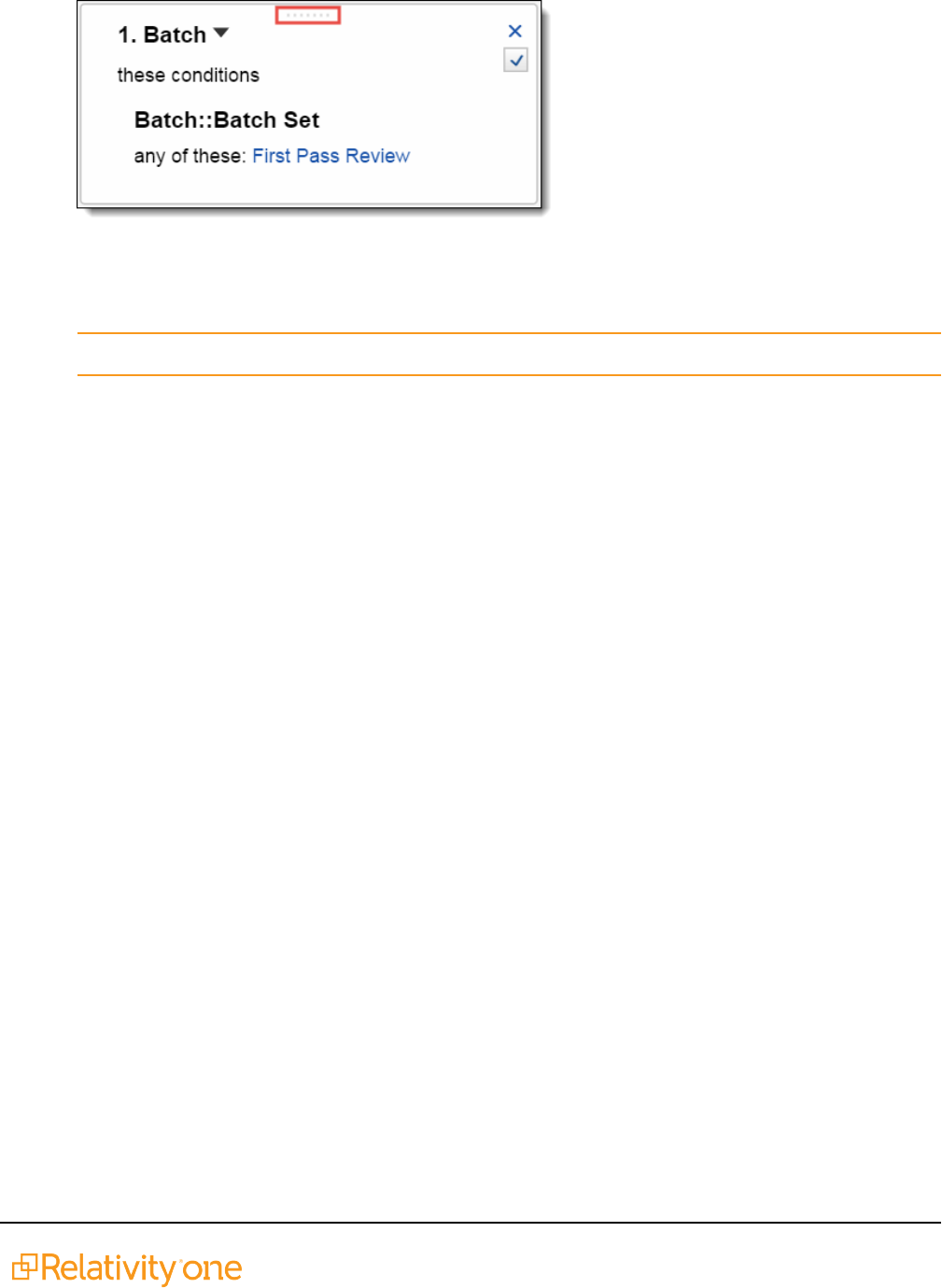
Searching Guide 36
2. Click the handle on the top of the filter condition card you want to add to a logic group.
3. Drag the condition into the logic group frame.
4. Add other conditions to the logic group as needed.
Note: You can also create a logic group automatically by dragging one condition onto another.
5. Click the ANDor OR drop-down menus to set your operators inside your logic group.
6. (Optional)Add additional logic groups and repeat steps 3-5 for the logic groups you add.
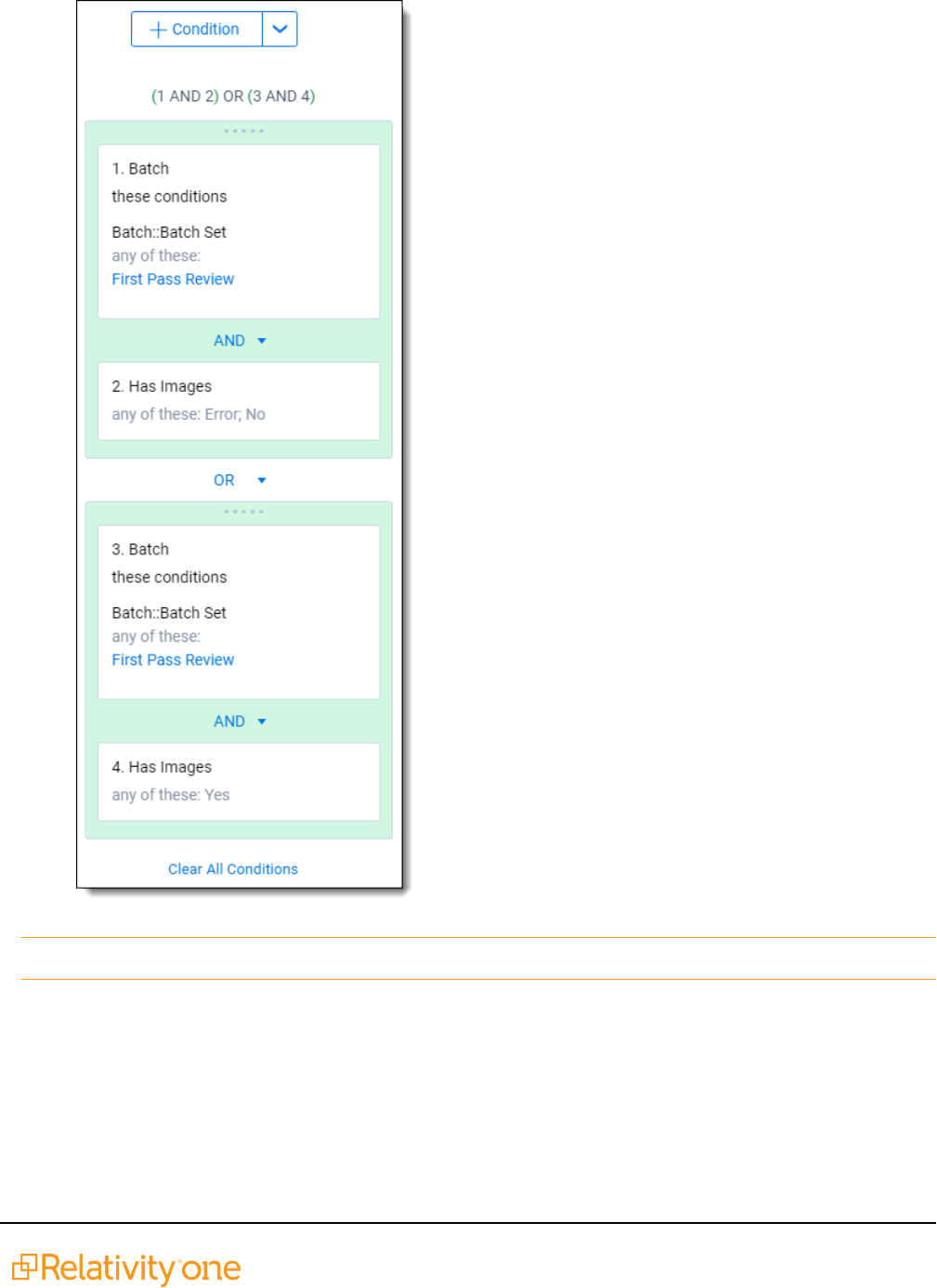
Searching Guide 37
7. Click Run Search if auto-run search is toggled off.) To cancel a long running search, click Cancel.
Note: To remove all conditions from the search panel, click Clear All Conditions.
4.6 Navigating the search panel
Within the search panel you can expand and collapse your search conditions, in addition to toggling the
conditions on and off. By using these options you can better visualize data and make quick changes.

Searching Guide 38
4.6.0.1 Copying conditions
To copy a condition, click in the search panel card.
A pop-up modal opens. In the modal, click Apply to copy the same search condition. Edit the operator and
the search before clicking Apply for a variation of the original search card. Click Add Condition to add
another condition to your new search card.
4.6.0.2 Toggling conditions on and off
You can toggle conditions within the search panel to change the documents the search returns. To toggle
conditions on and off click the checkbox in the lower-right corner of the condition box. If the box is checked
the condition is on; if the box is unchecked the condition is off.
Click Run Search to update the toggled conditions (if auto-run search is toggled off).
Note: To collapse and expand filter condition cards in the panel click the arrow next to the name of the
field applied in the condition.
4.6.0.3 Expanding/collapsing cards
If you have a very long search panel card, you can collapse the card. To collapse a card, click in the top
right corner of the search panel card.

Searching Guide 39
4.6.0.4 Removing conditions
To remove a condition, click X in the upper right corner of the condition box.
Click Run Search to update the toggled conditions (if auto-run search is toggled off).

Searching Guide 40
5 Searching workflows
Relativity provides flexibility to help you identify documents through searches so that you can ready them for
further review and analysis.
This topic highlights setting up multiple search indexes, applying various search techniques, and using
filters properly when executing searches.
Note: For details on searching for dates within Relativity using a filter, a saved search, or a dtSearch, see
the Searching for dates in Relativity knowledge base article on the Relativity Community.
5.1 Workflow details
Relativity offers both Basic Keyword Search and Specialized dtSearch.
The Basic Keyword Search Index populates automatically, is available out of the box, and supports basic
Boolean operations. These operations include AND, OR, NOT, and the wildcard (*) operator.
The Specialized dtSearch Index is custom built and must be set up with an index to query against. In
addition to basic Boolean operations, it also supports the following functionality:
n
Wildcard operator for a single digit (=)
n
Stemming operations (~)
n
Fuzzy search operation (%)
n
Range Searching on Numeric fields (~~)
n
Customize data set to be indexed via custom saved search
n
Proximity Searching
n
Customized Noise Word List
n
Auto Recognition of email addresses, credit card numbers, and dates.
5.2 Best practices for advanced operators
The following includes best practices for the use of advanced operators and workflow options:
5.2.1 Proximity search
Proximity search uses operators to search certain terms in proximity to other terms in a document. Use the
following recommendations when employing proximity searching:
n
To use directional proximity searching use "pre /x " operators. To use non-directional proximity
searching use "w /x" operators.
n
To determine the beginning and end of a document, use reserved word with either ("xfirstword") or
("xlastword"). Use these operators to search for metadata like email addresses or footers within a doc-
ument.
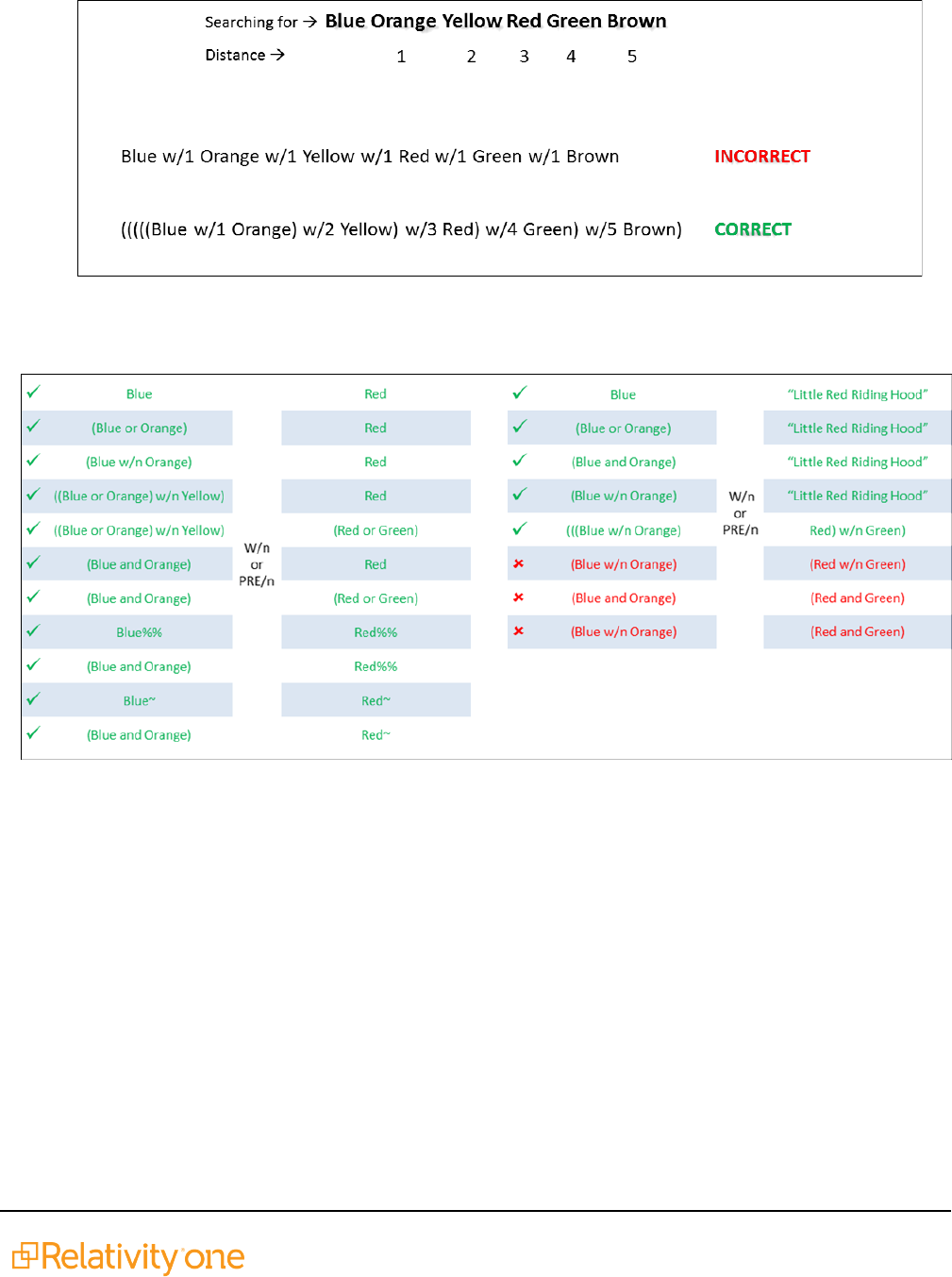
Searching Guide 41
n
To determine proximity. The distance between terms is important so you know whether you receive
true hits or false positives. The following image illustrates the proper syntax for proximity searches:
The following image shows all correct and incorrect combinations of proximity searches that result in
successful hits when using proximity operators:
Sometimes additional factors affect the distance between terms. The following image demonstrates a
search for a string of words in proximity to another word. The search in the following image takes the
following into account:
n
Noise words count as words when calculating proximity.
n
Punctuation counts as whitespace when using default settings.
n
Relativity treats line breaks and consecutive space characters as single spaces.
n
dtSearch default noise words and connector words like AND, OR, BETWEEN, and NOT count as
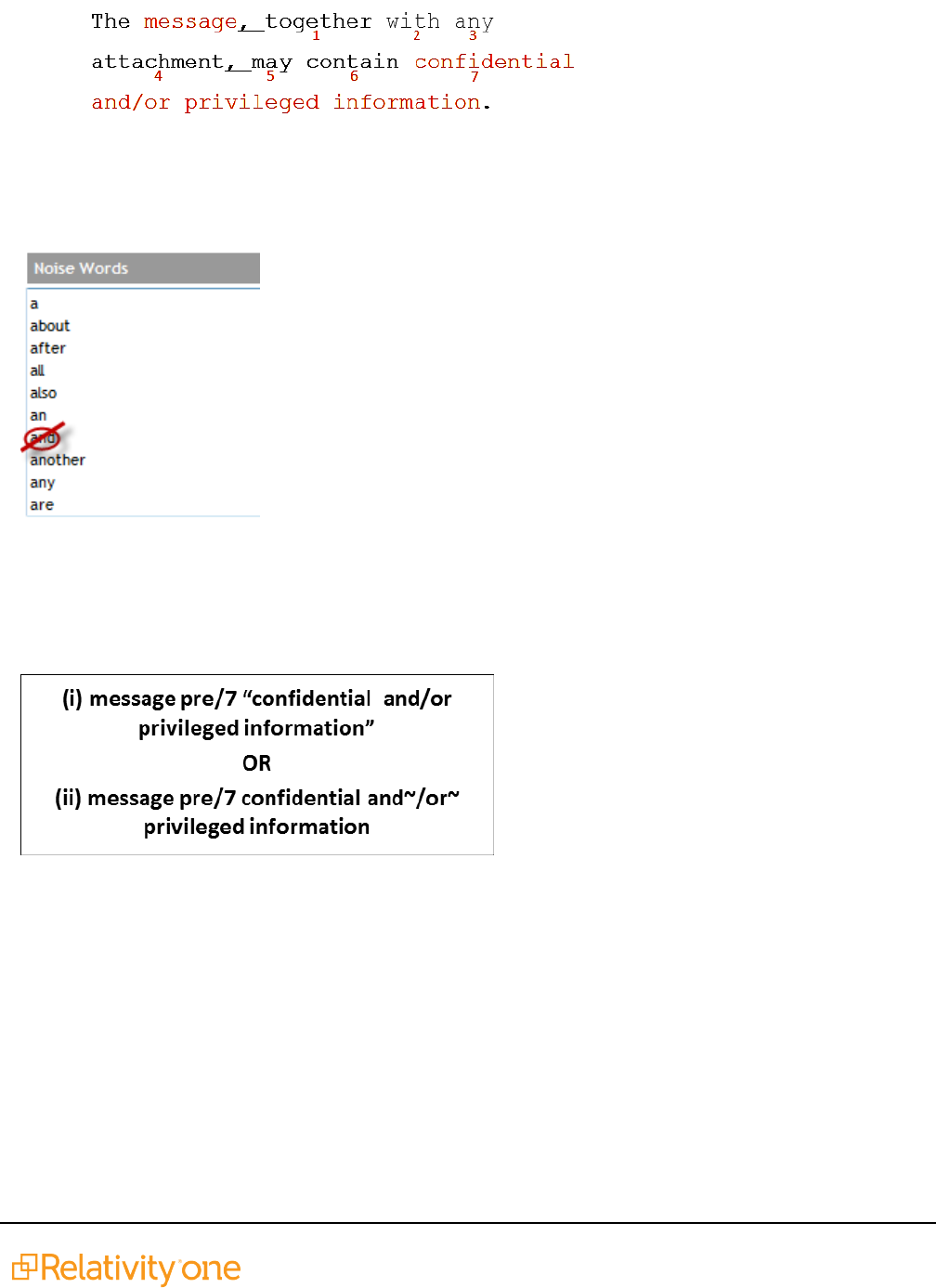
Searching Guide 42
words when calculating proximity.
In this case, we continue to calculate the distance of the string ("confidential and/or privileged information:)
from the word ("message") as shown above. However, when using connector words, system admins should
create an index that removes noise words from the noise word list.
Relativity reserves the following noise words and characters, which continue to behave as operators, as
well as being noise words: and, or, not, to, contains, xfirstword, xlastword, ", (), *, ?, %, @, ~, #, &, :, =.
Once that index is available for query you can either place the search string in quotes or apply stemming to
the connector words to override their function as a connector.
5.2.2 Auto-Recognition
Auto-Recognition identifies email addresses, dates, and credit card numbers in the data set you want to
index. You can turn this feature on and off when you build your index. The search returns the results
regardless of the data format. Auto-Recognition adds some time to your index build, but, depending on your
case, the benefits can be significant.
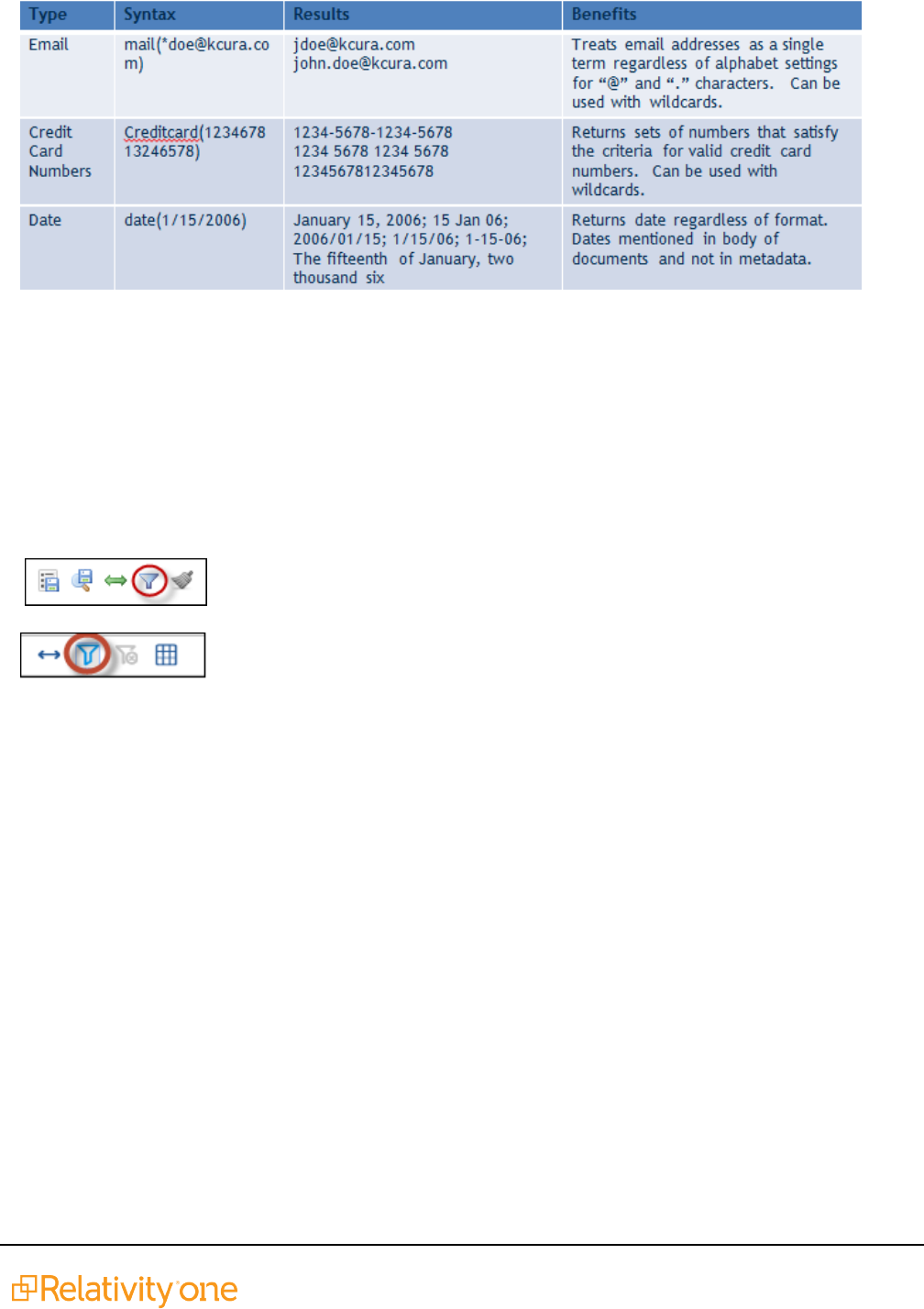
Searching Guide 43
5.2.3 Searching for times
If you want to search for times in the body of documents, perform a full-text search with your dtSearch index
for a specific time. Keep in mind that some characters cause a word break, such as the colon and period.
Searching for 12:15 p.m. results in searching for four words: 12, 15, p, and m.
5.2.4 Filters
In addition to the Search Indexes, you can also use filters to search on metadata fields and narrow down the
review set of documents.
The following list includes metadata fields, their corresponding field types, and the filter type available in
Relativity:
n
File Type - Single-Choice, List Filter
n
Custodian - Single-Choice, Pop-Up Filter
n
Date Sent - Date, Textbox Filter
n
Email To - Long Text, Textbox Filter
n
Email Subject - Fixed Length Text, Custom Filter
n
Designation - Single Choice, Multi-Choice List
The following table shows different types of filters you can set up with available fields in Relativity.
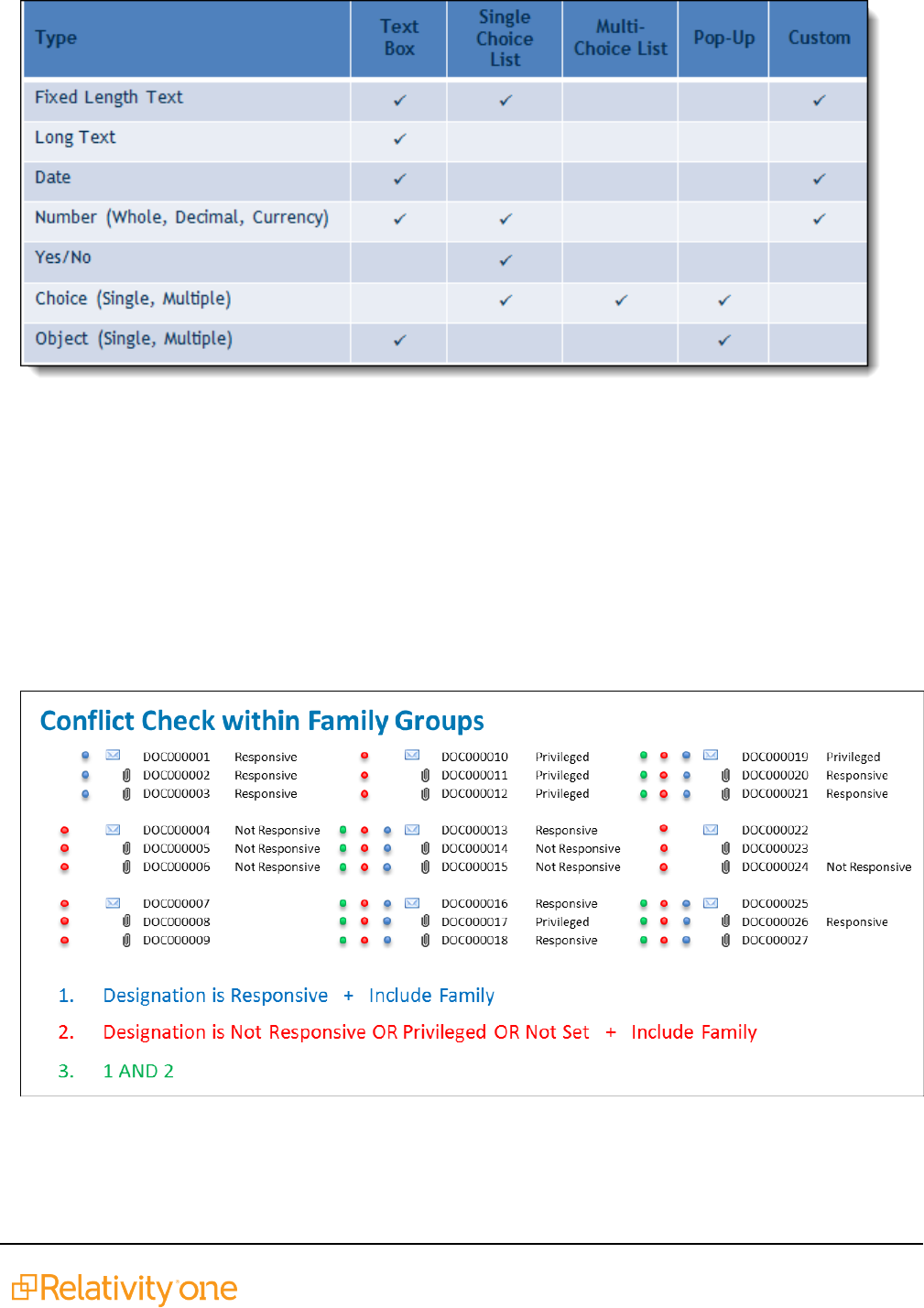
Searching Guide 44
5.2.5 Troubleshooting workflow
To troubleshoot and test searches, use a white board approach to map out searches before you run them.
As part of the process, try to take into account all possible variations, so you can see which documents
Relativity returns and to gain a better understanding of the search. For instance, if you want to find email
family groups with inconsistent coding, numerous possibilities for searches exist. The following illustration
shows a mapping of nine email family groups, each with an email and two attachments.
Construct searches (1 and 2) and mark the corresponding documents, and their family members, with hits
for each of the searches. At this point, when you look at the board, you can see that the four email family
groups have one thing in common. The documents are responsive to both searches. So, to close it out,
construct a third search that pulls back documents common to both searches.

Searching Guide 45
6 Search conditions
You can use the search conditions option to build complex queries by selecting fields, operators, and
values. While this feature has the same functionality as the search condition section of the saved search
form, it's conveniently available from the Documents tab and Relativity Dynamic Object tabs. This option
displays up to five rows, with each row representing a separate criterion. Depending on the type of field you
select, different operators appear. You can use this option alone or in conjunction with keyword searches,
dtSearches, Analytics, or Cluster visualization. When you use search options in conjunction with another
search feature, documents must both meet the search criteria and also the conditions specified.
Note: To use the search conditions option, you must have add or edit permissions for Search and access
to the Saved Searches Browser assigned to you through the Security page. See Workspace security in
the Admin Guide.
6.1 Setting up search conditions
6.1.1 Setting up search conditions in the Search panel
To set up search conditions in the Search panel follow these steps:
1. Navigate to the Search Builder.
2. Click Add Condition and select the fields to which you want to apply conditions.
A pop-up window opens for each condition field you select.
3. Set the required conditions in the relevant field pop-up window by selecting the desired field or by
choosing a field category and then selecting the desired field.
4. Click Apply.
5. (Optional) Click Add Logic Group to add a logic group. Logic groups are evaluated first, and then
connected to other filter conditions or logic groups using AND / OR operators.
6. (Optional) Drag and drop conditions together to create logic groups.
7. (Optional) Add the ANDor ORoperators to connect the criterion.
8. Click Apply.
If you need to edit the condition, click on the condition card. The pop-up reopens so you can make changes.
6.1.2 Setting up search conditions in the Search browser
To set up search conditions in the Search browser, follow these steps:
1. Click the Saved Search icon to navigate to the Search Browser.
2. Click New Search.
3. Click Add Condition and select the fields to which you want to apply conditions.
A pop-up window opens for each condition field you select.

Searching Guide 46
4. Set the required conditions in the relevant field pop-up window.
5. Click Apply.
6. (Optional) Click Add Logic Group to add a logic group and drag and drop your conditions into the
frames. Logic groups are evaluated first and then connected to other filter conditions or logic groups
using AND / OR operators.
7. (Optional) Add the ANDor ORoperators to connect the criterion.
8. Enter all required fields.
9. Click Save or Save As.
If you need to edit the condition, click on the condition card. The pop-up reopens so you can make changes.
6.1.3 Using the multiple object condition builder
You can set conditions for multiple object fields from a single pop-up window. The following example uses
Batch as a multiple object field condition.
To use the multi-object condition builder, follow these steps:
1. Click Add Condition from the Search browser or Search panel.
2. Enter or select Batch.
The Condition:Batch window opens.
3. Select the desired operator from the Operator drop-down list. For example, these conditions.
4. Click Add Condition.
5. Select the condition from the Add Condition drop-down list. For example, Batch::Batch Set.
6. Click the available fields from the Available column and move them to the Selected column as
desired.
7. Click Apply.
8. (Optional) Click Add Logic Group to add a logic group. Logic groups are evaluated first and then
connected to other filter conditions or logic groups using AND / OR operators.
9. (Optional)Drag and drop conditions into logic groups as desired.
10. Click Apply on the Condition:Batch window.
Relativity applies your search conditions.
For more information about multiple object searching logic, see Multiple object searching.
6.2 Canceling queries
You can cancel a long-running search or view by clicking the Cancel button. This link appears when you
perform a keyword search, dtSearch, Analytics search, or use Pivot. It also appears when you filter or sort a
document or Dynamic Object list. It also appears when you perform other actions on item lists containing
documents or Dynamic Objects that initiate a query in the background.
When you click Cancel Request, Relativity stops the background query used to populate documents in an
item list. If you edit a search and click this link, your changes save, but the item list doesn't load. For
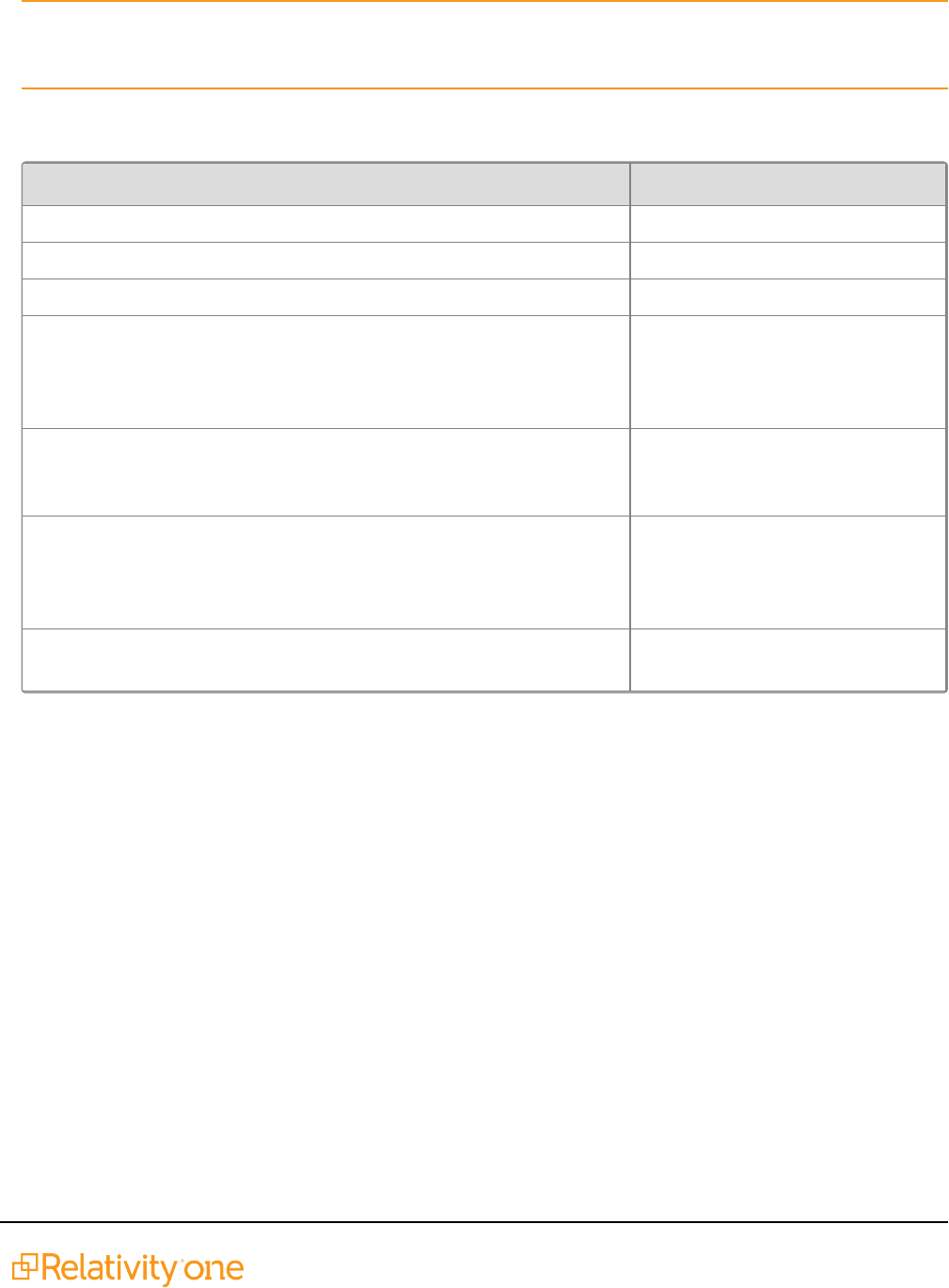
Searching Guide 47
example, your changes save when you perform a mass edit on a list of documents in a search and then click
Cancel Request when the query is running to redisplay the updated list.
Note: Relativity creates an audit record in the History tab for canceled queries. The query description
displays the running time of the query and indicates that it was canceled. You must have the appropriate
permissions to view this tab.
The following table explains different scenarios in which you might cancel a running query and whether the
query actually cancels.
Scenario Result
You start a query and click Cancel Request or Cancel. The query is canceled.
You start a query and close the browser. The query is canceled.
You start a query and an system admin resets the IIS on the server. The query is not canceled.
You start a query and leave your browser idle for longer than the ses-
sion timeout specified in Relativity web.config, regardless of whether
you clicked OKor Cancel on the message from the webpage pop-
up.
The query is not canceled.
You start a query and click Cancel on the message from the
webpage pop-up within the session timeout specified in Relativity
web.config.
The query is canceled.
You start a query and click OK on the message from webpage pop-
up within the session timeout specified in Relativity web.config.
The query continues to run. Relativ-
ity returns you back to the waiting
screen (see the first row of this
table).
You start a query and paste a different URLinto your browser, or you
refresh the page.
The query is canceled.
6.3 Frequently asked searching questions
This section includes frequently asked questions from Relativity users.
6.3.1 Multiple terms in dtSearch queries
Why would I receive an error message saying my query is too complex?
Relativity can't return precise results when a query includes search conditions that are too complex due to
the use of multiple search terms. To avoid this error message, simplify your search criteria. For example,
search for 10 instead of 50 terms in your query. You can save and tag your search results from each simpler
query. With this approach you can search on the required terms, while providing better results.
6.3.2 Proximity searches in dtSearch queries
Why are terms in my proximity search highlighted even when they don't match my defined W/N criteria?
Relativity highlights terms that meet the requirements of your proximity search as well as the individual
search terms. This behavior doesn't affect the results of your proximity search, which returns the
appropriate documents. For example, the results of a proximity search for instances of law within three
words of order (that is "law W/3 order") includes highlighted terms of "law" and "order" when they aren't

Searching Guide 48
within three words of each other. To accommodate this behavior, focus only on the results that match the
proximity search criteria, and disregard the other highlighted terms.
6.3.3 Using reserved characters in dtSearch queries
Can Iuse a reserved character such as ampersand (&) in my dtSearch queries?
The following characters have special meaning in dtSearch, and must be treated with care when they
appear in your queries: ?, *, %, ~, #, =, :, &, (). Use the dictionary to explore syntax options if necessary.
If you want to make any of these characters searchable, you must add them to the alphabet file and, in some
cases, use Regular Expressions in your search. For more information, see the Searching Guide.
6.3.4 Multiple conditions
Why do my searches run slowly when I use multiple conditions?
When you add multiple search conditions to a query, Relativity searches on these conditions relative to
each other, which slows down the return of your results. For example, you experience slow performance
when running a query on all email messages received "after June 1" and "before June 30" of the same year.
You can improve performance by using as few conditions as possible, such as excluding the condition
"before June 30". Run the query with only the condition "after June 1", and then sort or filter your results to
display messages received between the desired dates.
6.3.5 Nesting searches
Can I nest multiple searches in a saved search?
For performance reasons, we don't recommend nesting multiple searches in a saved search. You can
select a search as a condition, but using multiple searches as conditions slows down the return of your
results. See the Searching guide for more information.
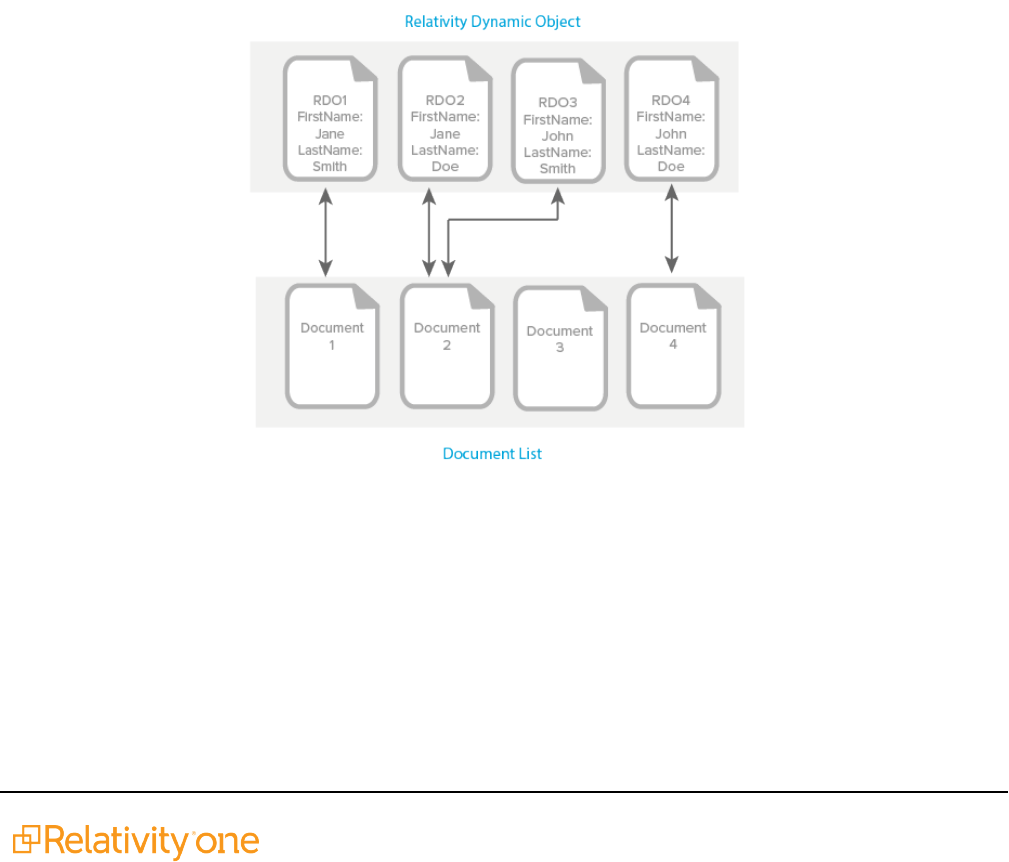
Searching Guide 49
7 Multiple object searching
When searching using These Conditions or NOT These Conditions, keep in mind the following:
n
These Conditions—returns a document if any of the RDOs that document is associated with
matches the search criteria.
n
NOT These Conditions—returns all documents that are not associated with at least one RDO that
meets the criteria.
n
If a document is not associated with the object you're searching, it will not be returned in a search for
These Conditions. Therefore, Document 3 will never get returned in a search for These Conditions
because it is not associated with any objects.
The image below shows documents associated with Relativity Dynamic Objects (RDOs).
n
Document 1 is associated with RDO1.
n
Document 2 is associated with RDO2 and RDO3.
n
Document 3 is not associated with any RDOs.
n
Document 4 is associated with RDO4.
7.1 These Conditions
The following example returns Document 1 because:
n
Document 1 is associated with RDO1.
n
RDO1 matches the search criteria (FirstName Jane, LastName Smith).
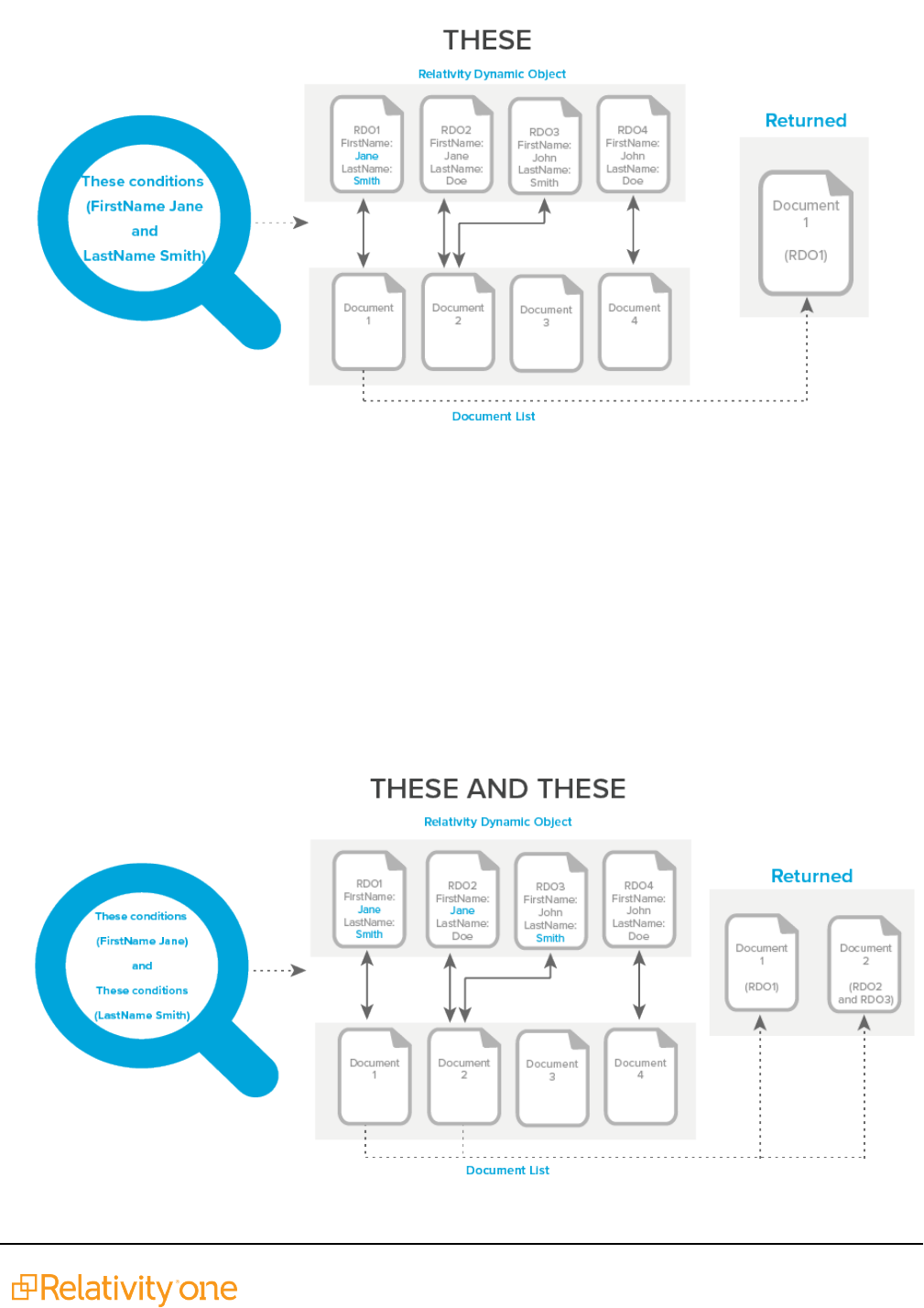
Searching Guide 50
7.2 These Conditions and These Conditions
The following example returns Document 1 and Document 2 because:
n
Document 1 is associated with RDO1.
n
RDO1 matches the search criteria (FirstName Jane) and (LastName Smith).
n
Document 2 is associated with RDO2 and RDO3.
n
RDO2 matches the search criteria (FirstName Jane).
n
RDO3 matches the search criteria (LastName Smith).
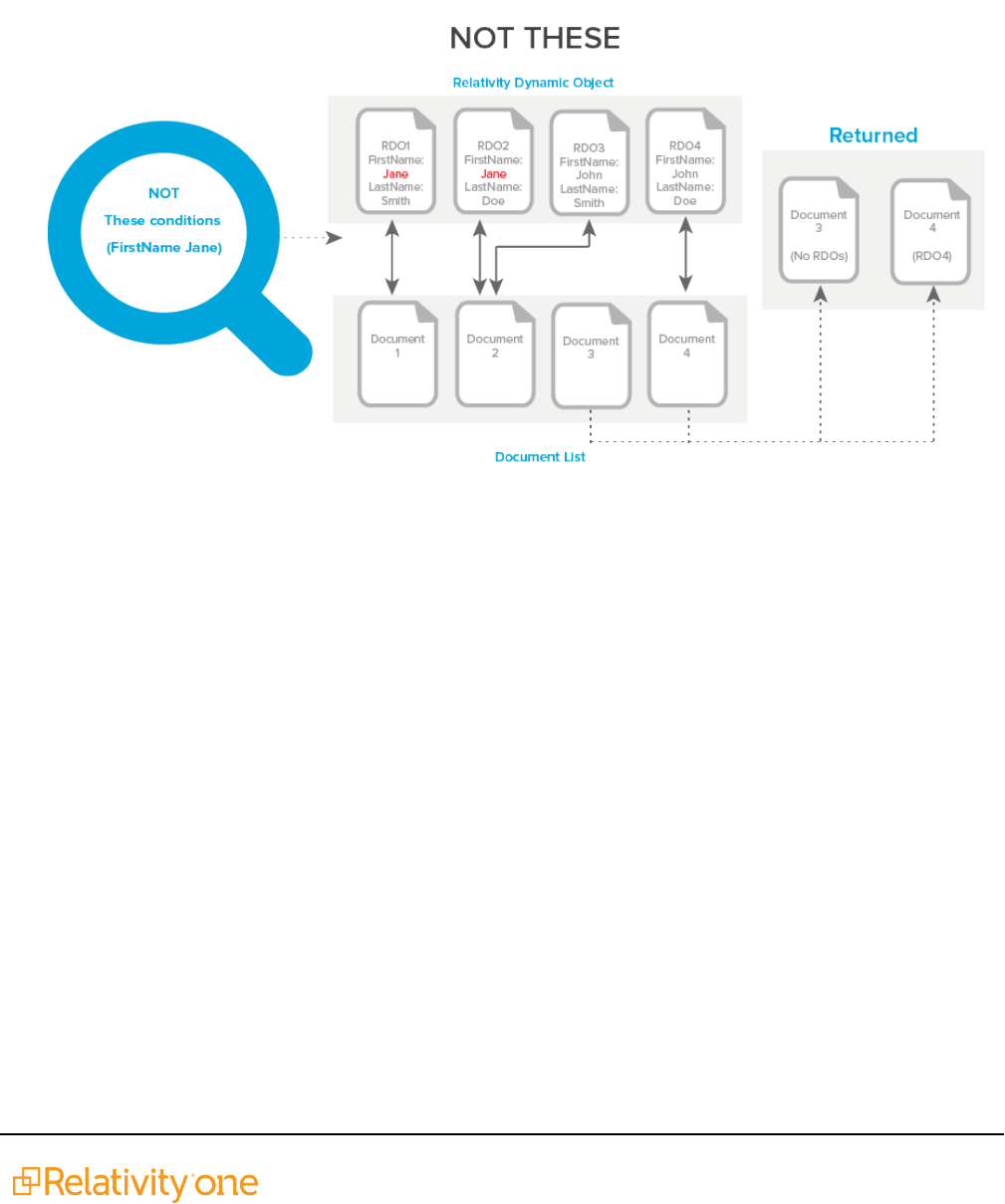
Searching Guide 51
7.3 NOTThese Conditions
The following example returns Document 3 and Document 4 because:
n
Document 4 is associated with RDO4. RDO4 doesn't match the search criteria.
n
Document 3 is not associated with any RDOs. Therefore, it does not match the search criteria.
7.4 These NOT
The following example returns Document 2 and Document 4 because:
n
Document 2 is associated with RDO2 and RDO3.
n
Although RDO2 contains (FirstName Jane), RDO3 does not (FirstName John). Remember, if one
RDO does not meet the criteria, the document is returned.
n
Document 3 is not returned because it isn't associated with any RDOs. Remember, you must asso-
ciate a document with an object in order for it to return in a These Conditions search.
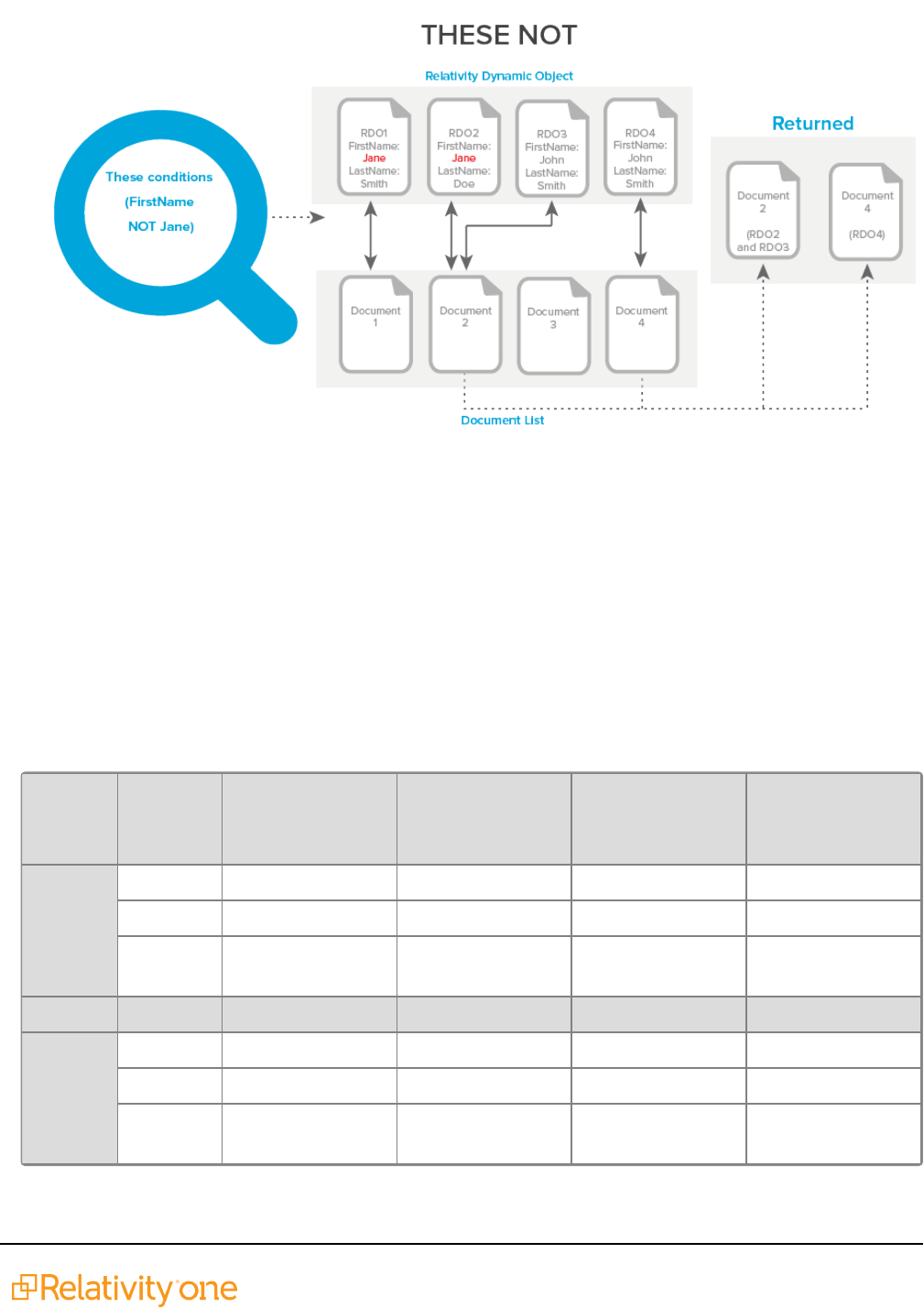
Searching Guide 52
7.5 None of these and Not all of these operators
The difference between None of these and Not all of these is subtle, but useful:
n
None of these will check the field and see if any of the choices on it match any of the conditions.
If there are any choices checked on the field and one of them matches one of the conditions, the doc-
ument will be rejected and not pulled by this search.
n
Not all of these will check the field and see if the choices on it match all the conditions.
If yes, the document will be rejected. If only some of the choices match the conditions, the document
will be pulled by this search.
Comparison of operators table
Document 1
Coded Choice 1
Document 2
Coded Choice 1
and Choice 2
Document 3
No coding
Document 4
Coded Choice 2
Any of
these
Choice 1 √ √
Choice 2 √ √
Choice 1
and 2
√ √ √
None of
these
Choice 1 √ √
Choice 2 √ √
Choice 1
and 2
√
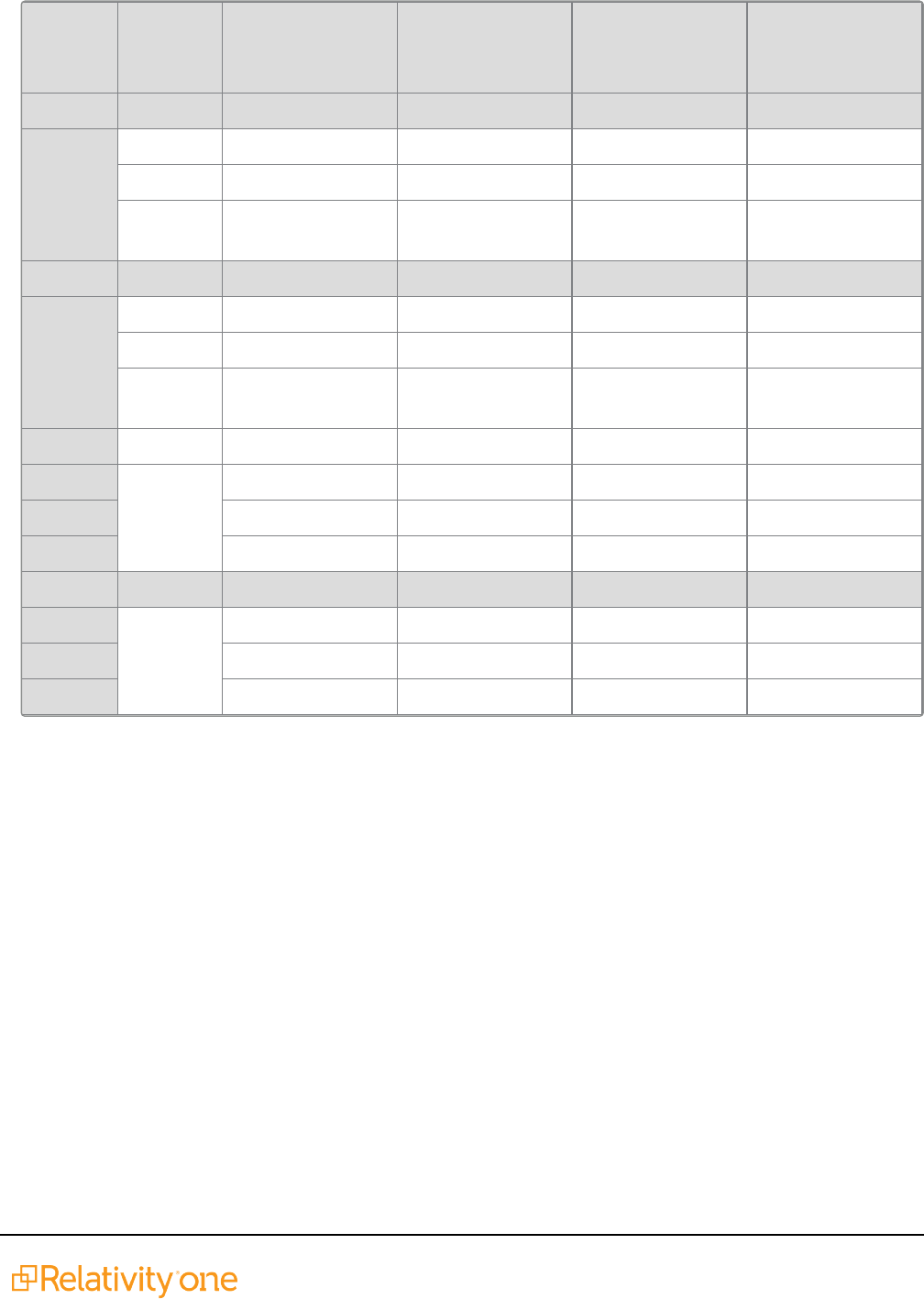
Searching Guide 53
Document 1
Coded Choice 1
Document 2
Coded Choice 1
and Choice 2
Document 3
No coding
Document 4
Coded Choice 2
All of
these
Choice 1 √ √
Choice 2 √ √
Choice 1
and 2
√
Not all of
these
Choice 1 √ √
Choice 2 √ √
Choice 1
and 2
√ √ √
Is set √ √ √
√ √ √
√ √ √
Is not set √
√
√

Searching Guide 54
8 Searching with the Entity object and name
normalization
This topic describes the types of searches you can conduct using the Entity object and Name Normalization
results.
8.1 Considerations
Note the following special considerations:
n
The quality of your searches is affected by the quality of your name normalization results. Please use
the Name Normalization Quick Reference Guide to verify your Name Normalization results.
n
You can only create the following searches after running the name normalization operation.
8.2 Emails within a specific organization
To find emails between individuals within a specific organization, use the Alias From and Alias Recipient
fields along with the associated Alias From::Domain and Alias Recipient::Domain fields. You must
conduct this search with a double negative in order to find documents that only include your selected
organization.
Notes:
n
You can use variations of this search to identify specific cross organization communications. You
can also use variations of this search to identify communications with outside counsel if you know the
specific domain of outside counsel.
n
There are scenarios where an alias doesn’t include a domain (ex. Proper names). In these scen-
arios, the following search will not include documents where those aliases are communication.
Reach out to Relativity Support for alternative workflows to circumvent this issue.
Create a search with the following conditions:
Note: Connect the search conditions as follows using Boolean operators:1 AND 2 AND 3
Condition 1
n
Field: Alias From
n
Operator: is set
Condition 2
n
Field: Alias From
n
Operator:not these conditions
o
Field:Alias From::Domain
o
Operator:is not
o
Text: [Domain 1]
Condition 3
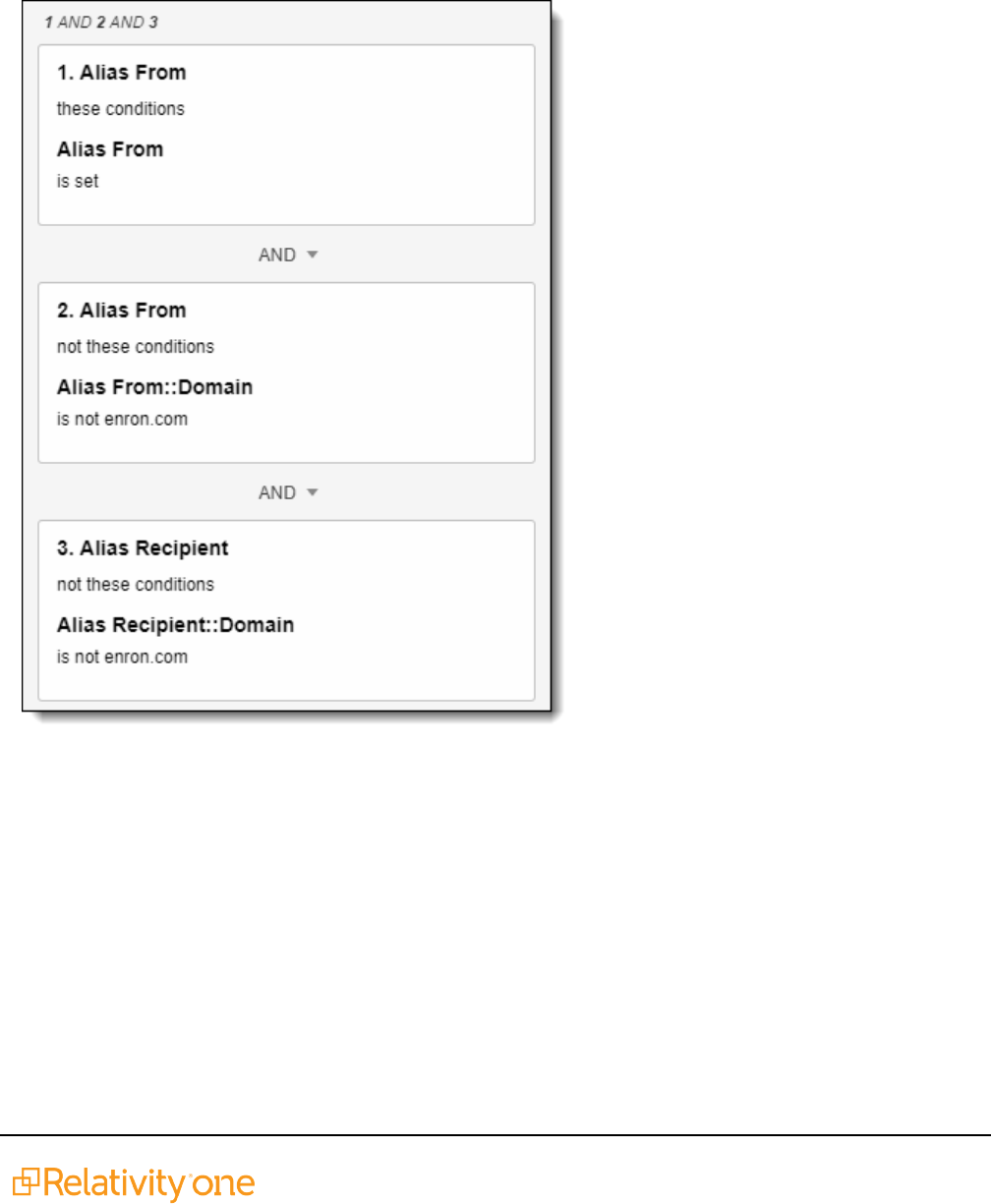
Searching Guide 55
n
Field: Alias Recipient
n
Operator:not these conditions
o
Field:Alias Recipient::Domain
o
Operator:is not
o
Text: [Domain 1]
Breaking it down:
n
Alias From::Domain==not this domain means someone without this domain is the sender
n
Not these conditions [LINE ABOVE] means no domain other than this domain is the sender
8.3 Communications between two specific individuals and no one
else
To find emails between two individuals and no one else, use the Entity From and Entity Recipient fields.
You must conduct this search with a double negative in order to find documents where only your selected
entities appear.

Searching Guide 56
Notes:
n
You can use variations of this search to identify communications where a specific entity is the only
recipient, but the senders vary.
n
You can also use variations of this search to exclude CC or BCC values.
n
You can use the Entity Participant field to ensure no one else existed on the email thread.
Create a search with the following conditions:
Note: Connect the search conditions as follows using Boolean operators and Logic Groups:1 AND ((2
AND 3) OR (4 AND 5))
Condition 1
n
Field: Entity From
n
Operator: is set
Condition 2
n
Field: Entity From
n
Operator:not these conditions
o
Field:Entity From
o
Operator:none of these
o
Text: [Entity A]
Note: This is a double-negative condition that will exclude everyone but Entity A. In other words, this
condition will only allow emails sent by Entity A. When conditions 2 and 3 are combined, we have a
holistic search condition for emails sent by Entity A and received by Entity B.
Condition 3
n
Field: Entity Recipient
n
Operator:not these conditions
o
Field:Entity Recipient
o
Operator:none of these
o
Text: [Entity B]
Note: This is a double-negative condition that will exclude everyone but Entity B. In other words, this
condition will only allow emails received by Entity B. When conditions 2 and 3 are combined, we have a
holistic search condition for emails sent by Entity A and received by Entity B.
Condition 4

Searching Guide 57
n
Field: Entity From
n
Operator:not these conditions
o
Field:Entity From
o
Operator:none of these
o
Text: [Entity B]
Note: This is a double-negative condition that will exclude everyone but Entity B. In other words, this
condition will only allow emails sent by Entity B. When conditions 4 and 5 are combined, we have a
holistic search condition for emails sent by Entity B and received by Entity A.
Condition 5
n
Field: Entity Recipient
n
Operator:not these conditions
o
Field:Entity Recipient
o
Operator:none of these
o
Text: [Entity A]
Note: This is a double-negative condition that will exclude everyone but Entity A. In other words, this
condition will only allow emails received by Entity A. When conditions 4 and 5 are combined, we have a
holistic search condition for emails sent by Entity B and received by Entity A.

Searching Guide 58
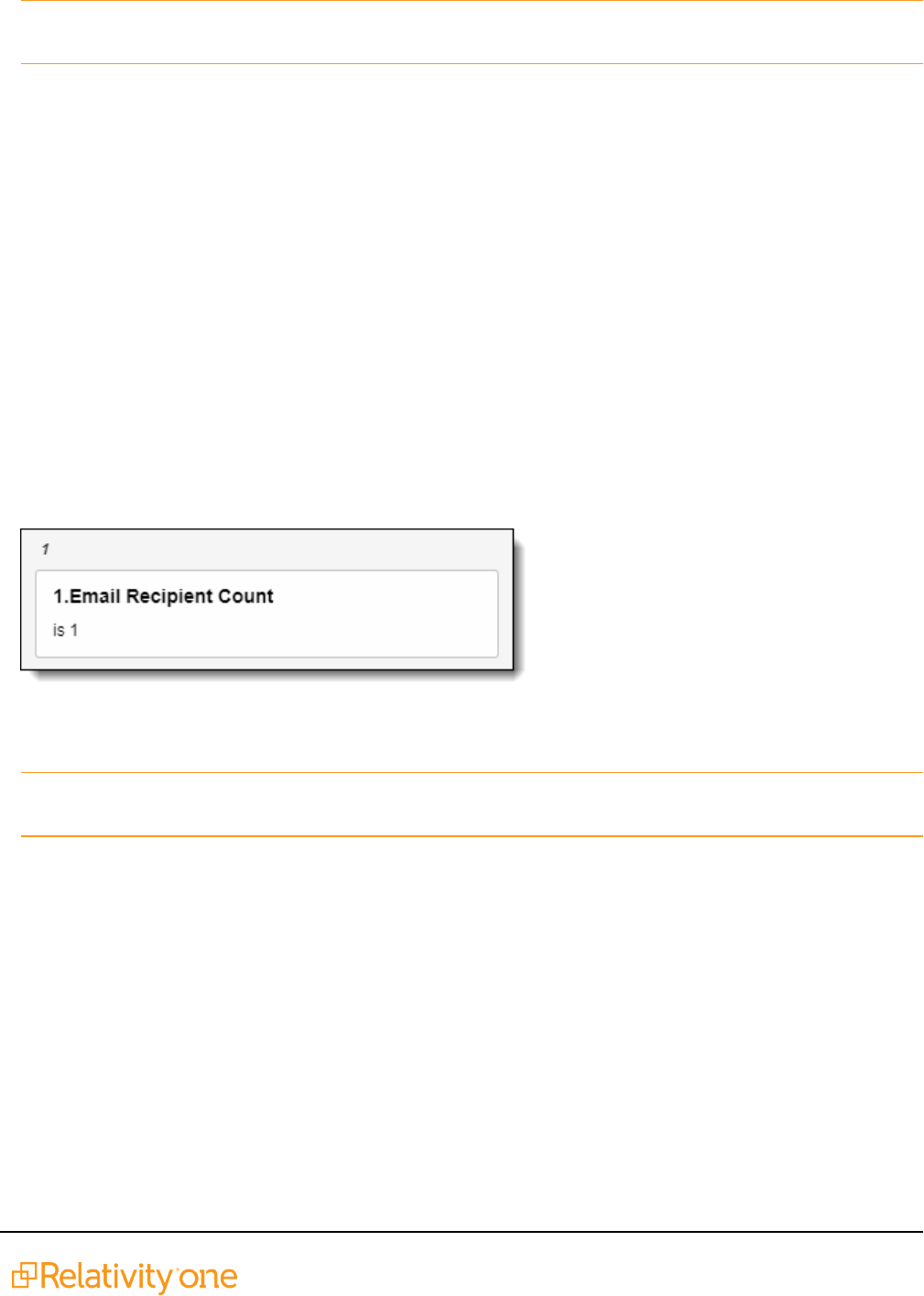
Searching Guide 59
Note: By combining the two logic groups above, we create a holistic set of search conditions that will
return all emails sent from entity A to entity B as well as all emails sent from entity B to entity A.
Breaking it down:
n
Entity From==not this person means someone other than this person is the sender
n
Not these conditions [LINEABOVE] means nobody other than this person is the sender
8.4 Communications between any two individuals and no one
else
To find emails between any two individuals and no one else, use the Email Recipient Count field created
by Relativity Processing or the Delimiter Count by Saved Search script available on the Relativity
Community site to count the number of recipients for each document.
Create the following search:
Field: Email Recipient Count
Operator: is
n
Text:1
Because an email always has a single sender, this search focuses on finding emails that have just one
recipient.
Note: You can also use this search can to filter out email blasts by looking for documents where Email
Recipient Count is greater than 20.
8.5 Emails across entity metadata
You can use any entity metadata field for advanced searching on documents. As an example, to find emails
sent from the Finance department to the Human Resource department, you can use the Entity
From::Department and Entity Recipient::Department fields.

Searching Guide 60
Notes:
n
You can use variations of this metadata search to identify conversations with attorneys, job title,
between your Chicago and Hong Kong offices, location, or between males and females, gender, and
more.
n
You may need to edit the Entity field to set Open to Associations to Yes in order to search across it
on the document object.
n
Importing address book, Active Directory, or CRM information for each entity can give you more
metadata to leverage when searching across documents.
Create a search with the following conditions:
Note: Connect the search conditions as follows using a Boolean operator:1 AND 2
Condition 1
This search indicates that a specific entity value is the sender of the document.
n
Field: Entity From
n
Operator: these conditions
o
Field: Entity From::Department
o
Operator: is
o
Text: [Department 1]
Condition 2
n
Field: Entity Recipient
n
Operator: these conditions
o
Field: Entity Recipient::Department
o
Operator: is
o
Text: [Department 2]
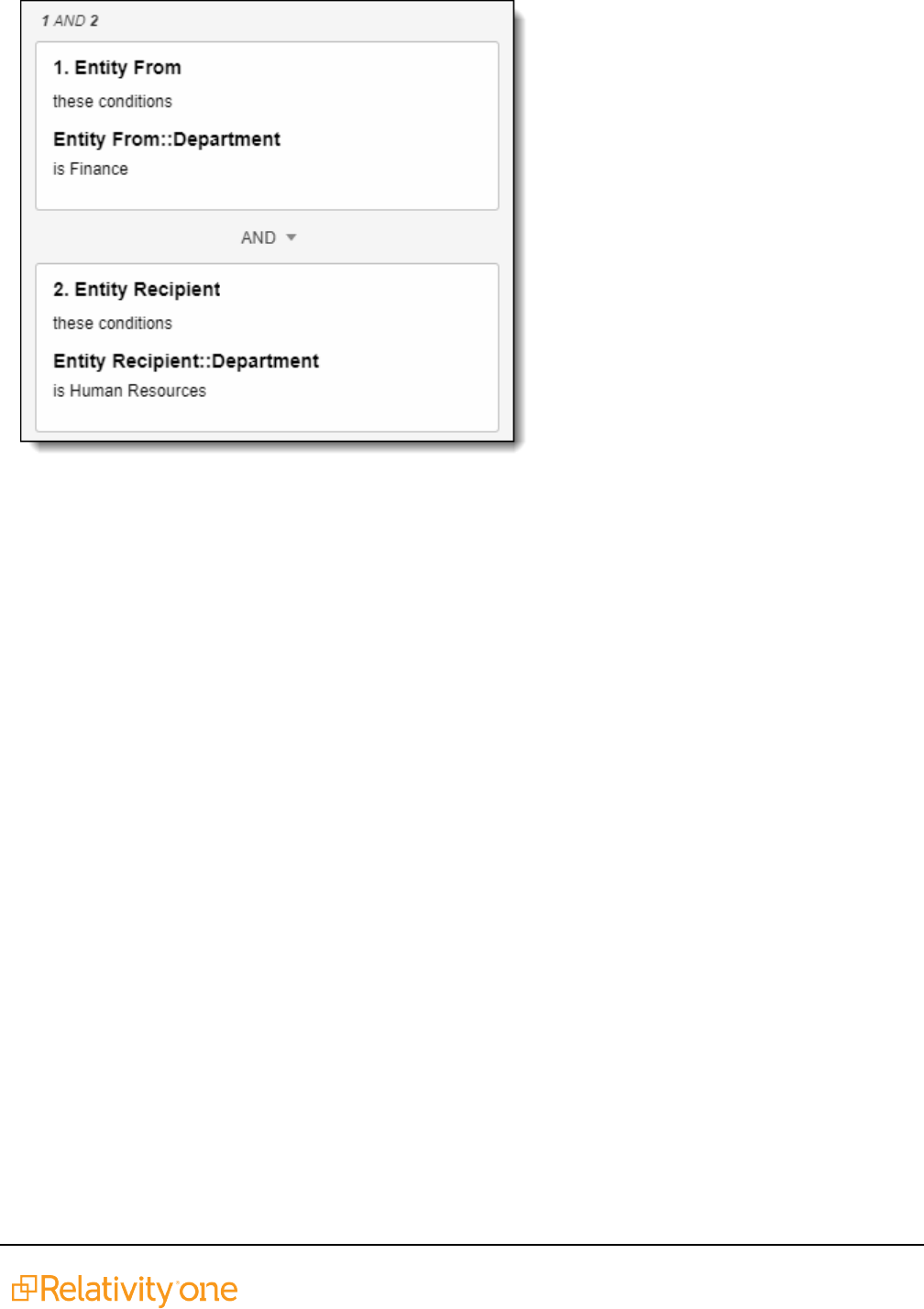
Searching Guide 61
8.6 Emails sent from two different internal domains
To find emails sent between two different internal domains, use the Alias From and Alias Recipient fields.
Use the Text field to define each domain. The logic below pulls emails sent from Domain 1 to Domains 1 or
2 and emails sent from Domain 2 to Domains 1 or 2.
Logic Group 1
n
Condition 1
o
Field: Alias From
o
Operator: these conditions
o
Operator: is
o
Text: [Domain 1]
n
Sub-logic Group 1B
o
Condition 2
l
Field: Alias Recipient
l
Operator: not these conditions
l
Field: Alias From::Domain
l
Operator: is not
l
Text: [Domain 1], [Domain 2]
o
Condition 3
l
Field: Alias Recipient
l
Operator: these conditions

Searching Guide 62
l
Operator: is set
Logic Group 2
n
Condition 4
o
Field: Alias From
o
Operator: these conditions
o
Operator: is
o
Text: [Domain 2]
n
Sub-logic Group 2B
o
Condition 5
l
Field: Alias Recipient
l
Operator: not these conditions
l
Field: Alias From::Domain
l
Operator: is not
l
Text: [Domain 1], [Domain 2]
o
Condition 6
l
Field: Alias Recipient
l
Operator: these conditions
l
Operator: is set
8.7 Emails someone sent to themselves
To find emails someone sent to themselves and nobody else, use the “Entity From” and “Entity Recipient”
fields. You must conduct this search with a double negative in order to find documents that only include our
selected entity.
Note: This search may be impacted by whether you decided to group professional and personal aliases
under a single entity or separate entities.
Create a search with the following conditions:
Note: Connect the search conditions as follows using a Boolean operator:1 AND 2 AND 3
Condition 1
n
Field: Entity From
n
Operator: these conditions
o
Field:Entity From
o
Operator:is set
Condition 2
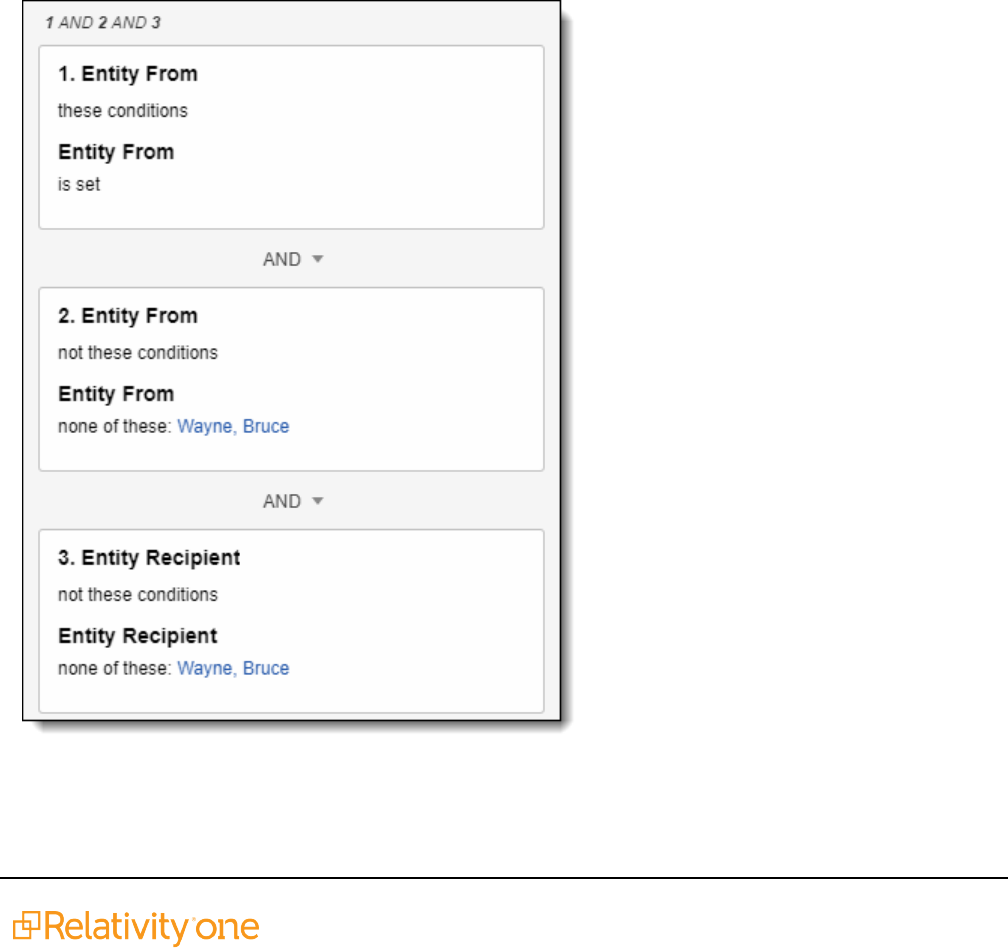
Searching Guide 63
This search indicates that someone other than this person is the sender.
n
Field: Entity From
n
Operator: not these conditions
o
Field: Entity From
o
Operator: none of these
o
Text: [Entity 1]
Search 3
n
Field: Entity Recipient
n
Operator: not these conditions
o
Field: Entity Recipient
o
Operator: none of these
o
Text: [Entity 1]
Breaking it down:
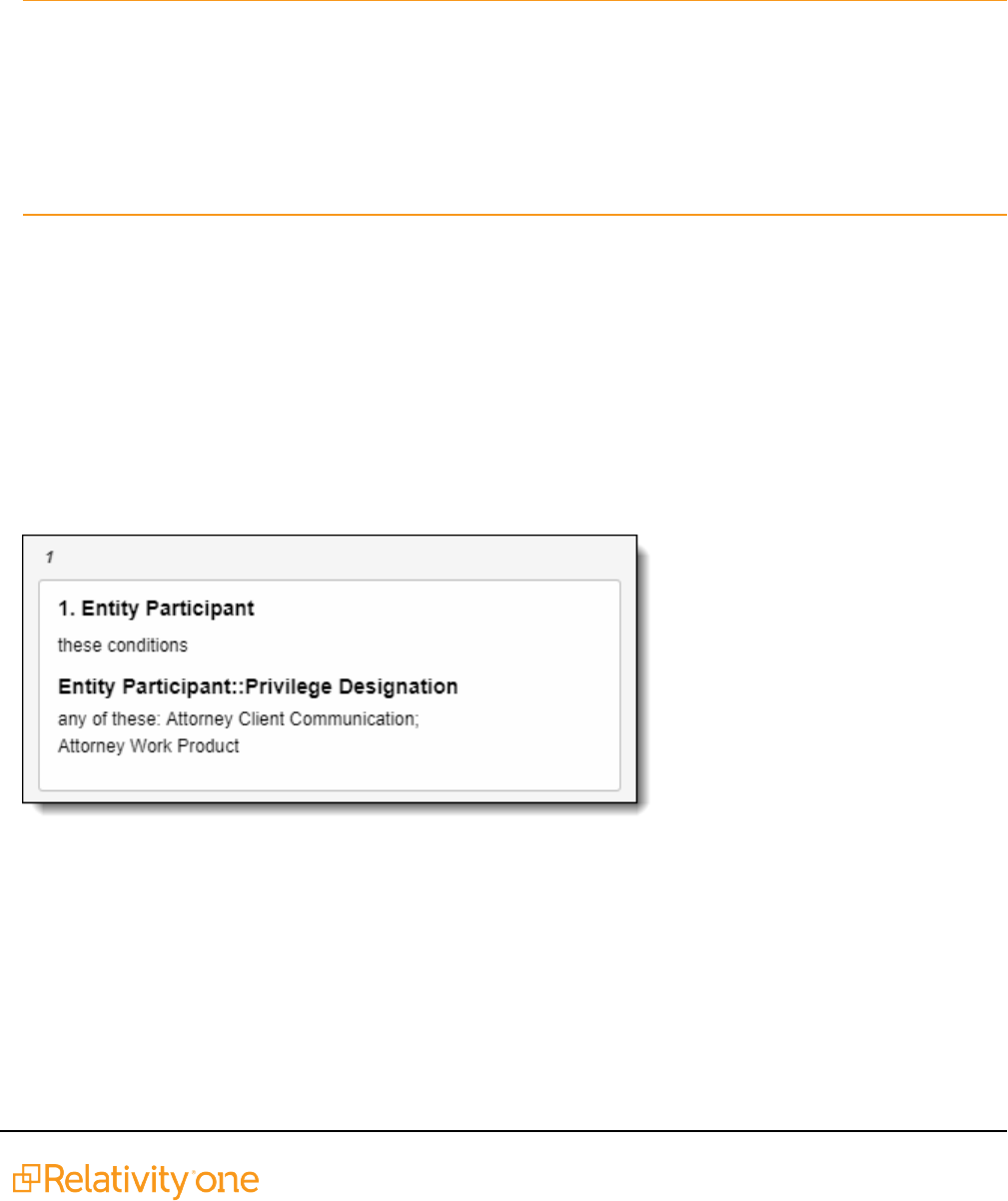
Searching Guide 64
n
Entity From==not this person means someone other than this person is the sender
n
Not these conditions [LINEABOVE] means nobody other than this person is the sender
8.8 Entities that communicated on privileged documents
To find a list of entities that communicated on privileged documents, use the Entity Participant::Privilege
Designation field on the Entity object (Entities tab).
Note:
You must edit the Privilege Designation field to set Open to Associations to Yes in order to search
across it on the document object.
You can use a variation of this search using the Participant field to return the entities that only sent or
received privileged documents rather than participated in any segment of the document .
You can use variations of this search to return the entities that communicated on a document that have
any specific attribute. For example, entities that communicated on Hot documents.
Create the following search:
n
Field: Entity Participant
n
Operator: these conditions
o
Field: Entity Participant::Privilege Designation
o
Operator: any of these
o
Text: [Designation Type(s)]
This search locates Entities that exist in the Entity Participant field of documents that have this specific
value in the Privilege Designation field.
8.9 Emails where a specific person drops off of a communication
To find emails where a specific person dropped off an email chain, use the Entity From, Entity Recipient,
and Entity Participant fields. This search finds all documents where the person appears in a lowers email
segment within the document (Entity Participant), but not the top email segment (Entity From and Entity
Recipient).
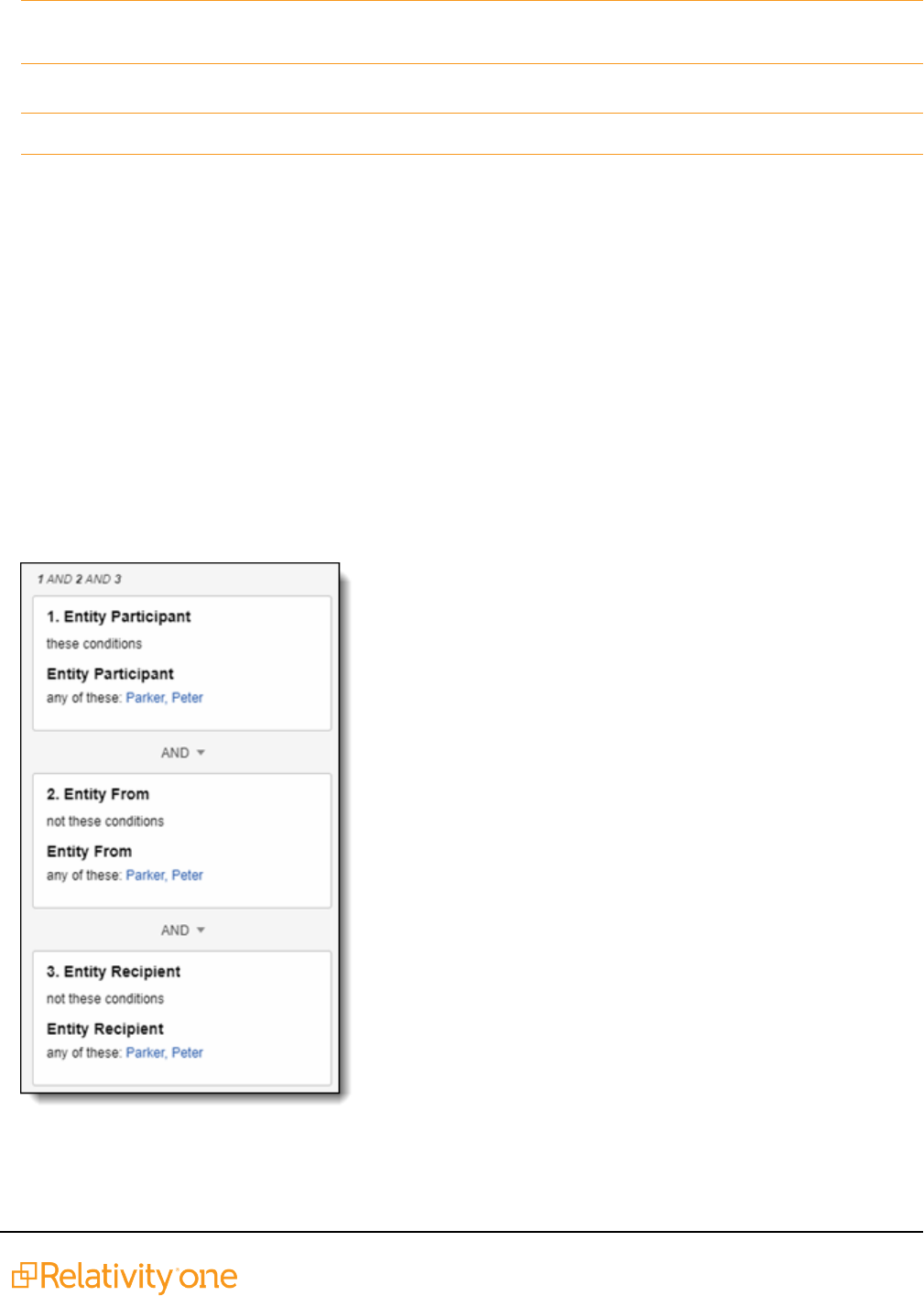
Searching Guide 65
Note: Adding multiple people to the search can cause documents to be missed. If you want to search for
multiple people, create separate search cards for each person.
Create a search with the following conditions:
Note: Connect the search conditions as follows using a Boolean operator:1 AND 2 AND 3
Condition 1
Entity Participant (these conditions), Entity Participant (any of these [Entity 1])
n
Field: Entity Participant
n
Operator: these conditions
o
Field: Entity Participant
o
Operator: any of these
o
Text: [Entity]
Condition 2
Entity From (not these conditions), Entity From (any of these [Entity 1])
Condition 3
Entity Recipient (not these conditions), Entity Recipient (any of these [Entity 1])

Searching Guide 66
9 dtSearch
Relativity's dtSearch engine provides advanced search functionality such as proximity, stemming, and fuzzy
searches across any field type. It also supports the use of Boolean operators and custom noise word lists
and the basic searching features available in keyword searches. After building your dtSearch index, the
Dictionary search option becomes available.
Note: Relativity partitions a single index into multiple smaller indexes (called sub-indexes), which multiple
workers build simultaneously. This increases performance by spreading out the work over a configurable
number of agents. When you perform a search, Relativity runs your query on the smaller indexes in
parallel. The application then federates and returns your results. For more details, see the Ask The Expert
Training content: Searching: Best Practices for dtSearch Builds.
Using dtSearch indexes
There are roughly three million files relevant to a case you are working on, including emails, email
attachments, invoices, and technical manuals related to construction practices and material
handling. It is early in the case, and you need to gain an understanding of the data set. You also
need to retrieve certain text related to five substances that you know are prevalent in this data, as
an employee from the construction company mentioned these specifically in an email to you. To
do this, you need to be able to perform proximity, stemming, and fuzzy searches on your data set.
So you create a new dtSearch index.
You call the index Hazardous Materials dtSearch so that you can identify it in the Search drop-
down menu on the Documents list. You might also create an Analytics index for this case with a
similar name, so make sure to differentiate them clearly. For the Searchable set field, you select a
saved search that you have already created called Hazardous Materials searchable set, which
has documents to which you have already applied keywords related to the substances mentioned
in your client's email.
Because many of the invoices and emails in your data set contain references to various
purchases of building materials made by various departments in the construction company you
are helping to represent, you set the Auto-recognize date, email, and credit card numbers field to
Yes.
You leave all other fields at their default settings and save the index. You then build and activate
the index so that you can select it in the Search drop-down menu.
When you select the index and search your document set on it, you run proximity searches to see
how close terms relating to hazardous substances occur to the names of the building materials
that may or may not contain them. The searches you run include the following:
n
lead W/10 paint
n
lead W/10 plumbing pipes
n
lead W/10 connectors
n
lead W/10 solder
n
asbestos W/10 insulation and
n
asbestos W/10 pipe coverings

Searching Guide 67
n
asphalt W/10 sealant
n
asphalt W/10 adhesives
n
radioactive W/10 fluorescent lamps
n
radioactive W/10 smoke detectors
As you keep running these proximity searches, you get down to a small group of intriguing emails
between a prospective buyer, your client, and a prospective seller, which may prove that the seller
had knowledge of the fact that those building materials were potentially dangerous when they
were negotiating a price with your client. This discovery turns out to be crucial to the case.
9.1 Creating a dtSearch index
You can build custom dtSearch indexes for a subset of documents or for certain document fields in a
workspace. You must have the appropriate permissions to complete this task. See Workspace security in
the Admin Guide.
Before you begin, you need to create a saved search that includes the fields that you want to include in the
index. You can then name the index based on the document search set used to create it.
Note: Within a field, dtSearch truncates any string longer than 32 characters that does not contain a
space character. It indexes only the first 32 characters of the string. For more information, see Searching
for words longer than 32 characters.
To create a new dtSearch index:
1. Use the search feature to navigate to the Search Indexes tab.
2. Click New Search Index.
The dtSearch Index Information form appears with required fields having an orange asterisks.
3. Complete the fields on the dtSearch index form. See more details, see Fields.
4. Click Save to display the index details page. The index details page now displays three additional
read-only fields and the dtSearch index console. See Fields and dtSearch console.
5. Click Build Index: Full. A dialog box asks you to verify that you want to run a full build. You can also
select Activate this index upon completion. Indexes must be active to search them.
6. Click OK to build your index.
Note: Network problems can slow down your dtSearch builds. If a dtSearch manager or worker
agent encounters a network-related error during the build process, it executes up to three retry
attempts at 30-second intervals.
7. If you did not select Activate this index upon completion in the dialog box, click Activate Index on
the console. The index will not activate if there are errors. Activating an index makes it available in the
Search menu.

Searching Guide 68
8. (Optional) Click Refresh Page at any point in the build to see the index's current build status. If errors
occur during the build, the Retry Errors button enables on the console under the Errors and Status
heading. Click this button to try to resolve any errors.
Once the index builds, the console enables additional options. See dtSearch console.
9.1.1 Accent-insensitive indexes
By default, Relativity builds an accent-insensitive index. In an accent-sensitive index, some characters
translate to the base character, which causes those characters and any terms containing those characters
to be treated the same in a Search Terms Report.
Note: dtSearch uses .ABC files, but only for characters in the range from 33 to 127. Relativity handles all
other characters according to the definitions in the Unicode character tables.
Example: Relativity converts accented characters like á or ñ to the unaccented versions, a or n.
Example: If you search for the term fröhlich, searching that term as fröhlich or frohlich would both return the
hit. However, highlighting in the Viewer may not display both variations.
9.2 Fields
The dtSearch index page includes the following fields:
dtSearch Index Information
n
Name—the dtSearch index name. This name appears within the search with menu in the Docu-
ments tab.
n
Order—the integer value, positive or negative, representing the position of the index in the search
indexes list. Indexes sort from lowest, top, to highest, bottom, order number. Those with the same
order number sort alphanumerically.
n
Searchable set—the saved search of documents for indexing. Relativity indexes the documents
returned by the search as well as the returned documents' fields. It may use a dtSearch or an Ana-
lytics index. Make sure the index is active.
Note: When creating a saved search for a dtSearch index, the best practice is to use long
text fields. You will see a warning message, when creating a dtSearch index, if you select a
saved search that does not contain at least one long text field.
n
Email notification recipients—enter the email addresses of those who should receive notifications
of whether the dtSearch index build succeeded or failed.
Searchable Set - Current Indexable Fields
This section is a list of the fields and field types in the saved search used for indexing.
Note: The fields listed may not match those indexed if updates were made to the Searchable Set after
indexing.

Searching Guide 69
If a long-text field not included in the searchable set, it's possible to not have search any search results
returned. For better search results, check the saved search to ensure there is a long text field type included.
For example, an extracted text field.
Advanced Settings
n
Auto recognize date, email, and credit card numbers—a yes/no field. See Auto-recognition for
details.
n
Create accent sensitive—a yes/no field. When set to Yes, dtSearch indexes are sensitive to
accents and other language-specific characters.
n
Sub-index size—determines the maximum size of each sub-index created when you generate a
dtSearch index. The Custom Sub-index size field must contain a numerical value between 1-16 GBs
Sub-index size is automatically optimized for system performance, unless No is selected and sub-
index size is entered.
n
Custom Sub-Index Size (GB)—determines the size of each sub-index created when you generate a
dtSearch index. The field must contain a numerical value between 1-16 GBs.
n
Skip malicious files—a yes/no field. Select Yes to skip potentially malicious quarantined files and
continue processing the index. The final index breakdown includes the number of skipped doc-
uments.
n
Index share—the location of the file share for storing the search index. Select the bold (default) loc-
ation. You will see a warning about system performance if you select a location other than the default.
Noise Words
n
Edit the list of words that Relativity ignores during indexing.
Alphabet
n
Edit the index’s alphabet file. See Making a character searchable.
Note: If you search for long, uninterrupted strings that have no spaces or word breaks, such as
when you have made a character searchable, dtSearch truncates the string after 32 characters and
inserts a wildcard. For more information, see Searching for words longer than 32 characters.
9.3 dtSearch console
The dtSearch index console includes the following options:
n
Build Index: Full—creates a full build of the index. During the build, the button toggles to Cancel
Build. If you add an additional field to your index or change the auto-recognize or accent sensitive set-
tings, you must perform a full build.
Note: Canceling the build stops the indexing thread, leaving the index in an unstable state. Relativ-
ity deletes these indexes from the population table and gives them an inactive status. You cannot
search on an index with an inactive status until you run a full build. Canceling also deletes the index
files in the index share.

Searching Guide 70
n
Build Index: Incremental—updates an index after adding or removing documents. During an incre-
mental build the existing index remains available for searching, but changes to the index are not
reflected in search results until the incremental build completes. Canceling an incremental build
returns the index to its previous state.
Note: The incremental build process copies each sub-index that requires modification, updates the
copy, then replaces existing sub-indexes with the updated copies. When run, the Case manager
agent removes duplicate sub-indexes. The system automatically compresses a sub-index during
an incremental build only if the sub-index fragmentation level is equal to or greater than the sub-
index fragmentation threshold value.
n
Compress Index—compresses the dtSearch index returning all sub-indexes with a fragmentation
level greater than zero to a fragmentation level of zero. You can search on the original, uncom-
pressed, dtSearch index while compression is in progress. Once compression completes, the system
automatically replaces the old sub-indexes with the defragmented sub-indexes. When run, the Case
manager agent removes duplicate sub-indexes.
Note: The Compress Index button only runs compression on sub-indexes that have a frag-
mentation level greater than zero. Canceling compression returns the index to its original frag-
mented state before compression began.
n
Deactivate Index—deactivates the index and removes it from the search with menu in the Docu-
ments tab, but not from the database.
n
Swap Index—swaps your index with a replacement index in order to use its resources while your
index builds or is inactive or disabled for any reason. This enables you to keep searching while your
primary index experiences downtime. You can only select indexes in the Replacement Index with an
Active status. This index you swap to does not automatically run an incremental update.
Selecting the index from the drop-down list and clicking OK completes the index swap. You cannot
reverse the swap results in the current dialog box. You must close this swap and run it again to swap
back or swap another time. This functionality is useful in limited cases, for example, if you are per-
forming a full rebuild on a very large index. Since dtSearch incremental builds are online, you can
search documents once indexed.
Note: The Swap Index function updates anything in the Views table, which affects batches, saved
searches, nested searches, and more.
n
Retry Errors—enables only if errors occur, you can use this button to resolve errors.
n
Show Document Errors—enables only if document errors occur. This button creates an exportable
list of document-level errors.
n
Show Detailed Status—shows you statistical data for the index, including:
o
Doc Count—the total number of documents in the index.
o
Index Size—the size of the index in bytes.
o
Created Date—the date you created the index.
o
Updated Date—the date you updated the index.

Searching Guide 71
o
Last Build Duration—how long the last build took to complete in hours, minutes, and
seconds.
n
Refresh Page—shows the index's current build status.
9.4 dtSearch index page
After you create and build a dtSearch index, the dtSearch page has several sections where you can view
details about your index.
9.4.1 Index Status
You can view the state of your dtSearch index from the Index Status section. The name of the Index Status
section populates with the name of your dtSearch index. When you are building an index, this section
changes to a progress bar where you can track your index's progress in real-time. When the index is no
longer in progress, this section changes to a static field that displays the below fields.
n
Status—the status of the index. For example, Active - Indexed or Inactive - Indexed.
n
Document Breakdown —the number of indexed documents.
9.4.2 dtSearch Index Information
The dtSearch Index Information section provides general details about the settings applied to your dtSearch
index. This section has the following information:
n
Name—the name of your index.
n
Order—the integer value, positive or negative, representing the position of the index in the search
indexes list. Indexes sort from lowest, top, to highest, bottom, order number. Those with the same
order number sort alphanumerically.
n
Searchable set—the set of documents to be indexed. You can choose from any saved search in the
workspace.
n
Index share—the location of the file share for storing the search index.
n
Email notification recipients—the emails that receive an email notification when your index pop-
ulation fails or completes.
9.4.3 Advanced Settings
The Advanced Settings section provides sub-index details about your dtSearch index. This section has the
following information:
n
Auto-recognize date, email, and credit card numbers—a yes/no field.
n
Create accent sensitive—a yes/no field. When set to Yes, dtSearch indexes are sensitive to
accents and other language-specific characters.
n
Skip malicious files—a yes/no field. Select Yes to skip potentially malicious quarantined files and
continue processing the index. The final index breakdown includes the number of skipped doc-
uments.

Searching Guide 72
n
Index share—the location of the file share for storing the search index. Select the bold (default) loc-
ation. You will see a warning about system performance if you select a location other than the default.
n
Use Default Sub-Index Size—select Yes to use the default 16 GBsize. Select No to use the Cus-
tom Sub-Index Size field.
9.4.4 Temporary Index Details
The Temporary Index Details section only appears during an incremental build. This table displays sub-
indexes that copy from your original index and are in the process of modification during the incremental
build. Once the sub-indexes in this table update, they replace the original sub-indexes from which they were
copied. This section has the following information:
n
Population Table—the name of the table that a sub-index is populating.
n
Build Status—the state that the sub-index is currently in.
n
Worker Agent—the name of the agent that is handling the sub-index.
n
Worker Agent Status—the current state of the worker agent.
n
Index File Share—the location where you store your sub-index.
n
Document count—the number of documents assigned to the sub-index.
n
Error(s)—any errors encountered by the sub-index.
n
Fragmentation Level—the fragmentation level of the sub-index. Any index equal to or greater than
the sub-index fragmentation threshold appears in red.
9.4.5 Current Index Details
The Current Index Details section displays the sub-indexes that make up your dtSearch index. This section
has the following information:
n
Population Table—the name of the table that a sub-index is populating.
n
Build Status—the current state of the sub-index.
n
Worker Agent—the name of the agent that is handling the sub-index.
n
Worker Agent Status—the current state of the worker agent.
n
Index File Share—the location where you store your sub-index.
n
Document count—the number of documents assigned to the sub-index.
n
Error(s)—any errors encountered by the sub-index.
n
Fragmentation Level—the fragmentation level of the sub-index. Any index equal to or greater than
the sub-index fragmentation threshold appears in red.
n
Rebuild Selected Sub-Indexes—manually rebuilds selected sub-indexes. Do not use this option
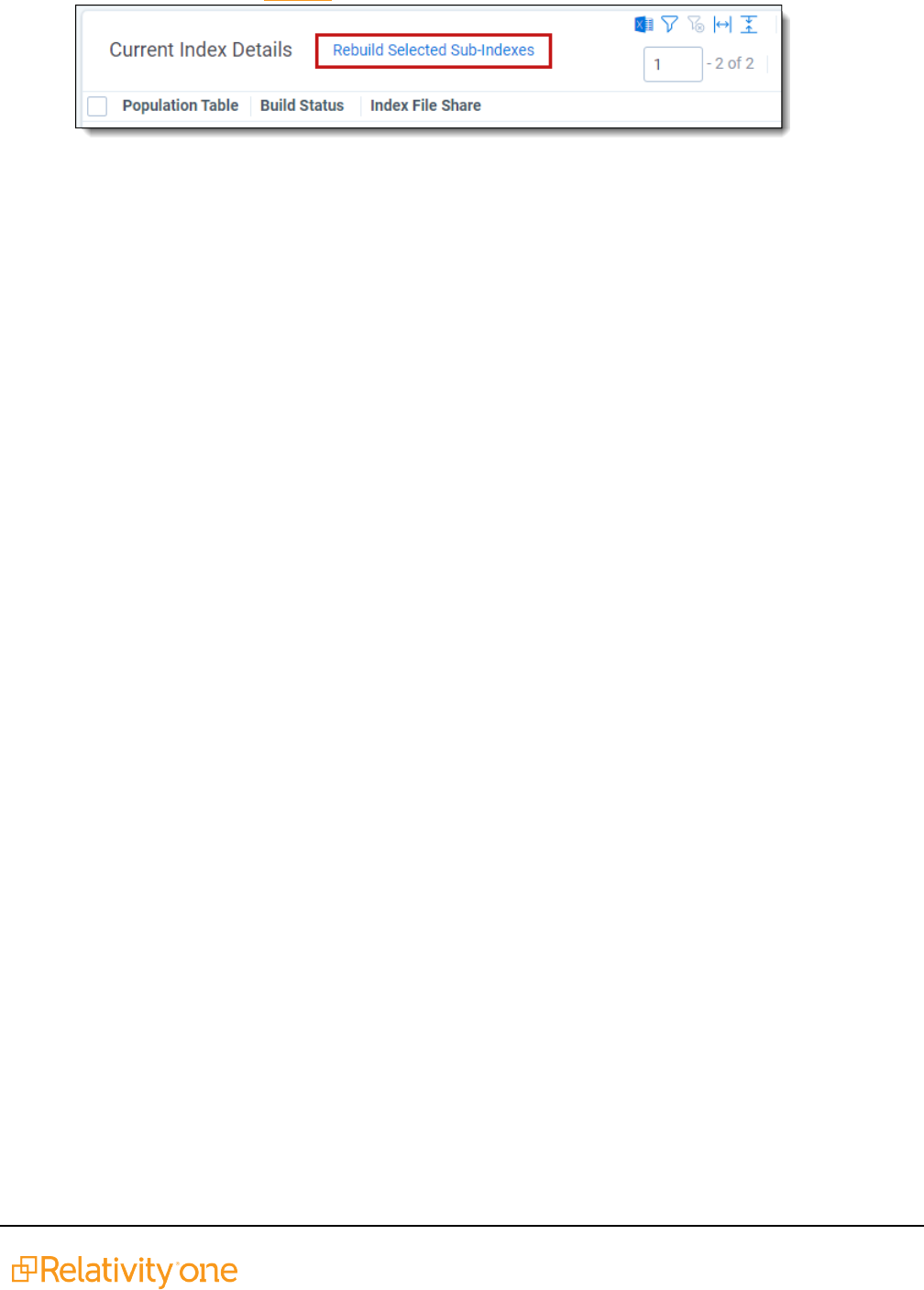
Searching Guide 73
unless directed by the Support team.
9.4.6 View Audit
Using the View Audit button, you can see when a user modified dtSearch index settings. The View Audit
layout has the following fields:
n
Action
n
Field
n
Old Value
n
New Value
n
User Name
n
Timestamp
n
Details
9.5 Temporary storage
If you specify a temporary storage location, dtSearch builds the index in this directory and then copies the
index over to the final index share when the build completes. Using a temporary storage location could
speed up the build time and reduce network contention
9.6 Running a dtSearch
Use dtSearch to complete stemming, fuzzy, and proximity searches on the information included in your
dtSearch index.
9.6.1 Running a dtSearch in the search panel
To run a dtSearch in the Search panel from the Documents list in Relativity:
1. Navigate to the search panel.
2. Click Add Condition.
3. Select (Index Search)from the Add Condition drop-down list.
The (Index Search) window opens.
4. Select the name of your dtSearch index from the Index drop-down list.
5. Enter terms for the search in the Search Terms box.
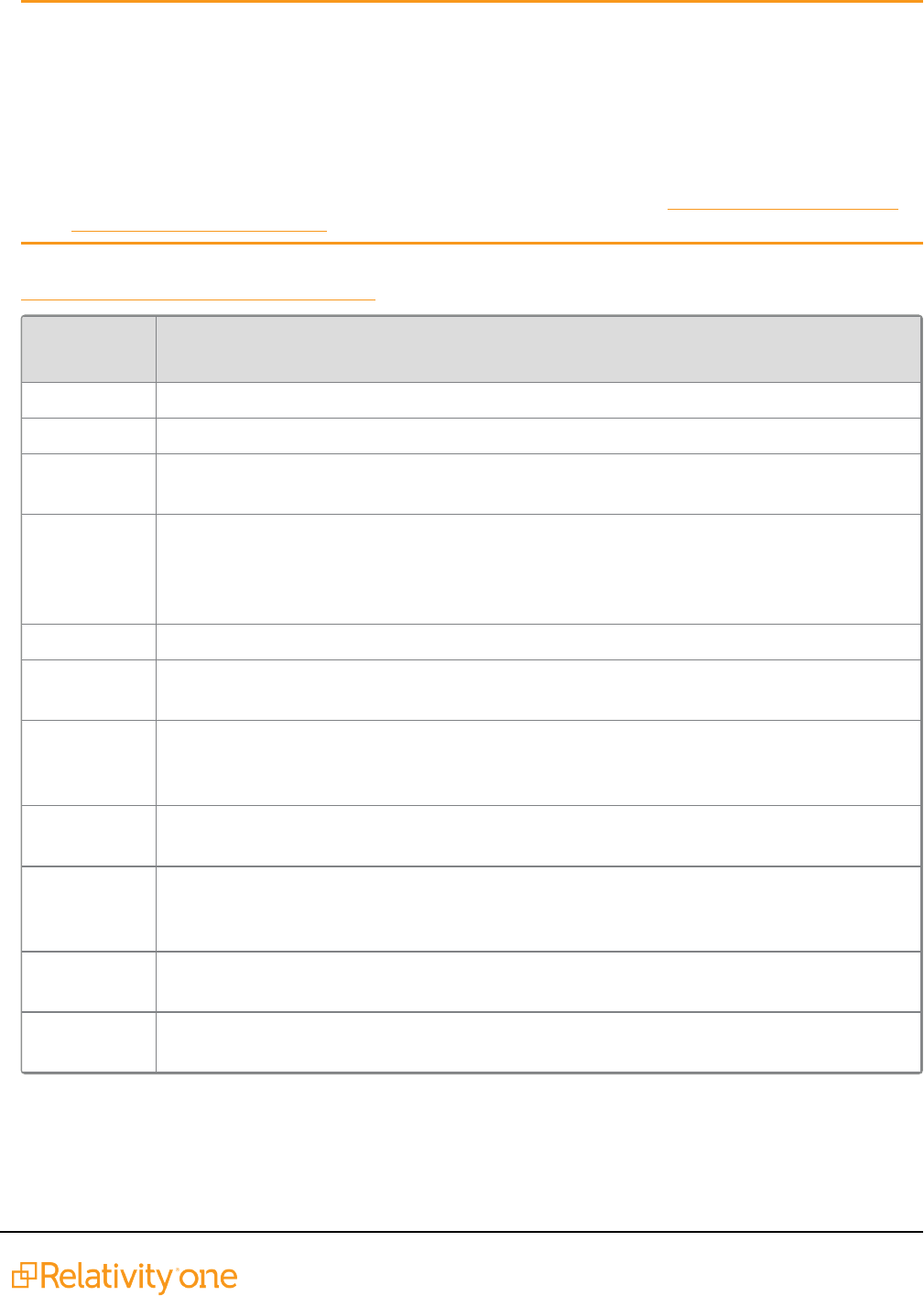
Searching Guide 74
Notes:
n
You can enter search terms on multiple lines (i.e., hit Enter), but the hard return will not be treated as
an AND / OR operator.
n
dtSearch indexes are case insensitive by default. All characters in a dtSearch index are normalized
to lowercase. For example, if your exact phrase search is an acronym like ACT, you must build a
case-sensitive dtSearch index.
n
Your total number of search terms cannot exceed 65,000 characters. Additionally, words longer than
32 characters are truncated during indexing. For more information, see Searching for words longer
than 32 characters on page77.
The following table shows search string examples and their expected results. For more information, see
Using dtSearch syntax options on page86.
Search
String
Returns Documents With...
apple pear The exact phrase apple pear
"apple pear" The exact phrase apple pear
apple AND
pear
The word apple and the word pear
(apple and
pear) AndAny
(grape or
banana)
Any document that contains apple and pear, with grape and banana also being counted
as hits. Grape and banana aren't evaluated as conditions; they're simply added to the
search results as optional terms to be highlighted if they appear in the document.
apple OR pear Either apple or pear
apple W/5
pear
Apple appears within 5 words of pear
apple PRE/5
pear
Apple appears within 5 words before pear
Note: Relativity does not use the POST operator. However, you can mimic this func-
tionality by reversing the order of the terms, and using the PRE operator.
apple NOT
W/5 pear
Appleoccurs not within 5 words of pear
apple
ANDNOT
pear
Apple appears but pear does not
apple W/5
xfirstword
Apple appears in the first 6 words of the document
apple w/5
xlastword
Apple appears in the last 6 words of the document
You can access stemming or fuzziness for key terms by checking the Enable Stemming box or selecting a
Fuzziness Level in the drop-down list.
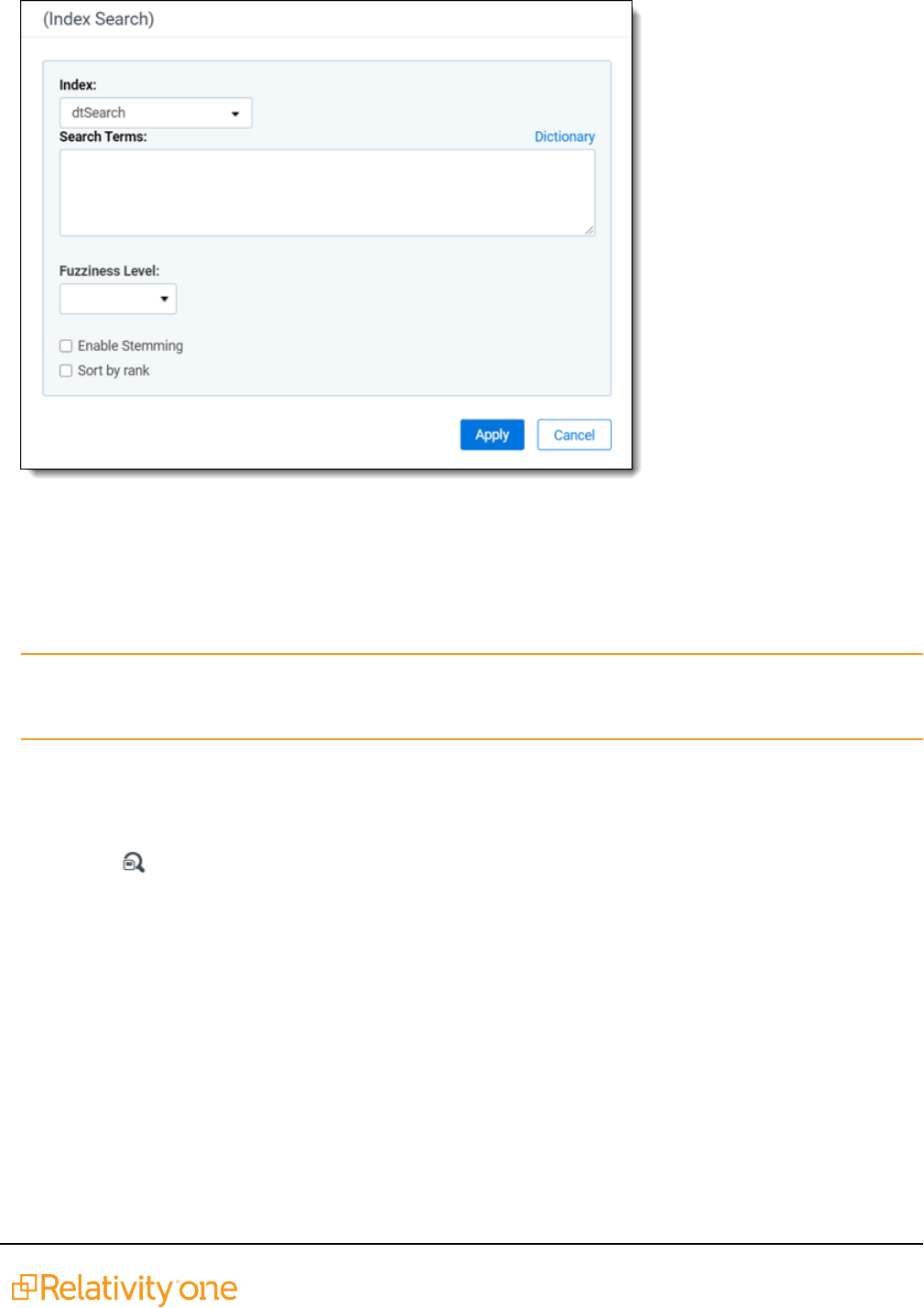
Searching Guide 75
6. (Optional) Add any additional search conditions.
7. Click Apply.
The search terms populate in the Search builder.
8. Click Run Search. To stop a long running search, click Cancel.
Note: Click the Sort by rank checkbox to sort the results by order of relevance in relation to the search
terms. The most relevant documents are listed at the top of the results set, with the least relevant
documents, or the documents with the smallest number of keywords, is at the end of the list.
9.6.2 Running a dtSearch in the Search Browser
To run a dtSearch in the Search browser:
1.
Click to access the Search browser from the Documents List.
2. Click New Search.
3. Enter required fields in the Information card.
4. Click Add Condition.
5. Select (Index Search)from the Add Condition drop-down list.
The (Index Search) window opens.
6. Select the name of your dtSearch index from the Index drop-down list.
7. Enter terms for the search in the Search Terms box.
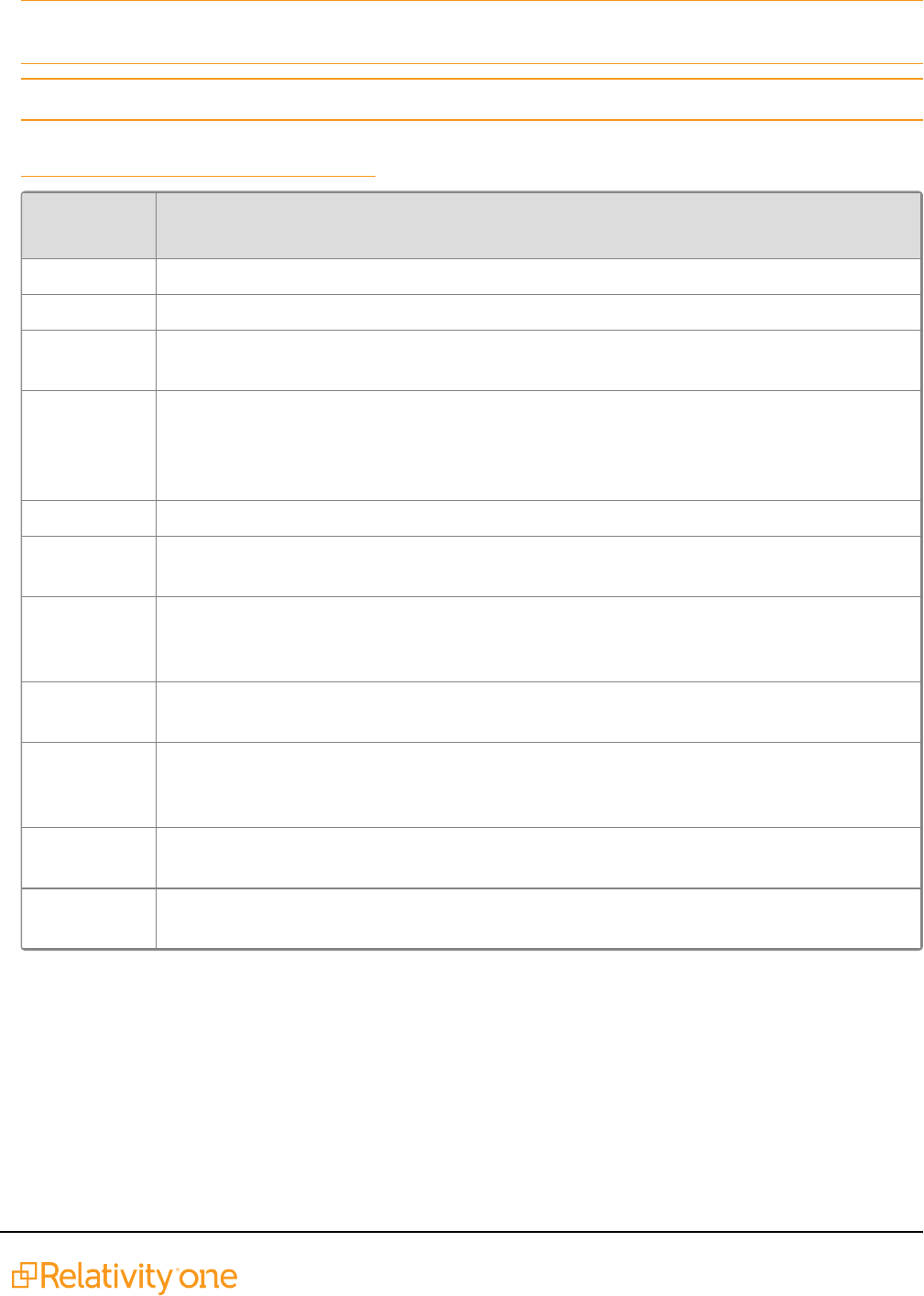
Searching Guide 76
Note: You can enter search terms on multiple lines (i.e., hit Enter), but the hard return will not be treated
as an AND / OR operator.
Note: Your total number of search terms cannot exceed 65,000 characters.
The following table shows search string examples and their expected results. For more information, see
Using dtSearch syntax options on page86.
Search
String
Returns Documents With...
apple pear The exact phrase apple pear
"apple pear" The exact phrase apple pear
apple AND
pear
The word apple and the word pear
(apple and
pear) AndAny
(grape or
banana)
Any document that contains apple and pear, with grape and banana also being counted
as hits. Grape and banana aren't evaluated as conditions; they're simply added to the
search results as optional terms to be highlighted if they appear in the document.
apple OR pear Either apple or pear
apple W/5
pear
Apple appears within 5 words of pear
apple PRE/5
pear
Apple appears within 5 words before pear
Note: Relativity does not use the POST operator. However, you can mimic this func-
tionality by reversing the order of the terms, and using the PRE operator.
apple NOT
W/5 pear
Apple does not appear within 5 words of pear
apple
ANDNOT
pear
Apple appears but pear does not
apple W/5
xfirstword
Apple appears in the first 6 words of the document
apple w/5
xlastword
Apple appears in the last 6 words of the document
You can access stemming or fuzziness for key terms by checking the Enable Stemming box or selecting a
Fuzziness Level in the drop-down list.
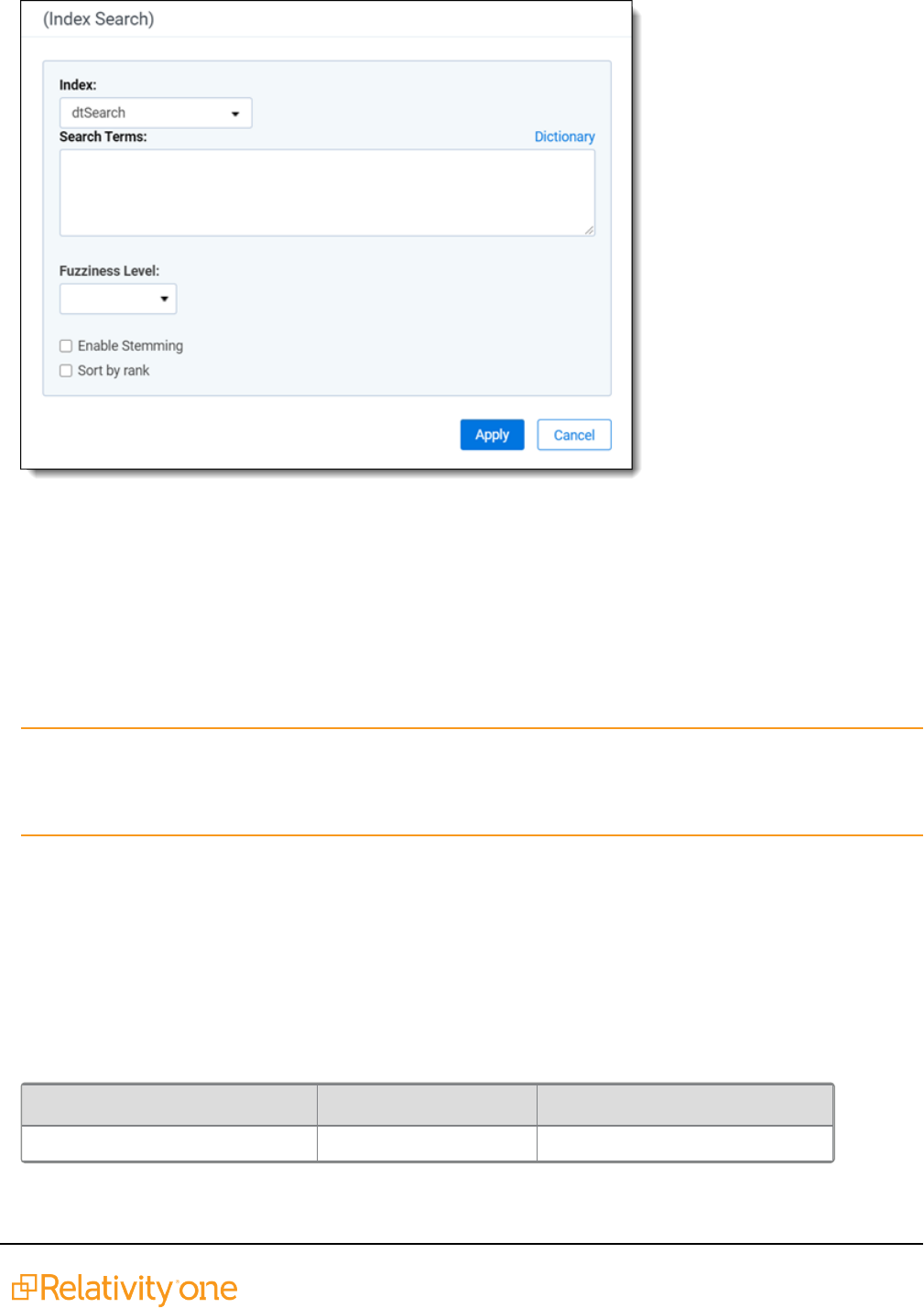
Searching Guide 77
8. (Optional) Add any additional search conditions.
9. Click Apply.
The search terms populate in the Search builder.
10. Click Save or Save As.
11. Select the name of the dtSearch in the Search Browser.
12. Click Run Search. To stop a long running search, click Cancel.
Note: Tap on the Sort by Rank check box beneath the search box to sort the results in order of the most
relevance to your search terms. The most relevant documents are listed at the top of the results set, with
the least relevant documents, or the documents with the smallest number of keywords, is at the end of the
list.
9.6.3 Searching for words longer than 32 characters
When a word has more than 32 characters (none of which are whitespace, characters in the CJKRanges
section, or symbols configured as spaces), dtSearch truncates the word and only indexes the first 32
characters. As a result, if you run a search on the first 32 characters, the search returns any words with 33 or
more characters that contain the search term as the first 32 characters.
If you attempt to run a search with a string of 33 characters or more, dtSearch does not return any results
because it does not truncate the query, and as we’ve seen, no word is longer than 32 characters. See below
examples for reference.
Search Length (in characters) Returned results
supercalifragilisticexpialido 29 supercalifragilisticexpialido

Searching Guide 78
Search Length (in characters) Returned results
supercalifragilisticexpialidoc 30 supercalifragilisticexpialidoc
supercalifragilisticexpialidoci 31 supercalifragilisticexpialidoci
supercalifragilisticexpialidocio 32
supercalifragilisticexpialidocio
supercalifragilisticexpialidociou
supercalifragilisticexpialidocious
supercalifragilisticexpialidociou 33 NO RESULTS
supercalifragilisticexpialidocious 34 NO RESULTS
Notes:
n
if you include a wildcard (*) after the 32nd character, you will get the exact same results as if you omit-
ted the wildcard.
n
You can use the following regular expression to search your dictionary for all 32-character words: ##.
{32}
9.7 Running a dictionary search
When you run a dtSearch, you can use Dictionary Search to query the index for a term and find the total
occurrences and number of documents in which it occurs. The Dictionary Search dialog displays the results,
including the following columns:
n
Keyword - the word contained in the index. If you use fuzziness or stemming in your search, this
column displays any variations of the term.
n
Total Words - the number of times the word appears in the dtSearch index.
n
Total Documents - the number of documents in the index that contain the word.
A dictionary search returns only the first 2,000 items in the result set. If your search returns more than that, a
message displays to indicate that only 2,000 items were returned.
9.7.1 Running a dictionary search in the search panel
To run a dictionary search in the search panel:
1. Navigate to the search panel.
2. Click Add Condition.
3. Select (Index Search)from the Add Condition dropdown.
The (Index Search) pop-up opens.
4. Select the name of your dtSearch index from the Index dropdown.
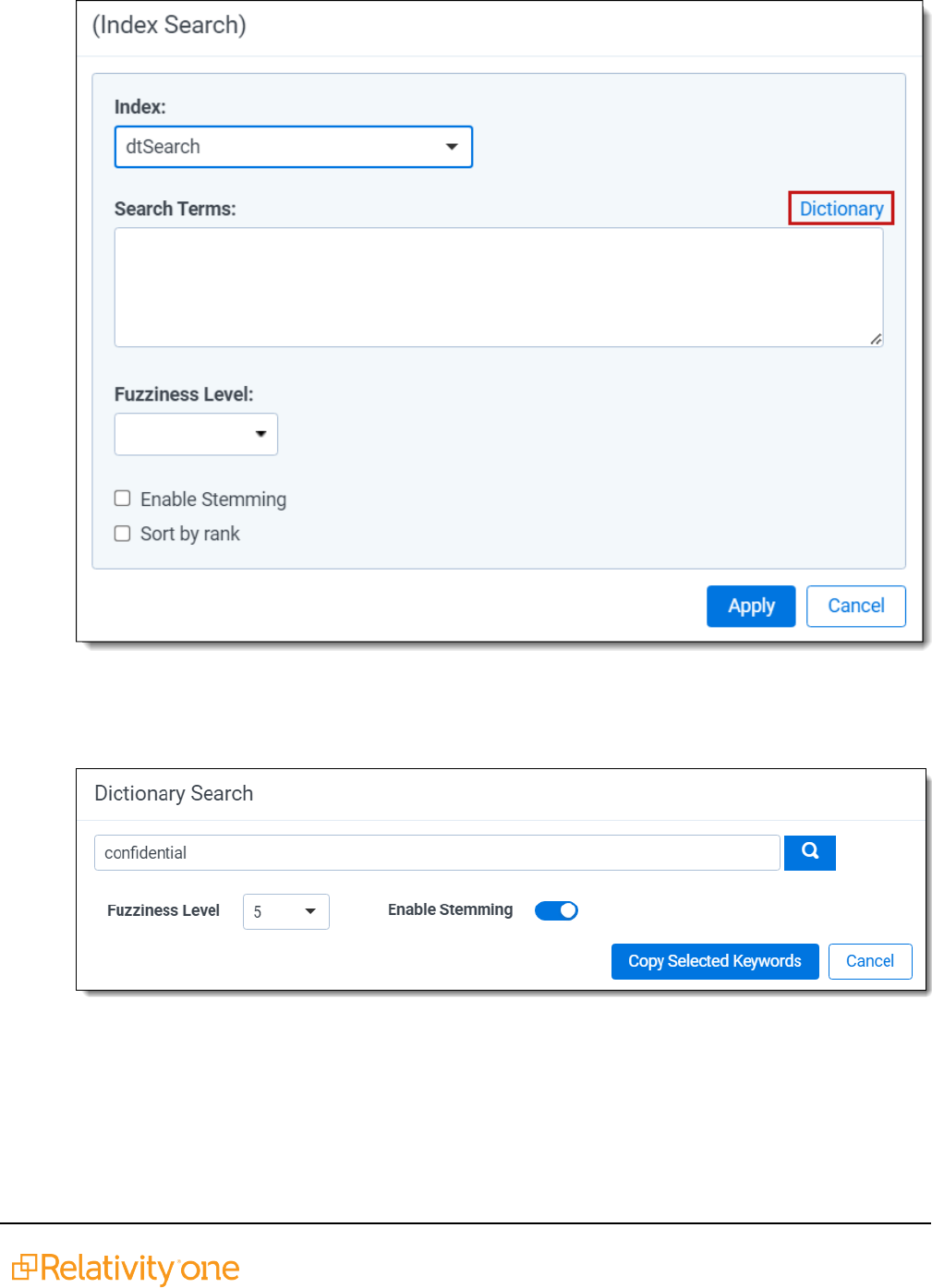
Searching Guide 79
5. Click Dictionary.
The Dictionary Search modal opens.
6. Enter a search term in the textbox. You can enter variations of a search term as well as the wildcard
(*), stemming (~), or fuzzy searching (%) operators.
9.7.2 Running a dictionary search in the search browser
To run a dictionary search in the Search browser:
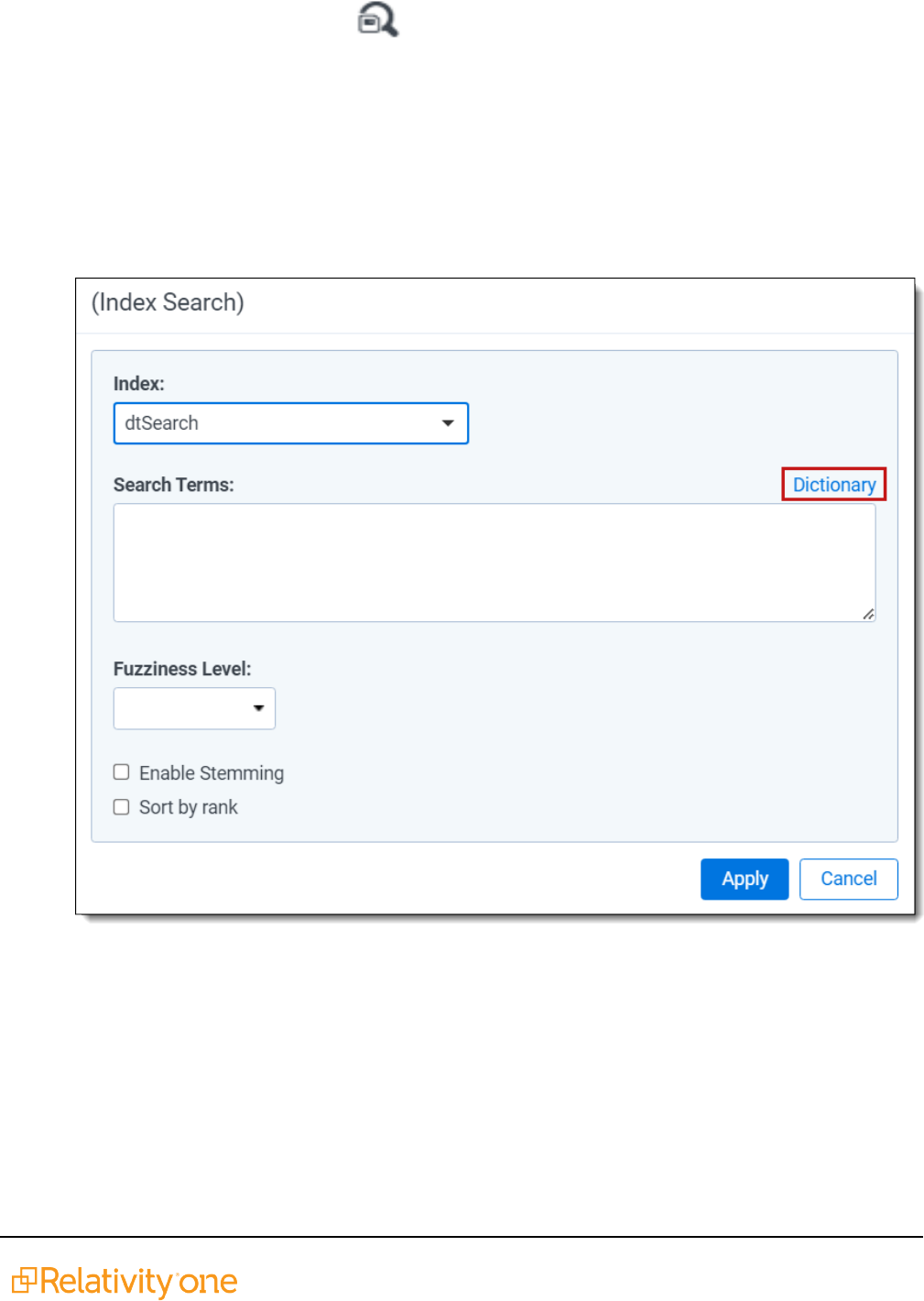
Searching Guide 80
1.
Click the Saved Searches icon ( ) to access the Search browser from the Document list.
2. Click Create New Search.
3. Enter required fields.
4. Click Add Condition.
5. Select (Index Search)from the Add Condition dropdown. The (Index Search) pop-up opens.
6. Select the name of your dtSearch index from the Index dropdown.
7. Click Dictionary.
The Dictionary Search modal opens.
8. Enter a search term in the textbox. You can enter variations of a search term as well as the wildcard
(*), stemming (~), or fuzzy searching (%) operators.
9. Click Search to display a list of keywords and the associated totals.
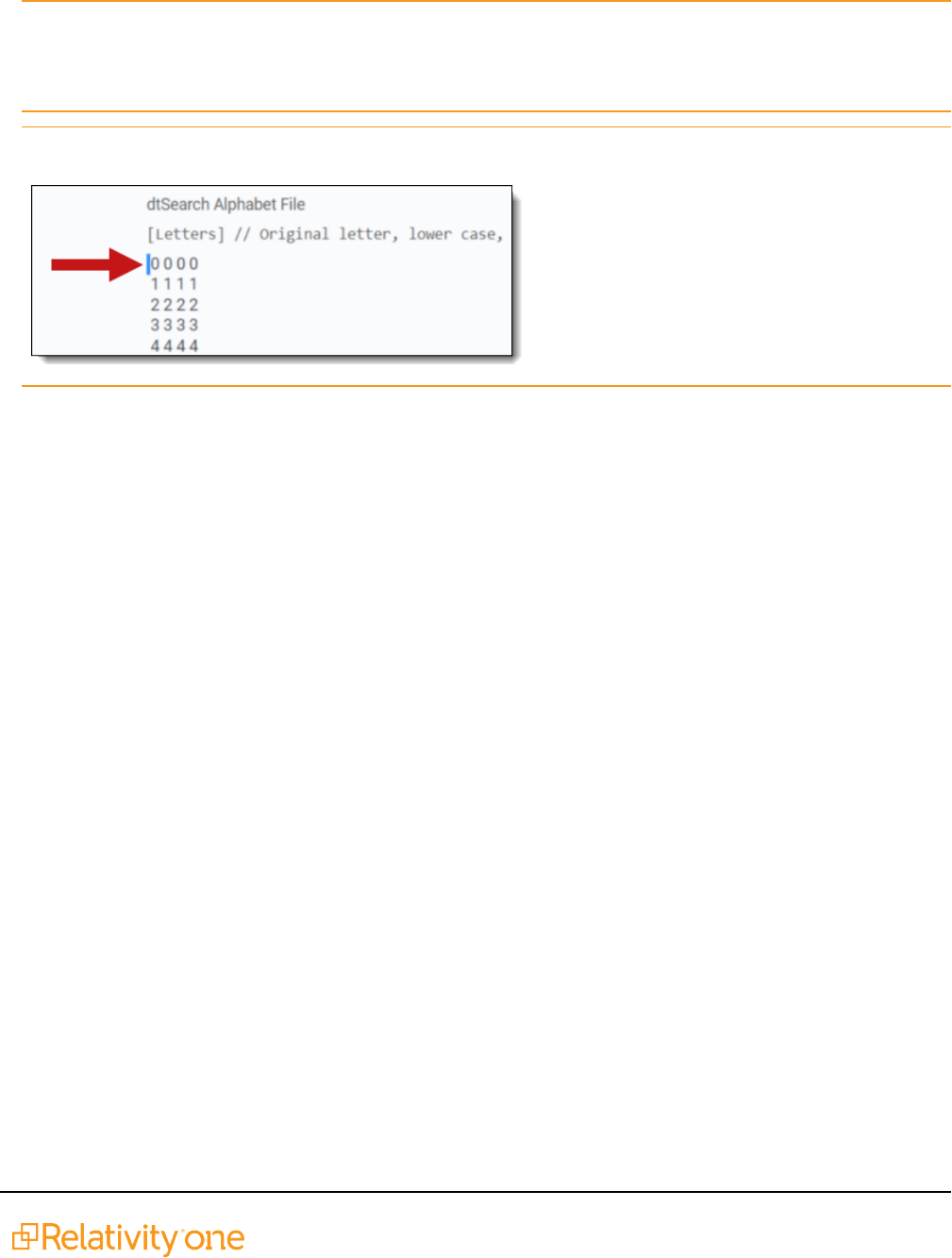
Searching Guide 81
9.8 dtSearch default alphabet file text
Note: Some of the characters in the alphabet file are not printable; screenshots were used instead of the
actual text. You cannot copy or paste the Spaces or Ignore characters since they are not printable.
Instead, use the dtSearchDefaultAlphabetFile instance setting in the Instance Setting system guide to
update the dtSearch default alphabet file.
Note: Each sequence must start with a leading, or empty, space. Not having the leading space may
produce errors.
Alphabet file validation
When you save a dtSearch index, Relativity runs a validation check on the alphabet list. You will see a
warning message if Relativity detects invalid spacing or syntax. You cannot save the index if there are
errors with the alphabet list. The validation check includes:
n
Header sections:
o
Header section appears first in Alphabet
o
Exact header section without any added whitespace
o
Required newline before section
n
Letters:
o
Exact title, allowing any whitespace and comments preceding double slash //
o
Each letter on own line with preceding space
o
Each letter variant separate by single space
o
Allow any extra whitespace after letter
n
Hyphens, Spaces, and Ignore
o
Exact title, allowing any whitespace
o
Single line of characters with preceding space
o
Optional newlines before next section
n
Footer sections:
o
Exact title
o
Skip validating any text following title

Searching Guide 82
n
General:
o
Purple, Pink, Red, Green sections are each optional and can be in any order
9.8.1 dtSearch Alphabet File
[Letters] // Original letter, lower case, upper case, unaccented
0 0 0 0
1 1 1 1
2 2 2 2
3 3 3 3
4 4 4 4
5 5 5 5
6 6 6 6
7 7 7 7
8 8 8 8
9 9 9 9
A a A A
B b B B
C c C C
D d D D
E e E E
F f F F
G g G G
H h H H
I i I I
J j J J
K k K K
L l L L
M m M M
N n N N
O o O O
P p P P
Q q Q Q
R r R R
S s S S
T t T T
U u U U
V v V V
W w W W
X x X X
Y y Y Y
Z z Z Z
_ _ _ _
a a A a
b b B b
c c C c
d d D d
e e E e
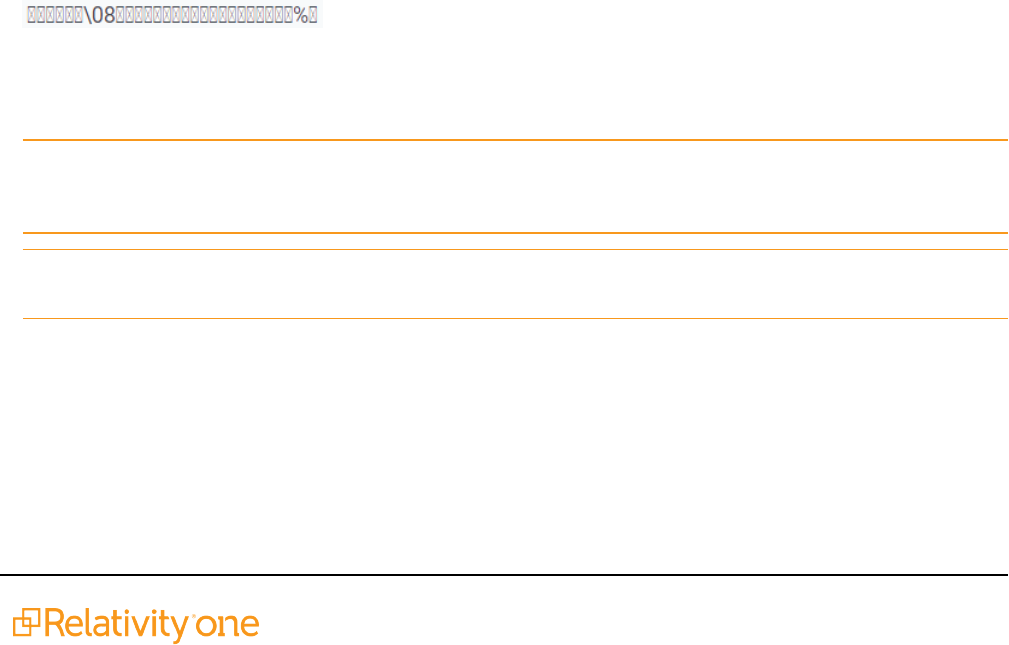
Searching Guide 83
f f F f
g g G g
h h H h
i i I i
j j J j
k k K k
l l L l
m m M m
n n N n
o o O o
p p P p
q q Q q
r r R r
s s S s
t t T t
u u U u
v v V v
w w W w
x x X x
y y Y y
z z Z z
[Hyphens]
-
[Spaces]
\09\0a\0c\0d !@"#$&'()*+,./:;<=>?[\5c]^`{|}~
[Ignore]
[End]
CJKRanges = 0e00-0e4e 3040-30ff 4e00-9fff
Note: Previous guidance hid some characters that should not have been hidden. Those non-printable
characters are critical to index function and should never be removed. The "\08" text represents the
"backspace" text, and should also never be removed or split up (IE trying to index the backslash).
Note: This section only accepts ASCII characters (code points between 33 and 127) as input, we
currently do not support ignoring extended Unicode values.
9.9 Making the dtSearch noise word and alphabet list searchable
Relativity ignores words that do not act as meaningful criteria when you create dtSearch and keyword
queries. Ignored words are known as noise or noise words. Search indexes automatically include the
default list of noise words. However, you can edit this list in the dtSearch list to suit your needs. This article
includes an overview of noise words and steps to create custom lists.
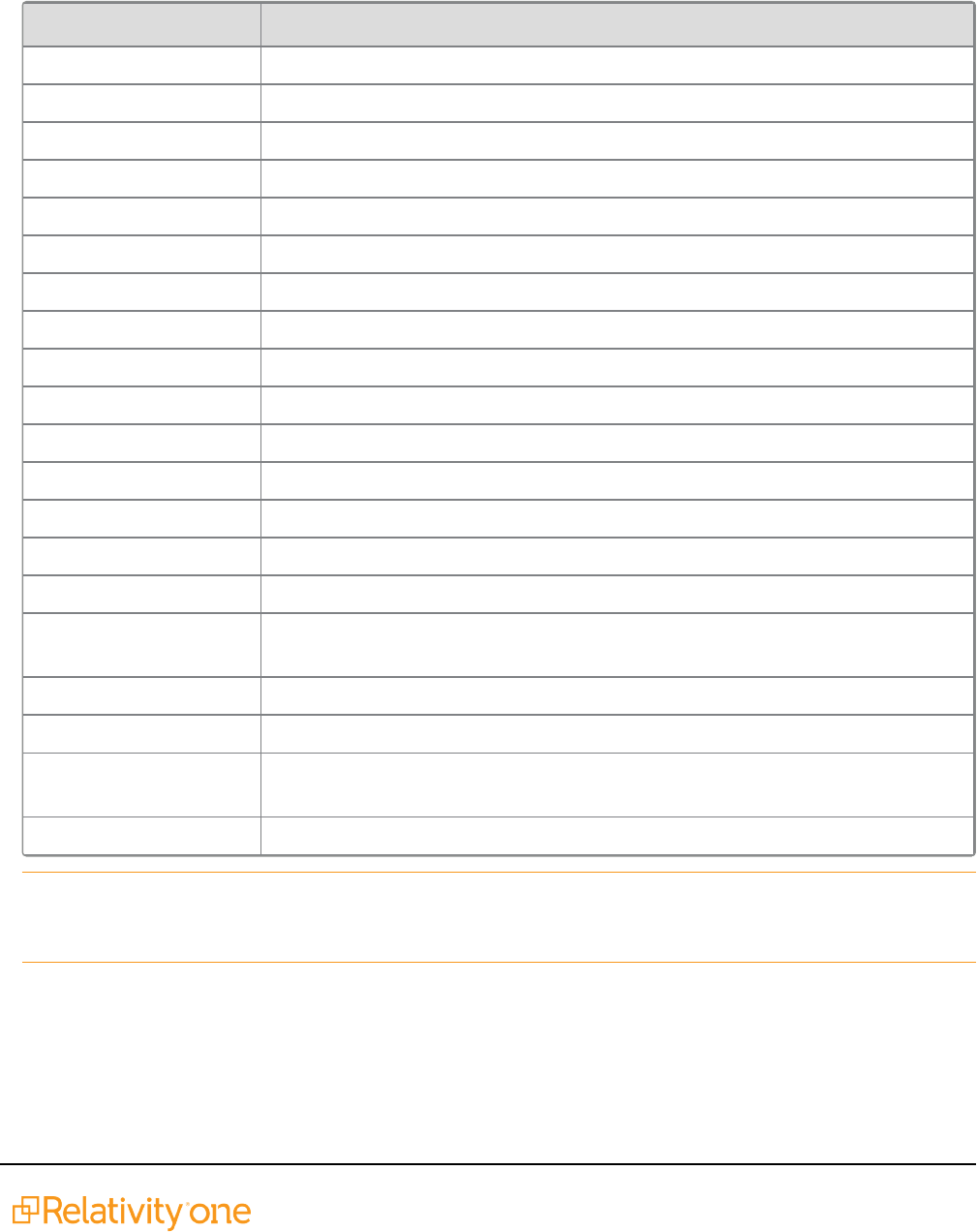
Searching Guide 84
9.9.1 Default noise word list
Relativity references the default list of noise words each time you create a new index. System admins
cannot edit noise words in keyword searches. The default noise word list consists of punctuation marks,
single letters and numbers, and the following words:
Begins with Noise words
A a, about, after, all, also, an, and, another, any, are, as, at
B be, because, been, before, being, between, both, but, by
C came, can, come, could
D did, do
E each, even
F for, from, further, furthermore
G get, got
H had, has, have, he, her, here, hi, him, himself, his, how, however
I i, if, in, indeed, into, is, it, its
J just
L like
M made, many, me, might, more, moreover, most, much, must, my
N never, not, now
O of, on, only, or, other, our, out, over
S said, same, see, she, should, since, some, still, such
T take, than, that, the, their, them, then, there, therefore, these, they, this, those,
through, thus, to, too
U under, up
V very
W was, way, we, well, were, what, when, where, which, while, who, will, with,
would
Y you, your
Note: Relativity ignores noise words. However, Relativity does not ignore their position in the search
phrase set. So, if you execute the query apple w/6 pear, the search returns the phrase apple tree is far
from the pear even though it contains the noise words is, from and the.
9.9.2 dtSearches and noise words
The default list of noise words is the same in a dtSearch as in a keyword search. The primary difference is
that you can customize the dtSearch index list. For example, if the word never is important to your litigation,
remove it from the noise words list, so that your search results always return that word.
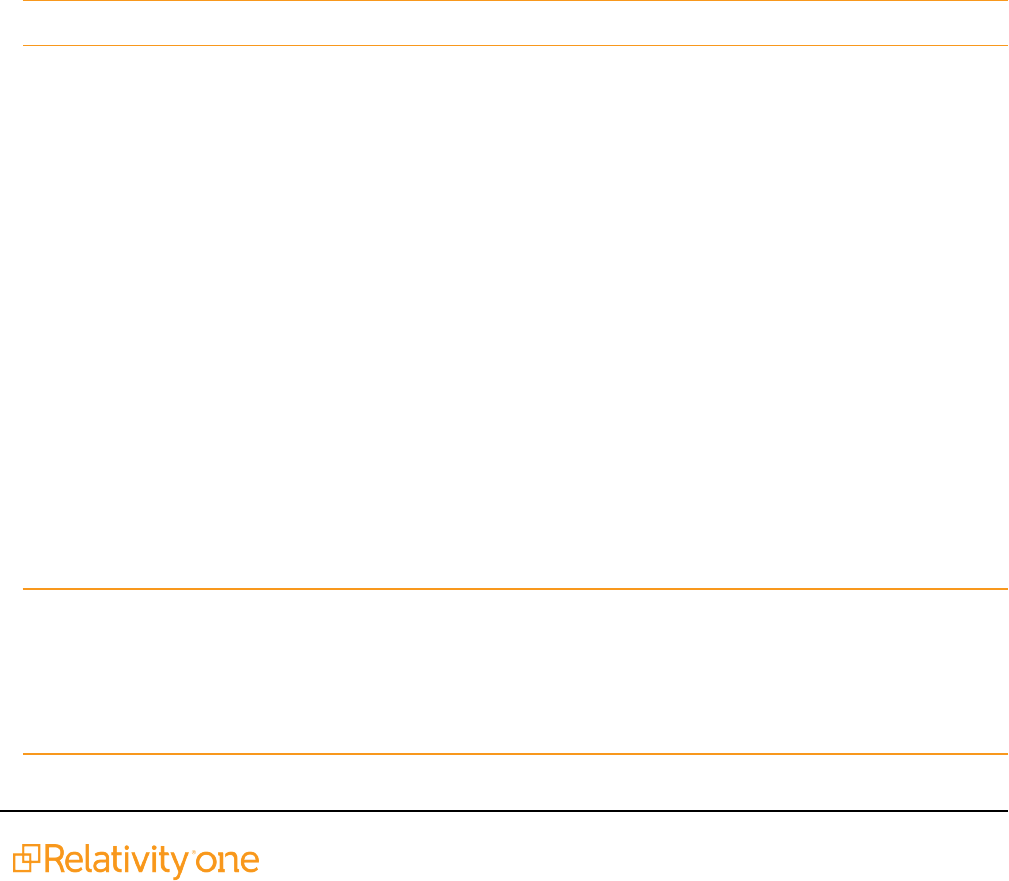
Searching Guide 85
To create a custom noise word list, perform the following:
1. Create a new dtSearch index, and then name it dtSearch - updated noise words.
2. Select your extracted text search for the Searchable set.
3. Delete the word never from the Noise Words list.
4. Save the list, and then perform a full build on your new index.
9.9.3 Noise words in languages other than English
You can set up noise words to search documents in other languages. If the workspace primarily contains of
documents in a different language, see for an overview of suggested noise words for use in nineteen
additional languages.
9.9.4 dtSearch alphabet file
The following descriptions are for characters in the ASCII 33-127 range.
9.9.4.1 Letters
dtSearch defines letters as characters to index. This includes all alphabetical characters (a-z and A-Z) and
all digits (0-9).
Note: dtSearch is case insensitive.
9.9.4.2 Hyphens
dtSearch defines hyphens as characters that receive special processing in dtSearch. By default, dtSearch
only classifies the - character as a hyphen.
9.9.4.3 Spaces
dtSearch defines a space character as a character that causes a word break. By default, dtSearch treats the
following characters as spaces:
\09\0a\0c\0d !@"#$&'()*+,./:;<=>?[\5c]^`{|}~
Values listed as \## are Unicode code points. Their definitions are:
n
\09 - horizontal tab
n
\0a - line feed
n
\0c - form feed
n
\0d - carriage return
n
\5c - backslash (\)
For more information, see . You must log into the Relativity Community to access the topic.
Note: You must have valid Relativity Community credentials in order to download any Community file
linked to the documentation site. You will need to enter those credentials on the Community login screen
if you are not already logged in. If you are already logged in to the Community at the time you click a link,
the file is automatically downloaded in the bottom left corner of your screen. If you get an error message
stating URL No Longer Exists after clicking a Community link, you should contact your IT department. It
may be due to a single sign-on error related to the SAML Assertion Validator
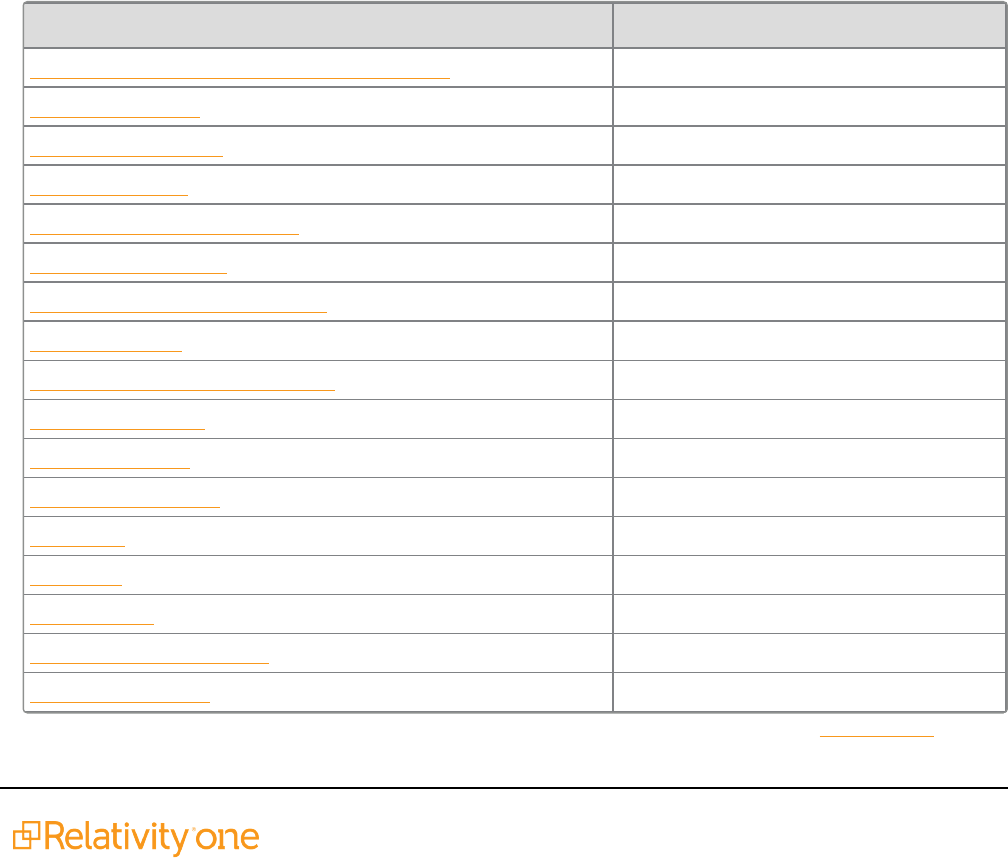
Searching Guide 86
9.9.4.4 Ignore
dtSearch defines an ignored character as a character that's ignored when processing text. By default,
dtSearch ignores the following characters:
\08%
Values listed as \## are Unicode code points. Their definitions are:
\08 - backspace character
9.9.4.5 End
dtSearch has defined ranges for CJK characters and these will make each Thai, Chinese, and Japanese
character a separate word. See for more detail.
9.9.4.6 Searching for a symbol or character
To search for a symbol or character in Relativity, see .
9.10 Using dtSearch syntax options
dtSearch includes special characters and other operators used to define search criteria. The following table
lists the syntax options available for queries that run against a dtSearch index. Click the search functionality
name for more details on the syntax use.
Search functionality Special characters or operators
Auto-recognition of dates, emails, credit cards date(), mail(), creditcard()
Boolean operators AND, OR, NOT
Built-in search words xfirstword, xlastword
Connector words and, or, not, to, contains
Exact phrase - double quotes " "
Operator precedence ()
Exact phrase - no double quotes
Fuzzy searching %
Noise words and the alphabet file Noise Words, Alphabet
Numerical patterns =
Phonic searching #
Regular expressions (Redirects to another topic.) "##"
Stemming ~
Wildcards ?, *
W/N operator W/N
Proximity with terms order PRE
Words and phrases
For the list of the special characters recognized as spaces that cause word breaks, see Alphabet file.
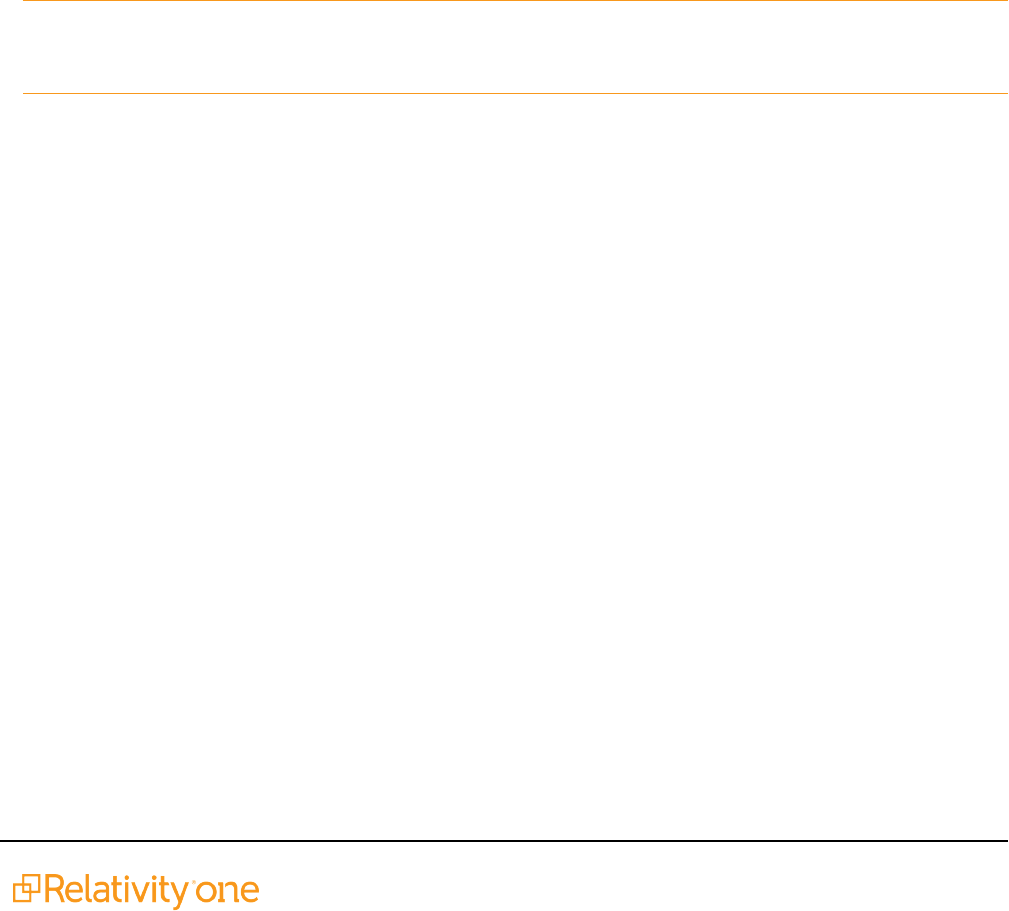
Searching Guide 87
9.10.1 Auto-recognition
Auto-recognition provides you with the ability to search for various date formats, email addresses, and credit
card numbers. However, it can dramatically affect indexing and searching performance. You must activate
auto-recognition before you can use it in your workspace. Contact your system administrator for more
information.
9.10.1.1 Date recognition
Date recognition searches for strings that appear to be dates. It uses English-language months, including
common abbreviations, and numerical formats. For example, dtSearch recognized the following date
formats:
n
January 15, 2006
n
2006/01/15
n
1/15/06
n
1-15-06
n
The fifteenth of January, two thousand six
Note: The short month format, Jan, Feb, and so forth, can be problematic, and is occasionally rejected by
Relativity. The recommendation is to stick with the full name of the month to avoid any errors. For
example January, February, and so forth.
Note the following date and date range search strings:
n
To search for a date, enter a date expression between the parentheses in the string date(); for
example, date(january 10 2006).
n
To search for range of dates, enter a date range between the parentheses in the string date(); for
example, date(january 10 2006 to january 20 2006).
n
To search for a range of dates near the word apple, enter date(january 10 2006 to january 20 2006)
w/10 apple.
n
dtSearch does not support unterminated date ranges. To search for any date after or before a par-
ticular date, enter a bounded range with a maximal or minimal value for the bounds. The maximum
value for a year is 2900, and the minimum value is 1000. For example, date(january 10 2006 to janu-
ary 1 2900).
dtSearch recognizes numeric strings as dates, as long as it interpretes as a valid date. This includes formats
common in the US and UK, including:
n
MM/DD/YY or MM-DD-YY
n
MM/DD/YYYY or MM-DD-YYYY
n
DD/MM/YY or DD-MM-YY
n
DD/MM/YYYY or DD-MM-YYYY
In the case of ambiguous dates, such as 01/05/10, dtSearch defaults to MM/DD/YY. If the date contains
words dtSearch converts the words to a numeric value to help interpret the date. For example, 30 must be a
day and not a month, and 2015 must be a year, not a day or month.

Searching Guide 88
9.10.1.2 Email address recognition
Email address recognition searches for text with the syntax of a valid email address, such as
alphabet settings for "@", ".", or other punctuation in the email address.
You can also use the word listing functions in dtSearch to enumerate all email addresses in a document
collection. You must include either the * or ? wildcard expression to enumerate all email addresses in a
document collection.
n
n
9.10.1.3 Credit card number recognition
Credit card number recognition searches for any sequence of numbers that matches the syntax for a valid
credit card number issued by a major company, such as Visa and MasterCard. dtSearch recognizes a credit
card number regardless of the pattern of spaces or punctuation embedded in the number:
n
1234-5678-1234-5678
n
1234567812345678
n
1234 5678 1234 5678
Credit card issuers use numerical tests to exclude sequences of numbers that are not valid credit card
numbers. Since these tests do not detect all invalid numbers, the feature for credit card number recognition
may find additional invalid numbers.
To search for a credit card number, enter a credit card number between the parentheses in creditcard() as
exemplified in creditcard(1234*).
9.10.2 Boolean operators
The dtSearch engine supports Boolean operators, including AND, OR, and NOT. You can use these
operators to connect multiple phrases or terms in a single search expression.
Note: When using Boolean operators in a proximity search, dtSearch includes noise words. Although not
searchable, a proximity searches still counts noise words.
9.10.2.1 AND operator
Note: For details on parsing proximity and Boolean strings in search conditions, see dtSearch - How are
Proximity and Boolean (AND/OR) parsed in search conditions? knowledge base article on the Relativity
Community site.
When you use the AND operator to connect expressions, only documents that contain all the expressions in
the search string return in the result set. The following search strings illustrate how to use this operator:
n
apple pie AND poached pear retrieves any documents that contain both phrases.
n
(apple or banana) AND (pear w/5 grape) retrieves any documents that contain apple or banana AND
contain pear within five words of grape.
The following graphic depicts what documents return when you use the AND operator in a dtSearch string:
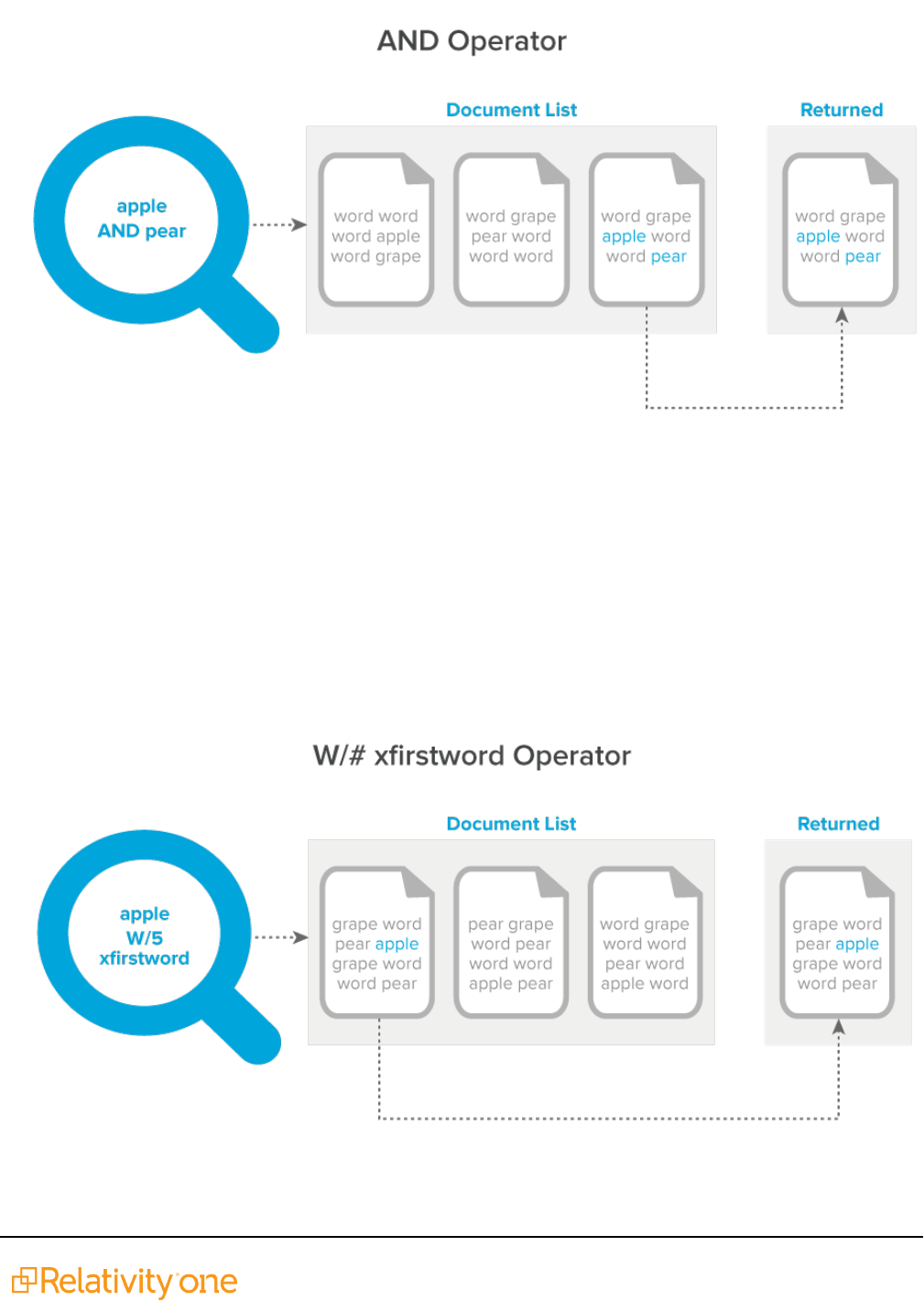
Searching Guide 89
9.10.3 Built-in search words
dtSearch includes the following built-in search words:
You can use these terms to limit a search to the beginning or end of a file. For example, apple W/10
xlastword searches for apple within 11 words of the end of a document.
n
xfirstword—marks the beginning of a file.
The following graphic depicts what documents return when you use the W/# xfirstword operator in a
dtSearch string:
n
xlastword—marks the end of a file.
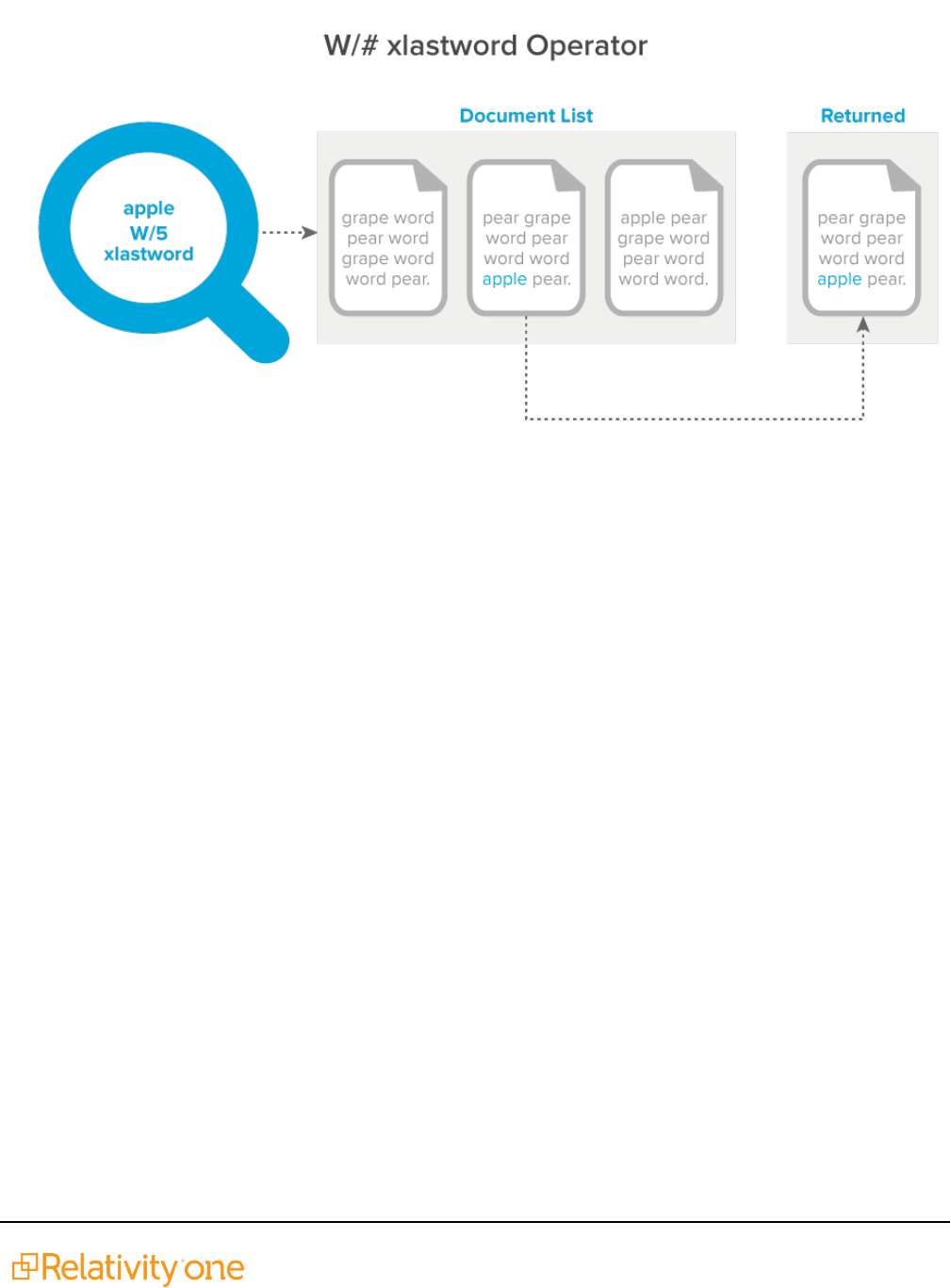
Searching Guide 90
The following graphic depicts what documents return when you use the W/# xlastword operator in a
dtSearch string:
9.10.4 Connector words
The dtSearch connector words include:
n
and
n
or
n
not
n
to
n
contains
To search for a phrase that contains one of the dtSearch connector words, quote a connector word or the
phrase it is in, or put a tilde after the connector. The following search strings work in returning phrases that
contain connector words:
n
"clear and convincing evidence"
n
not~ relevant
n
"whether or not John wants to"
Note the following:
n
Adding a ~ after a connector word prevents dtSearch from recognizing the word as a connector but
does not otherwise affect the search. The ~ character after a word tells dtSearch to apply the stem-
ming rules to it. Because the stemming rules included with dtSearch do not modify short words, the ~
does not change the outcome of a search for and, or, not, or to.
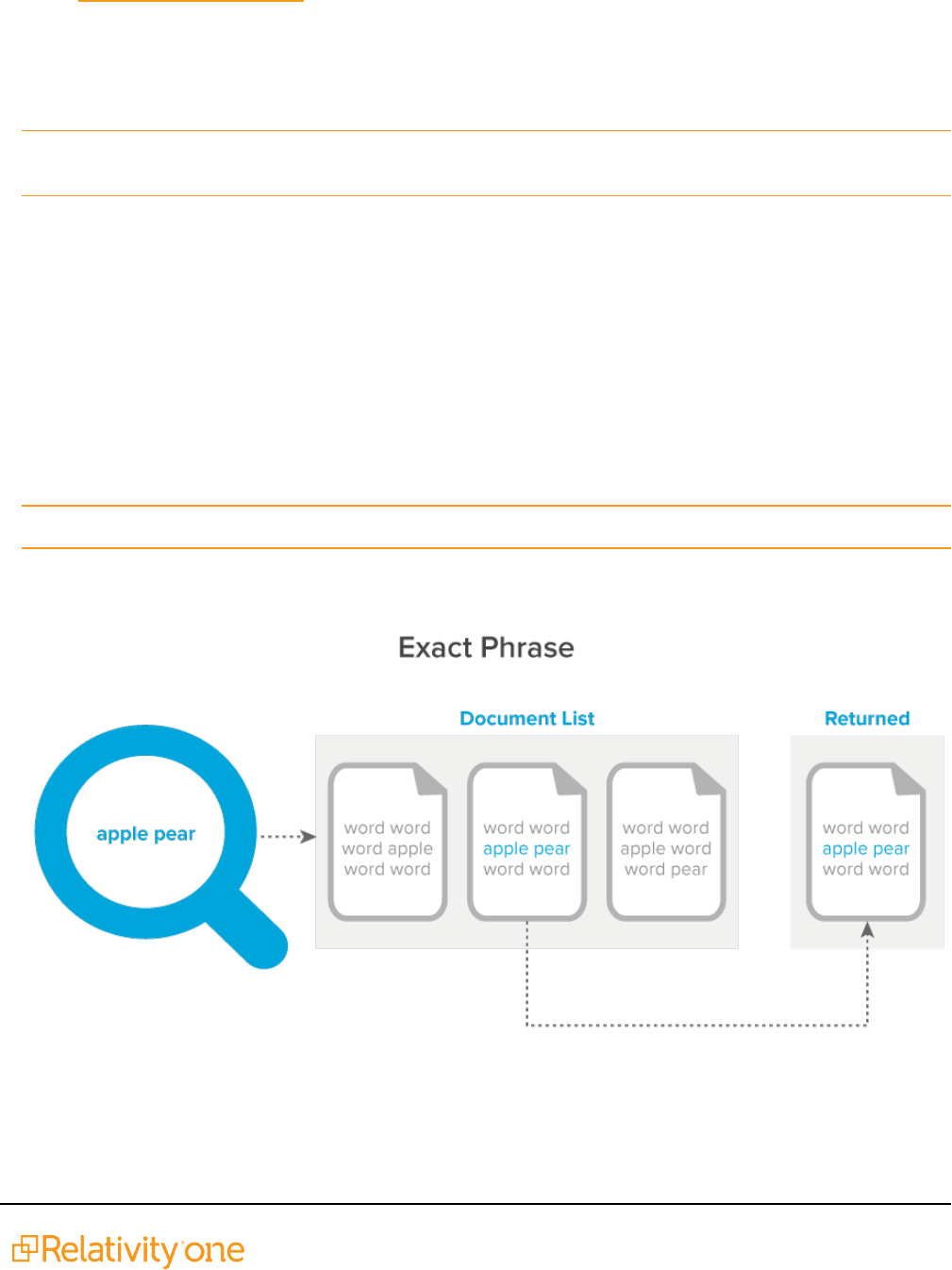
Searching Guide 91
n
The noise word list includes connector words such as and and not by default. All these words are
noise words and you must remove these words from the list to make dtSearch index these files. See
Creating a dtSearch index for details.
9.10.5 Exact phrase - double quotes
You must use double quotes when searching for exact phrases that contain dtSearch operator reserved
words, such as the Boolean connectors AND, OR. For example:
Note: Connector words such as and and not are in the noise word list by default. All these words are
noise words and you must remove these words from the list to make dtSearch index these files
Search string: clear and present danger
n
Returns documents that contain both the word clear and the phrase present danger.
n
If you need to return documents that contain the exact phrase clear and present danger, you must:
n
Remove the word and from the dtSearch noise words list.
n
Surround the search string with "double quotes" so that the word AND is not treated as a
Boolean connector.
Search string: "clear and present danger"
n
Returns the exact phrase clear and present danger.
Note: Do not confuse the parentheses function for order of preference with the double quotes function.
The following graphic depicts what documents return when you execute an exact phrase search:
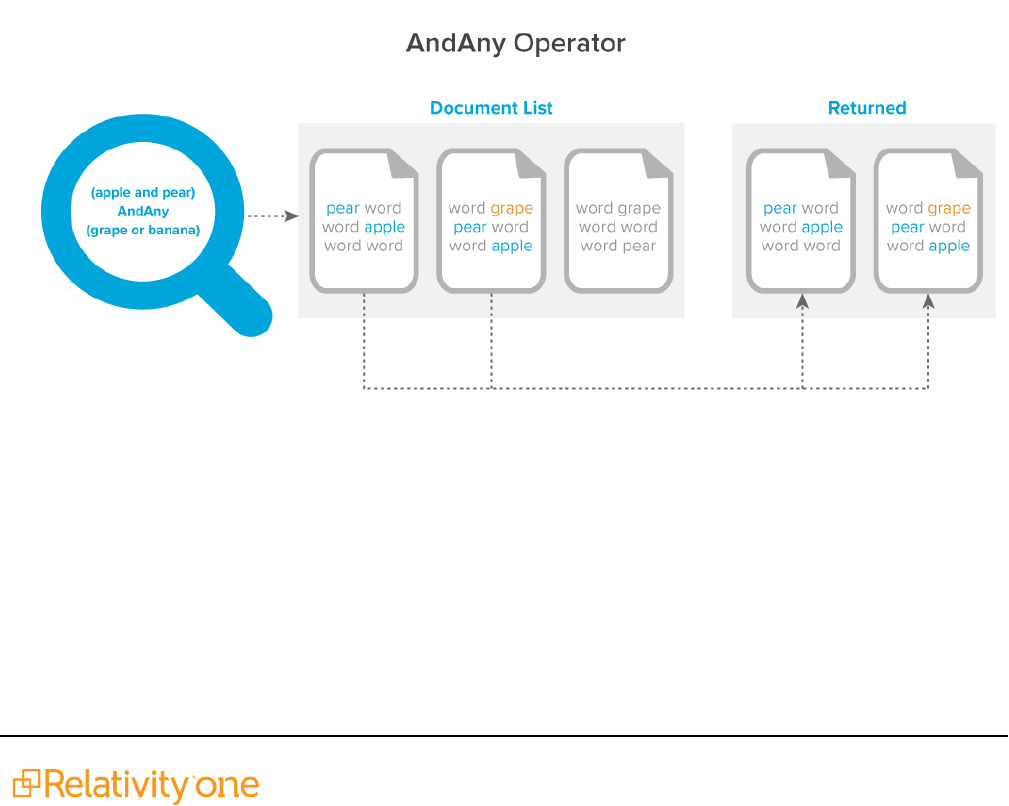
Searching Guide 92
9.10.5.1 AndAny operator
You can combine a search for required search terms with other optional terms. The words before the
AndAny connector constitute required search terms, and the words after the AndAny connector are
optional. A document only returns if it contains at least the required search terms. For example, (apple and
pear) AndAny (grape or banana) would find any document that contains apple and pear, with grape and
banana also counts as hits only if apple and pear are also present in the document.
The following example further explains the AndAny operator:
You have three documents, each containing the terms specified below:
n
Document 1: Apple
n
Document 2: Apple, Grape, Pear
n
Document 3: Grape, Pear
Note the following behavior:
n
When you search for the term apple, documents 1 and 2 return.
n
When you search for the string apple AND pear, only document 2 returns.
n
When you search for the string apple AndAny pear, documents 1 and 2 return.
The following graphic depicts what documents return when you use the AndAny operator in a dtSearch
string:
9.10.5.2 OR operator
When you use the OR operator to connect expressions in a search string, documents that contain one or
more of these expressions return in the result set. For example, the search string apple pie or poached pear
returns documents that contain apple pie, poached pear, or both phrases.
The following graphic depicts what documents return when you use the OR operator in a dtSearch string:
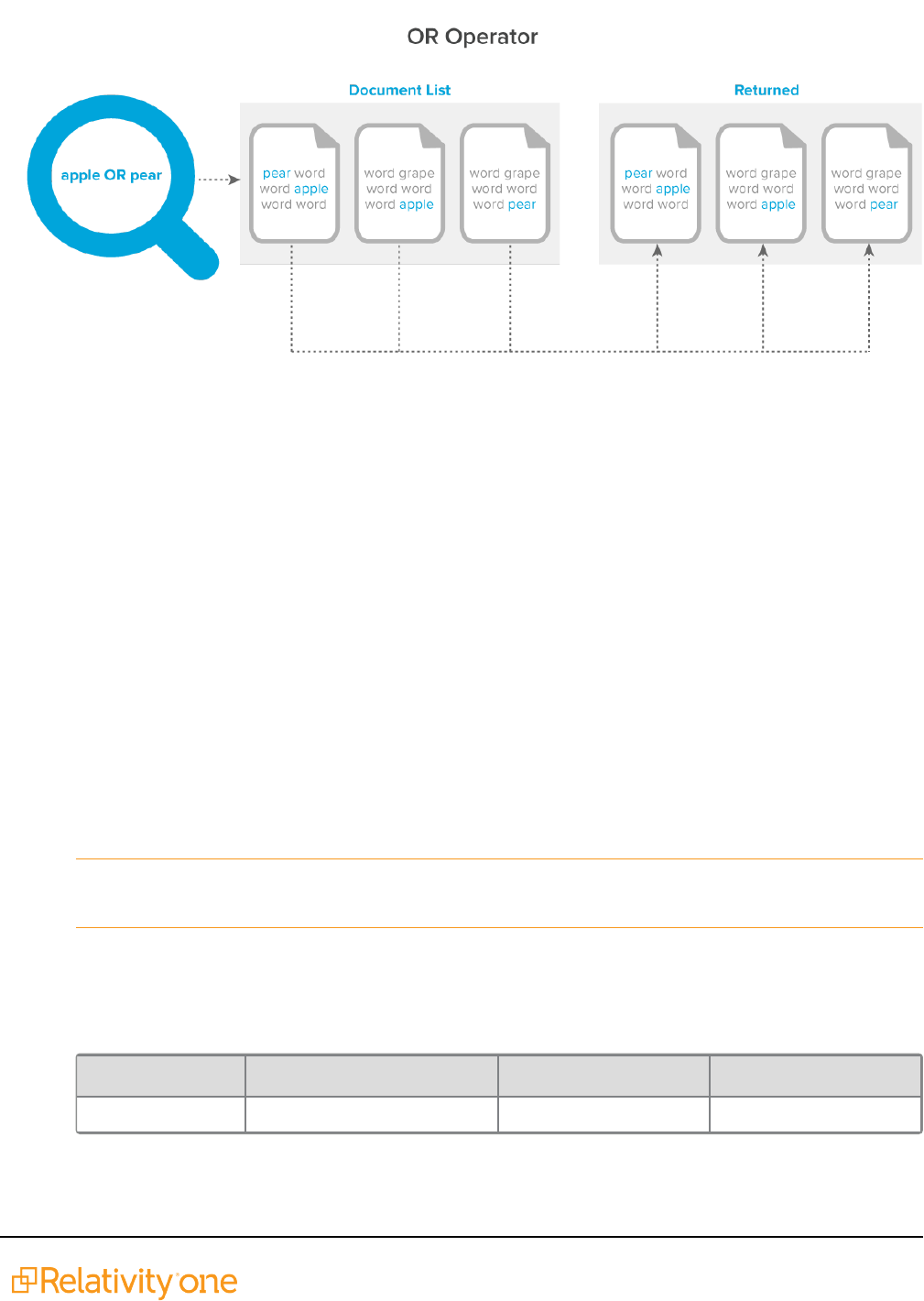
Searching Guide 93
9.10.5.3 NOT operator
In a dtSearch, you can use the NOT operator at the beginning of a search expression to negate its meaning
and exclude documents from a result set. For example, the search expression applesauce and NOT pear
returns documents that contain the word applesauce, but not those documents that contain both the words
applesauce and pear.
n
NOT operator as a standalone—you can use the NOT operator by itself at the beginning of a
search expression. For example, the search expression NOT pear returns all the documents that do
not contain the word pear. The search expression NOT (apple w/5 pear) returns all the documents
that do not contain the word apple within five words of pear. Other examples:
o
NOT (apple or pear) returns every document that does not have apple or pear in it.
o
NOT (apple and pear) returns documents where apple and pear do not appear together in the
same document. It returns all other documents including documents with the word apple and
documents with the word pear. It does not return documents that include both terms.
n
NOT operator as a connector—when the NOT operator appears in the middle of a search expres-
sion, you must also use either AND or OR. For example, the search expression apple OR NOT pear
returns all the documents that contain the word apple and those that do not contain the word pear.
Note: You can also use NOT in a proximity search as illustrated by the NOT W/N, NOT Within N
words, operator.
n
AND NOT operator—you can use the AND NOT operator to develop queries for documents that
include the first expression but not the second expression. For example, you may want to query for
email messages that have Ryan as the author, but do not have Will as the recipient. The following
record illustrates these conditions:
Document OCR Recipient Author
AS00001 From: Ryan To: Will Will Ryan
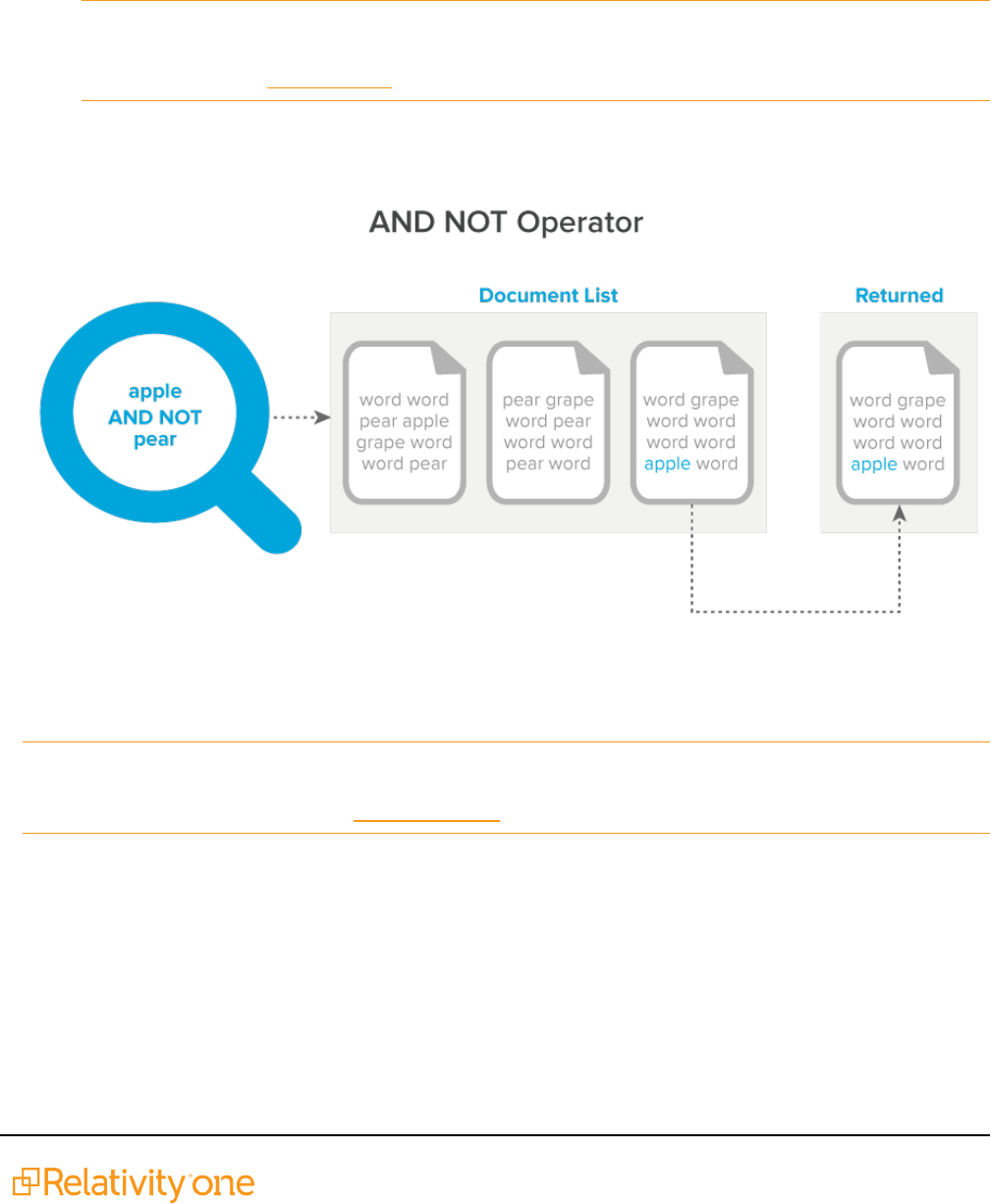
Searching Guide 94
n
You can perform a dtSearch using the search string Ryan AND NOT Will and return results that
do not include document AS00001.
n
The dtSearch engine combines into a single pool the text for all fields identified for inclusion in
an index. A search string using the AND NOT operator queries the index that includes the com-
bine text from all indexed fields, rather than querying the content of individual fields. This beha-
vior ensures consistent result sets when querying with the AND NOT operator.
Note: A keyword search is an SQL full text search, which queries individual fields. Keyword
searches do not return the same results as dtSearch when using the NOT operator to query across
multiple fields. See NOT operator.
The following graphic depicts what documents return when you use the AND NOT operator in a dtSearch
string:
9.10.5.4 Operator precedence - no parentheses
The precedence, or order of evaluation, determines how a group of expressions evaluates in a query.
Note: By default, dtSearch evaluates OR expressions before AND expressions: A AND (B OR C). Unlike
dtSearch, the order of precedence for a keyword search evaluates AND expressions before OR
expressions: (A AND B) OR C. See Keyword search.
Evaluation order for the search string: apple AND pear OR grape
n
pear OR grape evaluates first
n
AND apple evaluates second
Documents containing the following terms return:
n
pear, grape, apple
n
pear, apple

Searching Guide 95
n
grape, apple
9.10.5.5 Operator precedence - with parentheses
Parentheses allow you to group expressions and control the order of query string execution where the query
string contains both AND and OR operators. dtSearch requires both AND and OR operators for the
parentheses to affect query results and ignores parentheses when the query string does not contain both
operators.
For query strings containing both AND and OR operators, dtSearch evaluates OR first before AND.
However, expressions contained within parentheses take precedence. If you want AND evaluated before
OR, place the AND expression within parentheses.
Evaluation order for the search string: grape OR (apple AND pear)
n
apple AND pear evaluated first as they reside within the parentheses
n
OR grape evaluated second
dtSearch returns documents containing the following terms:
n
apple, pear, grape
n
apple, pear
n
grape
9.10.5.6 Workaround for expressions containing only AND or OR operators
Use a proximity operator to separate query expressions. For example, insert a PRE proximity operator
between each expression of the search string.
Evaluation of the search phrase: (grape OR apple) PRE/1 (banana OR pear)
dtSearch returns documents containing the following terms:
n
grape banana
n
grape pear
n
apple banana
n
apple pear
Evaluation of the search phrase: (grape OR apple) (banana OR pear)
dtSearch ignores the parentheses and analyzes the query as grape OR apple banana OR pear and returns
documents with the following terms:
n
grape
n
apple banana
n
pear
n
grape, apple banana, pear
9.10.6 Exact phrase - no double quotes
Searching for words next to each other with no operator between them constitutes an exact phrase in
dtSearch. For example, if you search for apple pear, dtSearch returns documents that contain the exact

Searching Guide 96
phrase apple pear. There is no rule that requires double quotes around a phrase of any number of words.
You only need to use double quotes when searching for a word that is a dtSearch operator. For more
details, see Exact phrase - double quotes.
Search string: pear orange
n
Returns the exact phrase: pear orange
n
Does not return standalone word: pear
n
Does not return standalone word: orange
Search string: apple grape banana
n
Returns the exact phrase: apple grape banana
n
Does not return partial phrase: apple grape
n
Does not return standalone word: grape banana
9.10.7 Fuzzy searching
Using the dtSearch engine, you can perform fuzzy searches, which return documents containing spelling
variations of a specified term. You may want to use fuzzy searching when querying documents that contain
misspelled terms, typographical errors, or you have scanned with Optical Character Recognition (OCR).
Note: Fuzzy searching is not supported in Search Terms Reports (STR). You must use the Dictionary
function to perform fuzzy searching. You would then add the desired terms to the STR. For information on
how to use the Dictionary, see Running a Dictionary search.
The percent sign (%) is the character used for fuzzy searches. The number of % used indicates how many
characters in the search term dtSearch engine ignores when it runs the query. The position of the %
indicates the number of characters from the beginning of the term that must match exactly with words in the
result set. The following search strings illustrate how to use this character:
n
app%ly indicates that a matching word must begin with app and differ from apply by only one char-
acter.
n
a%%pply indicates that a matching word must begin with a and differ from apply by only two char-
acters.
9.10.7.1 Using the fuzziness operator and fuzziness level option
In Relativity, you can use the fuzziness character (%) or the Fuzziness Level menu to perform fuzzy
searches. The availability of these search options depends on the location where you are running a
dtSearch:
n
Documents tab—when you select a dtSearch in the Search With option, you can use the fuzziness
character (%). See Running a dtSearch.
n
Dictionary Search—when you click the Dictionary link, you can use the fuzziness character (%)
and the Fuzziness Level menu on the Dictionary Search dialog. See Running a Dictionary search.
In the Fuzziness Level menu, you can select a value from 1 to 10, which applies to all terms in the
text box. Larger numbers return terms with more variation. We recommend using values between 1-3
for moderate error tolerance. The following table describes the expected results for sample settings.
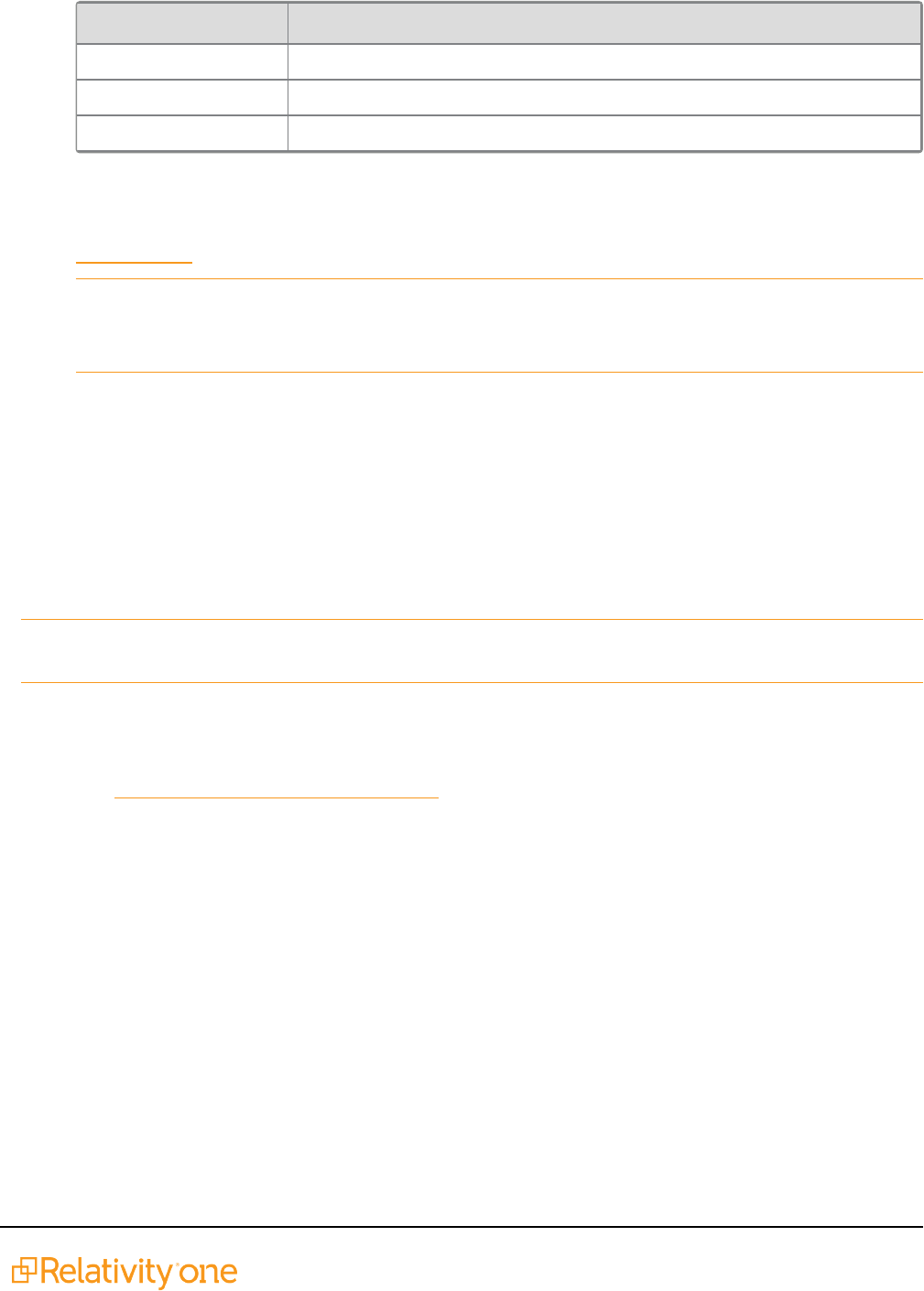
Searching Guide 97
Fuzziness level Description of search results
Blank Only returns the entered term.
1 Returns slight variations of the entered term.
4 Returns multiple variations of the entered term.
n
Saved Search—when you create a saved search, you can use the fuzziness operator (%) and the
Fuzziness Level menu when you add a dtSearch index condition or by clicking the Dictionary link.
The Fuzziness Level menu in a saved search uses the same settings as described above. See
Saved search.
Note: The Fuzziness Level menu is independent of the fuzziness (%) character that you can enter
in the text box. A search for appl% without a Fuzziness Level setting may return documents con-
taining apple or apply, since these terms have the stem appl and differ by one character.
Fuzzy searching uses term length and fuzziness level to decide how many % characters to add. This is not a
straight level to character match. This means a level seven fuzziness search does not necessarily mean up
to seven additional characters return.
9.10.8 Noise words and the alphabet file
The dtSearch engine references a default list of noise words and an alphabet file when it creates a new
index. The dtSearch index excludes the noise words to improve query performance and prevent
unnecessary index growth. When you run a query, dtSearch ignores words such as AND, THE, and WILL.
The alphabet file determines how queries handle characters and spaces.
Note: If your dtSearches do not return expected results, you may want to contact your system
administrator to adjust the noise word list or alphabet file.
9.10.8.1 Alphabet file
The dtSearch engine uses an alphabet file to define which characters to treat as text, cause word breaks,
and ignore. System administrators can modify the default alphabet file when they create or edit a dtSearch
index. See Making a special character searchable.
The alphabet file determines which characters to treat as text, which cause spaces, which cause word
breaks, and which to ignore. The categories of items in the alphabet file include:
n
Letters—all searchable characters, which should include all alphabet characters, a-z and A-Z, and
all digits, 0-9.
n
Hyphens—characters removed during index creation. For example First-Level becomes two sep-
arate words in a dtSearch index.
n
Spaces—characters that cause a word break. For example, the period indexes as a space character
by default. Thus, dtSearch processes U.S.A. as three separate words: U, S, and A. Values listed as
\## are Unicode characters. Their definitions are:
o
\09—horizontal tab
o
\0a—line feed
o
\0c—form feed
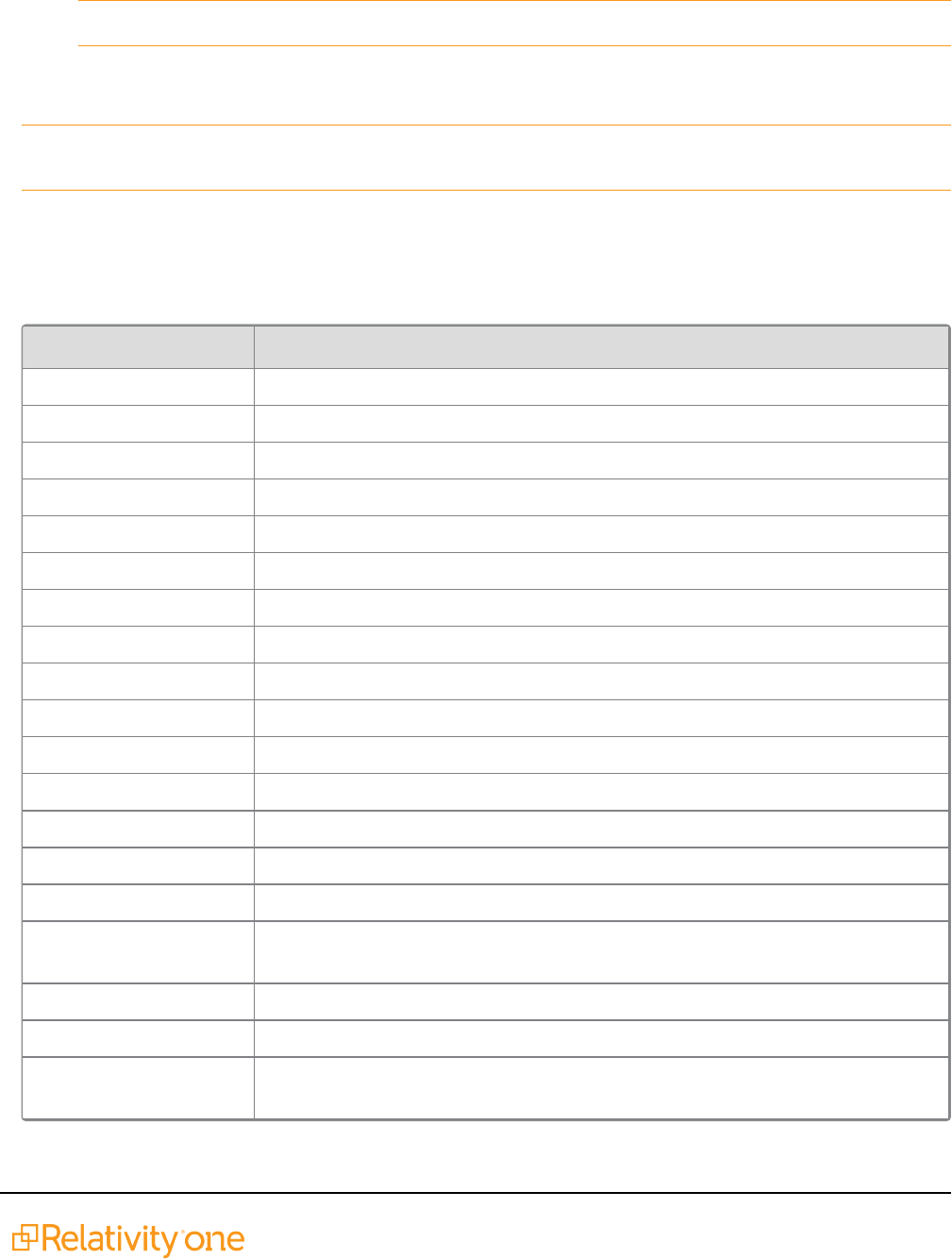
Searching Guide 98
o
\0d—carriage return
o
\5c—backslash (\)
Note: Do not remove these Unicode characters from your alphabet file.
n
Ignore—characters that dtSearch should disregard in processing text. For example, if you classify
the period as ignore instead of space, then dtSearch would process U.S.A. as one word, USA.
Note: dtSearch does not the underscore (_)as a space by default. Verify that the [Spaces] section
defines a given character before treating it as a word break in a dtSearch.
9.10.8.2 Default noise word list
The following table shows the default noise words list. System administrators can modify this list when they
create or edit a dtSearch index. Thus, if you search for a phrase that contains a term in the noise words list,
you need to remove the term from the list and rebuild your index.
Begins with... Noise words
A a, about, after, all, also, an, and, another, any, are, as, at
B be, because, been, before, being, between, both, but, by
C came, can, come, could
D did, do
E each, even
F for, from, further, furthermore
G get, got
H had, has, have, he, her, here, hi, him, himself, his, how, however
I i, if, in, indeed, into, is, it, its
J just
L like
M made, many, me, might, more, moreover, most, much, must, my
N never, not, now
O of, on, only, or, other, our, out, over
S said, same, see, she, should, since, some, still, such
T take, than, that, the, their, them, then, there, therefore, these, they, this, those,
through, thus, to, too
U under, up
V very
W was, way, we, well, were, what, when, where, which, while, who, will, with,
would
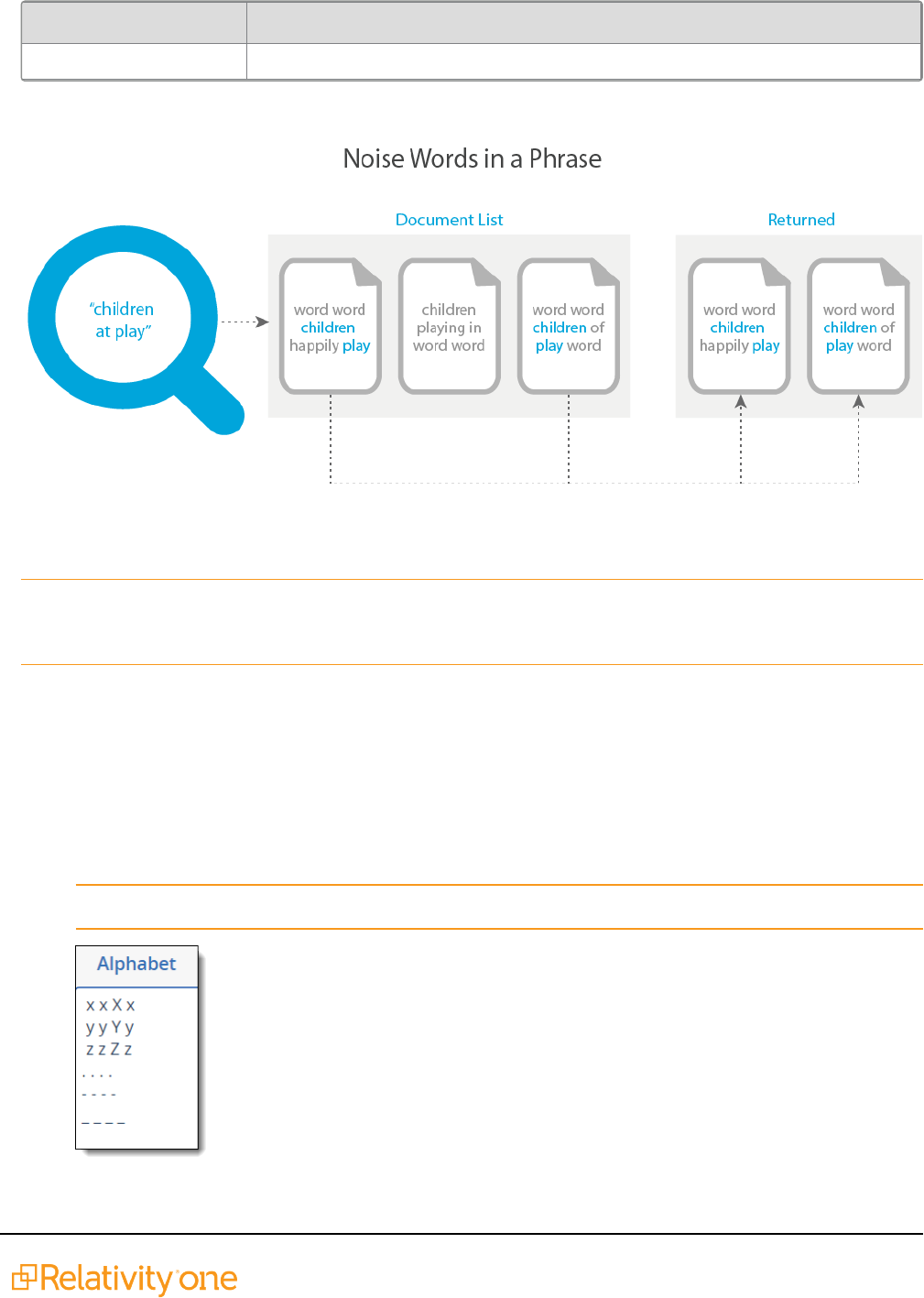
Searching Guide 99
Begins with... Noise words
Y you, your
The following graphic depicts what documents return when you include noise words in a dtSearch string:
9.10.8.3 Making a special character searchable
Note: You can make special characters searchable in a dtSearch index. However, you must escape
some characters when using regular expressions. For more information, see the Searching for symbols
recipe on the Relativity documentation site.
1. Navigate to the dtSearch index.
2. Click Edit, and then scroll down to the Alphabet section.
3. Delete the character from the current category, such as hyphen or spaces. Do not delete the category
heading.
4. Enter the character you want to make searchable four times, separated by spaces under the section
[Letters] // Original letter, lower case, upper case, unaccented.
Note: You must also begin with a space.

Searching Guide 100
5. Perform a full build on the dtSearch index. The search now adds the characters you included.
Note: If you make any symbol a searchable character in your dtSearch index and then build an index on a
long, uninterrupted search string, such as a file path, dtSearch truncates the string after the 32nd
character. For more information, see Searching for words longer than 32 characters.
9.10.9 Numerical patterns
To search for other numerical patterns such as social security numbers, you can use the = wildcard, which
matches any single digit. For example, if you include hyphens as spaces, then the following search request
would find U.S. social security numbers:
=== == ====
This searching pattern can return false hits. For example, no valid social security number begins with nine.
However, this is the only way to get social security numbers with spaces instead of dashes.
Note: dtSearch support notes that the === == ==== notation is higher performing than a regular
expression for the same pattern, assuming you are comfortable with getting some false hits.
9.10.10 Phonic searching
Using the dtSearch engine, you can perform phonic searching, which returns documents containing words
that sound like the word you are searching for and begins with the same letter. The pound sign (#) is the
character used for phonic searches when added to the front of a word. For example, a phonic search for
pear also finds pair and pare.
You can also use phonic searching in Dictionary searches.
9.10.11 Stemming
Using the dtSearch engine, you can perform stemming searches, which return documents containing
grammatical variations of a root word. Stemming limits to English only. The tilde (~) is the character used for
stemming searches when added at the end of the root word. For example, a search on apply~ returns
documents containing the words apply, applying, applies, and applied. After you perform a stemming
search, you can enter applied in the Find Next box, and then click the Find Next icon to locate hits or
grammatical variations.
Because stemming only works with the root word, it generally does not return irregular variations of a verb.
For example, a search on run~ would not return ran. The dtSearch engine only supports stemming for the
English language.
9.10.11.1 Using the stemming operator and enable stemming checkbox
In Relativity, you can use the stemming character (~) or the Enable Stemming checkbox to perform
stemming searches. The availability of these search options depends where you are running a dtSearch:
n
Documents tab—when you select a dtSearch in the Search With option, you can use the stemming
character (~). See Running a dtSearch.
n
Dictionary Search—when you click the Dictionary link, you can use the stemming character (~) and
the Enable Stemming checkbox on the Dictionary Search dialog. See Running a Dictionary search.
n
Saved Search—when you create a saved search, you can use the stemming character (~) and the
Enable Stemming checkbox in the Search Conditions section of the form. See Saved search.

Searching Guide 101
The Enable Stemming checkbox is independent of the stemming (~) character that you can enter in the
Search Terms box or Dictionary Search text box. A search for apply~ with Enable Stemming checkbox
unselected returns apply, applied, applies, or applying. A search for apply with Enable Stemming
checkbox selected returns the same results.
9.10.11.2 Using fuzzy searching and stemming together
With fuzzy searching and stemming enabled, it checks for a fuzzy match twice, once on the original term,
and once comparing the stemmed word with the stemmed word in the index. A match on either counts as a
hit.
9.10.12 Wildcards
The dtSearch engine supports special characters that you can use as wildcards. It also supports the use of
leading wildcards, or those added to the beginning of a word. The following characters represent wildcards
in dtSearches:
Special
character
Function
? Matches any single character.
* Matches any number of characters.
Note: This character slows searches when used near the beginning or middle of a
word.
~ Matches words containing grammatical variations of a root word. The tilde (~) is the stem-
ming character available in dtSearches. See Stemming.
= Matches any numerical character (ex. === == ==== for Social Security Numbers). See
Numerical Patterns.
As illustrated in the following table, you can add wildcards to the root of any word to return matching terms
from a dtSearch.
Sample search string Description of search results
appl* Matches apple, application.
*cipl* Matches principle, participle.
appl? Matches apply and apple, but not apples.
ap*ed Matches applied, approved.
apply~ Matches apply, applied, applies.
=th Matches 4th, 5th, 6th, 7th, 8th.
The following graphic depicts what documents return when you use the * wildcard in a dtSearch string:
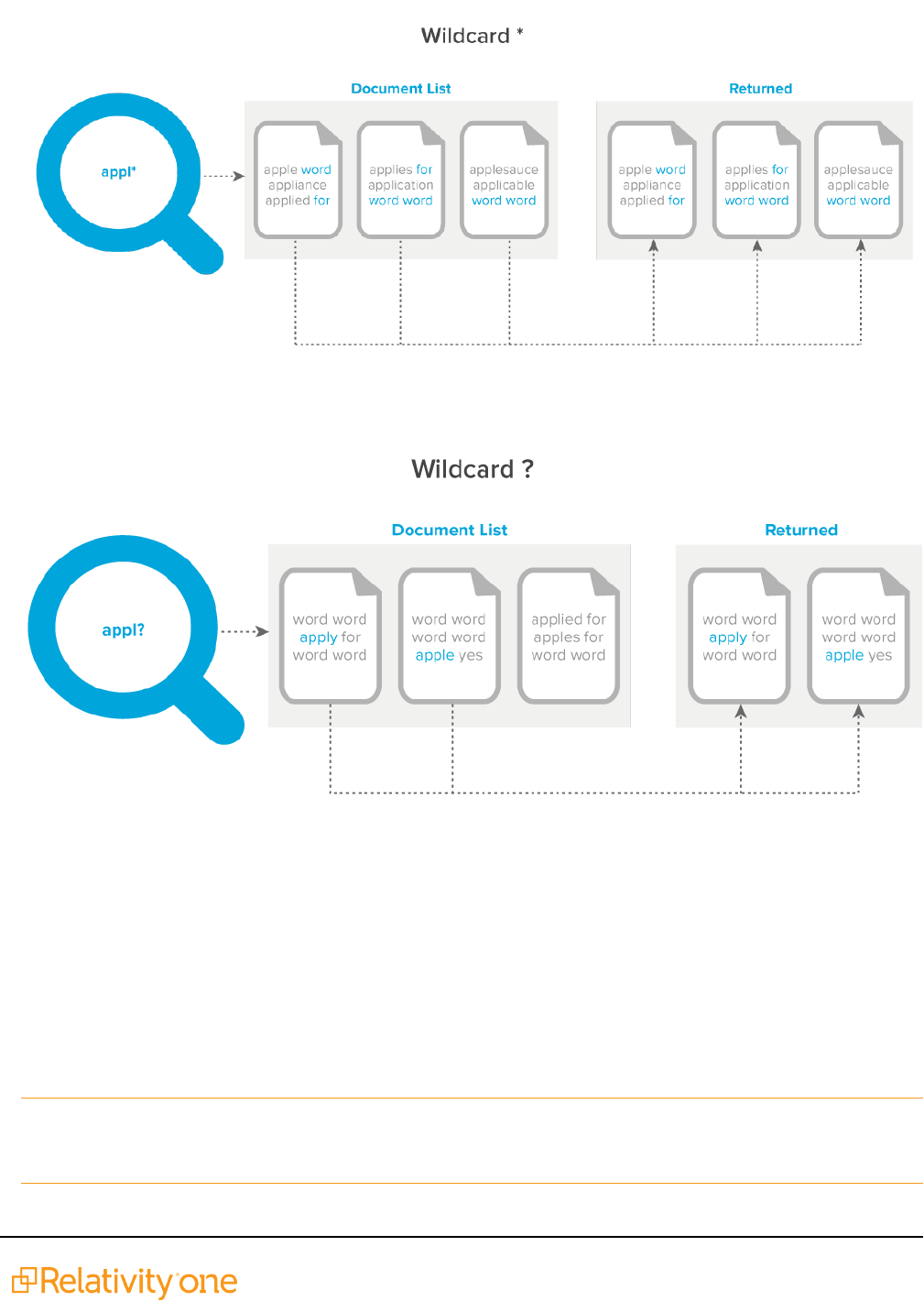
Searching Guide 102
The following graphic depicts what documents return when you use the ? wildcard in a dtSearch string:
9.10.13 W/N operator
You can use the W/N, within N words, operator to return documents with two words or phrases occur within
a certain proximity of each other. When using Boolean operators in a proximity search with the W/N
operator, dtSearch includes noise words. The N value represents the number of intervening words. For
example, the search expression apple W/5 pear returns documents that contain apple only when it occurs
within five words of pear. The documents returned by the search must contain the terms within the required
proximity, such as five words.
The W/N operator is symmetrical. The search expression apple W/5 pear returns the exact same document
as pear W/5 apple.
Note: dtSearch treats Single characters as full words when using this operator. For instance, if you
search for Harry W/2 Truman, your search retrieves documents that include Harry S Truman or Harry S.
Truman.

Searching Guide 103
Note: Relativity does not support the WI operator. Use the W/N syntax to search for documents having
words or phrases within a certain proximity of each other.
The following graphic depicts what documents return when you use the W/# operator in a dtSearch string:
9.10.13.1 NOT W/N
You can use the NOT W/N, not within N words, operator to exclude documents from a result set when two
words or phrases are within a certain proximity of each other.
For example, the search expression apple NOT W/20 pear returns documents that contain apple when
separated from pear by at least 20 words. It also returns documents that do not contain pear. Documents
that contain apple separated from pear multiple times with varying proximity return as long as there is at
least one concurrence where apple separates from pear by at least 20 words.
The NOT W/N is not symmetrical. The search expression apple NOT W/20 pear does not return the same
documents as pear NOT W/20 apple.
The following graphic depicts what documents return when you use the NOT W/# operator in a dtSearch
string:

Searching Guide 104
9.10.13.2 Complex expressions
You can create complex expressions with the W/N operator by connecting words or phrases. At least one of
these expressions must be a single word, phrase, or group of words and phrases connected by an OR
operator as illustrated by the following:
n
(apple AND banana) W/10 (pear OR grape)
n
(apple AND banana) W/10 (orange tree)
Note: You can break up complex expressions with OR connectors into separate searches. Search apple
w/10 "orange tree" OR banana w/10 "orange tree" to return the same results as (apple OR banana) W/10
"orange tree".
Avoid creating complex expressions that produce ambiguous results as illustrated in the following
examples:
n
(apple AND banana) W/10 (pear AND grape)
n
(apple w/10 banana) w/10 (pear and grape)
Note: dtSearch displays a warning message when you enter an ambiguous search request.
You can also use the Boolean operators ANDand ORto connect proximity expressions as illustrated in the
following examples:
n
(apple w/10 banana) AND (pear w/5 grape)
n
(apple or banana)OR (pear w/5 grape)
Note: When connecting proximity expressions using Boolean operators, you must use parentheses.
9.10.13.3 Proximity with terms order
You can use the PRE operator to search for a word that appears within a certain number of words before
another word.
For example, the search string apple PRE/5 pear returns documents where apple appears within five words
before pear.
Note: Relativity does not use the POST operator. However, you can mimic this functionality by reversing
the order of the terms, and using the PRE operator.
The following graphic depicts what documents return when you use the PRE/# operator in a dtSearch string:
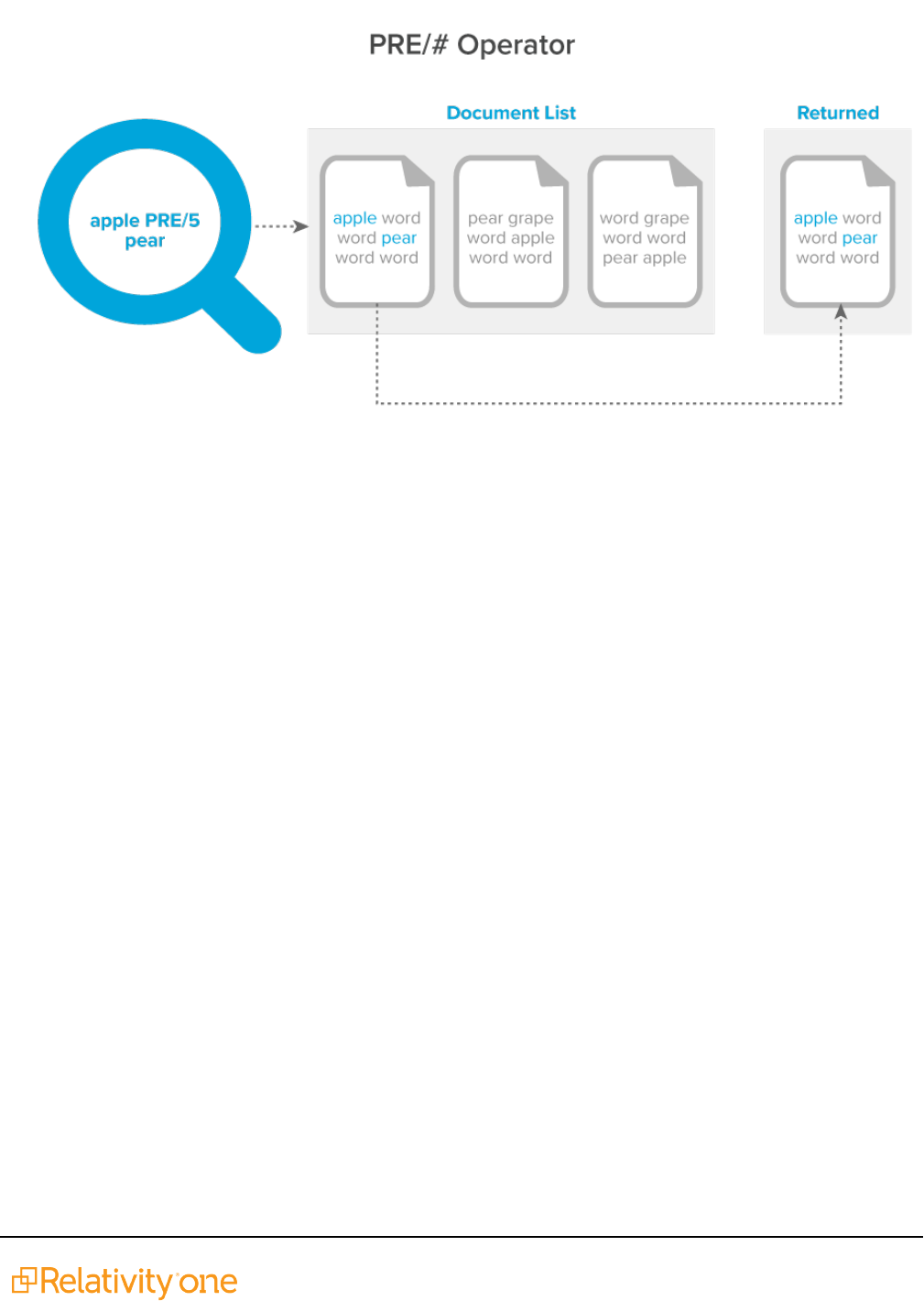
Searching Guide 105
9.10.14 Words and phrases
With a dtSearch, you can use double quotes to search for a phrase. For example, the phrase fruit salad in
the search string apple w/5 "fruit salad". The following list outlines how dtSearch queries on words or
phrases with noise words or punctuation:
n
Phrases with Noise Words—dtSearch skips any noise words in a phrase. For example, it skips of in
the search string Statue of Liberty and retrieves any documents that contains statue an intervening
word, and liberty.
n
Words with Punctuation—punctuation treated as a space when inside a word. For example,
dtSearch treats the search term can't as two words, can and t.
n
Numbers and Characters in Parenthesis—you may see unexpected results when you use num-
bers or characters in parenthesis in a dtSearch. For example, the search term 1843 (c)(8)(ii) returns
as four words.
9.10.15 Other considerations
n
dtSearch does not recognize an underscore (_) by default. Verify you define a given character as
causing a word break before using it as a space in a dtSearch.
n
Relativity does not use the colon (:) or ampersand (&), even though considered a syntax term by the
dtSearch index. If you want to use these symbols, the following applies:
o
To include either symbol in the dtSearch index, you must add it to the alphabet file.
o
To search for either symbol within file content, you must use a regular expression to define the
character. Searching for special characters on their own produces incorrect results.
n
dtSearch indexes are case insensitive by default. All characters in a dtSearch index normalize to
lowercase. For example, if your exact phrase search is an acronym like ACT, you must build a case-
sensitive dtSearch index.
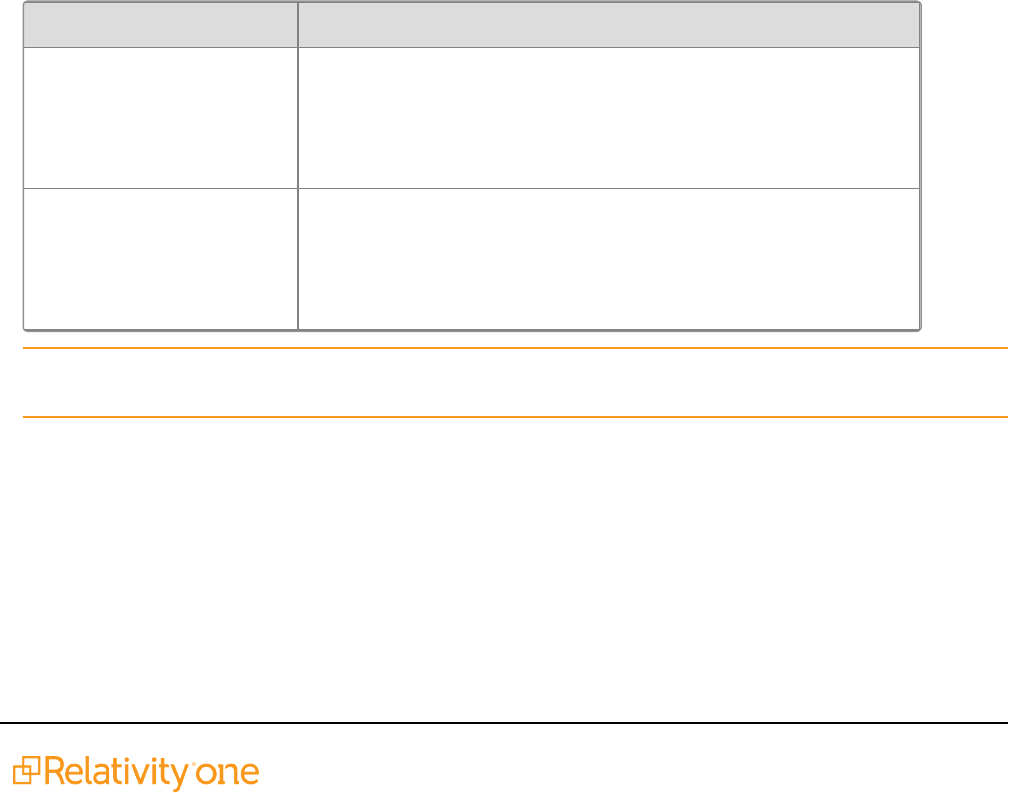
Searching Guide 107
10 Searching with regular expressions (regex)
A regular expression is a form of advanced searching that looks for specific patterns, as opposed to certain
terms and phrases. With regular expressions, you can use pattern matching to search for particular strings
of characters rather than constructing multiple, literal search queries.
Regular expressions uses metacharacters in conjunction with a search engine to retrieve specific patterns.
Metacharacters are the building blocks of regular expressions. For example, “\d” in a regular expression is a
metacharacter that represents a digit character. “d” stands for the literal character, “d.” You can use regular
expressions to search for social security numbers, patent numbers, URLs, email addresses, Bates
numbers, and other strings that follow a specific pattern.
There are several implementations of regular expressions. The differences in implementations usually
include the way special characters are handled and how character classes are treated.
10.1 Use cases for regular expressions
Regular expressions can help you in cases where you need to find different numbers that contain the same
pattern.
Take, for example, the serial numbers in the first cell below. Instead of writing three literal search strings to
match each serial number, you can construct one regular expression to match the serial numbers’ pattern.
This single regular expression returns any document that contains any of the three serial numbers. In the
second cell, there is another serial number with a slightly different pattern. By making a few adjustments to
your regular expression string, your search results return documents with the new pattern.
Text Pattern/Regular Expression
n
XFRD-8324-ERWH-
3231
n
GHSR-3413-KBKV-
8173
n
Pattern: 4 letters-4 digits-4 letters-4 digits
n
Regular expression: [a-zA-Z]{4}-[0-9]{4}-[a-z]{4}-[0-9]{4}
n
ABC.001.001.0001_
0001
n
xyz.123.123.1234_
1234
n
Pattern:3 letters.3 digits.3 digits.4 digits_4 digits
n
Regular expression: [a-zA-Z]{3}\.[0-9]{3}\.[0-9]{3}\.[0-9]{4}_
[0-9]{4}
Note: Think of each regular expression as a phrase when you construct your search string. If you switch
the order of the string you will not receive the same results.
Unless you modify your dtSearch index to be case-sensitive, you cannot use capital letters when
constructing a regular expression in dtSearch.
For example, if you search for strings that begin with NLRT:
n
NLRT-0381
n
NLRT-6334
n
NLRT-9167
Use the following regular expression in Relativity: "##nlrt-\d{4}"

Searching Guide 108
10.2 Regular expression metacharacters
Metacharacters are the building blocks of regular expressions. Characters in regular expressions are
understood to be either a metacharacter with a special meaning or a regular character with a literal
meaning.
The following are some common regular expression metacharacters and examples of what they would
match or not match in regular expression.
Metacharacter Description Examples
\d Whole Number 0 - 9
\d\d\d = 327
\d\d = 81
\d = 4
-----------------------------------------
\d\d\d ≠ 24631
\d\d\d does not return 24631
because 24631 contains 5 digits.
\d\d\d only matches for a 3-digit
string.
\w Alphanumeric Character
\w\w\w = dog
\w\w\w\w = mule
\w\w = to
-----------------------------------------
\w\w\w = 467
\w\w\w\w = 4673
-----------------------------------------
\w\w\w ≠ boat
\w\w\w does not return boat
because boat contains 4
characters.
-----------------------------------------
\w ≠ !
\w does not return the exclamation
point ! because it is a non-
alphanumeric character.
\W Symbols
\W = %
\W = #
\W\W\W = @#%

Searching Guide 109
Metacharacter Description Examples
-----------------------------------------
\W\W\W\W ≠ dog8
\W\W\W\W does not return dog8
because d, o, g, and 8 are
alphanumeric characters.
[a-z]
[0-9]
Character set, at least one of which must be a
match, but no more than one unless otherwise
specified.
The order of the characters does not matter.
pand[ora] = panda
pand[ora] = pando
-----------------------------------------
pand[ora] ≠ pandora
pand[ora] does not bring back
pandora because it is implied in
pand[ora] that only 1 character in
[ora] can return.
Quantifiers that allow pand[ora] to
match for pandora is discussed
below.
(abc)
(123)
Character group, matches the characters abc or
123 in that exact order.
pand(ora)= pandora
pand(123)= pand123
-----------------------------------------
pand(oar) ≠ pandora
pand(oar)does not match for
pandora because it's looking for
the exact phrase pandora.
| Alternation—allows for alternate matches. | oper-
ates like the Boolean OR.
pand(abc|123) = pandabc OR
pand123
? Question mark matches when the character pre-
ceding ? occurs 0 or 1 time only, making the char-
acter match optional.
colou?r = colour (u is found 1 time)
colou?r = color (u is found 0 times)
* Asterisk matches when the character preceding *
matches 0 or more times.
Note: The asterisk (*) in regular expression is
different from * in dtSearch. Regular
expression * is asking to find where the
character, or grouping, preceding * is found
ZERO or more times. dtSearch * is asking to
find where the string of characters preceding *
or following * is found 1 or more times.
tre*= tree (e is found 2 times)
tre* = tre (e is found 1 time)
tre* = tr (e is found 0 times)
-----------------------------------------
tre* ≠ trees
tre* does not match the term trees
because although "e" is found 2
times, it is followed by "s" , which is

Searching Guide 110
Metacharacter Description Examples
not accounted for in the regular
expression.
+ Plus sign matches when the character preceding
+ matches 1 or more times. The + sign makes the
character match mandatory.
tre+ = tree (e is found 2 times)
tre+ = tre (e is found 1 time)
-----------------------------------------
tre+ ≠ tr (e is found 0 times)
tre+ does not match for tr because
e is found zero times in tr.
. (period) The period matches any alphanumeric character
or symbol.
ton. = tone
ton. = ton#
ton. = ton4
-----------------------------------------
ton. ≠ tones
ton. does not match for the term
tones because . by itself will only
match for a single character, here,
in the 4th position of the term. In
tones, s is the 5th character and is
not accounted for in the regular
expression.
.*
Combine the metacharacters . and *, in that order
.* to match for any character 0 or more times.
Note: .* in regular expression is equivalent to
dtSearch wildcard * operator.
tr.* = tr
tr.* = tre
tr.* = tree
tr.* = trees
tr.* = trough
tr.* = treadmill
10.2.1 Regular expression quantifiers
Regular expressions uses quantifiers to indicate the scope of a search string. You can use multiple
quantifiers in your search string. The following table gives examples of the quantifiers you can use in your
regular expression:
Quantifier Description Examples
{n} Matches when the preceding character,
or character group, occurs n times
exactly.
\d{3} = 836
\d{3} = 139
\d{3} = 532
-----------------------------------------
pand[ora]{2} = pandar
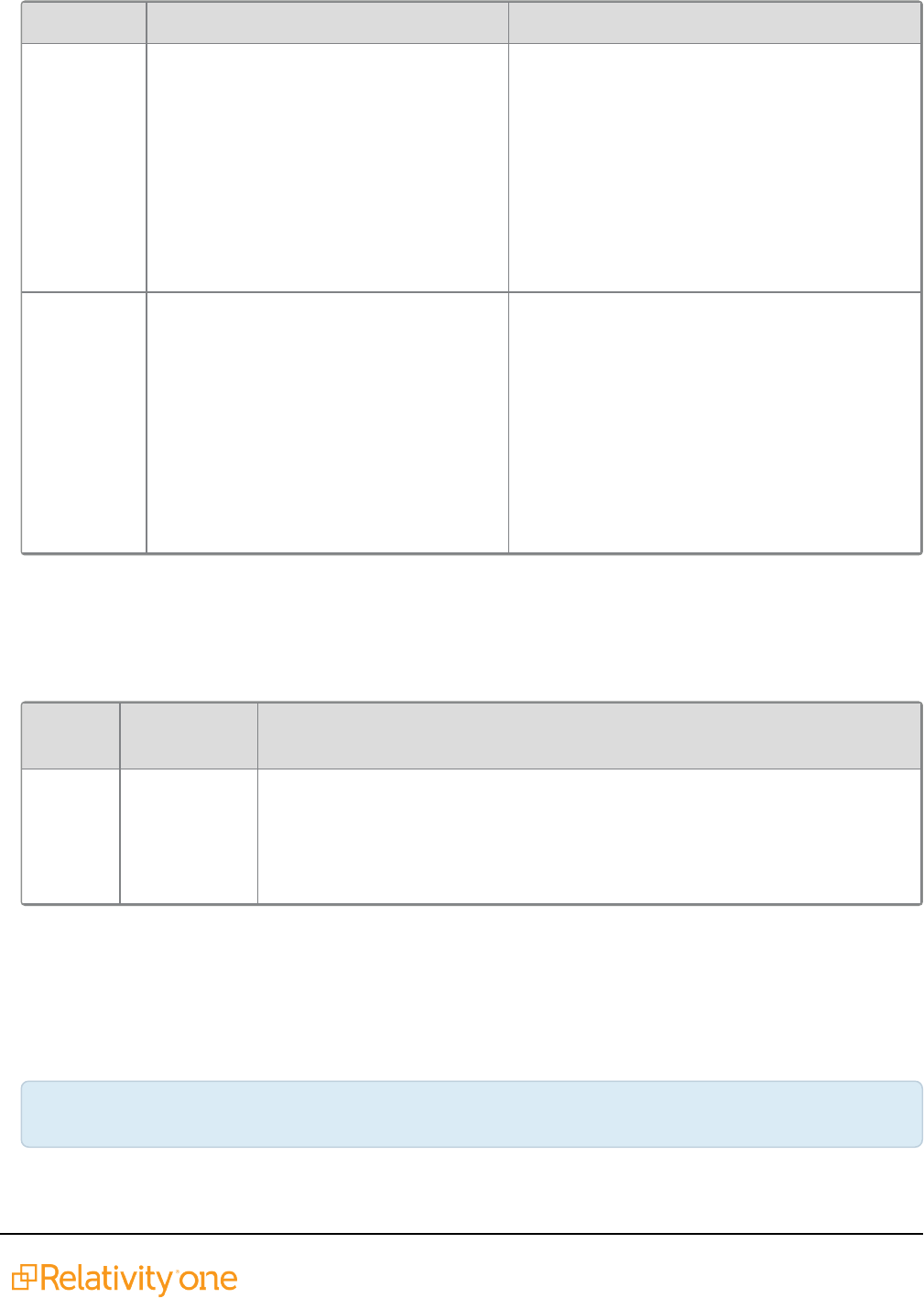
Searching Guide 111
Quantifier Description Examples
pand[ora]{2} = pandoo
pand(ora){2} = pandoraora
-----------------------------------------
pand[ora]{2} ≠ pandora
pand[ora]{2} does not match for pandora
because the quantifier {2} only permits for 2
letters from the character set [ora].
{n,m} Matches when the preceding character,
or character group, occurs at least n
times, and at most m times.
\d{2,5} = 97430
\d{2,5} = 9743
\d{2,5} = 97
-----------------------------------------
\d{2,5} ≠ 9
9 does not match because it is 1 digit, thus
outside of the character range.
10.2.2 Escaping regular expression metacharacters
When using regular expressions to search for a character that is a reserved metacharacter, use the
backslash \ to escape the character so it can be recognized. The following table gives an example on how to
escape a reserved metacharacter when searching.
Search
For
Regular
Expression
Match Results
UK phone
number
\+[0-9]{11} >+14528280001
+38119930978
-----------------------------------------If the + sign is not escaped with a backslash,
regular expressions treat + as a quantifier instead of the literal plus sign char-
acter.
10.3 Using regular expressions with dtSearch
You can use regular expressions with your dtSearch index to search for more complex items such as Bates
numbers, zip codes, and phone numbers. You can also use regular expressions in conjunction with
proximity, stemming, and fuzzy searching in dtSearch.
Using Regular Expressions
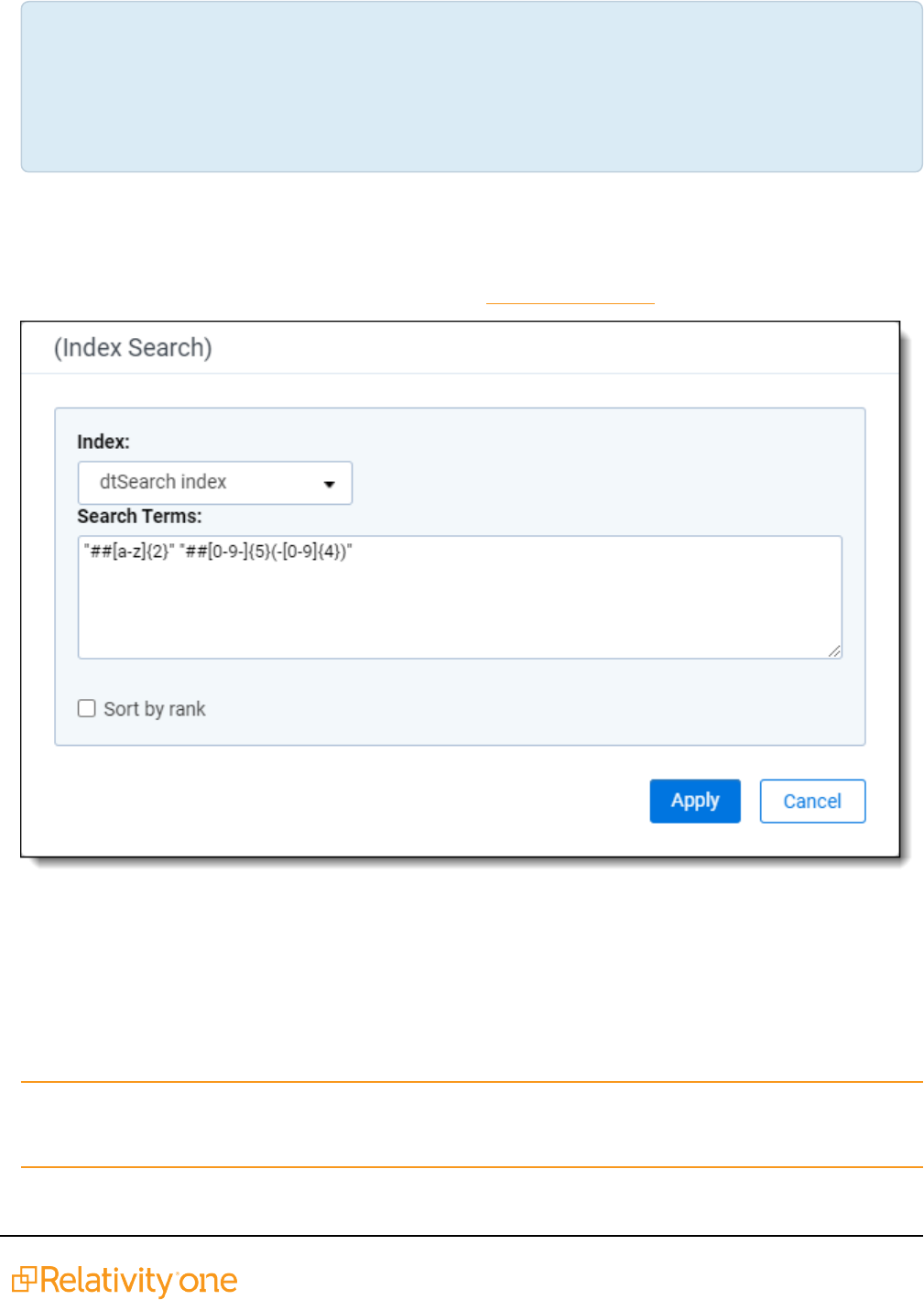
Searching Guide 112
Your case team needs to find documents containing a variety of serial numbers that all match the
same pattern. The pattern consists of five letters, a hyphen, then four numbers: ABCDE-1234.
Instead of searching for every possible serial number, you decide to use a regular expression to
find all instances of the serial number in your document set. Using regular expressions will save
your case team a lot of time. You use the following regular expression search string: "##[a-z]{5}-
[0-9]{4}"
10.3.1 Regular expression search strings
To activate regular expressions in dtSearch, use double pounds signs (##) at the beginning of your search
string. You can start your search from the search bar on the List page, or by adding a condition from the
search panel. For details on how to run a dtSearch, see Running a dtSearch.
Relativity breaks down the regular expression syntax as follows:
Regular Expression—"##RegularExpression". "##" signals to Relativity that the string following ##, and
encapsulated by double quotes, should be interpreted as regular expression. Be sure to use straight double
quotes ("") and not curly quotes (“”). Curly quotes may cause the regular expression to fail . You also want
to avoid using capital letters in your regular expression because all characters in a dtSearch index are
normalized to lowercase. You can use the Dictionary to help troubleshoot an individual regular expression.
If your expression does not match in the Dictionary, it will not match in the index.
Note: Starting in Relativity 10.0.119.1, regular expression searches run from the Document List will
highlight search hits in the Native Viewer for any returned documents. This does not apply to the
Extracted Text mode of the Viewer.

Searching Guide 113
Note: All regular expressions with dtSearch must begin with the ## call sign. If any table entries below do
not include the call sign, be sure to add them to your search string before executing.
10.3.2 Regular expression metacharacters
Metacharacters are the building blocks of regular expressions. Characters in regular expression are
understood to be either:
n
a metacharacter with a special meaning, or
n
a regular character with its literal meaning
10.3.2.1 View regular expression metacharacters examples
Metacharacter Description Example
\d Whole number 0 - 9
\d\d\d = 327
\d\d = 81
\d = 4
\d\d\d ≠ 24631 \d\d\d does not return
24631 because 24631 contains 5 digits.
\d\d\d only matches for a 3-digit string.
\w Alphanumeric character
\w\w\w = dog
\w\w\w\w = mule
\w\w = to
\w\w\w = 467
\w\w\w\w = 4673
\w\w\w ≠ boat
\w\w\w does not return boat because
boat contains 4 characters.
\w ≠ !
\w does not return the exclamation point
! because it is a non-alphanumeric
character.
\W Symbols
\W = %
\W = #
\W\W\W = @#%
\W\W\W\W ≠ dog8
\W\W\W\W does not return dog8
because d, o, g, and 8 are alphanumeric
characters.
[a-z] [0-9] Character set, at least one of which must be
a match, but no more than one unless oth-
pand[ora] = panda
pand[ora] = pando

Searching Guide 114
Metacharacter Description Example
erwise specified. The order of the characters
does not matter.
pand[ora] ≠ pandora pand[ora] does not
bring back pandora because it is implied
in pand[ora] that only 1 character in
[ora] can return.
Note: dtSearch does not accept white space characters, even with regular expressions.
10.3.3 Regular expression groups
With regular expression groups you can match for groups of characters within a string. The following table
provides examples of how to use groups in your regular expression. Groups are most useful when you use
them in conjunction with alternation and quantifiers.
Metacharacter Description Example
(abc)
(123)
Character group, matches the
characters abc or 123 in that
exact order.
pand(ora) = pandora
pand(123) = pand123
pand(oar) ≠ pandora pand(oar) does not match for
pandora because it is looking for the exact phrase
pandoar.
10.3.4 Escaping regular expression metacharacters
When using regular expression to search for a character that is a reserved metacharacter, use the
backslash \ to escape the character so it can be recognized in its literal sense. The following table gives an
example on how to escape a reserved metacharacter when searching.
Search for
Regular
expression
Match results
International
phone number
(UK)
\+[0-9]{12}
+447700900954
+447700900312
If the + sign is not escaped with a backslash, regular expression treats
+ as a quantifier instead of the literal plus sign character.
10.3.4.1 Regular expression caveats in dtSearch
There are a few caveats to consider when using regular expressions in dtSearch. Consider the following
caveats before constructing your regular expression.
n
The metacharacter \s never matches a whitespace character in Relativity, because whitespace char-
acters do not exist in a dtSearch index. Instead, spaces are word breaks in dtSearch.
Unless you modify your dtSearch index to be case-sensitive, you cannot use capital letters when
constructing a regular expression in dtSearch.
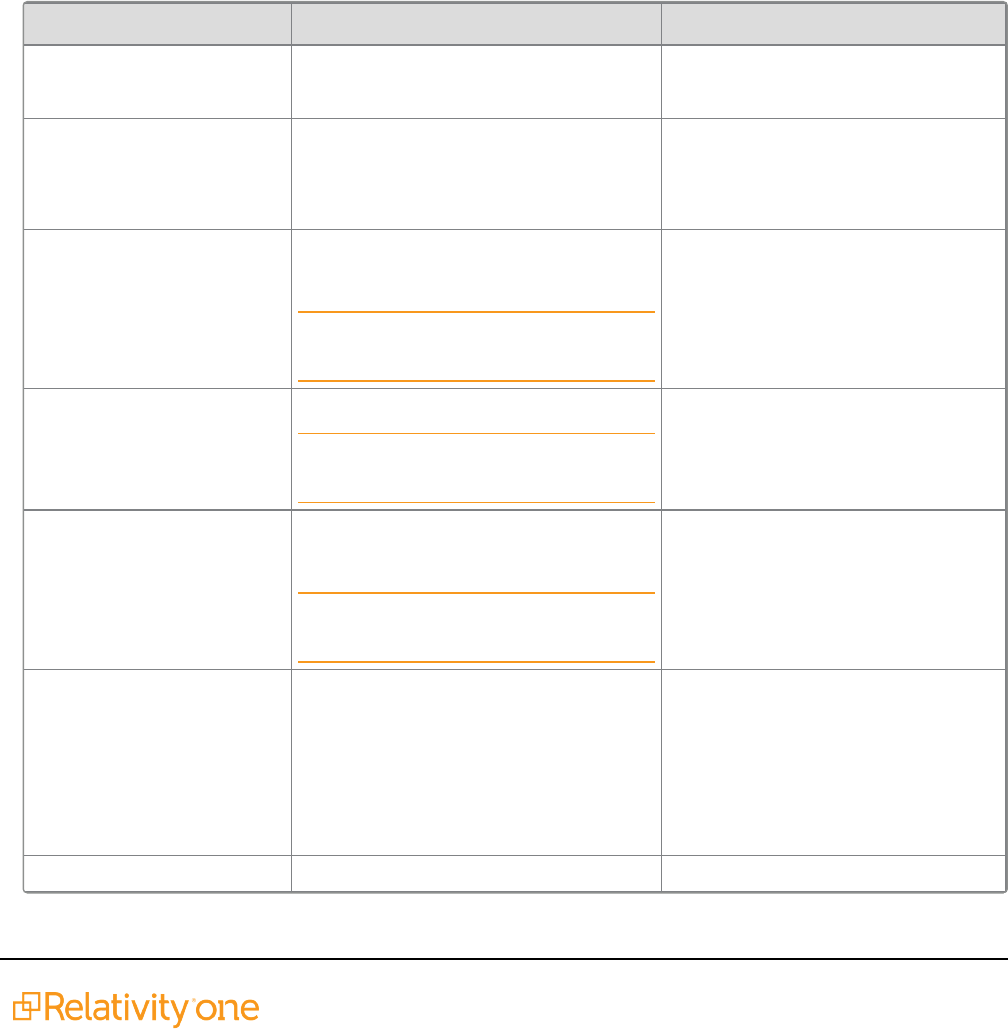
Searching Guide 115
For example, if you search for strings that begin with NLRT:
o
NLRT-0381
o
NLRT-6334
o
NLRT-9167
Use the following regular expression in Relativity: "##nlrt-\d{4}"
n
You cannot search characters which are ignored during indexing, such as punctuation. To index a
punctuation character, confirm that it is listed as a letter in your dtSearch alphabet file, and that it is
not listed as an ignored, hyphen, or space character.
10.3.5 Common dtSearch regular expression examples
The following table includes examples of dtSearch regular expressions you can use to search for patterns in
dtSearch.
Type Regular Expression Match Results
Bates numbers "##rel[0-9]{7}"
"##rel\d{7}"
REL0000331
REL3728948
Zip codes "##[a-z]{2}" "##[0-9]{5}"
"##[a-z]{2}""##\d{5}"
IL 60606
MD 21218
ca 94115
United States Phone
numbers
"##[0-9]{3}-[0-9]{4}"
"##\d{3}-\d{4}"
Note: You must make the hyphen
(-) searchable in your index.
373-8837
463-9391
819-3814
United States Phone
numbers with or without
area codes
"##([0-9]{3}-)?[0-9]{3}-[0-9]{4}"
Note: You must make the hyphen
(-) searchable in your index.
312-483-8372
463-9391
Serial numbers "##[a-z]{4}-[0-9]{4}-[a-z]{4}-[0-9]{4}"
"##[a-z]{4}-\d{4}-[a-z]{4}-\d{4}"
Note: You must make the hyphen
(-) searchable in your index.
XRFD-8324-ERWF-3231
GHSR-3413-KWEJ-8173
MPFS-1357-QEGT-9376
Dates "##[0-9]{1,2}/[0-9]{1,2}/[0-9]{2,4}" 10/17/2015
3/6/98
4/25/2006
12/04/87
95/94/93

Searching Guide 116
Type Regular Expression Match Results
Note: You must make the at symbol
(@) and period (.) searchable in
your index.

Searching Guide 117
11 Saved search
A saved search is a saved set of criteria that returns the latest documents that meet that criteria. For
example, if you want to reference documents that contain the terms "confidential"and "property" and are
also marked as Relevant, you can create a saved search with that criteria. However, saved searches can be
much more complex.
In Relativity, you can create saved searches by defining custom queries and unique views, as well as by
selecting public or private security settings, specific folders to query, and nested sort orders. You can also
execute a search on the fly, save it for later use, or perform a combination of these tasks.
Since saved searches are executed in real-time, you save the search definition but not the results. Relativity
executes the search each time you click on it in the Saved Searches browser and when you return to it after
performing other tasks in the workspace. This functionality ensures that only data meeting the search
criteria is returned in the result set. You can set the Requires Manual Rerun option to control this
functionality.
Note: When you execute a saved search, Relativity first applies the conditions then related items, from
the search criteria, then the filters from the item list. The only exception is when you have nested
relational searches. For example, Search A which relies on the results of Search B. In this scenario,
Relativity applies the innermost search conditions, in this case, Search B, then the family Search B relies
on. It then applies the outer search conditions, Search A, then the family Search A relies on. Finally,
Relativity applies the filters from the item list.
You can also use saved searches as the building blocks in other Relativity features. For example, you are
required to select a saved search when you set up a Review Center queue, build a dtSearch or Analytics
index, define an imaging set, and perform other tasks in Relativity.
Using saved searches
You need access to all the emails in your workspace that were sent between Jan 1, 2013 and Oct
8, 2014 because they contain many references that are vital to your client's case. You’re going to
reference these documents multiple times throughout review, so it would be nice to have a way to
save them and not have to search for them each time. Relativity's saved search feature permits
you to do just that.
You go to the saved search browser and create a new saved search. You set the Includes field
toInclude Family because you need to return files with the same group identifier as the files that
meet the field conditions you are about to enter. For the Conditions field, you select the Sent Date
field with an Operator of between. For the two Value choices you select 1/1/2013 and 10/8/2014.
When you click Save & Search, Relativity returns only email that fall in the date range you
specified, and any reviewer with permissions to this saved search can easily bring up these
documents in the saved search browser at any time.
11.1 Required security permissions
A user must have the following security permissions to view, edit, and add saved searches and saved
search folders:
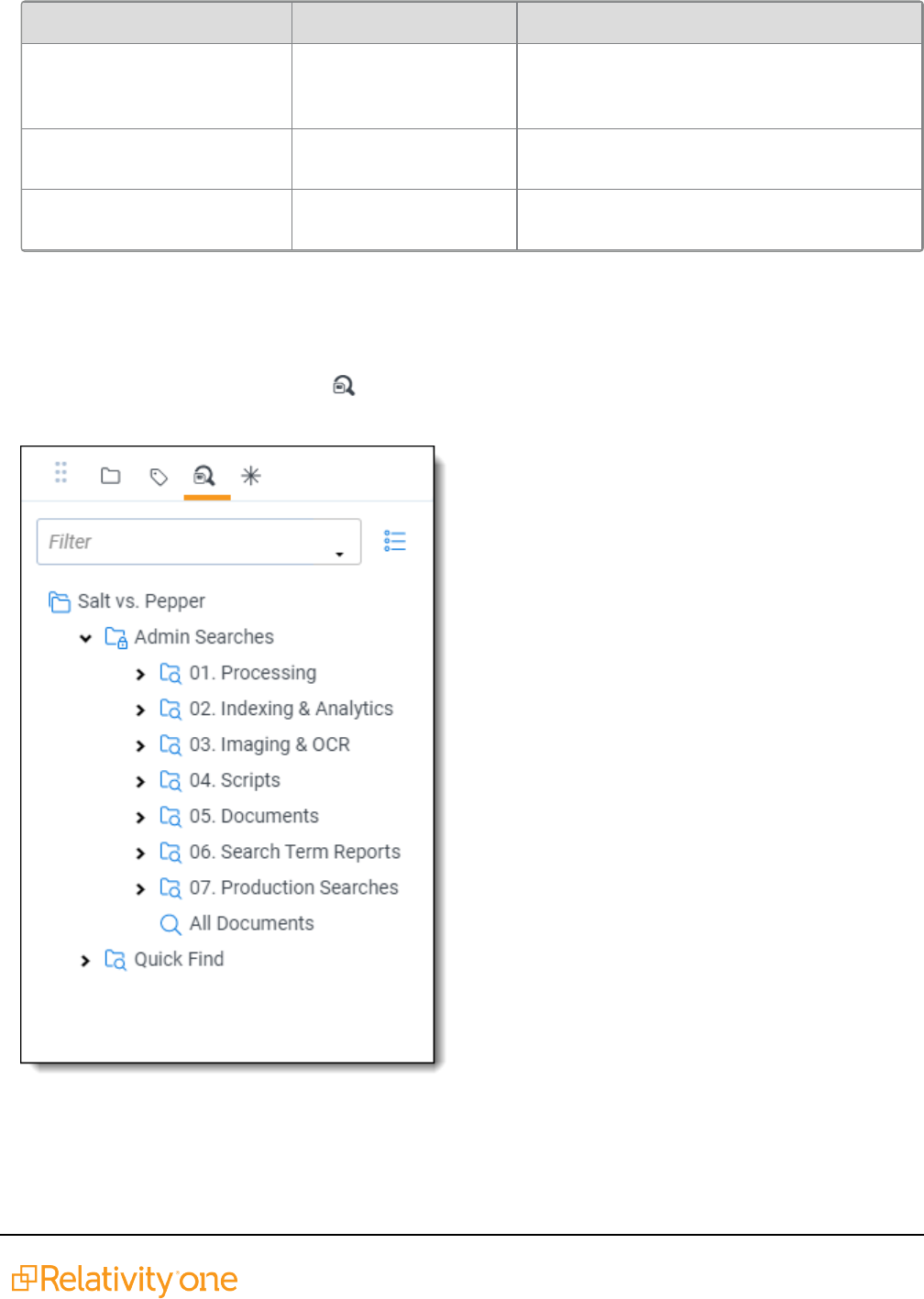
Searching Guide 118
Tab/Permission Permission Description
Object Security/Search View, Edit, Add Users can view saved searches, edit existing
saved searches, and add new saved
searches.
Object Security/Search Con-
tainer
Edit, Add Users can edit existing saved search folders
and add new saved search folders.
Other Settings/Browsers Advanced & Saved
Searches
Users can see and interact with the Saved
Searches browser.
For more information, see the guide on Setting workspace permissions.
11.2 Navigating the saved searches browser
On the Documents tab, you can click to view the Saved Searches browser. This browser provides you
with features used to create, organize, edit, and perform other tasks with saved searches.
The Search Folder Tree displays the following options:

Searching Guide 119
n
Create New Search button—click this to display the Saved Search form. To display this form, you
can also click any folder, including the root folder.
n
Public or Private—the icons display next to the name of a saved search to indicate its visibility.
n
Search text box—enter the name of a search in this field to automatically filter the list as you type to
the saved searches that you are looking for. See Filtering the list of saved searches.
n
Display check boxes button —click this button to display check boxes in the list to the left of
folders and searches. You can then perform mass operations for items that you check.Click the icon
again to toggle them off. See Performing mass operations on saved searches.
n
Search Right-click Menu—highlight a search in the folder tree to display a right-click menu with the
following options:
o
Edit—displays the Saved Search form, where you can modify the current settings for the
search.
o
Copy—adds a duplicate of the search to the tree.
o
Secure—available on public searches, this option displays a security page so that you can
override the security inherited from the workspace, or parent folder. See the Admin guide for
more information on Setting permissions on Relativity objects.
o
Delete—permanently removes the search from the database.
o
Email Link—opens an email message containing a link to the saved search. The Subject line
is pre-populated with the following text: "Review - <Workspace Name> - <Search Name>."
When the recipient clicks on the link, the saved search is displayed with the current result set.
Note: Relativity displays a permissions denied message if the recipient clicks the link to dis-
play the search but does not have access rights to it.
o
Copy Link to Clipboard—copies a URLpath to the search to your clipboard.
Note: Relativity displays a permissions denied message if the recipient clicks the link to dis-
play the search but does not have access rights to it.
n
Folder Right-click Menu—Highlight a folder to display a right-click menu for managing folders. See
Organizing saved searches in folders.
The action bar displays the following when a search is selected in the browser:
n
Show current path icon —view the current search browser folder location for the displayed
search.
n
Edit Search —when you click this icon on the action bar, the Search Builder dialog appears where
you can update search criteria.
n
Save Search —when you click this icon on the action bar, a pop-up appears where you can select
a new owner and modify the search name. See Creating or editing a saved search.
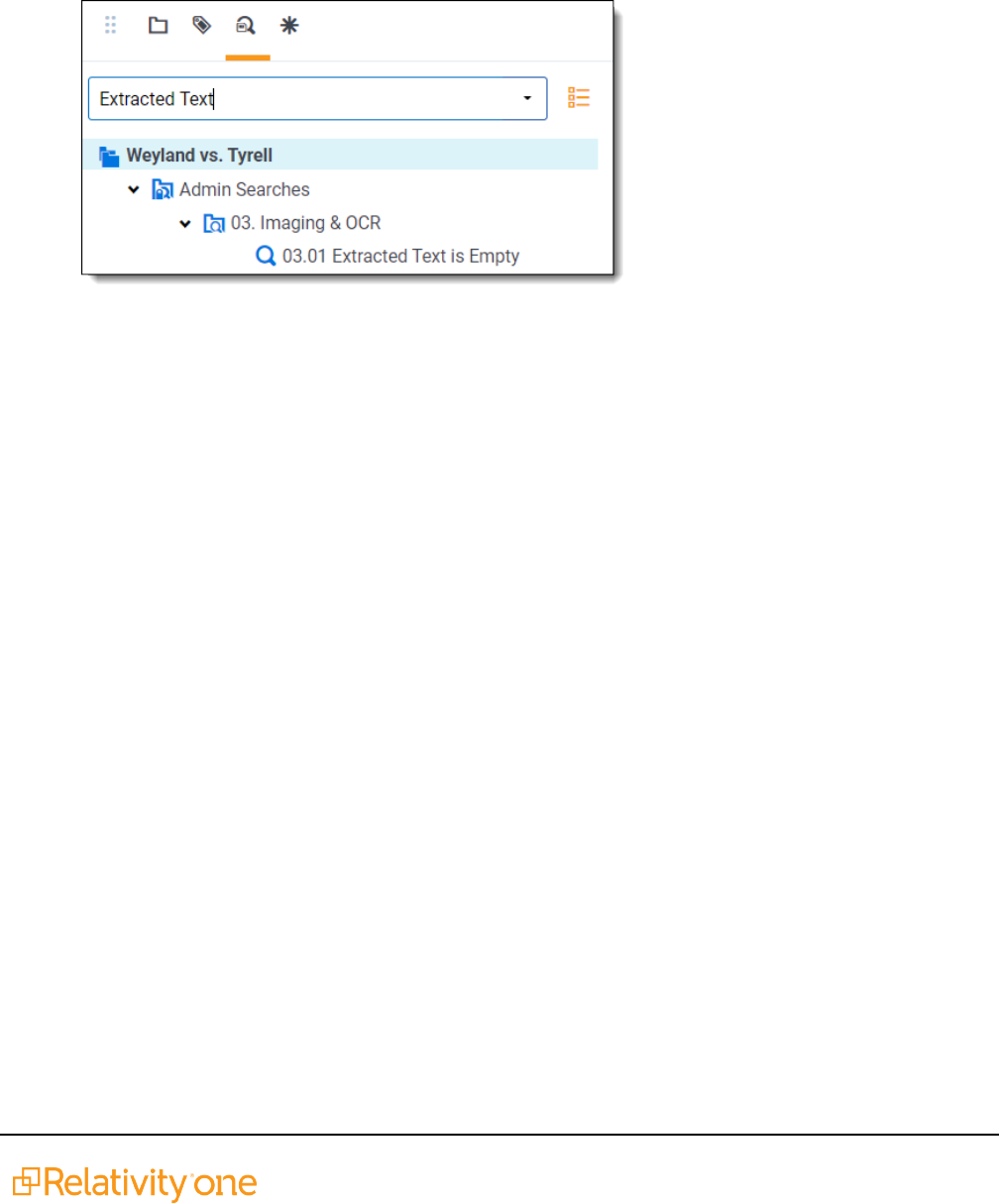
Searching Guide 120
11.2.1 Filtering the list of saved searches
To filter the list in the saved search browser:
1. Enter text matching the search or search folder you want to see in the Filter text box at the top of the
browser.
Matching searches and search folders display as you type in their respective folders.
2. Select the search you want to view.
You can also expand the Filter text box and filter on advanced searching fields, including:
n
Created By—choose which user created the saved search.
n
Created On—select from four different date ranges, including: Past Hour, Today, Past 7 days, and
Past 30 days.
n
Last Modified By—choose which user last modified the saved search.
n
LastModified On—select from four different date ranges, including: Past Hour, Today, Past 7 days,
and Past 30 days.
n
Owner—select a specific user or public.
n
Keywords—enter keywords.
n
Notes—enter notes.
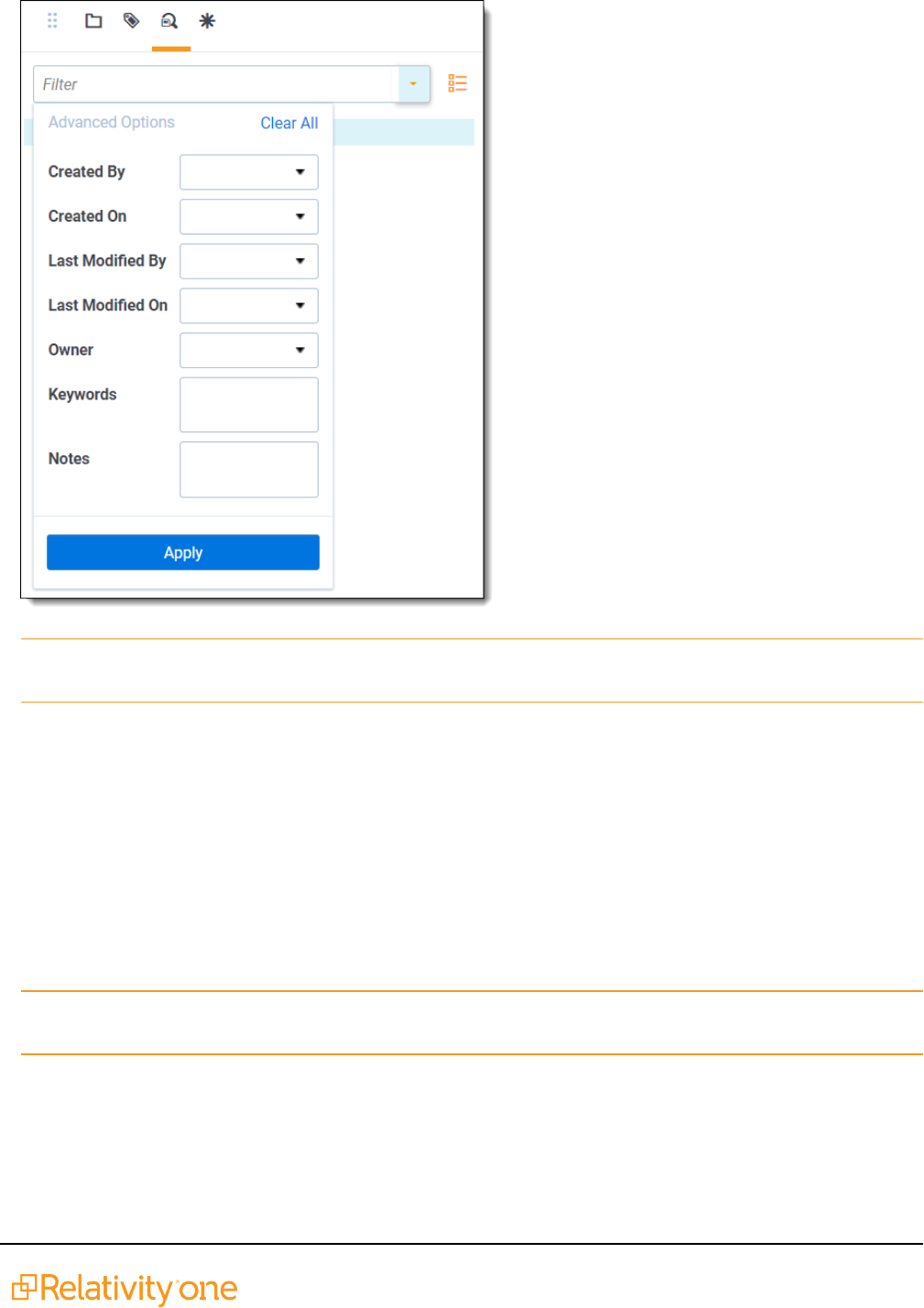
Searching Guide 121
Note: To remove your filtering from the list, delete the text that is there or click the X to the right. The list of
searches will automatically update.
To access Advanced Search Filtering:
1. Navigate to the Views tab.
2. Locate the Advanced Search Browser View.
3. Make sure at least one of the following fields is added to the view: Created By, Created On, Last Modi-
fied By, Last Modified On, Owner, Keywords, or Notes. We recommend you add them all at once.
4. Click Save.
11.2.2 Performing mass operations on saved searches
Note: Add or delete permissions must be selected on the Search object for check boxes to display for the
user.
The following mass operations are currently available:
n
Copy
n
Delete
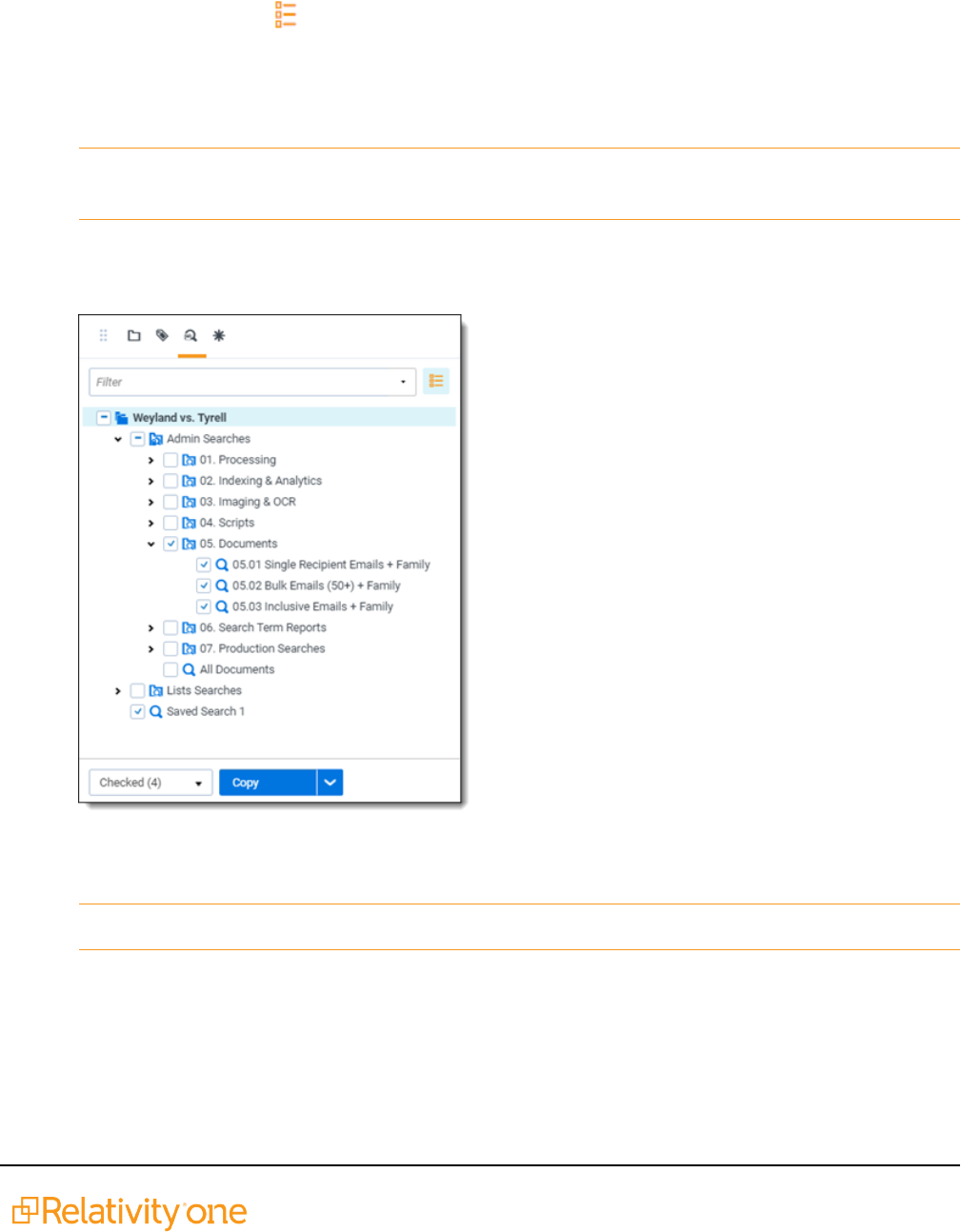
Searching Guide 122
n
Move
n
Export to file
To perform mass operations on saved searches in the saved search browser:
1.
Click the check boxes button to the right of the Filter text box to turn check boxes in the list of
searches on.
2. Select the checkbox for an individual search or select the checkbox for a search folder to select
searches inside that folder.
Note: You must expand the search folders before you can check the checkbox for the folder to
allow you to examine the searches you will perform a mass operation for.
The number of selected searches appears in the drop-down list to the left of the mass operations
multi-select button below. Alternatively, you can select All from the drop-down list to select all
searches.
3. Once you have selected the desired searches, choose the desired mass operation, copy, delete,
move, or export to file, from the mass operations multi-select button.
Note: When selecting the move option, sub-folders are not recreated in the destination folder.
4. A pop-up modal window appears, where you edit and confirm the details of the mass operation you
are performing.
5. Click Ok to complete the operation.

Searching Guide 123
11.3 Controlling the visibility of saved searches
On the saved search form, you can control the visibility of a search by setting the Owner option. New
searches are private by default, making them visible only to you and Relativity administrators. In addition to
owner access, users must have permissions to the Saved Searches Browser and at least view
permissions for Search on the security page. For more information on workspace permissions, see the
Admin Guide.
You can change the visibility of a search by selecting one of these options in the Owner drop-down menu:
n
Public—makes the search available to all users with the appropriate permissions.
Note: You can configure Relativity to make your saved searches public by default. When you cre-
ate a search, the Owner box will display Public. In My Settings, select Public in the option Default
Saved Search Owner.
n
User Name—select a specific user from the drop-down menu. The search will be visible only to that
user and Relativity administrators.
n
Me—click this button to reset the visibility on the search to private. Your name appears in the Owner
box.
You define the criteria used for saved searches in the Conditions section of the Saved Search form. You can
build complex queries using a combination of fields and operators that are set to required values. For
information about the operators available for building these queries, as well as specific options for searching
batches and developing combined searches, see Defining criteria for saved searches.
11.4 Organizing saved searches in folders
You can organize saved searches by adding them to securable folders that you create and manage in the
Saved Searches browser. To work with search folders, you must have the appropriate permissions for
Search Folder, Search, and the Saved Searches Browser on the security page. For more information on
workspace permissions, see the Admin Guide.
11.4.1 Adding sub-folders to the root
In the Search Folder Tree, right-click on the root folder to add sub-folders to the browser. Click Create to
add a new folder, and name it something descriptive of its contents. To update the folder name, right-click
on the folder, and click Rename.
11.4.2 Managing subfolders
Right-click on a folder under the root to display the following menu options:
n
Create—adds a subfolder to the highlighted folder.
n
Rename—makes the folder name editable. Enter new text for the name.
n
Secure—displays a security page so that you can override the security inherited from the workspace,
or parent folder. For more information on setting permissions on objects, see the Admin Guide.
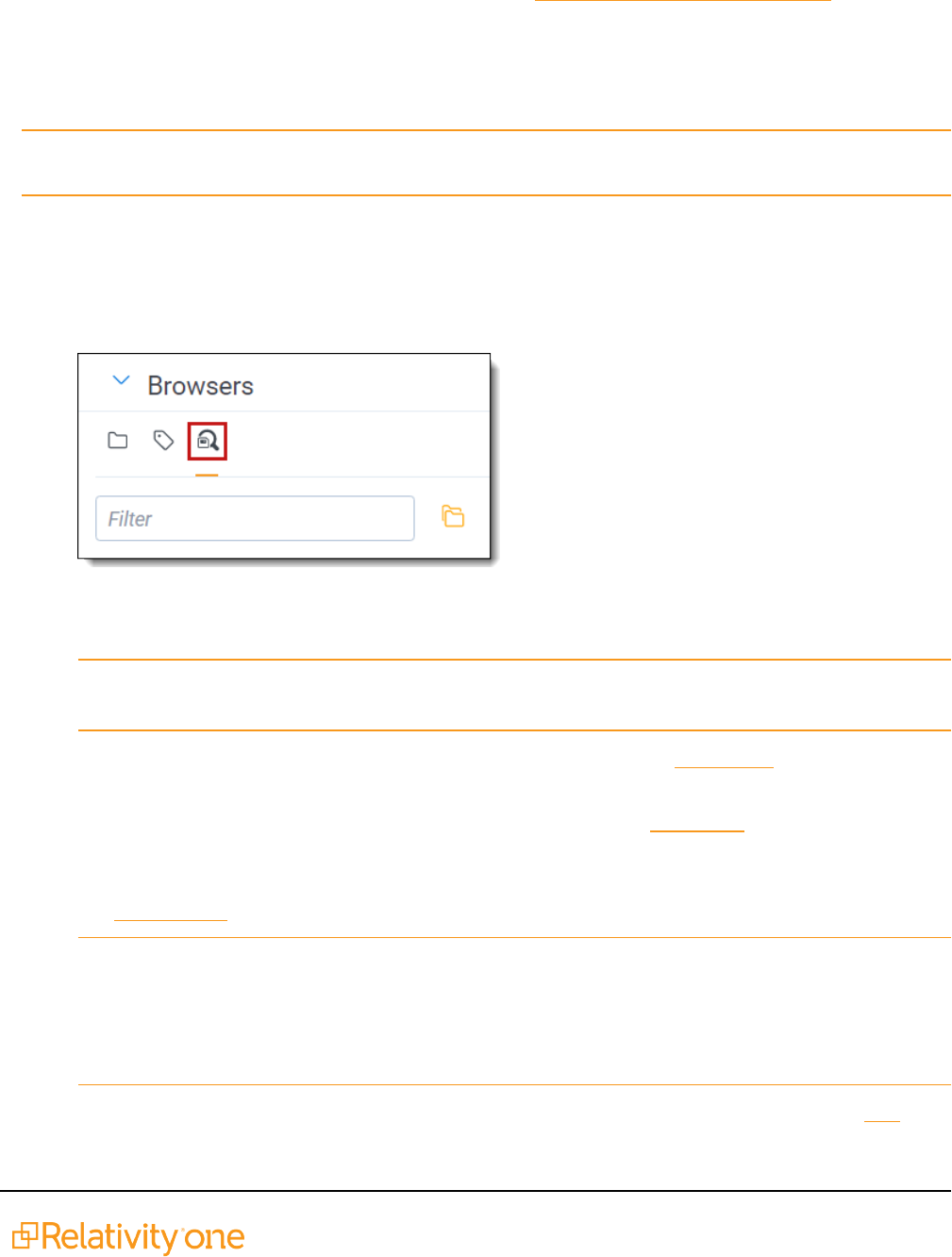
Searching Guide 124
n
Delete—permanently removes all the searches and subfolders that folder contains from the data-
base.
n
New Search—displays the Saved Search form. See Creating or editing a saved search.
11.4.3 Adding existing searches to folders
To add existing searches to a folder, left click the search and then drag and drop it into the folder. Click OK
on the confirmation message.
Note: When you move a search, it inherits the security from the parent folder. You may want to check the
security on a folder before moving a search into it.
11.5 Creating or editing a saved search
To create or edit a saved search from the Search browser, follow these steps:
1. From the Documents tab, click the Saved Search icon in the Browsers pane.
2. From the central pane, click Create New Search. To edit a search, right-click the search name, and
click Edit.
Note: If you do not see the Create New Search button, you may have another saved search selec-
ted. Click the top-level folder in the browser to deselect another search.
3. Complete the fields in the Information section. For more details, see Information.
4. From the Conditions tab, select Condition to add a new condition, or Logic Group to create a logic
group. Use logic groups to group conditions. For more details, see Conditions.
5. From the Fields tab, you can choose which fields you want displayed in your search results. You can
also select an existing view, then add all the fields from the view in a single click. For more details,
see Search fields.
Note: The Default Search View controls what fields are returned, by default, on an advanced or
saved search. You can always include additional fields from the advanced or saved search field
selector. This view also controls the field sort order. The Default Search View is only meant to con-
trol the default fields returned when running a saved search in Relativity. Since that is its purpose in
Relativity there is no way to make any changes or additions to the Conditions portion of this view.
6. Click the Sort tab, and then specify any sorting for the search results. For more details, see Sort.

Searching Guide 125
7. Click the Other tab to add additional information. See Other.
8. Click Save &Search, Search, Save, or Save As.
Note: Selecting Save As opens a pop-up modal to update the name of the saved search.
11.5.1 Search fields
11.5.1.1 Information
The Information fields are:
n
Name—enter a title for the search.
n
Owner—select an owner from the drop-down list or clickMe to make yourself the owner.
n
Dashboard—select an existing dashboard to link the saved search. For more information, see Link-
ing a dashboard to a saved search.
n
Requires Manual Rerun—select this option if you want to require users to rerun a saved search
when they return to it after navigating to other features in Relativity. Selecting this option only affects
the search that the current user is running. It does not affect any parent or nested searches tied to the
current search. If you have a search that has Requires Manual Rerun checked and you include it as
the criteria for another search, it will rerun.
Note: The Requires Manual Rerun option is for searches that might take a long time to run, and
you do not need them to run automatically when you navigate back to the saved searches. This
keeps you from having to manually cancel queries before you can navigate away from that search.
n
Scope—select one of these options to designate the document set for the search:
o
Entire Workspace—searches all documents within a workspace.
o
Selected Folders—select this option, and then click Select Folders. On the Select Folders
pop-up, select the checkboxes for the folders that you want to search. Clear the Include Sub-
folders checkbox on the pop-up if you do not want to include subfolders. Click Clear All to
remove all selections.
n
Notes—any notes you want to add to provide additional information about the search.
11.5.1.2 Advanced
The Advanced fields are:
n
Relativity Applications—add Relativity applications you want to associate with a saved search.
n
Keywords—any keywords you want to give additional information about the search.
n
Query Hint—used to optimize views. Only use the query hint if instructed by the Relativity Customer
Support team. Currently, you can use Hashjoin: (true/false) or Maxdop: (x) to populate the field. You
must remove query hints before using a saved search in a Relativity script.
11.5.1.3 Conditions
The Conditions fields define the criteria of the search. Click on a filter card to edit the condition or click the x
in the top right corner to remove the condition. The equation box along the top gives you a high-level view of

Searching Guide 126
the conditional statement you are creating. This tab has the following controls:
n
Add Condition—enter a field name into the Search fields text box, or select a field by scrolling
through the list.
Note: If there are previously created field categories, you can select a field category from the drop-
down list to conveniently filter the fields list. To learn more, visit Field Categories.
n
Index Search—select this to select a Keyword, dtSearch, or Analytics index, and then enter search
terms to apply as a search condition.
n
Saved Search—select this to select an existing Keyword, dtSearch, or Analytics saved search to
apply as a search condition.
n
<field name>—select an object field name to create a conditional expression for that field to apply to
the overall search criteria.
n
Add Logic Group—adds logic groups you can add conditions to by dragging and dropping the con-
ditions into the logic group frames. Use the ANDor ORoperator to join logic groups.
n
Includes drop-down—select an option for returning documents related to hit documents. Hit doc-
uments match the search criteria. The result set includes the related documents, but they do not need
to match the search criteria. Select No Related Items if you do not wish to include any of these doc-
uments.
o
Duplicates—use this setting if you want the result set to include documents with the same
MD5 Hash values as the hit documents. Relativity uses the MD5 Hash value as a unique file
identifier.
o
Family—use this setting if you want the result set to include documents with the same group
identifiers as the hit documents.
o
<Custom Field>—your organization may use custom related fields. Contact your system
admin for additional information.
11.5.1.4 Fields
The Fields tab displays the field columns you can add or remove from your search results.
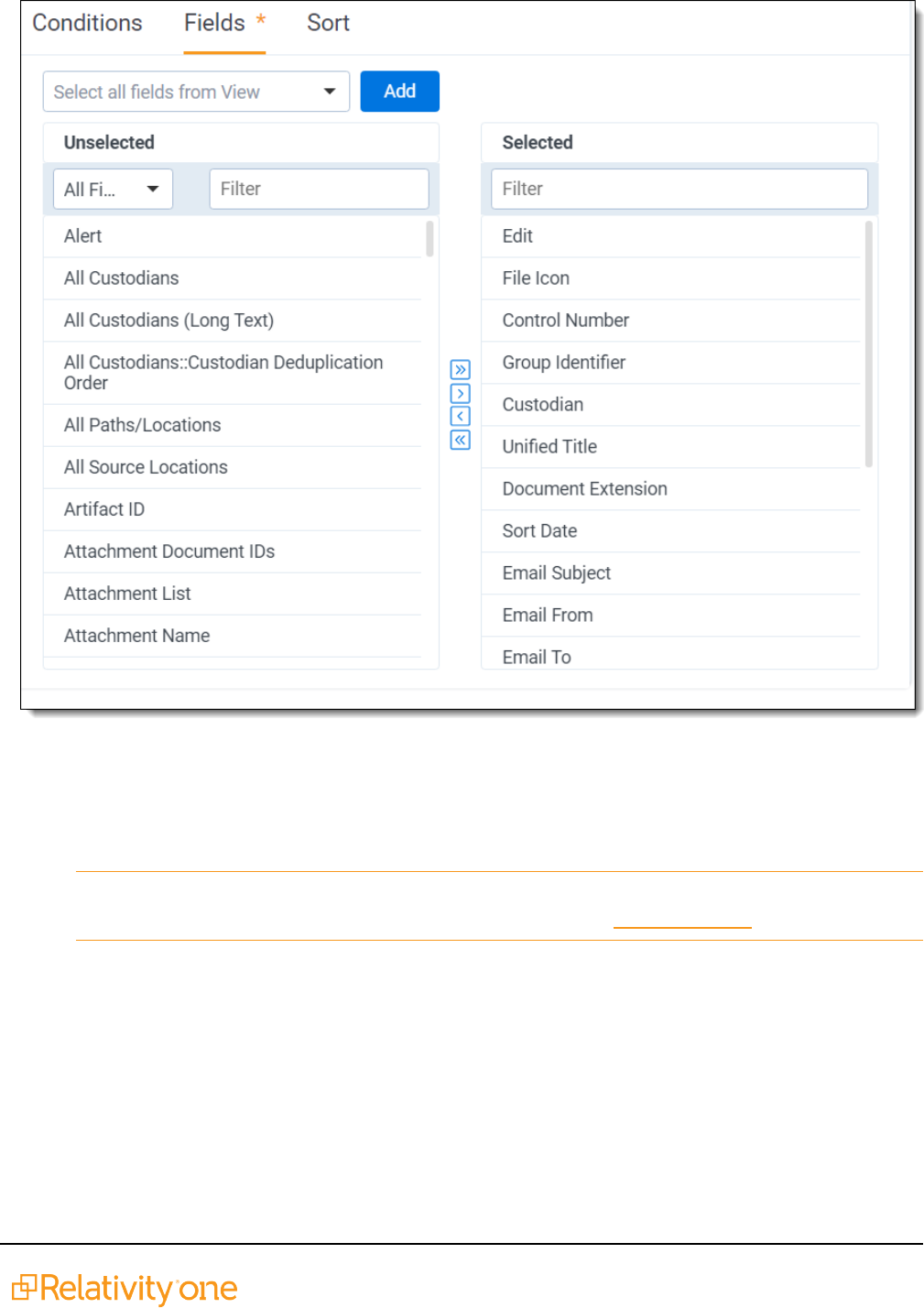
Searching Guide 127
There are two fields panes:
n
Unselected—fields you add to your search results. To add a field, click the name, then click the
Move selected left to right arrow in the center column. You can also click the Move all left to the
right arrow to display all available fields.
Note: If there are previously created field categories, you can select a field category from the drop-
down list to conveniently filter the fields list. To learn more, visit Field Categories.
n
Selected—fields selected that appear on the search results. To remove a field, click the name, then
click the Move selected right to left arrow in the center column. You can also click the Move all
right to left to remove all fields from the search results. The position of the fields in the box is how
they are ordered. You can drag and drop them to change their order.
Selecting all fields from an existing view
You can add all fields from an existing view by selecting the view from the Select all fields from View drop-
down menu, then clicking the Add button. The fields append below any fields already displayed in the
Selected pane. Use the move arrows to add additional fields or remove fields.

Searching Guide 128
11.5.1.5 Sort
The Sort options define the default sort order used for the search results. Each row in a sort criterion has the
following options:
n
Sort Field: select a field from the left drop-down box. The search sorts on the field you select.
n
Order: select ascending or descending from the right drop-down box.
11.5.2 Using pop-up pickers
You may have the option to select values from a pop-up picker when you choose certain fields or operators
in the Conditions section. For example, pop-ups are available when you select the following operators:
n
Any of these
n
None of these
n
All of these, only for multiple object fields
n
Not all of these, only for multiple object fields
See Creating or editing a saved search. For information about setting batch conditions, see Batch fields as
search conditions.
11.5.2.1 Select items pop-up picker
Use the following general steps to select items in the picker:
1. Navigate to the Saved Search form or use the Search Conditions feature.
2. Select a Field option for a condition.
3. Select one or more items in the Available Items list.
A check mark indicates that you selected the item.
4. Click Apply.
11.5.2.2 System user fields
System user fields include the System Created By and System Last Modified By fields, which you can use in
search conditions.
1. Navigate to the Save Search form or use the Search Conditions feature.
2. Select a system user field in the Field option for a condition.
3. Select an operator, and perform one of the following tasks:
n
If you selected any of these or none of these, select from the Available fields and move to
the Selected fields column, then click Apply.
n
Enter the username in the text box.
4. Define any extra search criteria as needed.
11.5.2.3 Folder name field
You can select Folder Name as a field in a search condition to create more flexible queries than using the
Scope section of the Saved Search form. You can combine conditions containing the Folder Name and
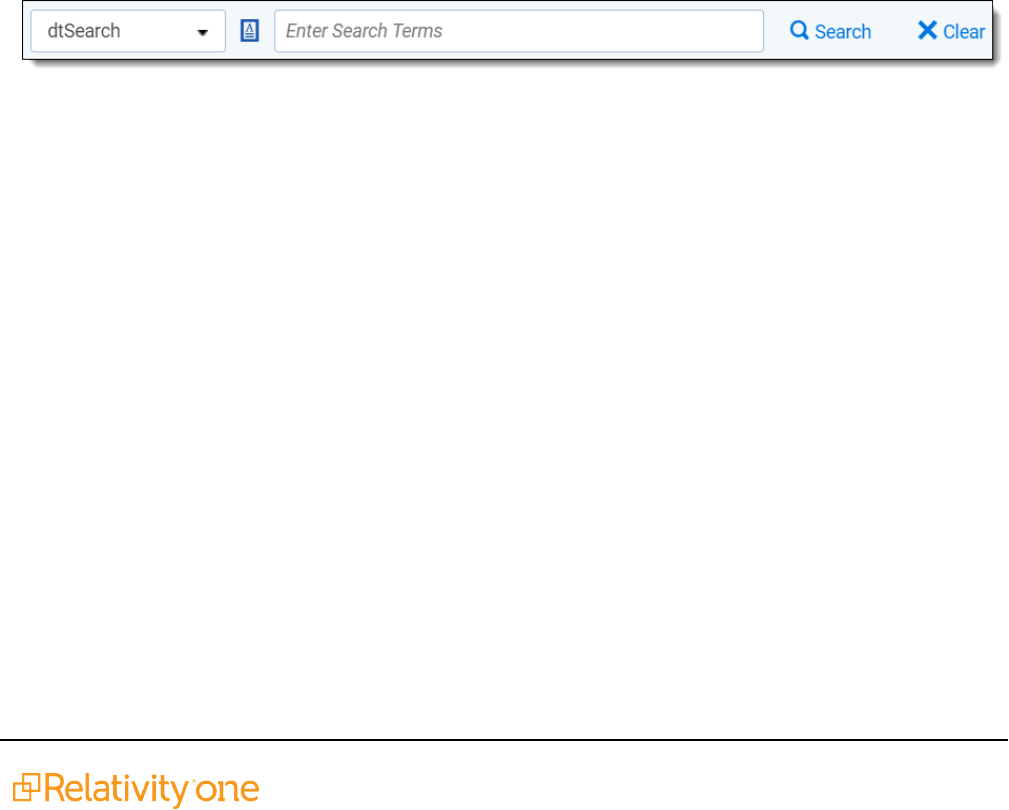
Searching Guide 129
other fields with AND or ORoperators refining your search criteria.
1. Navigate to the Save Search form or use the Search Conditions feature.
2. Select Folder Name in the Field option for a condition.
3. Select an operator, and perform one of the following tasks:
n
If you selected any of these or none of these, select the checkbox next to one or more item,
then Apply.
n
If you selected another operation, enter the folder name in the text box.
4. Define any additional search criteria as needed.
11.5.3 Using the Search Bar
The Search Bar, a UI controlled feature, exists along the top of item lists that support index search. This
replicates the functionality of the Index Search condition in the Search Panel, including keyword search and
dtSearch.
To run the index search,
1. Enter your search terms in the search bar.
2. Click Search, or hit Enter on your keyboard.
3. Click Enter + Shift to add more than one search term on separate lines.
The Search Bar reflects the condition panel state after toggling index search conditions.
11.5.3.1 Recent Searches
You can use the Search Bar to generate highlights within a document in the Viewer.
To view Recent Searches within a document:
1. Navigate to Documents.
2. Select the desired index from the Keyword Search drop-down list.
3. Enter the desired search terms in the field to the right of the drop-list and click Enter on your key-
board.
Keyword, proximity, fuzzy, and stemming searches can work depending on which type of search
index you chose.
The list displays documents that match your search criteria.
4. Click the desired document to open it in the Viewer.
Highlighted terms match the entered criteria, along with any enabled Persistent Highlight Sets.
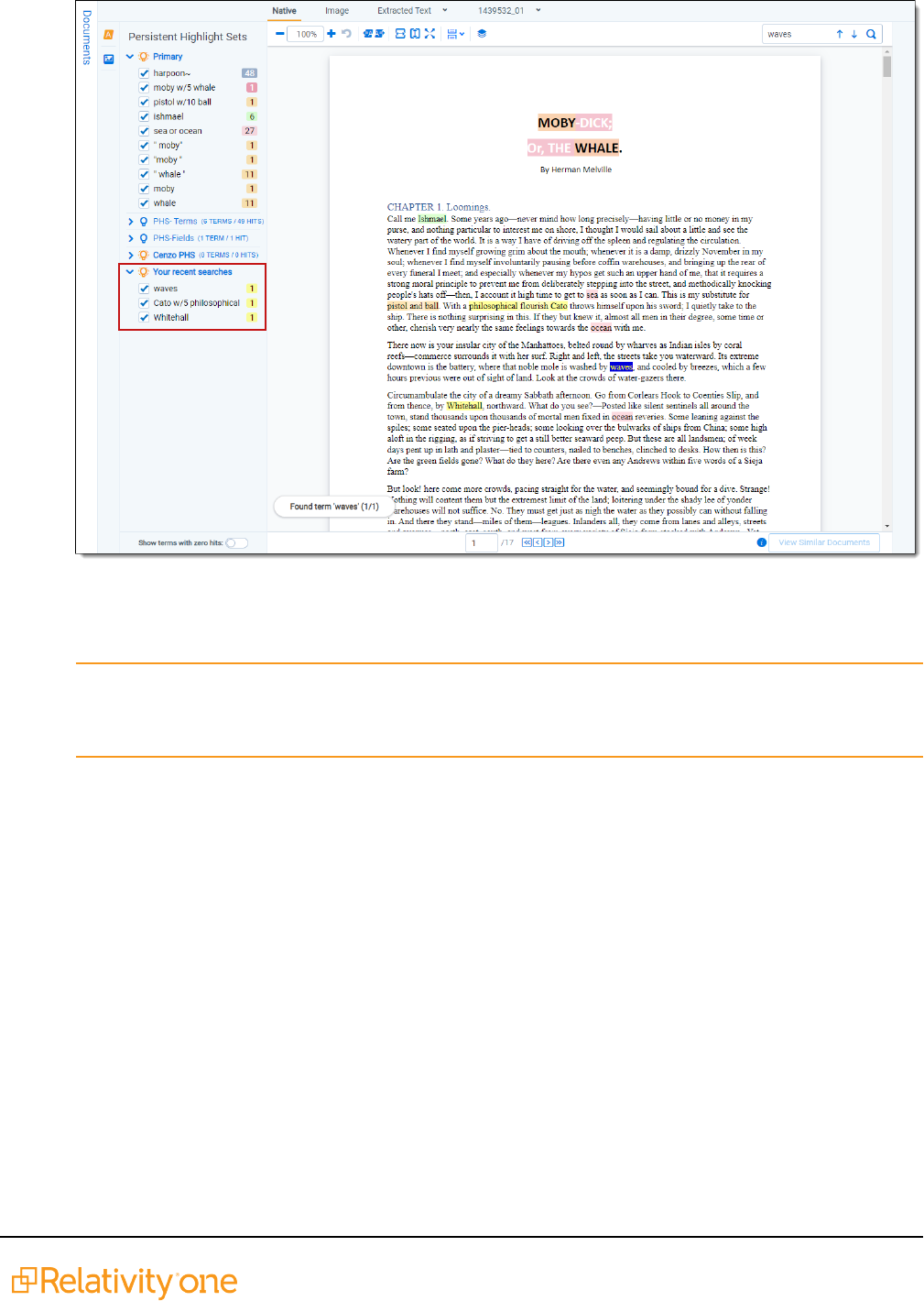
Searching Guide 130
5. Optionally, click theShow/Hide Persistent Highlight pane to display the Recent Searches and Per-
sistent Highlight Sets. Click the show/hide icon, light bulb icon, to toggle the Recent Searches or Per-
sistent Highlight Sets.
Note: Recent Searches only apply when using the Search Bar or when running a saved search
against a keyword index. Recent Searches do not apply when running a saved search against a
dtSearch index.
11.5.4 Linking a Relativity application to a saved search
To link a Relativity application to a saved search:
1. Navigate to the Search Browser.
2. Create a new search or edit an existing search.
3. Click Add in the Advanced tab to display the Select Items - Relativity Applications modal. Available
applications are in the left box and Selected applications are in the right box.
4. Choose one or more applications. Use the arrows to move the applications from the available to selec-
ted boxes.
5. >Click Set.
You can clear your options by clicking the clear button.
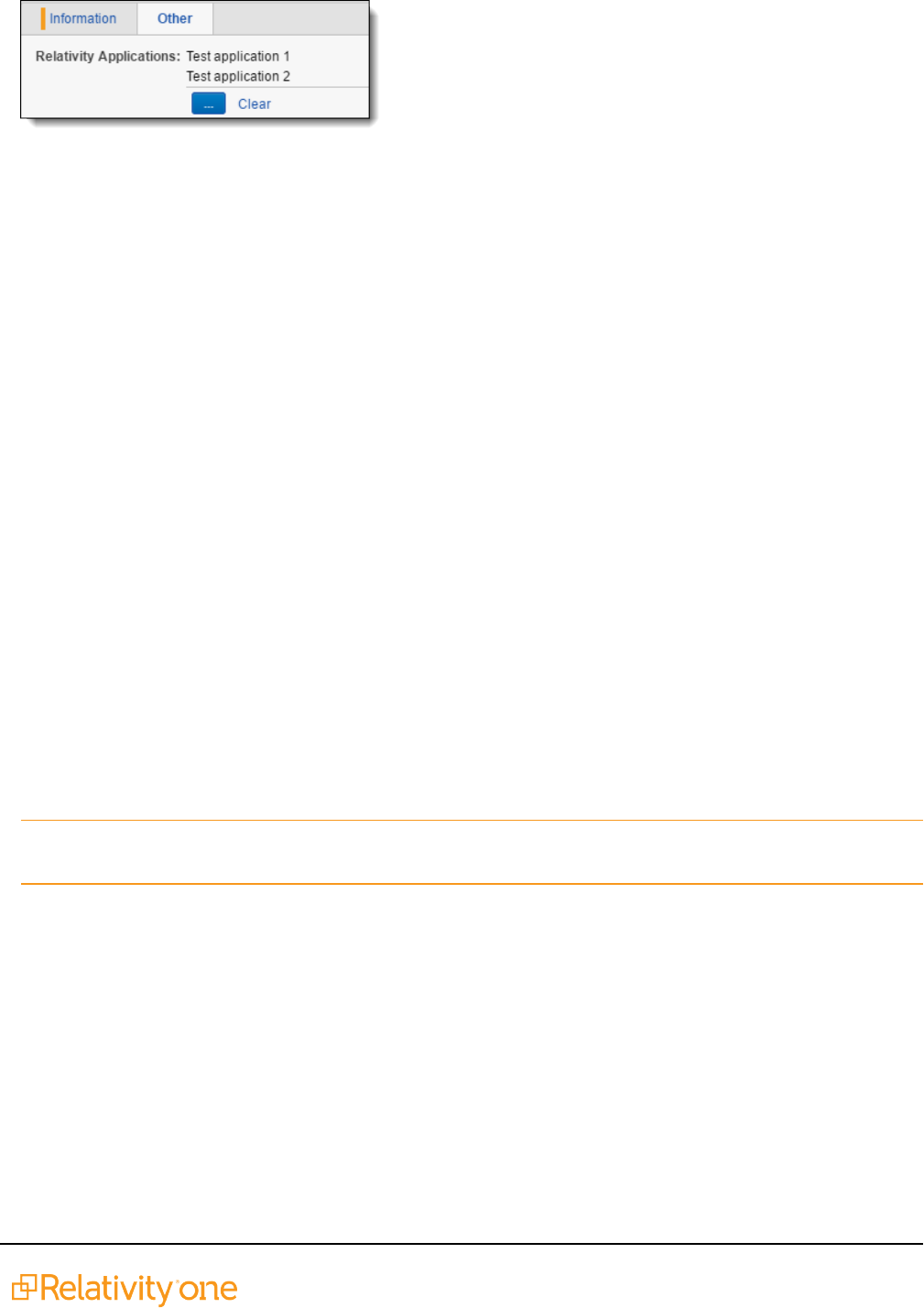
Searching Guide 131
To unlink a Relativity Application from a saved search, click Add and use the arrows to remove the
application(s). Please note that you cannot leave the selected applications box empty. A warning in red
appears along the bottom that reads: Selection cannot be empty. Either leave at least one application linked
or clear all using the clear button.
11.5.5 Linking a dashboard to a saved search
To link a dashboard to a saved search:
1. Navigate to the Search Browser.
2. Create a new search or edit an existing search.
3. Choose a dashboard from the drop-down list.
4. Click Save &Search, Search, Save, or Save As.
If you switch to a different dashboard while viewing the saved search, the link breaks. There are two ways to
restore this link:
n
Log out of your environment, then log back in.
n
Edit the search and hit Save and Search again.
If you delete a dashboard, Relativity removes the link in the saved search.
If you delete a dashboard with dependencies, a message appears with a list of dependencies.
11.5.6 Rerunning out-of-date saved searches
You may need to rerun a saved search when you return to it after navigating to other features in Relativity.
Instead of seeing your search results, you see a message indicating that your search is out of date.
Note: To enable the Run saved search feature, select the Requires Manual Rerun option in the
Information section of the Saved Search form.
Perform one of these tasks:
n
Click Run saved search to reload your search results. You can also click on the saved search in the
browser to rerun the search.
n
Click Edit Search to display the Saved Search form where you modify the search settings.
If you edit an item returned in your saved search, you need to rerun it. You must rerun the search even when
the edited item still meets the search criteria, and the number of documents returned does not change.
11.5.7 Required security permissions
A user must have the following security permissions to view, edit, and add saved searches and saved
search folders:

Searching Guide 132
Tab/Permission Permission Description
Object Security/Search View, Edit, Add Users can view saved searches, edit existing
saved searches, and add new saved
searches.
Object Security/Search Con-
tainer
Edit, Add Users can edit existing saved search folders
and add new saved search folders.
Other Settings/Browsers Advanced & Saved
Searches
Users can see and interact with the Saved
Searches browser.
For more information, see the guide on Setting workspace permissions.
11.6 Defining criteria for saved searches
You define the criteria used for saved searches in the Conditions section of the saved search form. You can
build complex queries using a combination of fields and operators that are set to required values. This
section provides information about the operators available for building these queries, as well as specific
options for searching batches and developing combined searches. For information about building queries,
see Creating or editing a saved search on page124.
11.6.1 Operators
When defining search criteria in the Conditions section of a saved search form, you use operators to
determine how a field is queried for the value that you selected or entered. The operators available for a
search criterion depend upon the field type:
n
Fixed-length, long, or extracted text operators below
n
Whole number, decimal, and currency operators on page135
n
User operators on page135
n
Date operators on page135
n
Yes or no operators on page136
n
Single and multiple choice field operators on page136
11.6.1.1 Fixed-length, long, or extracted text operators
The following operators are available for fixed-length, long, and extracted text field types.
Operator Returns Documents Where...
Begins with The field begins with the entered term.
Does not
begin with
The field does not begin with the entered term.
Ends with The field ends with the entered term.
Does not
end with
The field does not begin with the entered term.
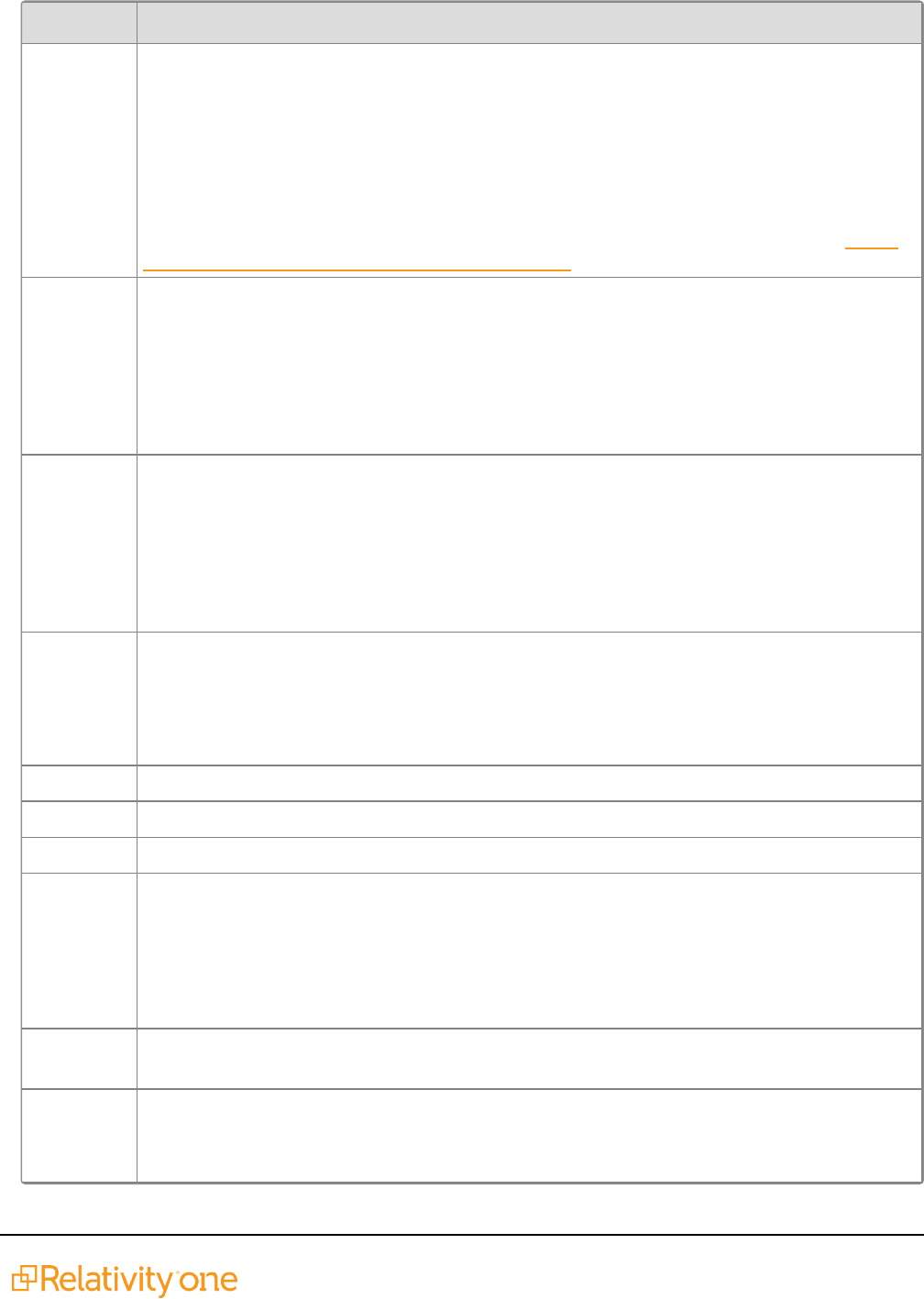
Searching Guide 133
Operator Returns Documents Where...
Is like
The field contains the entered term. Blank values are filtered out, and search values can be
enclosed in double quotation marks. A partial match does not require a wildcard (*).
Relativity returns an OR operator between terms when a condition uses the "Is like"
operator, and the terms are separated by a carriage return into multiple lines, or they are
separated by a comma within a single line. For example, Relativity interprets a query as
"Field is like Term 1 or Field is like Term 2 or Field is like Term 3".
Note:For performance reasons, Relativity recommends using the "Contains" operator
rather than building queries with single or multiple uses of the "Is like" operator. See FAQs
for Contains and Is Like operators on the next page.
Is not like
The field does not contain the entered term. Wildcards (*) are already applied at the
beginning and end of a term with this operator. The comments about the "Is like" operator
also apply to "Is not like".
Relativity returns an OR operator between terms when a condition uses the "Is not like"
operator, and the terms are separated by a carriage return into multiple lines, or they are
separated by a comma within a single line. For example, Relativity interprets a query as
"Field is not like Term 1 or Field is not like Term 2 or Field is not like Term 3".
Is
The field value equals any of the entered items. Multiple values can be separated by a
comma or carriage return. Blank values are filtered out, and search values can be enclosed
in double quotation marks.
Relativity returns an OR operator between terms when a condition uses the "Is" operator,
and the terms are separated by a carriage return into multiple lines, or they are separated by
a comma within a single line. For example, Relativity interprets a query as "Field is Term 1 or
Field is Term 2 or Field is Term 3".
Is not
The field value does not equal the entered term.
Relativity returns an OR operator between terms when a condition uses the "Is not"
operator, and the terms are separated by a carriage return into multiple lines, or they are
separated by a comma within a single line. For example, Relativity interprets a query as
"Field is not Term 1 or Field is not Term 2 or Field is not Term 3".
Is set The field is not empty.
Is not set The field is empty.
Is less than The field value is less than the entered term.
Is less than
or equal to
The field value is less than or equal to the entered term.
Relativity returns an OR operator between terms when a condition uses the "Is less than or
equal to" operator, and the terms are separated by a carriage return into multiple lines, or
they are separated by a comma within a single line. For example, Relativity interprets a
query as "Field is less than or equal to Term 1 or Field is less than or equal to Term 2 or Field
is less than or equal to Term 3".
Is greater
than
The field value is greater than the entered term.
Is greater
than or
equal to
The field value is greater than or equal to the entered term.
Relativity returns an OR operator between terms when a condition uses the "Is greater than
or equal to" operator, and the terms are separated by a carriage return into multiple lines, or
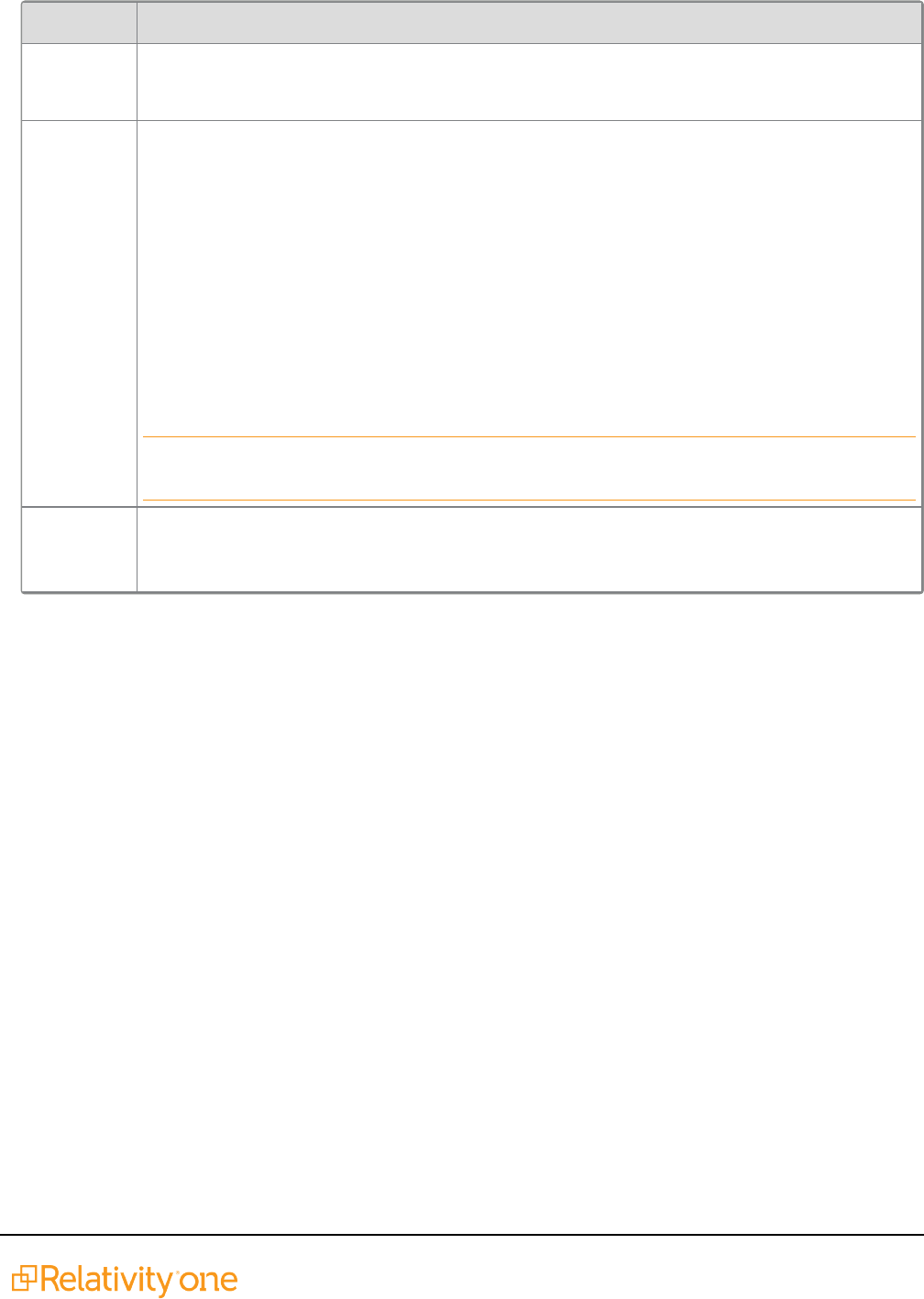
Searching Guide 134
Operator Returns Documents Where...
they are separated by a comma within a single line. For example, Relativity interprets a
query as "Field is greater than or equal to Term 1 or Field is greater than or equal to Term 2
or Field is greater than or equal to Term 3".
Contains The field includes the entered term. This operator is available for long text and fixed length
text fields included in the full text index. Blank values are filtered out, and search values can
be enclosed in double quotation marks. You can also use the AND/OR operators, and add
wildcards (*) to the end of the search.Relativity returns an OR operator between terms when
a condition uses the "Contains" operator, and the terms are separated by a comma. (You
can also use the OR operator to separate search terms.) For example, Relativity interprets
these queries as "Field contains Term 1 or Field contains Term 2 or Field contains Term 3",
and "Field contains Term 1 or Term 2 or Term 3" respectively. Relativity returns an AND
operator between terms when a condition uses the "Contains" operator, and the terms are
separated by a carriage return into multiple lines, or if terms are separated by a space on a
single line so "Field contains Term 1 Term 2 Term 3" is interpreted as "Field contains Term 1
AND Term 2 AND Term 3".
Note: The “Contains” operator works identically to keyword search, except that it
searches that specific field.
Does not
contain
The field does not contain the entered term. This operator is available for long text and fixed
length text fields included in the full text index. Blank values are filtered out, and search val-
ues can be enclosed in double quotation marks.
FAQs for Contains and Is Like operators
You can improve your searches by understanding the differences between the "Contains" and "Is like"
operators.
Why do searches using the "Is like" operator tend to run slowly?
The "Is like" operator can slow the performance of your system because it queries every document for the
field specified in the condition. For performance reasons, we don't recommend building queries with single
or multiple uses of the "Is like" operator. Instead, you can use the "Contains" operator, which improves
performance by querying only the fields in the full-text index.
Are there any special requirements for using the "Contains" operator?
Yes, the full text-index must include the field that you want to search with the "Contains" operator.
How does query execution differ for searches with the "Contains" and "Is like" operators?
The "Contains" operator queries the SQL full text catalog, while the "Is like" operator queries the database
table inside the catalog. The "Is like" operator prevents other queries from editing the table until it completes,
which can negatively affect performance.
Why are different search results returned by queries using the "Contains" versus "Is like" operators?
The difference in result sets is caused by the way SQL interprets queries using these operators. An "Is like"
statement appends a wildcard to the front of each query, which sometimes causes it to return more items
than a query with the "Contains" operator. You must evaluate these additional items to determine if they're
actually part of your expected result set or if they represent false hits for the items that you want to return.
Is there any way to enhance the performance of queries using the "Is like" operator?
Yes, you can make queries that use the "Is like" operator more efficient by creating a SQL index on the table
column referenced by the query. The query can point to this index, and avoid accessing the table. For more
information, contact your system admin.
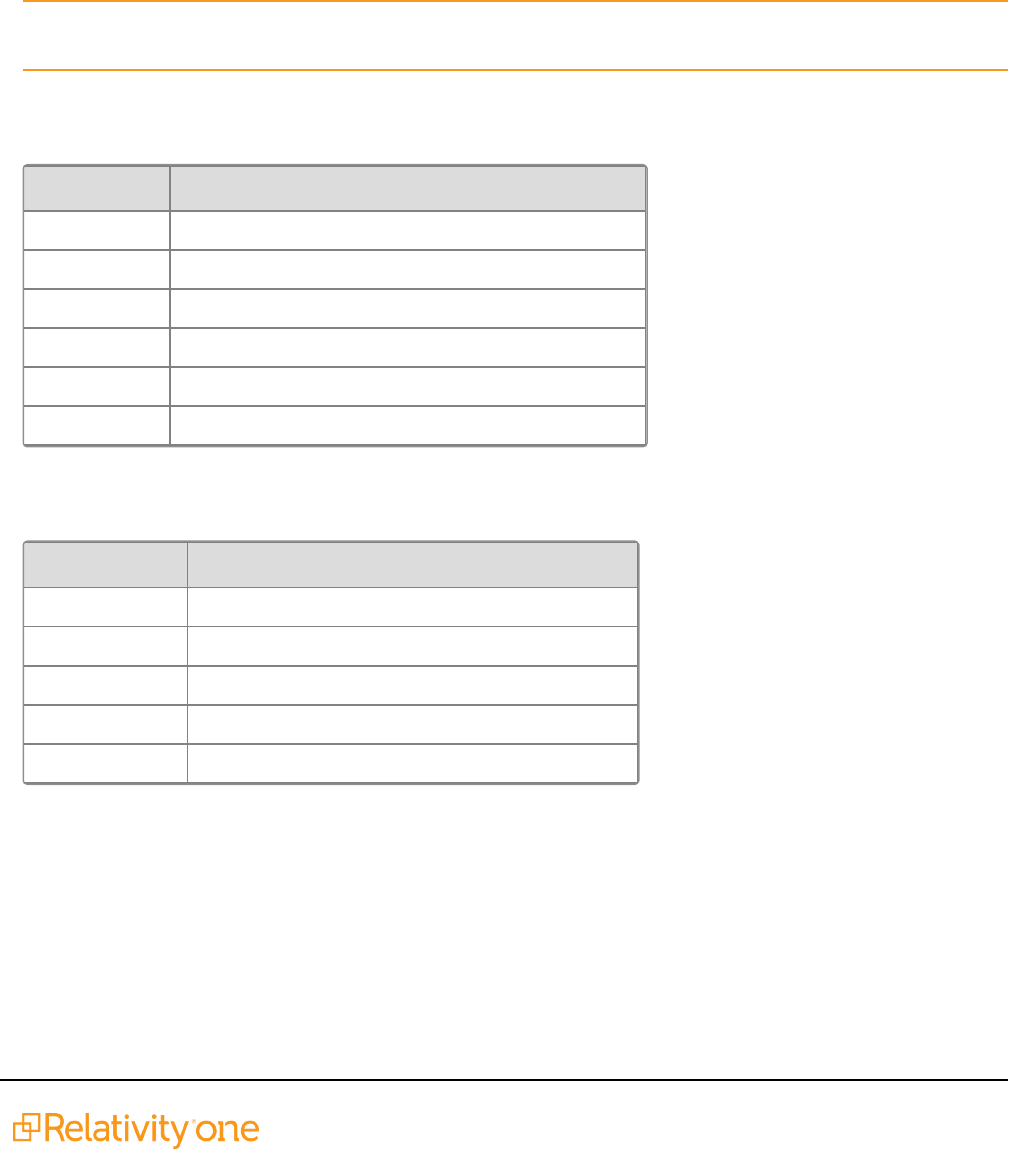
Searching Guide 135
How can I use the "Contains" operator to facilitate document reviews?
You can use the "Contains" operator to search fields in email headers for email addresses and other
pertinent header information. To perform these searches, the Author, TO, CC, and BCC fields in email
headers must be added to the full text index.
Special considerations for Data Grid-enabled fields
You can use only these operators to search Data Grid-enabled text fields:
n
is set
n
is not set
Note: ISSETcondition operator excludes the Data Grid records where the field is null or has an empty
string value.
11.6.1.2 Whole number, decimal, and currency operators
The following operators are available for whole number, decimal, and currency field types.
Operator Returns Documents Where...
Is The entered number is equal to the field value.
Is not The entered number is not equal to the field value.
Is set The field is not empty.
Is not set The field is empty.
Is less than The field value is less than the entered number.
Is greater than The field value is greater than the entered number.
11.6.1.3 User operators
The following operators are available for user field types.
Operator Returns Documents Where...
Is logged in user The logged in user is equal to the field value.
Any of these Any of the selected users match the field value.
None of these The selected users do not match the field value.
Is set The field is not empty.
Is not set The field is empty.
11.6.1.4 Date operators
The following operators are available for date field types.
You can search on date and time but time is not displayed by default when you select a date on the calendar
pop-up. For example, you can search on 10/16/2001 3:57 PM by typing in the time after your selected the
date. You can also search for 2/3/10 between 4/3/10 and both 2/3/10 and 4/3/10 return in the results.
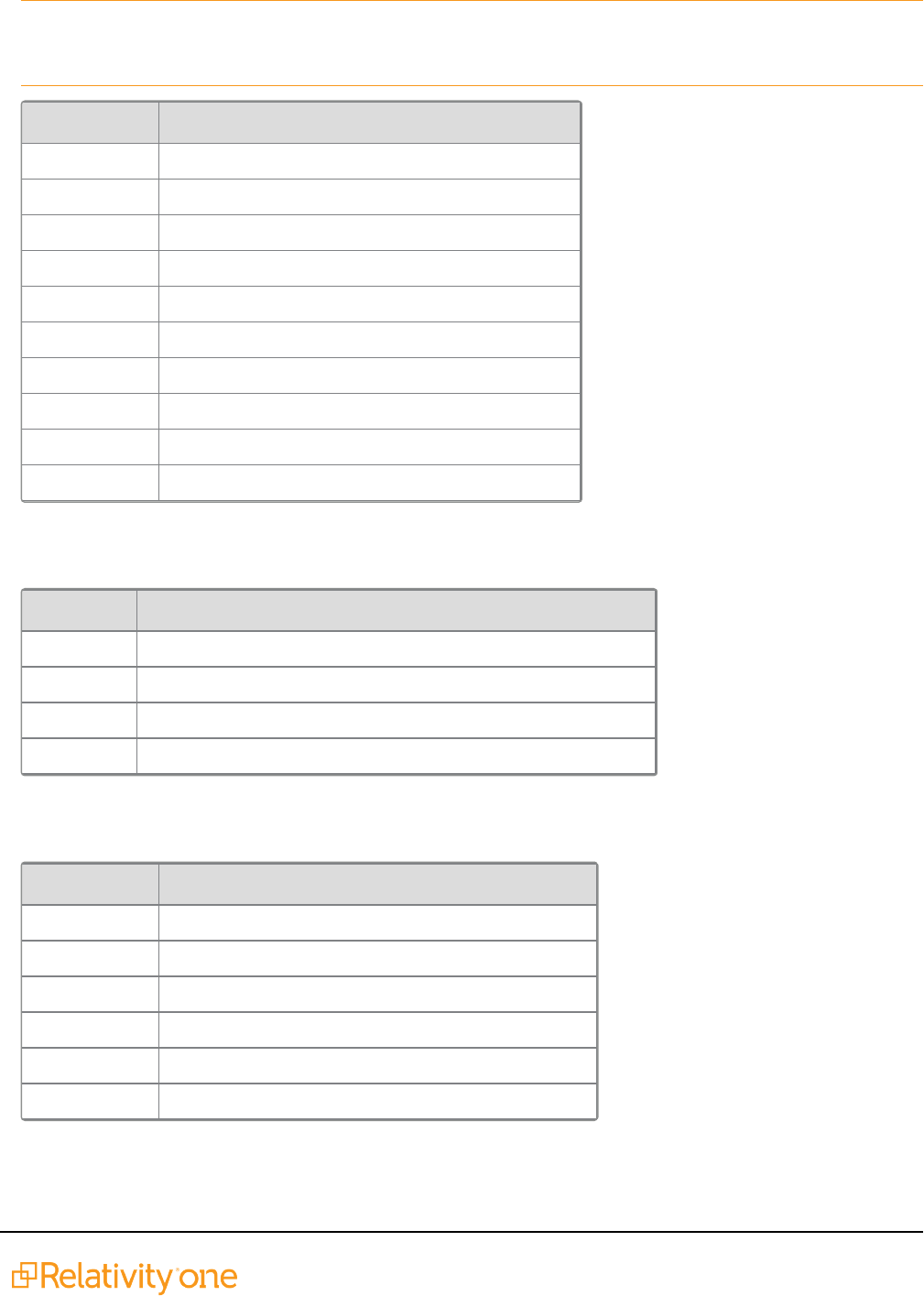
Searching Guide 136
Note: When you search on a user-created date field using a relative date, Last 7 Days for example, you
may see different results between a saved search and a search from the search panel if you are not in the
same timezone as your Relativity instance.
Operator Returns Documents Where...
Is The entered date is equal to the field value.
Is not The entered date is not equal to the field value.
Is set The field is not empty.
Is not set The field is empty.
Is before The field value is before the entered date.
Is before or on The field value is before or on the entered date.
Is after The field value is after the entered date.
Is after or on The field value is on or after the entered date.
Between The field value is between the two entered dates.
Is in The field value is within the selected range.
11.6.1.5 Yes or no operators
The following operators are available for Yes/No field types.
Operator Returns Documents Where...
Is The selected value (Yes or No) is equal to the field value.
Is not The selected value (Yes or No) is not equal to the field value.
Is set The field is not empty.
Is not set The field is empty.
11.6.1.6 Single and multiple choice field operators
The following operators are available for single and multiple choice field types.
Operator Returns Documents Where...
Any of these Any of the selected choices are present in the field.
None of these None of the selected choices is present in the field.
All of these All of the selected choices are present in the field.
Not all of these The selected choices are not present in the field.
Is set The field is not empty.
Is not set The field is empty.
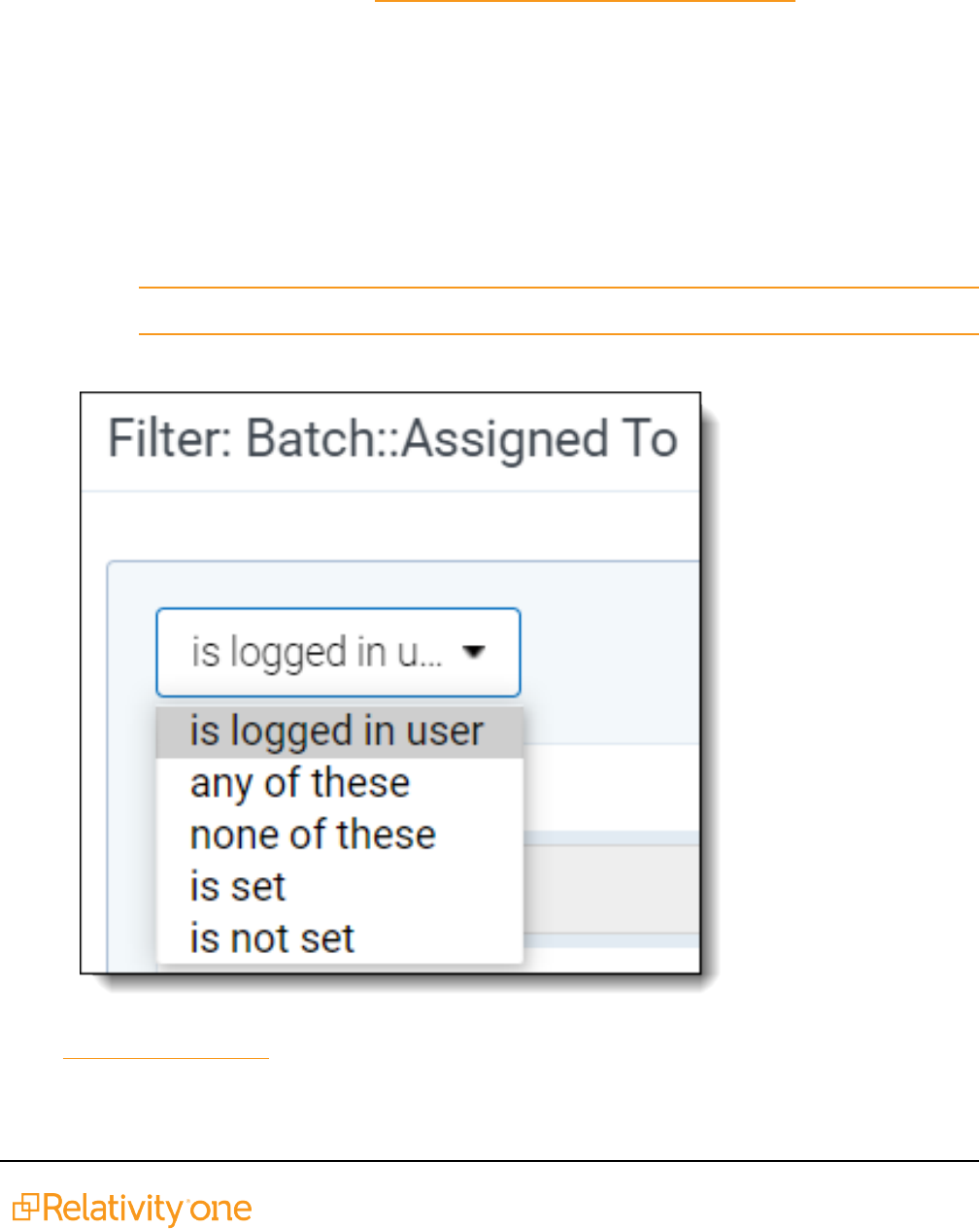
Searching Guide 137
11.6.2 Batch fields as search conditions
Relativity includes several fields related to batching that you can use as conditions for searching across
batch sets. To use batch fields as search conditions, follow these steps:
1. Create a new saved search. See Creating or editing a saved search on page124.
2. Select Batch in the Fields drop-down menu in the Conditions section of the saved search form.
3. Choose the operator you want to use.
4. Click Add Condition to display a modal.
5. Select one of the following batch related fields:
n
Batch
n
Batch::Batch Set
n
Batch::Assigned To
Note: You can use the Assigned To field to search for batches set to a specific user.
n
Batch::Status
See Operators on page132 for more information.

Searching Guide 138
11.6.3 Using saved searches as conditions (combined searches)
You can combine searches by selecting previously created saved searches as Field conditions. To use a
saved search as a search condition, follow these steps:
1. Create a new saved search. See Creating or editing a saved search on page124.
2. Select (Saved Search) from the top of this list in the Field drop-down menu in the Conditions section
of the saved search form.
3. Select an option in the Operator drop-down menu.
4. Click Add Condition to display a modal.
5. Select a saved search and click OK.
11.6.3.1 Preventing circular references
Relativity prevents you from creating recursive searches when you combine multiple searches as conditions
in a query. For example, you might create a combined search using Saved Searches 1, 2, and 3 as follows:
n
Saved Search 2 uses Saved Search 1 as a Field condition.
n
Saved Search 3 uses Saved Search 2 as a Field condition.
When you edit Saved Search 1, you can't select Saved Search 2 or Saved Search 3 as Field conditions.
Relativity prevents you from creating a circular reference by not listing these searches in the Value pop-up
window.
11.6.3.2 Including related items in combined searches
You can combine saved searches to check for conflicts within related item groups. For example, a review
manager may use a combined search for quality control when preparing to produce responsive documents
for a case.
Use the following steps to confirm that a search for responsive documents does not include any privileged
documents.
1. Create a saved search called Responsive Check that uses the Includes Family option and sets a
condition on a field, such as Designation to Responsive.
This search specifies production criteria that return only responsive documents.
2. Create a second saved search called Privilege Check that uses the Includes Family option and sets
a condition on a field, such as Privilege Description to Privileged, Attorney Client, and so on.
This search is used for evaluation purposes.
3. Create a combined search called Conflict Check that uses the Includes Family option and sets con-
ditions for the Responsive Check and Privilege Check searches.
This quality control search determines if any privileged documents are included in the production-eli-
gible saved search.
11.6.4 Lists as search conditions
If you've created saved lists using the Lists feature, you can add lists as criteria in a saved search.
Follow these steps to create a new saved search using a saved list of documents as the search criteria:

Searching Guide 139
1.
On the Documents tab, click to open the Saved Searches browser.
2. Click Create New Search.
3. Type a name for the saved search in the Name field.
4. Add a condition with the following column settings:
n
Field—select Lists.
n
Operator—select these conditions.
n
Value—select the following value criteria:
o
Field—select Lists.
o
Operator—select any of these.
o
Value—select one or more saved lists to include in the search criteria.
5. In the Fields category, select the fields you want to include when viewing your saved search results.
Select the Lists field to show the list(s) with which an object is associated.
6. Click Save to save the search. Or, click Save &Search to save and execute the search.
11.7 Saving searches on the Documents tab
On the Documents tab, you can click Save Search at the bottom of the screen near the mass operations.
This creates a new search using the criteria that you've already set on the search panel. You can save
conditional searches, keyword searches, dtSearches, or Analytics searches. Relativity also retrieves any
settings that you selected for a view, sort order, or other features that control how your results appear.
Note: To use Save Search , you must have add permissions for Search, and access to the Saved
Searches Browser. For more information on workspace conditions, see the Admin guide.
To create a saved search on the Documents tab:
1. Navigate to the Documents tab.
2. (Optional) In the Browser menu, select the Folders, Field Tree, or Clusters option.
The item list for the selected browser displays.
3. Filter on the documents in the list or select a keyword or other search option. To set search criteria,
see the specific instructions for running keyword searches, dtSearches, Analytics, or filters. Your
search results appear in the item list on the Documents tab.
Note: Any folder, tag, or cluster selected in the browser is included as a condition when the search
is saved. The current columns, column filters, and sort order save along with any conditions set for
your view (including your selection in the Related Documents drop-down menu).
4.
Click .
The search builder window appears.

Searching Guide 140
5. Select or enter the following required information:
n
Name—enter a title for the search. The title appears in the saved searches browser.
n
Owner—select Public to make the search available to all users or choose a specific user from
the list. Click Me to select your name from the list, making the search private. (Users must have
the appropriate privileges to view searches.) See Controlling the visibility of saved searches on
page123.
n
Search Folder —click the Ellipsis button to launch a pop-up window where you can
save the new search to a specific folder on the saved searches browser. Highlight the folder
where you want to save the search, and then click OK to select it.
6. Add to or modify the search criteria as needed. See Creating or editing a saved search in the new UI
framework.
7. Click Save.
After you save your search, it appears in the saved searches browser. You can modify the search using the
same options available for saved searches. See Creating or editing a saved search in the new UI
framework. Click to display the saved search browser. To update the search, follow the same steps
as those used to edit a saved search. Right-click on the search in the saved searches browser, and then
click Edit. The saved search form pre-populates with information used in your search.
11.8 Common Saved Searches application
This topic describes how to install and use the Common Saved Searches application, which contains a
group of searches that can assist you in your basic usage of Relativity.
11.8.1 Installing the application
The installation process follows the same steps used to install other Relativity applications.For more
information, see Installing applications.
You must have system admin permissions to install an application. See Workspace security.
To install the application:
1. Log into the Relativity Community and search inFiles for the Common Saved Searches Solutions
application rap file.
Note: You must have valid Relativity Community credentials in order to download any Community file
linked to the documentation site. You'll need to enter those credentials on the Community login screen if
you're not already logged in. If you're already logged in to the Community at the time you click a link, the
file is automatically downloaded in the bottom left corner of your screen. If you get an error message
stating "URL No Longer Exists" after clicking a Community link, it may be due to a single sign-on error
related to the SAML Assertion Validator, and you should contact your IT department.
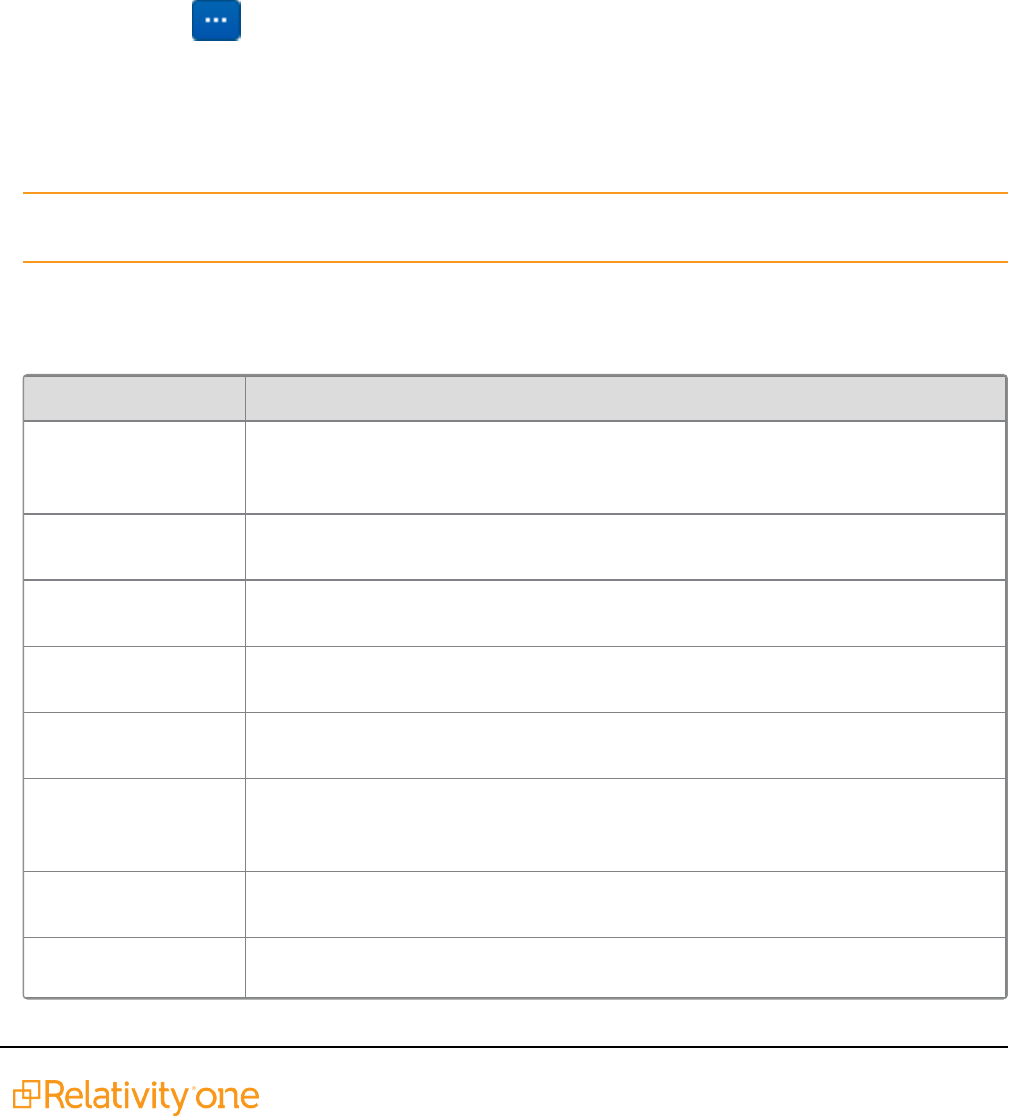
Searching Guide 141
2. Click Download.
3. Add the application to the Application Library:
1. On the Applications & Scripts tab, click the Application Library tab.
2. Click Upload Application.
3. Click Choose File, navigate to and select the Common Saved Searches Application rap file,
and then click Open.
4. Click Save.
5. Click Install in the Workspaces Installed section to install the application on workspaces.
6.
Click in the Workspaces field to display the Select Workspaces dialog.
7. Select a workspaces to install the application, and then click Ok.
8. (Optional) Click Clear to remove a workspace from the list.
9. Click Save to install the application to the selected workspaces.
Note: There may be a need to map fields if you have a template already created with the same common
fields. For more information, See Mapping fields section in the Installing applications documentation.
11.8.2 Using the application
The table below lists the search name and the description of why this search is used and/or what it returns.
Search Name Description
All Documents
A quick, easy way to return all documents in the workspace. This is useful for
many reasons, including building Search Term Reports and is a method to quickly
grab everything.
01.01 Processing
Errors
Returns all documents in document table that have an error from processing. Use
this to find items that might provide reviewers issues.
02.01 dtSearch Returns all documents, but more importantly, returns only the extracted text field.
Use to build a dtSearch index.
02.02 Structured Ana-
lytics Set
Used to check for documents with text and is used for any of the structured ana-
lytics sets.
02.03 Email Threading
- ParentEmails
Search for emails, but only parent level items, not attachment emails. Previously
used for email threading. Items used for threading.
02.04 Near Duplicate
Analysis (No Parent
Emails)
Returns all files that are identified for near duplication analysis, but are not parent
emails.
02.05 Language ID or
Repeated Content
Records with text to be used for Language ID or Repeated content similar to Struc-
tured set.
02.06 Analytics Not
Included
Returns items not included in Analytics because of text size.
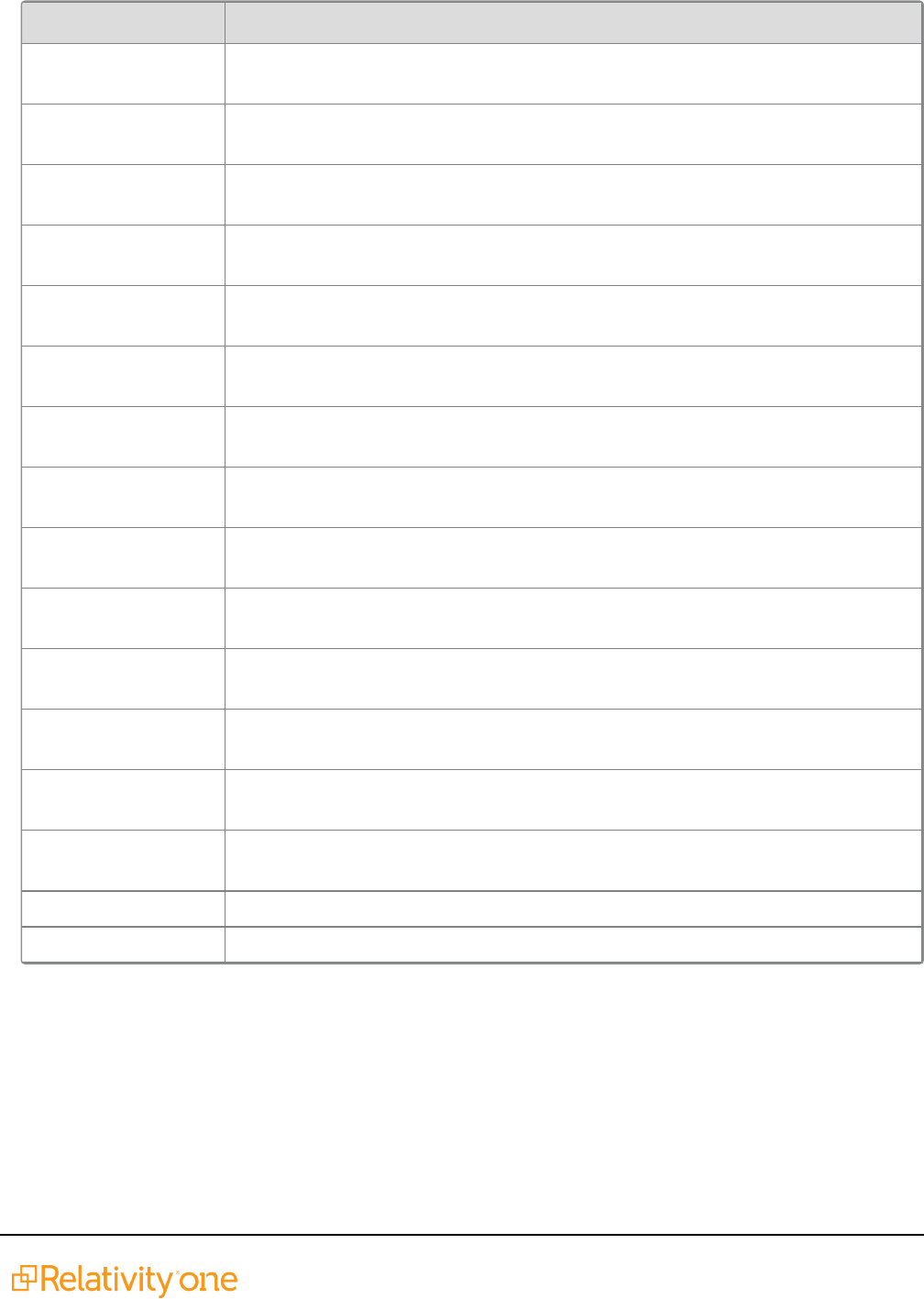
Searching Guide 142
Search Name Description
02.07 Analytics Index Returns documents containing text and returns only extracted text for Analytics
Indexes.
02.08 All docs Email
Metadata fields
Returns all emails with all metadata fields returned.
03.01 Extracted Text
is Empty
Includes documents not returned for use in Analytics Index for lack of text.
04.01 Parent Level
Documents
Returns top-level documents that are not attachments, but can be emails or other.
04.02 Document Level
Documents
Returns child-level documents.
04.03 Parent Level
Dupes + Family
Returns parent duplicates with family added. Duplicate not determined on family.
05.01 Single Recipient
Emails + Family
Returns emails with one recipient and their attachments.
05.02 Bulk Emails
(50+) + Family
Returns emails with 50 or more recipients and attachments.
06.01 Search Term
Report
Search across all emails with text for STR.
06.01 Responsive and
Family
Returns documents with Designation set to Responsive and family included.
06.02 Conflicts with
Family
Returns items not coded the same as parent items.
06.03 Produce with
Images Placeholders
Returns items marked with choice in Productions field, Nothing in Bates field, and
Check on type of production as Images with Placeholders.
06.04 Produce Nat-
ives Only
Returns items marked with choice in Productions field, Nothing in Bates field, and
Check on type of production as Native only.
06.05 Produce Nat-
ives with Placeholders
Returns items marked with choice in Productions field, Nothing in Bates field, and
Check on type of production as Native with Placeholders.
By Filetype Returns all documents with a filetype sorted by filetype.
By Folder Returns all documents with a folder path and sorted by folder path.
11.9 Saved search history
On the History tab, you can view the audit records for saved searches, unsaved searches, and queries
performed on views. For example, when a user filters a column.
Use the following guidelines to view search history records:
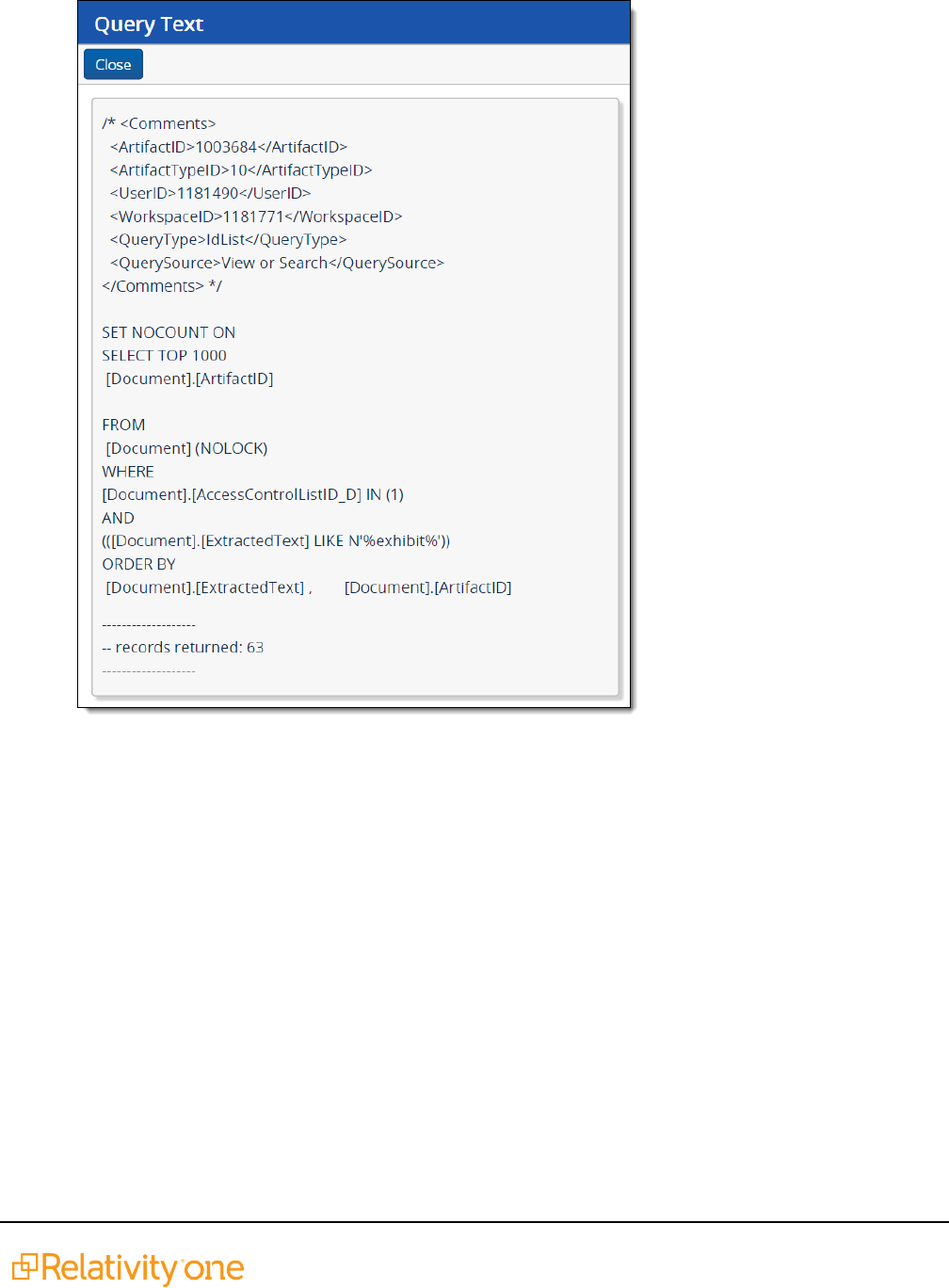
Searching Guide 143
n
Saved Searches—the Name column displays the name of the search. The Object Type column dis-
plays Search. Click the Query link to display a pop-up window with the SQL statement for the query.
n
Unsaved Searches or Views—the Name column displays the name of the view in which the search
was performed. The Object Type column displays View. Click the name link to display the details
page for the view. You can also click the Query link to display a pop-up window with the SQL state-
ment for the query.

Searching Guide 144
12 Field categories
Field categories allow you to quickly and accurately apply field conditions to the document list, a saved
search, or a view. Once a field category has been created, it can be linked to as many fields as desired. The
field category can then be selected when adding fields or conditions in the search panel, a view, or a saved
search to conveniently access and apply the linked fields.
All Fields is a system default field category that displays every non-secured field in your workspace. It
cannot be edited or secured from other users and it will always display at the bottom of the Field Categories
drop-list. All Fields allows you to conveniently switch between viewing all of the fields and the fields included
in a particular field category.
Field categories have object permissions so that they can be created and limited to a specific group or
workflow within in Relativity. Securing a field category only determines whether it is visible in the drop-list of
field categories that can be selected when adding conditions in the search panel.
Note: Field categories that you create are carried over during workspace upgrades and when those
cases are used as templates. The All Fields field category will also carry over after an upgrade, though it
is currently a system default that cannot be configured by users.
12.1 Creating a field category
To create a new field category, do the following:
1. Navigate to the Field Categories tab.
Note: All Fields is a field category that is always present in Relativity but it does not display on the
Field Categories tab since it cannot be edited.
2. Click New Field Category.
3. Enter the desired information for the following fields:
n
Name - the title of the field category
n
Order - determines where the field category appears within the view drop-down list. Items that
share the same value are sorted in alphanumeric order.
o
Order can be any integer (positive or negative). No decimals are allowed. You can use
the View Order button to see how items are currently ordered.
Note: Ordering by 10's, starting with 10, then 20, then 30, etc. is recommended
because you can insert an item into any position later in the workspace, without the
need to reorder all items.
4. Click Save to create the new field category.
12.2 Viewing fields associated with a field category
Before linking and unlinking fields to a field category, it can be helpful to see what fields are associated with
each field category. To do this, add the Fields field to the desired field category view and select that view on
the Field Categories tab.
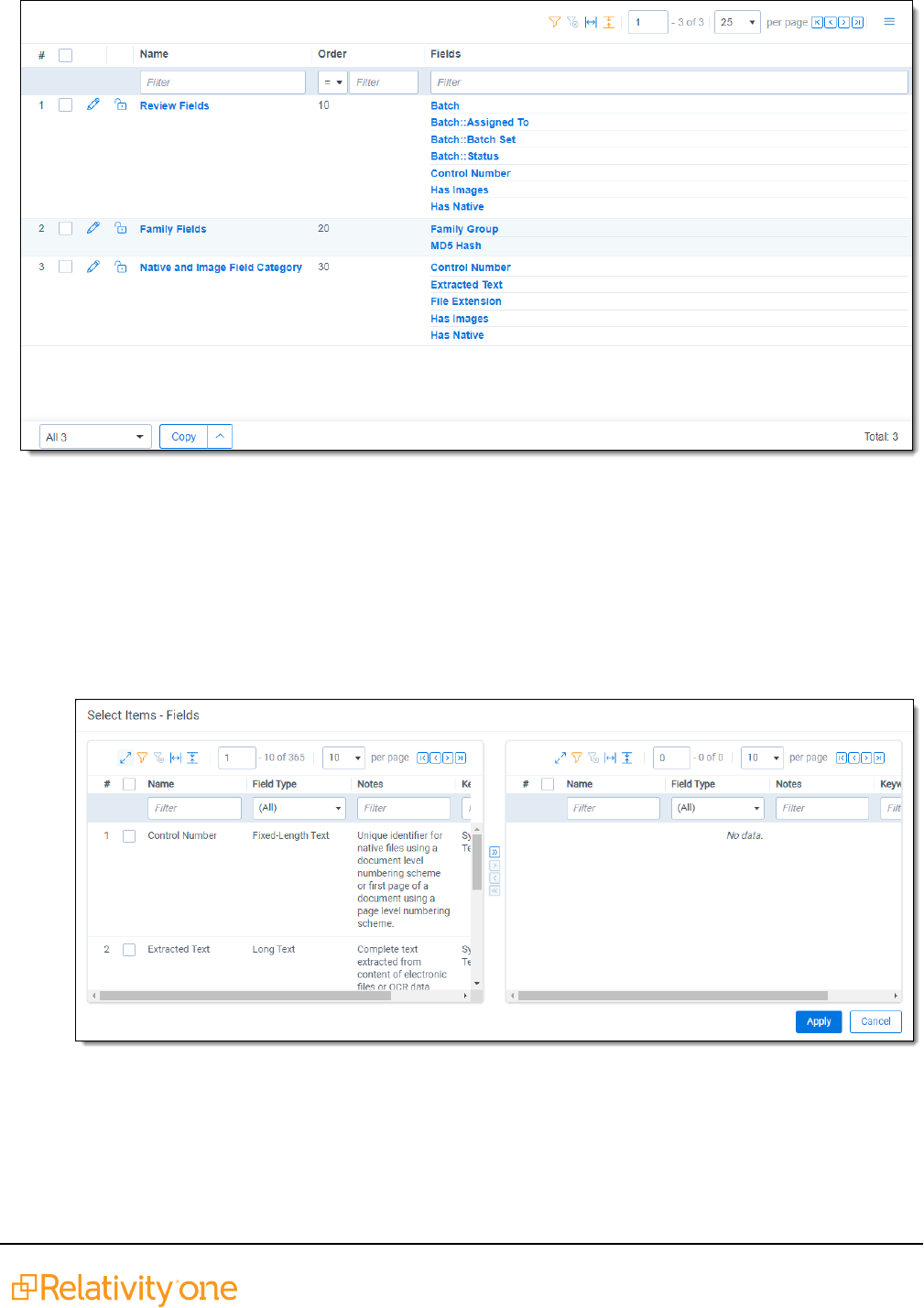
Searching Guide 145
12.3 Link a field or fields to a field category
To link a field or fields to a field category, do the following:
1. Navigate to the Field Categories tab.
2. Click on the desired field category in the list.
3. Click Link.
4. Filter the field list as needed and check any desired fields.
5. Once the desired fields have been selected, click the Move selected left to right icon.
6. Click Apply.
The selected fields are linked to the field category and display in the Fields section.

Searching Guide 146
12.4 Unlink a field or fields from a field category
To unlink a field or fields from a field category, do the following:
1. Navigate to the Field Categories tab.
2. Click on the desired field category in the list.
3. Click the checkbox on the left side of the row for any fields you wish to unlink.
4. Click Unlink.
5. Click Unlink again in the pop-up.
The selected fields are no longer linked to the field category.

Searching Guide 147
13 Optimized indexing
Optimized indexing requires some knowledge of your data. The time it takes to scrub your data before
indexing will be rewarded in time saved when creating an index and returning search results. Consider the
following when creating an index:
n
Consider removing file types that have no searchable content, such as system or program files.
n
Use a separate index for searching database files and large Excel files.
o
Even if your database has only a small number of these files, creating an index without them
improves searching speed, especially numeric range searching.
n
Set up multiple dtSearch indexes, including one with a smaller document set based on one or more of
the following criteria:
o
date ranges
o
custodians
o
text size (extracted or OCR text)
l
Small (< 2 MB)
l
Medium (> 2 MB and < 10 MB)
l
Large (> 10 MB and < 25 MB)
l
Very large (> 25 MB)
n
Set a dtSearch index to recognize and/or ignore words, characters, and digits as necessary.
o
Noise Words (Ex: Include “sample” as a part of the noise world list for a dtSearch index con-
taining Excel documents.)
o
Alphabet file list (Ex: Index the character “£.”)
o
Remove numbers from the alphabet file list if only searching for words – this reduces the size
of the index and disables numeric range searching.
n
Enable dtSearch indexes to automatically recognize dates, email addresses, and credit card num-
bers only when necessary. Enabling this setting increases build time.
n
Consider using a pair of dtSearch indexes when adding new data. You can have one index updated
in the background and then swap out the outdated index with the current one.

Searching Guide 148
Proprietary Rights
This documentation (“Documentation”) and the software to which it relates (“Software”) belongs to
Relativity ODA LLC and/or Relativity’s third party software vendors. Relativity grants written license
agreements which contain restrictions. All parties accessing the Documentation or Software must: respect
proprietary rights of Relativity and third parties; comply with your organization’s license agreement,
including but not limited to license restrictions on use, copying, modifications, reverse engineering, and
derivative products; and refrain from any misuse or misappropriation of this Documentation or Software in
whole or in part. The Software and Documentation is protected by the Copyright Act of 1976, as amended,
and the Software code is protected by the Illinois Trade Secrets Act. Violations can involve substantial
civil liabilities, exemplary damages, and criminal penalties, including fines and possible imprisonment.
©2024. Relativity ODALLC. All rights reserved. Relativity® is a registered trademark of Relativity
ODA LLC.


